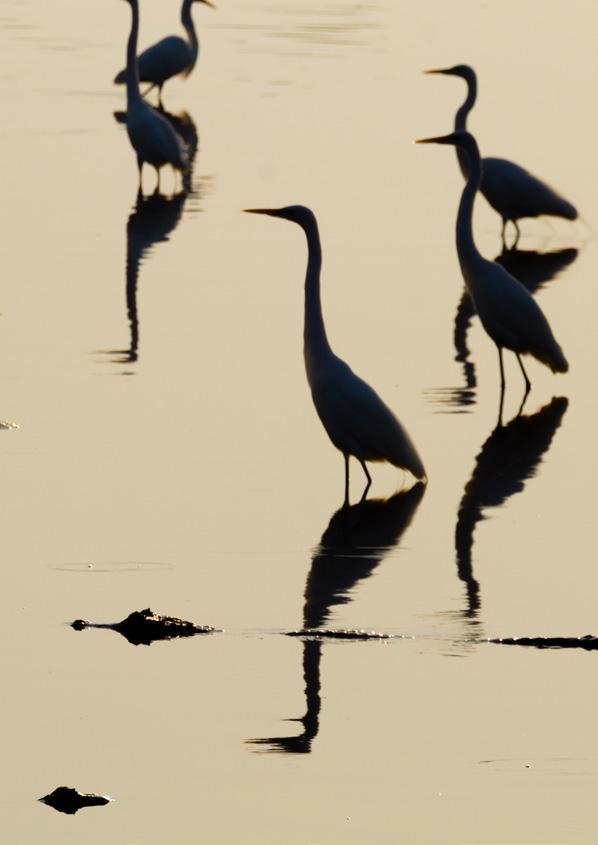

MaKING MINCEMEaT OF THE PaNTaNaL

‘ The opportunity that we have, with media giving us a break on other issues, is to pass the reforms and deregulate, simplify. So we need to give this a push here, while we are in this moment of calmness in terms of media coverage, because it only talks about COVID, and “pass the cattle” [push things through all at once] changing all the rules, and simplifying regulations.’
Brazilian Minister of the Environment Ricardo Salles, 22 April 2020, video of ministerial meeting released by Brazilian
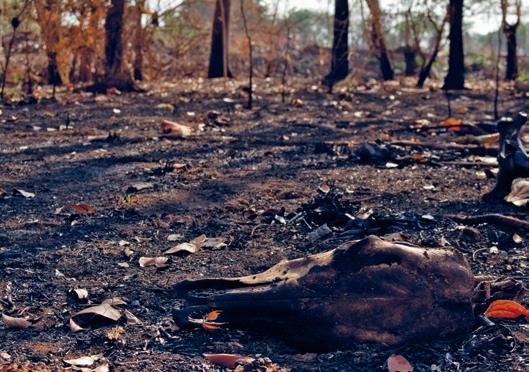
‘ The livestock industry is not a threat to the future of the planet despite Greenpeace and certain other NGO claims. Livestock can deliver biodiversity, socio-economic development, sustainable livelihoods and meet food security goals.’1
Marcio Nappo, Director of Corporate Sustainability, JBS Brazil, February 2021‘ The need for rapid reduction in GHG emissions from fossil fuels to meet the 1.5° or 2°C targets is widely acknowledged. We show that the same is true for food systems: Even if fossil fuel emissions were rapidly reduced, emissions from the global food system are on a trajectory that would prevent achievement of the 1.5° and 2°C targets. … [M]eeting the 1.5° and 2°C targets will likely require extensive and unprecedented changes to the global food system.’2
Michael A Clark et al, Science, November 2020EXECUTIVE SUMMaRY: MaKING MINCEME aT OF THE PaNTaNaL
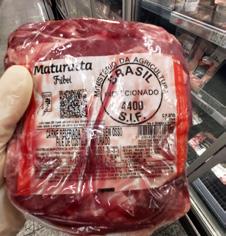
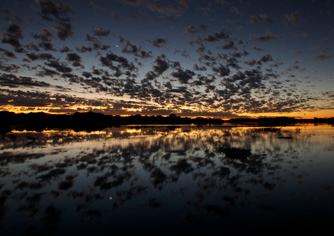
In 2020, thanks to two consecutive years of severe drought,3 some 30% of the Brazilian Pantanal – the world’s largest contiguous wetland4 – burned,5 with official sources saying that the vast majority of the fires were started by human activity.6 In many cases ranchers are suspected of starting fires deliberately,7 in defiance of official bans on the use of fire introduced in July by regional governments and presidential decree.8
Despite its value as a vital habitat for jaguars9 and other wildlife,10 about 90% of the Brazilian Pantanal is under self-declared land claims, where ownership is not verified by the state.11 As a consequence, these land claims often overlap with Indigenous lands or public conservation units (including federal, state and municipal reserves). In the Pantanal, these land claims overlap with about 28% of Indigenous lands12 and 58% of public conservation units.13 About 80% of the Pantanal is reportedly managed as cattle ranches.14
Greenpeace International15 has identified 15 ranchers who are either current or recent (2018–
2019) suppliers of Brazil’s leading meat processors, JBS, Marfrig and Minerva, and that are linked to the devastating 2020 fires in the Pantanal, environmental violations and/or property registration irregularities.16
The fires within the boundaries of the case study properties alone burned more than 73,000 ha – an area the size of Singapore, or about half the size of Greater London17 – between 1 July and 27 October 2020, and in many cases appear to have contributed to extensive burning far beyond the property limits. These 15 ranchers were linked directly or indirectly in 2018–2019 to at least 14 meat processing facilities owned by JBS, Marfrig and Minerva which trade globally. Direct trade links have been identified from one or more of these 14 facilities to customers including Burger King and McDonald’s, Danish Crown Group, Nestlé, Brazil’s Pão de Açúcar supermarket chain (a member of the French Casino Group), Carrefour and, reportedly, Walmart 18 According to shipping data, between 1 January 2019
and 31 October 2020 these 14 facilities collectively exported over half a million tonnes of beef and beef products worth nearly US$3 billion to markets including Hong Kong (22%), China (21%), the EU-27 and the UK (8%) and the USA (1%). Exports from JBS’s Pantanal-linked facilities alone reportedly accounted for almost US$2 billion over the period, with the EU27 and the UK representing around 9% of the export volume and over 13% of the value.19
Exports are a primary source of revenue for the Brazilian operations of JBS, Marfrig and Minerva. 20 Despite the chaos and economic upheaval caused by the global Covid-19 pandemic, Brazil’s beef exports set a new all-time high in 2020, with volumes reported to have reached 2 million tonnes and revenues some US$8.4 billion – up 11% over 2019. 21 The main global revenue source for JBS SA (as for Marfrig22), however, lies in its North American business units, with the United States accounting for around half of the company’s global revenue in the third quarter of 2020. 23 JBS has business interests in every continent except Antarctica;24 customers of the company and its subsidiaries internationally include Costco, KFC, Lidl, Mars, M&S, Nando’s, Nestlé, Pizza Hut, Princes, Sainsbury’s, Subway, Tesco, Walmart and YUM 25
As a result of numerous damning exposés, including the 2009 Greenpeace report Slaughtering the Amazon, 26 JBS, Marfrig and Minerva first promised to deliver ‘zero deforestation in the supply chain’ by 2011. 27 But as this investigation into their Pantanal supply base exposes, the processors still do not have the fundamental procedures in place to guarantee that cattle from rogue ranchers linked to environmental destruction or legal violations are excluded.
Proper product due diligence procedures would mean JBS, Marfrig and Minerva only slaughter cattle where they have established full traceability to origin. This would also mean they could guarantee that they exclude any cattle where there is a risk that they may originate from destruction or degradation of natural forests or other ecosystems, or lands that have been exploited in violation of Indigenous Peoples’ rights or conservation laws. When applied to ensure corporate transparency and accountability, due diligence procedures would mean JBS, Marfrig and Minerva
proactively identify and prevent any other adverse human rights and environmental impacts resulting from their own activities, from the activities of the companies they control and from the activities of their subcontractors and suppliers with whom they have an established commercial relationship.
Against this background, the meat processors’ current approach to supply chain screening in the Pantanal focuses primarily on the supply ranch, without sufficiently considering practices in the rancher’s other operations. This blinkered view enables the most transparent form of cattle laundering – the potential for ranchers to supply cattle from operations that violate law or company policy by passing them through approved intermediary ranches they also own before sending them to slaughter.
Thirteen of the 15 ranchers identified by Greenpeace were ‘tier-one’ suppliers: they directly supplied one or more of the meat processors from an approved ranch in 2018 or 2019. 28 In the majority of instances, the links between the case study properties themselves and the meat processors were indirect –cattle from those properties passed through one or more other ranches before the final sale. However, in most cases, the intermediary ranches were owned by the same individual. 29
The supply chain links established by Greenpeace between the ranchers and the big three meat processors predate the 2020 fires. As confirmed by the company responses to Greenpeace regarding the cases laid out in this report, the meat processors deem that all of the ranches that directly supplied them met their policy requirements at the time of purchase. Further, at least 11 of the 15 ranchers apparently remain tier-one suppliers – ie have at least one property approved to directly supply at least one of the meat processors.30
Disturbingly, the processors provided no indication of having imposed meaningful requirements on their Pantanal suppliers in light of 2020’s bans on deliberate use of fire, or of any intention to do so despite the evidence provided of supply to approved ranches from problematic ones. In the case of JBS, three of its current tier-one approvals as well as one of its historic (2018–2019) trading relationships appear to violate its sourcing policy, and its assessment of the suppliers’ compliance
conflicts with that of Minerva in some instances.31 One of Marfrig’s historic trading relationships similarly appears to violate its sourcing policy,32 despite the company’s assertions about compliance. Marfrig has not indicated that it intends to review these trade relationships more closely.
As for JBS, presented with the summary findings of this report, the company confirmed to an industry journal that for the moment it has no intention to exclude suppliers – tier-one or third-party – that violate its policies. Instead, the emphasis is on getting Amazon suppliers onto a monitoring platform by 2025:
‘Right now, we’re not going to block them [noncompliant suppliers], we’re going to try to help them solve the issue. Sometimes it’s paperwork, sometimes they need to put together a conservation plan, sometimes they need to reforest part of their property. We are going to help them and we’re hiring people to help these suppliers.
‘We think excluding the property and the supplier is a negative approach. It won’t solve the problem because they’ll go to the next meat packer and try and sell it. We don’t want that because it won’t address the issue.’33
Such an accommodating approach sits uneasily with JBS’s claimed ‘zero tolerance’ to deforestation and certainly fails to send a clear message to the sector that violations come with consequences – they seem to come with bonuses.
Beyond the Amazon, JBS reverts to a simple checklist of official legal findings34 in a country where the government is systematically dismantling environment agencies and undermining law enforcement.35
The profound deficiencies in the meat processors’ policies and related enforcement procedures for their Pantanal supply base help explain the sector’s failure to end its links to environmental destruction or to close the market to dirty suppliers. These include:
• Failure to effectively and comprehensively ban and monitor for the deliberate use of fire, legal or otherwise.
• Failure to effectively and comprehensively ban and monitor for all new land clearance, not just illegal deforestation and not just within iconic regions such as the Amazon.36
• Failure to require, as a condition of trade, that ranchers comply with the law and zero deforestation policies across their operations.37
• Continued failure to proactively identify and monitor their entire supply base (including indirect supply and third-party suppliers), despite a 2009 agreement to achieve this in the Amazon by 2011.38
• Failure to make supply chain transparency a condition of trade (ie requiring ranchers to disclose the suppliers and origins of their cattle) and a model for responsible business (ie ensuring the public availability of data on all ranchers in the company’s supply chain, including the locations of their operations, in order to enable independent scrutiny of their impact).
These failures, underpinned by lack of transparency and traceability, both expose and contribute to the industrial meat sector’s continued role as a leading global driver of land-use emissions, biodiversity loss and social injustice. Of particular concern is the potential for cattle linked to deliberate or illegal use of fire to find their way into the international market.
Given such structural failings, it is untenable for international consumer goods companies, supermarkets and fast food companies that claim to have zero deforestation policies to continue to trade with the meat processors named in this report. Further, if trade blocs such as the European Union39 and the United Kingdom40 are to end their consumption of products linked to environmental destruction then they must swiftly enact and enforce the necessary laws to ensure that products from these groups find no place in these markets. The overproduction of meat and dairy is literally costing the earth. To halt and begin to reverse the current crisis, decisive action is needed from governments, finance and consumer companies to shift away from industrial meat and close markets to companies contributing to forest and ecosystem destruction. Without these vital steps our food system will continue to be a driving force of deforestation, climate change and future pandemic risk.
FROM THE PaNTaN aL TO THE WORLD

The map shows the point locations of the Pantanal case study ranches (in red) linked to the 2020 fires, intermediary ranches (in black), and the JBS, Marfrig and Minerva slaughterhouses supplied by them. The connecting lines trace the historic (2018-2019) flow of cattle between operations. The numbers of the ranches correspond to those in the adjacent diagram.
The spider diagram shows how trade from the 15 ranchers named in the investigation entered the cattle supply of 14 JBS, Marfrig and Minerva slaughterhouses, often via ranches controlled by the same individual. These slaughterhouses export to markets around the world (shown in red on the world map).
Apparent trade links from the slaughterhouses have been compiled through photographic evidence, company disclosures and a review of what is reported in Panjiva shipping data. Global food companies reportedly supplied by these facilities include Burger King and McDonald’s in Brazil, Danish Crown in Hong Kong, and Nestlé. Global retailers reportedly supplied by these facilities include the French groups Carrefour and Casino (Pão de Açúcar) in Brazil and Walmart in Chile. Importers of beef from these facilities reportedly include Germany – Frost Meat and Meat 2000; Hong Kong –Kai Bo Frozen Meat Supermarket; Israel – Neto Malinda Trading and Shufersal; The Netherlands – FN Global Meat and Zandbergen Brothers; and Spain – Egatesa, Jucarne and Montesano.
WHaT’S THE BEEF WITH JBS?
We live in a boom time for the meat industry. Worldwide meat consumption is predicted to rise 76% by 2050, 41 with meat-heavy diets being energetically promoted, including in emerging economies and by fast food companies. 42 Driven by its insatiable hunger for new markets and for land on which to rear livestock and grow soya for animal feed, the industrial meat sector poses a threat to the global climate, to the wildlife of some of the world’s most biodiverse regions, to the human rights of Indigenous peoples and other communities and to the long-term health of populations in the West and elsewhere. 43
Global meat giant JBS exemplifies and is a main contributor to this threat. Based in São Paulo, 44 JBS claims to be the world’s largest animal protein company45 and the second-largest food company in the world by annual sales (after Nestlé). 46 It has grown internationally through a series of acquisitions largely funded by the state-owned Brazilian National Bank for Economic and Social Development (BNDES), 47 which owns more than a fifth of the company. 48
JBS’s impacts on the climate and on the ecosystems of South America are profound: its operations have been estimated to produce around half the annual carbon emissions of fossil fuel giants such as ExxonMobil, Shell or BP, 49 largely as a result of forest clearance linked to its cattle supply chains and the production of soya for animal feed.50
The scale of JBS’s environmental and social destruction became a global scandal in 2009, when Greenpeace published a report, Slaughtering the Amazon, 51 exposing how JBS and other major players in the Brazilian beef industry were linked to hundreds of ranches in the Amazon, including some associated with illegal deforestation and other destructive practices, as well as modern-day slavery. In the wake
of that report JBS and three of Brazil’s other big meat processors signed a voluntary commitment –the so-called ‘G4 Agreement’ – to end the purchase of cattle whose production is linked to Amazon deforestation, slave labour or the illegal occupation of Indigenous lands and protected areas. The agreement included a commitment to ensure fully transparent monitoring, verification and reporting of the companies’ entire supply chains (including thirdparty suppliers) within two years.52
This pledge has not been honoured. For over a decade, investigations by Greenpeace and numerous others have repeatedly exposed JBS’s links to corruption, deforestation and human rights violations.53 But despite its failure to implement the terms of its 2009 commitment, as the company plans to seek listing of its international operations on the New York Stock Exchange (NYSE) in 202154 it appears to be attempting to bolster its environmental image and distance itself from its destructive legacy. In response to increasing pressure from its customers and shareholders,55 in late September 2020 JBS launched its new ‘Together for the Amazon’ initiative. As well as setting up a fund to support sustainable development and conservation projects in the region, the company has given itself until 2025 to implement a system for monitoring the supply of livestock to the ranches that directly supply it in the Amazon.56 This new supply chain commitment – which in real terms represents a step backward from the 2009 commitments – has numerous failings, chief among them:
• Failure to explicitly extend the whole of the supply chain policy, including ‘zero tolerance for deforestation’, beyond the Amazon
• Failure to explicitly exclude as suppliers ranchers that use fire deliberately
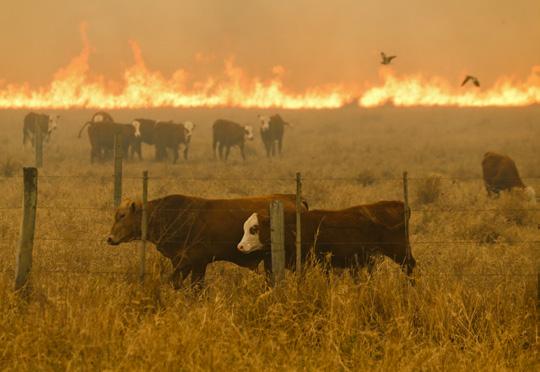
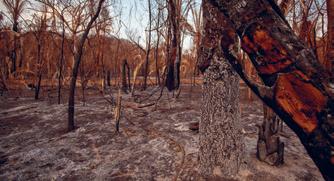
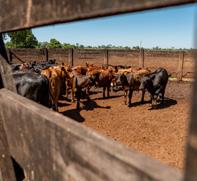
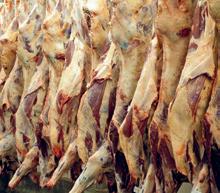
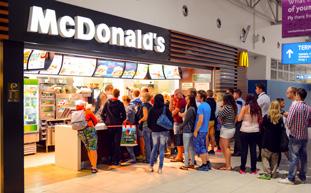
• Apparent abandoning of the transparency component of the 2009 agreement, notably to ensure fully transparent monitoring, verification and reporting of the company’s entire supply chain by 2011
• Failure to explicitly require legal and zero deforestation policy compliance across the operations of ranchers who supply the company as a condition of trade
JBS’s 2020 zero deforestation commitment applies solely to the Amazon, ignoring neighbouring regions such as the Cerrado, said to be the world’s most biodiverse savannah57 (from which, according to the Trase supply chain transparency platform, JBS sources the majority of the cattle it exports58), and the Pantanal – both regions where the cattle industry is also driving ecosystem conversion.59 While in climate terms the preservation of the Amazon rainforests is a key objective in South America, as the Intergovernmental Panel on Climate Change’s 2019 land use report pointed out, the prevention of widespread land use change across all ecosystems is vital.60
The incidence of fires in the Brazilian Amazon in the first nine months of 2020 was the highest in a decade, and more fires than ever before were recorded in the Pantanal over the same period.61 Still, the new JBS initiative makes no mention at all of excluding from the company’s supply chain ranchers who use fire deliberately for land management or clearance, despite the announcement of local and federal bans.62
The 2020 commitment delays supply chain mapping in the Amazon beyond the ranches that directly supply it until 2025, 14 years after the original deadline.63 The proposed monitoring platform64 itself will be confidential – ie not publicly available for stakeholder review and scrutiny –which abandons the original commitment to a transparent monitoring system.
While the 2020 Amazon commitment reasserts the company’s ‘zero tolerance for deforestation’, which was at the heart of the original G4 Agreement, the company also asserts that the proposed monitoring platform will ‘ensure any cattle from producers involved in illegal deforestation cannot enter the JBS supply chain’ (emphasis added).65
What is clear is that JBS has not immediately extended its ‘zero tolerance’ to include clearance of natural ecosystems beyond the Amazon. Brazil’s current Forest Code allows the clearance of up to 80% of any
land claim in the Brazilian Pantanal and other biomes outside the Amazon.66 Across the country, that means some 88 million ha of native vegetation – more than 3.5 times the size of the UK67 – could be cleared legally within existing land claims,68 despite the huge climate and biodiversity costs.
JBS also fails to require comprehensive monitoring of the ranchers who supply it across their operations and across biomes. While this was not a requirement of the G4 Agreement either, in the years since that agreement was reached understanding of the adequacy of its approach to due diligence within the commodity trade has evolved. In the palm oil sector, for example, it is widely recognised today that if the sector is to be cleaned up, actors at all stages of the downstream supply chain must exclude any suppliers whose operations – including those of subsidiaries or associates – are illegal or environmentally destructive. This puts the appropriate emphasis on the exclusion of rogue suppliers, not just of tainted supplies.
In the case of Brazil’s agricultural commodity sectors, including beef and soya, this should mean monitoring the activities of traders, ranchers and farmers across all their operations (that is, beyond the purchaser’s immediate supply chain), not just in the Amazon and not just for deforestation but for other forms of ecosystem destruction, deliberate or illegal use of fire, unresolved land disputes and embargoes, outstanding fines and human rights abuses including the use of slave labour.
Considering the urgency of the global climate and nature emergency, initiatives such as JBS’s new Amazon supply chain pledge that are based on self-regulation of voluntary commitments are a decade out of date in delivery and scope. They do not represent a decisive contribution to the radical shake-up of the global food system that science demands and that companies, financial institutions and governments need to deliver.
Food industry corporations that continue to source from JBS and financial institutions that continue to resource it are exposing themselves to financial and reputational risk. Worse, they are contributing indirectly to the existential risks faced by South America’s iconic biomes and their inhabitants – and by all the inhabitants of an overheating planet – due in large part to the activities of the industrial meat sector. Governments are also stakeholders with exposure to JBS, and to the impacts of the industrial meat sector more broadly, through sovereign investments, trade and trade deals, and the choices they make regarding market and financial regulation.
WHO NEEDS TO DO WH aT
The steps that food industry, financial institutions and governments take in the immediate future in relation to JBS – and the global meat industry as a whole – will be a decisive test of their priorities. Governments and companies must align the economy with biodiversity and climate protection, along with social justice. They must ensure that private and public finance, trade policy and overseas cooperation do not drive further deforestation, but do support nature restoration and a transition to a green, just and resilient economy. This includes:
CLOSING THE M a RKET TO ECOSYSTEM DESTRUCTION:
DROPPING FOREST a ND ECOSYSTEM DESTROYERS:
End finance for or trade with groups such as JBS whose direct or indirect suppliers are linked to deforestation and alleged human rights violations –this includes ending trade with subsidiaries such as JBS-owned Pilgrim’s Pride, which owns Moy Park and Tulip (recently renamed Pilgrim’s Pride Ltd).69
DROPPING COMMODITIES LINKED TO FOREST aND ECOSYSTEM DESTRUCTION: Including through the adoption of a law on forest and ecosystem risk commodities (FERCs) and derived products, to ensure that commodities and products linked to deforestation, ecosystem destruction and abuses of human rights are not placed on the market. The legislation should include measures to cover the financial sector, ensure full supply chain traceability and transparency and rules on due diligence.
ENSURING TR a DE POLICY a LIGNS WITH CLIM aTE, BIODIVERSITY a ND SOCIa L JUSTICE GOa LS: This includes refusing to ratify trade deals such as the EU–Mercosur agreement. Trade agreements of this kind are based on an extractive model that commodifies people and nature and is inherently incompatible with forest protection - governments should instead protect forests and other natural ecosystems by adopting policies to decrease meat production and consumption, and addressing their external forest and ecosystems footprint by means of product and supply chain regulations.
TR a NSFORMING THE FOOD SYSTEM:
PH a SING OUT INDUSTRIa L ME aT: Immediately begin the phase-out of all finance for or trade in industrial meat, with the aim of reducing overall meat and dairy production and sales by at least 50% by 2025 and 70% by 2030 in countries with high levels of meat consumption.70
M a KING FULL TR a NSPa RENCY a CONDITION OF TR a DE: Make full transparency of group operations and the supply chain a condition of finance or trade, requiring open and comprehensive monitoring and reporting systems to be in place.
PRIORITISING HUM a N a ND ENVIRONMENTa L
HE a LTH: Introduce targets, legislation and fiscal measures to decrease production and consumption of meat and dairy products in countries with high levels of consumption and support a fundamental shift towards ecological farming and healthy plant-rich diets in order to reduce pressure on natural ecosystems.
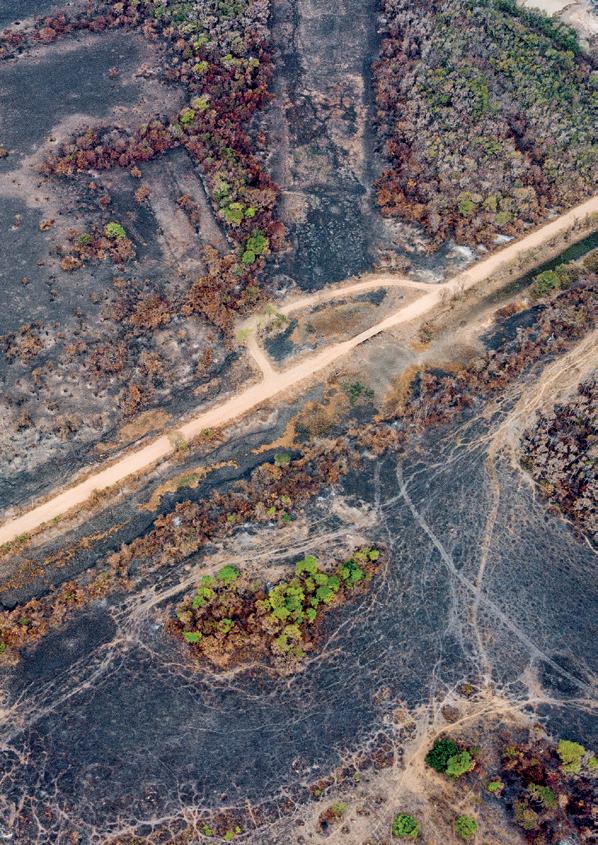

THE PaNTaNaL
– THE WORLD’S BIGGEST INL aND TROPICaL WETL aND IS GOING UP IN SMOKE
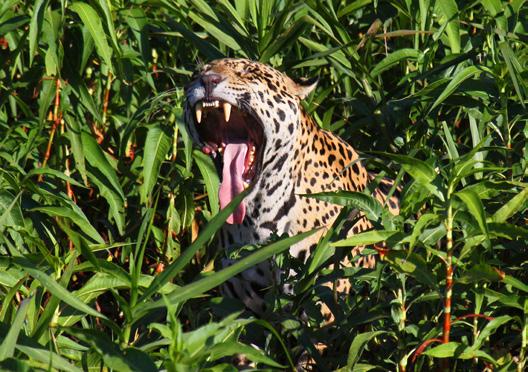
‘ The frequency and severity of fire outbreaks are worsening, as the climate warms and human impacts increase. Since 1980, average temperatures [in the Pantanal] have risen by 2 °C and humidity has fallen by 25%, according to the European Centre for Mediumrange Weather Forecasts (ECMWF). This year saw the worst drought recorded in the Pantanal in 60 years…. By June, the Paraguay River was at half its usual level. … Neglecting the connections between climate, land use and fire management will make it impossible to restore the Pantanal to its former state, let alone protect the region in the future. a ny change to the natural pattern of burning disrupts ecosystems and food chains, sometimes completely. For instance, jaguars will struggle to find herbivores to eat, if the latter are killed by flames or are unable to find fruits and leaves in a scorched landscape. … The impacts cascade quickly. Repeated wildfires lower the resilience of communities and vegetation; forests are replaced by open landscapes with fewer resources.’ 71

WHaT’S aT STaKE?
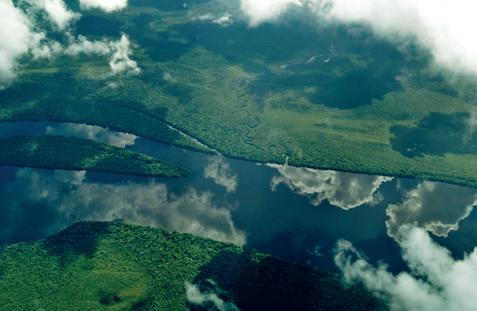
A vast landlocked river delta covering some 20 million hectares (ha) of central South America,72 mainly in Brazil (in the states of Mato Grosso and Mato Grosso do Sul) but extending into Paraguay and Bolivia,73 the Pantanal is the world’s largest contiguous inland tropical wetland.74 An annual cycle of flooding and drying gives the area a range of major habitats – among them permanent lakes and swamps, seasonally flooded savannahs and forest including flood forest 75 –helping to make the Pantanal biome one of the most biodiverse in the Americas. In addition to a remarkable diversity of aquatic plants 76 it is reportedly home to over 650 species of birds, 250 of fish and 170 of mammals,77 including such iconic but endangered, threatened or near-threatened species as hyacinth macaws,78 jaguars, maned wolves, giant river otters, tapirs, giant armadillos and giant anteaters.79 The jaguar population, estimated in 2011 at 5,000, is reportedly Brazil’s second-largest after that in the Amazon.80 Around 12% of mammal species in the Pantanal are globally endangered.81
In recognition of its importance to vulnerable species and other wildlife, the Pantanal contains four designated Wetlands of International Importance under the Ramsar Convention (three in Brazil82 plus the Pantanal Boliviano83) and a World Heritage Site (Brazil’s Pantanal Conservation Area, which includes the Pantanal Matogrossense National Park but nevertheless covers only 1.3% of the Brazilian Pantanal84). Just 712,000 ha – less than 5% of the Brazilian Pantanal’s 15,098,800 ha85 – are formally protected in conservation units, including over 270,000 ha (mostly in private reserves) where sustainable use is permitted.86 In addition, about 443,050 ha (less than 3%) lie within recognised Indigenous lands.87
The Pantanal also provides vital ecosystem services to surrounding populations, including climate stabilisation, water purification, flood reduction and an extensive waterborne transport system.88 The gradual release during the dry season of the water that the region has absorbed during the rainy season provides a steady water supply to millions of people downstream.89
L a ND COVER a ND PROTECTED a RE a S IN THE Pa NTa N a L
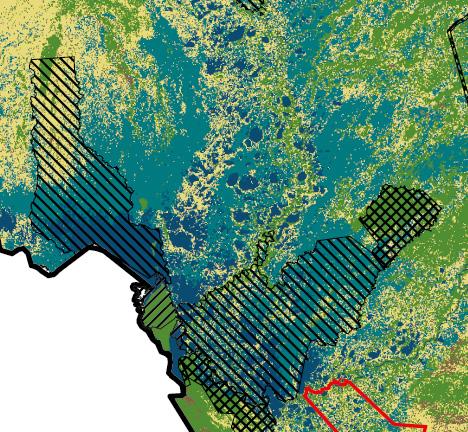
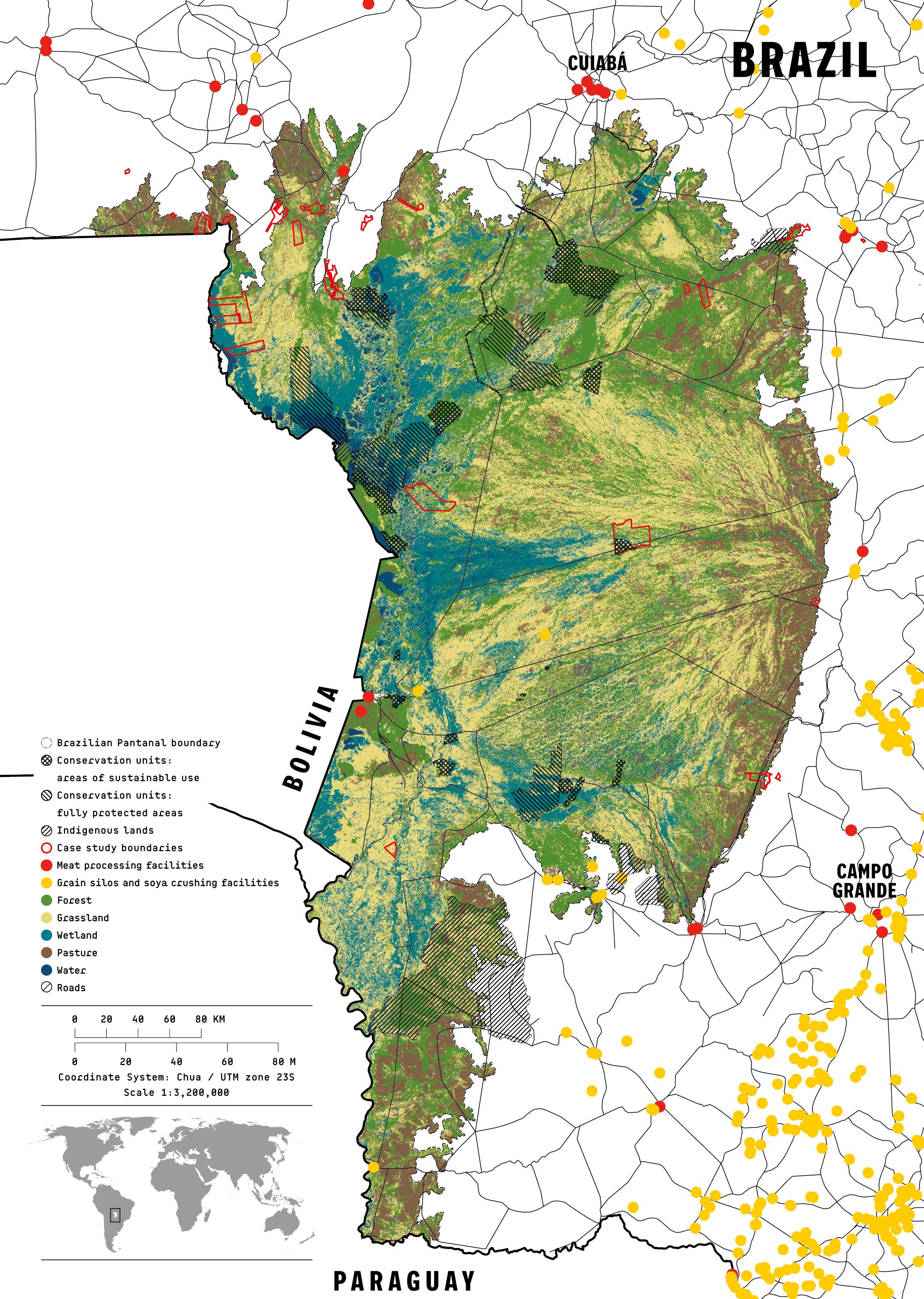
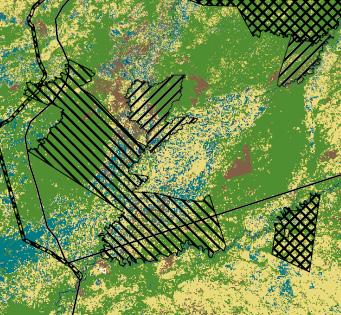
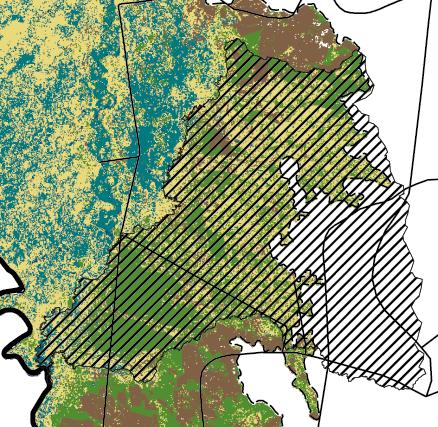
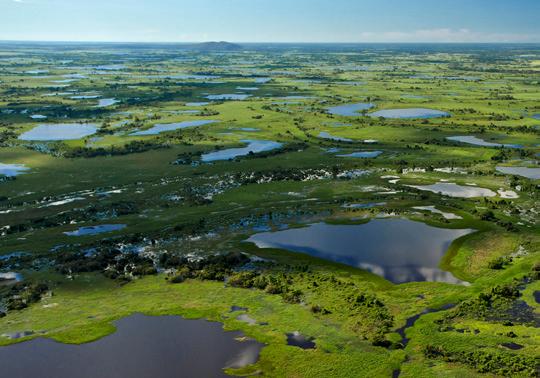
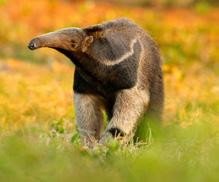
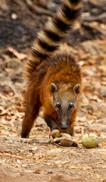
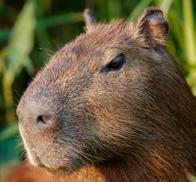
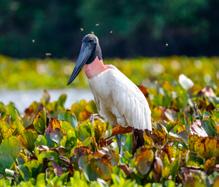
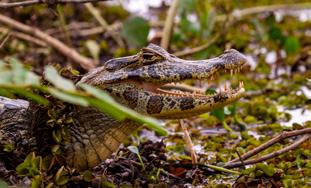
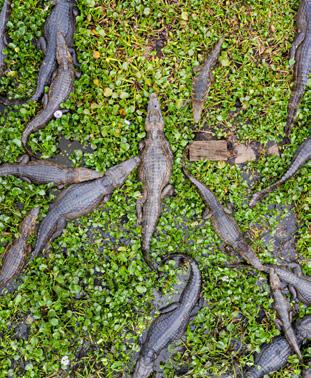
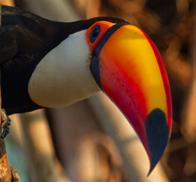
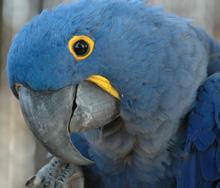

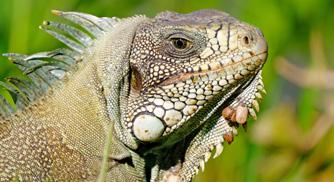


THE THRE aTS – WHO IS DRYING UP THE WETL aND?
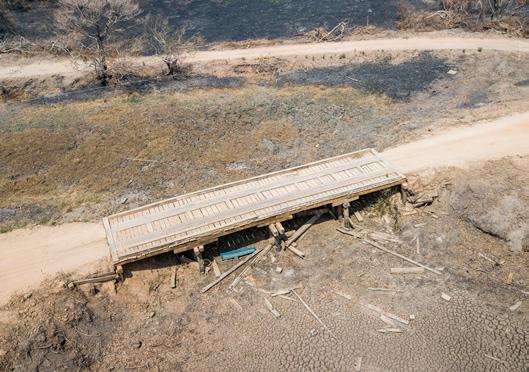
The future of the Pantanal hangs in the balance due to multiple threats to its ecological stability. The most direct threat is from commodity agriculture, including cattle ranching,90 with the use of fire to manage land and clear natural vegetation as part of the sector’s expansion posing a particular risk.91 More broadly, agricultural development on the surrounding plateaux92 is impacting the hydrology of the wetlands, with planned infrastructural development yet another threat.93 Further, climatic changes affecting the Amazon threaten to disrupt patterns of rainfall and the climate across the region.94
Under Brazil’s Forest Code, self-reported registration of rural properties (including identification of property boundaries) with the Rural Environmental Registry (Cadastro Ambiental Rural, CAR) is mandatory.95 Designed to enable monitoring and enforcement of compliance with environmental regulations, CAR registrations are frequently used to stake and secure land claims through
evidence of agricultural use, even though they do not constitute legally binding land title.96
According to the Ministry of Agriculture, Livestock and Food Supply (Ministério da Agricultura, Pecuária e Abastecimento, MAPA), about 90% of the Brazilian Pantanal is under private land claims today,97 and about 80% of it is reportedly managed as cattle ranches.98 Some 2,500 fazendas, or farms, are thought to be located in the region,99 together with 8.2 million cattle in municipalities that fall wholly or partly inside the Pantanal.100
According to CAR data, as of 31 January 2020, 6,756 self-registered properties covered about 12.7 million ha within the Brazilian Pantanal.101 Over 58% of the area of conservation units on public land (including federal, state and municipal reserves) within the Brazilian Pantanal,102 as well as more than 28% of Indigenous lands, is covered by registered rural properties.103 This means that despite their supposedly protected status, landholders have initiated processes
C a R REGISTERED PROPERTIES,
PROTECTED a RE a S a ND INDIGENOUS L a NDS
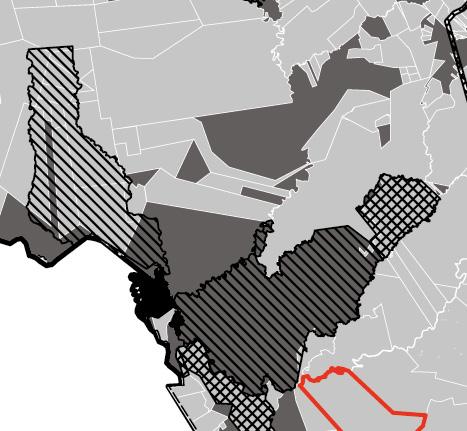
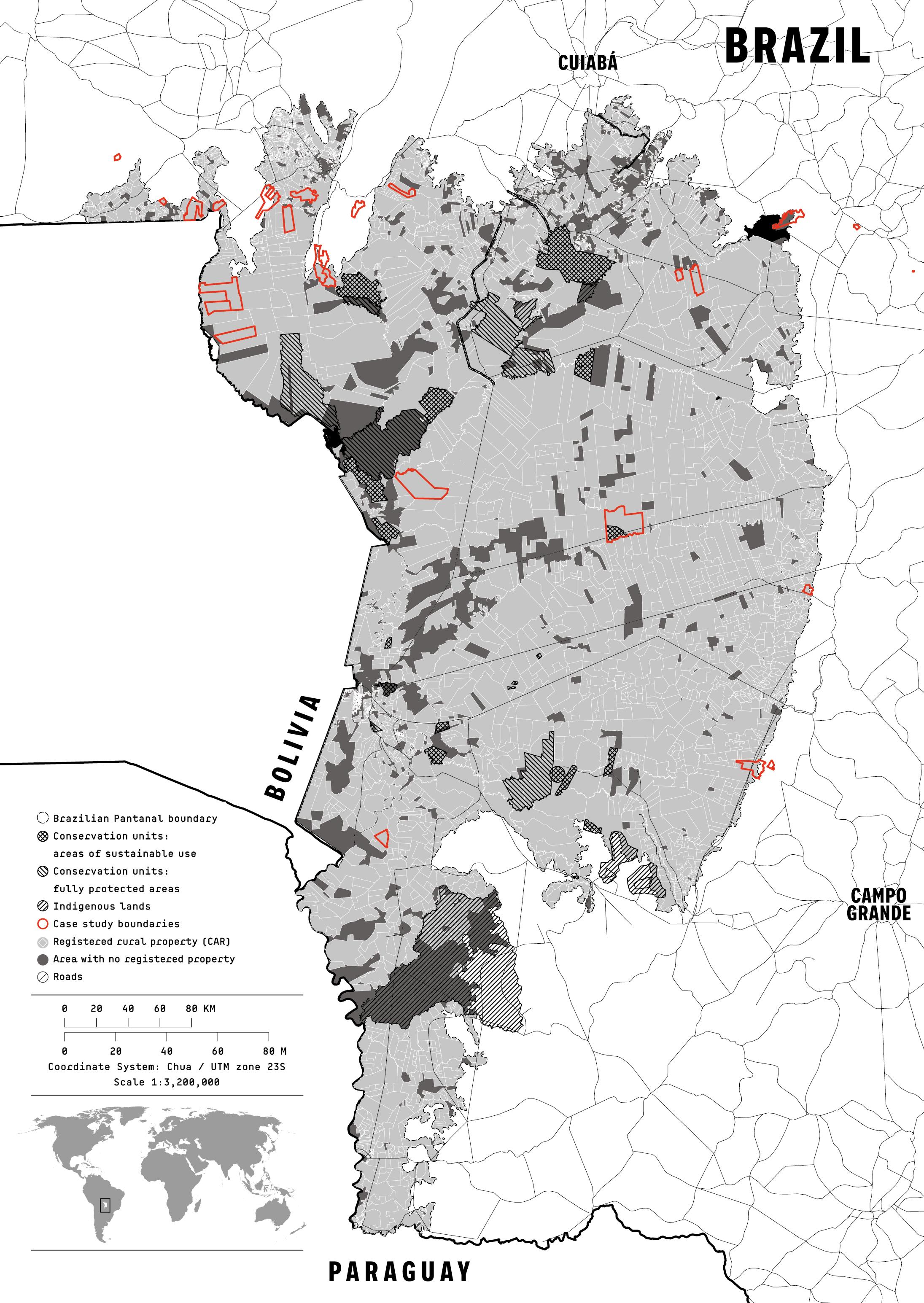

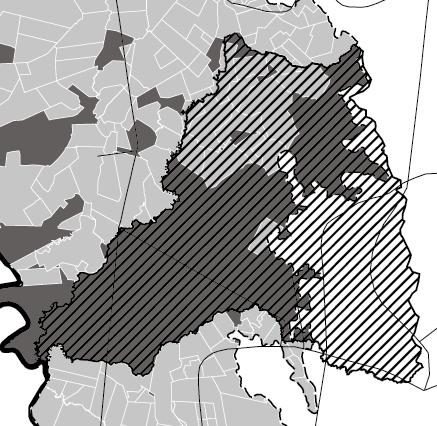
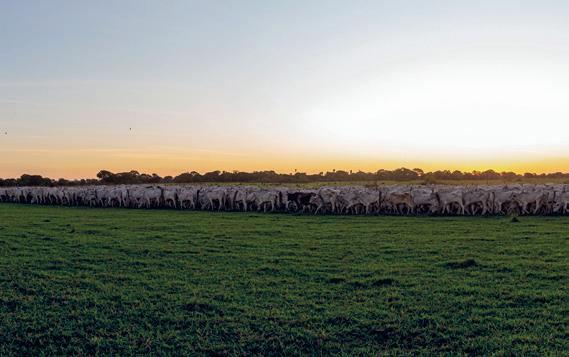
to lay claim to the land, putting it at increased risk of clearance for cattle ranching or soya farming. Ready access to soya and beef transportation and processing infrastructure facilitates use of the land by these sectors. Data from the Federal University of Goiás’s public Image Processing and Geoprocessing Laboratory (Laboratório de Processamento de Imagens e Geoprocessamento, Lapig) show that within the boundaries of the biome are four grain silos, with considerable presence of additional soya infrastructure and beef processing facilities within less than 100 km,104 including a number of facilities owned by JBS – the world’s largest meat processor105 – and its main competitors Marfrig and Minerva.
Brazil’s Forest Code permits extensive legal clearance of natural vegetation within rural properties. With the exception of Areas of Permanent Protection,106 up to 80% of all vegetation types may legally be cleared within properties in the Pantanal. According to MapBiomas, nearly 16% of the Brazilian portion of the Pantanal had already been cleared of its original vegetation by 2019, almost all of it for pasture,107 with the area of pasture increasing by over 450% between 1985 and 2019.108 The rate of destruction in forest biomes is of particular concern – data from MapBiomas show that the Brazilian Pantanal lost nearly a quarter of its surviving forest cover between 1985 and 2019.109
While cattle ranching is a long-established industry in the Pantanal,110 recent land clearance is reportedly being driven by an influx of new farmers and pressure on existing ranchers to increase the size of their herds as a result of competition from farms in the plateau areas that surround the wetland.111 The Wildlife Conservation Society has suggested that ecosystem destruction caused by land clearance for cattle ranching and agriculture represents one of the biggest threats to the Pantanal’s jaguar population; related to this is direct killing of jaguars by ranchers, which is predicted to remain the most significant threat in the near future.112
Some of the most serious threats to the biome result from human activity not within the lowland wetlands of the Pantanal itself, but rather in the surrounding plateaux, whose rivers feed the wetlands. With 104 new facilities reportedly proposed or under construction on the rivers that feed the Pantanal as of 2018,113 hydroelectric dams threaten to significantly alter the hydrodynamics of the wetland,114 affecting nutrient cycling, sediment flows and the seasonal pattern of flooding.115 Impacts are already being felt from a rapid increase in land clearance for agriculture on the plateaux, which in Brazil lie mainly within the Cerrado biome.116
The Cerrado, said to be the world’s most biodiverse savannah,117 is under extreme threat from agricultural expansion, with half of its natural vegetation already
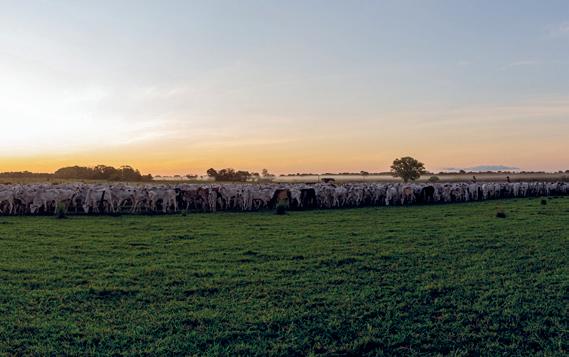
having been cleared by 2017.118 This clearance has led to widespread soil erosion and consequent silting of the Pantanal’s rivers, changing flooding patterns and damaging biodiversity;119 in particular, silting of the Taquari River has led to near-permanent flooding of some 1.1 million ha.120 A study commissioned by a coalition of non-governmental organisations (NGOs) found that by 2014 over 60% of the original vegetation in the Brazilian portion of the plateaux surrounding the Pantanal had been cleared by human activity, with more than 70% of this clearance due to the creation of pasture for cattle and most of the remaining land converted to arable agriculture.121 Close to 10% of the total area in Brazil planted with soya is estimated to be in the plateaux surrounding the Pantanal,122 with the current area planted with soya nationally reported to be 36.8 million ha.123 Other significant crops in the Pantanal and/or its surrounding plateaux include sugarcane, corn and cotton.124 Further expansion of agriculture across the region has been predicted as a result of the reopening of the port of Cáceres, located in the western Pantanal on the Paraguay River.125 Cáceres is the northern terminus of the so-called Paraguay–Paraná waterway, and there has reportedly been heavy lobbying from agribusiness organisations, including those representing soya growers and cattle ranchers, to open the port and the waterway – but the associated dredging and canalisation works will inevitably alter the river’s hydrological characteristics.126 The region’s
watercourses are also affected by heavy agrochemical use, as well as mercury pollution from gold mining.127
In addition to these threats from human activity within or adjacent to it, the Pantanal is also at risk from the massive ongoing deforestation in the Amazon.128 This threatens to change continent-wide rainfall patterns by disrupting the so-called ‘flying rivers’ – air currents that carry huge quantities of water vapour from the Atlantic to the Amazon headwaters and back again in a repeated cycle of rainfall and evapotranspiration, as the forest’s trees draw water from the soil and release it back into the air.129 The weakening of these flying rivers is believed to be exacerbating droughts in the Pantanal.130
Even without taking the impact of land use change into account, the global climate emergency is predicted to have a significant effect on the Pantanal’s climate: a recent study estimated that in a scenario involving continued global fossil fuel dependence the region could see a 5–7°C increase in temperature and a 30% reduction in rainfall by the end of the century, leading to a significant reduction in the water budget.131
Another study projects that climate change will lead to an increase in severe droughts in the biome, resulting in changes in the inter- and intra-annual flooding dynamics that will drastically affect the functioning of the Pantanal ecosystem, ‘with consequences for wildlife diversity and distribution’.132
UNDER FIRE
While expansion of cattle ranching in the Pantanal itself has been slower than in the surrounding plateaux,133 the cattle industry is implicated in one of the most acute current threats to the region’s ecology – the destruction of large expanses of natural vegetation by fire.134
Fire is a natural part of the Pantanal’s ecology, with many plant species, for example, needing extreme heat to stimulate seed germination.135 Every year, usually towards the end of the dry season, there are small wildfires, often started by lightning. However, these tend to burn out quickly due to lack of fuel and the wetness of the terrain; fires of human origin in the peak of the dry season typically cause the vast majority of the burning.136
With the area’s vulnerability to the uncontrolled spread of dry-season fires already heightened by a severe drought in 2019,137 in 2020 the Pantanal saw its worst drought for nearly half a century.138 This made the biome particularly vulnerable to the uncontrolled spreading of fires lit deliberately by ranchers, either to encourage germination on exhausted pastures139 or to clear forest for pastures or arable agriculture.140 According to a scientist from Brazil’s National Institute for Science and Technology in Wetlands, the recent expansion of cattle ranching in the Pantanal is contributing to the
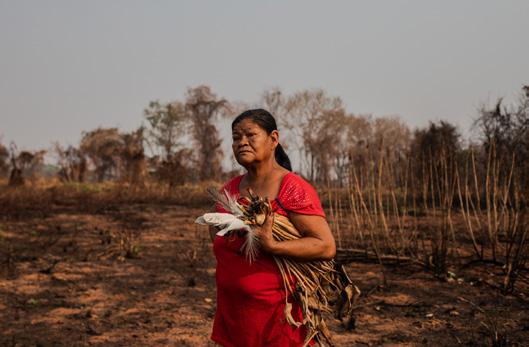
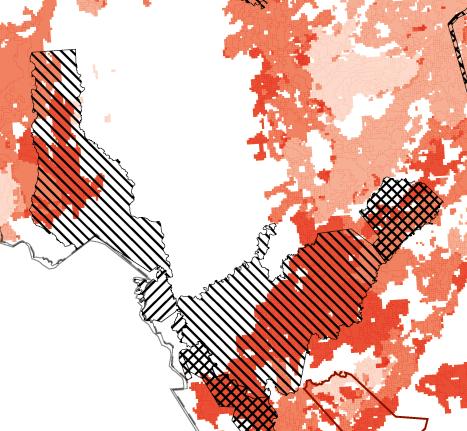
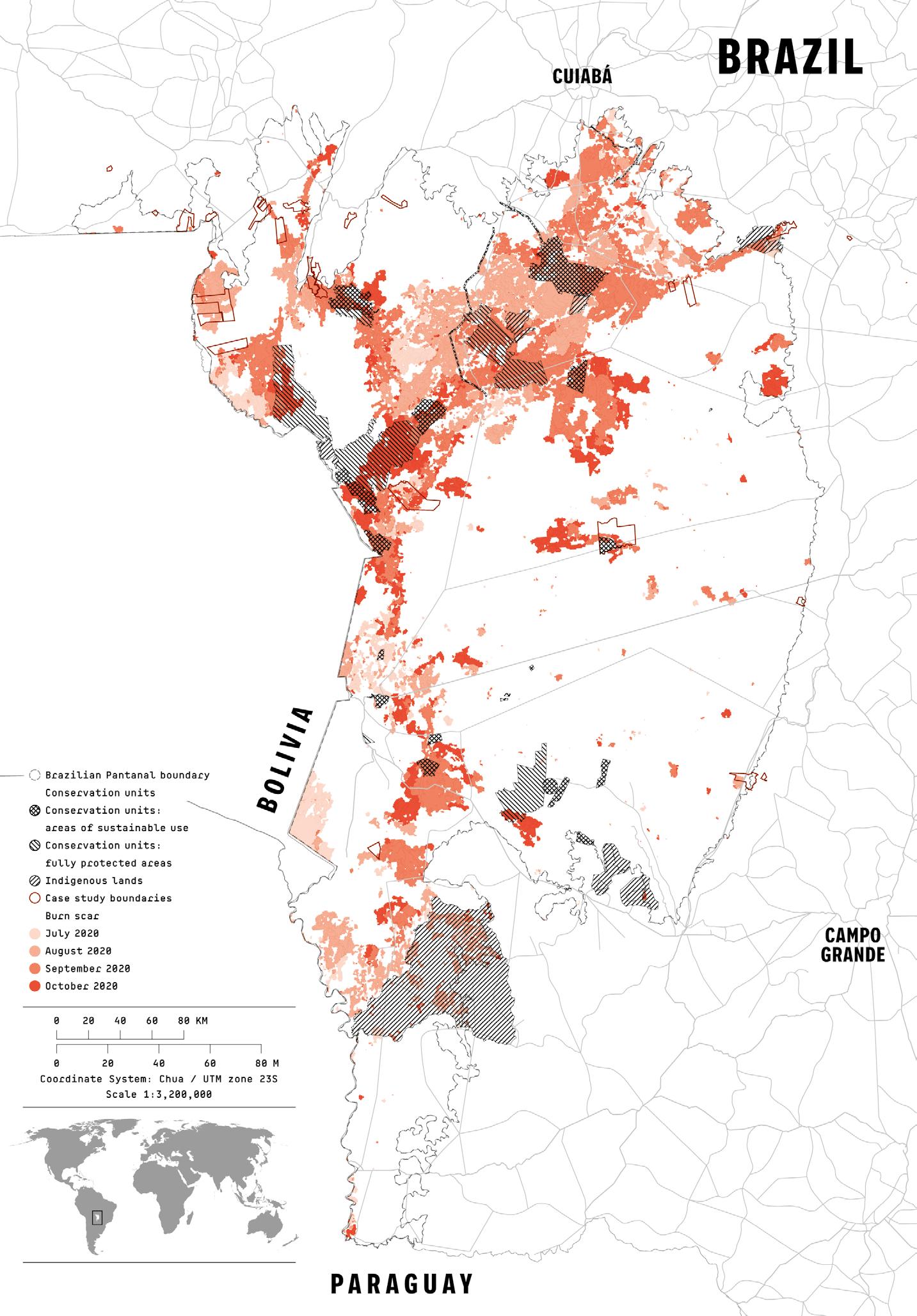

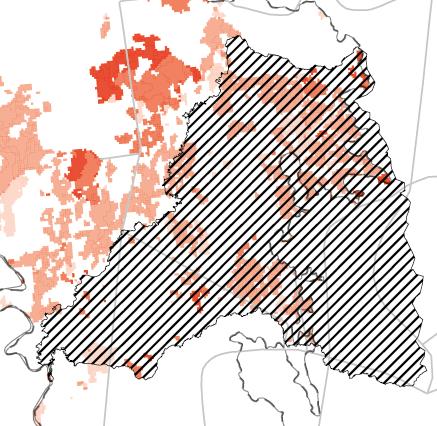
problem because while long-established small-scale pantaneiros know to avoid setting fires when the land is dry, newcomers often have little understanding of traditional methods; moreover, the scale of cattle ranching in the plateaux surrounding the Pantanal is putting pressure on local farmers to increase the size of their herds, using more land as they do so.141
In the Brazilian Pantanal, setting fires during the dry season in 2020 meant defying a federal moratorium on the use of burning for agricultural purposes extending for 120 days from mid-July.142 Regional prohibitions on dry-season burning were also in place in Mato Grosso, from 1 July to 30 September,143 and Mato Grosso do Sul, extending for 180 days from late July.144 Despite these measures, during the course of the year fires spread out of control across the Pantanal. According to the Federal University of Rio de Janeiro’s Laboratory for Environmental Satellite Applications (Laboratório de Aplicações de Satélites Ambientais, LASA), by 22 November 2020 some 30% of the Brazilian portion of the biome had burned, including large portions of several Indigenous territories (an estimated 306,500 ha) and habitats of rare species (approximately
571,900 ha of protected areas); the total – some 4.49 million ha – represents an 84% increase in burned area over 2019 (2.44 million ha).145
Extensive areas of the Pantanal also burned in Bolivia and Paraguay,146 and smoke from the fires drifted as far as Peru, Uruguay and Argentina.147 Within the Pantanal, the toll on wildlife has been severe: while reptiles, amphibians and small mammals are the most likely to be killed in fires, the associated loss of vegetation means that herbivores subsequently starve. The carnivores that rely on them for prey then starve in turn. While the grasslands, scrub and swamps may recover relatively quickly, according to one expert, the recovery of forested areas will take decades or even centuries.148 Some Indigenous communities have seen their entire way of life go up in flames – houses, fields and the forests that provide them with food, building materials and medications.149
Official sources in Brazil have stated that humans are responsible for as many as 98% of the fires in the Pantanal.150 According to the Integrated Multiagency Operational Coordination Centre of Mato Grosso (CIMAN-MT), which was tasked by the Mato Grosso government with investigating fires in five areas of
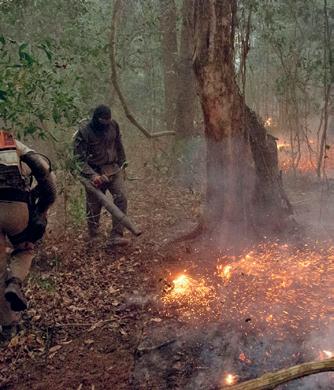
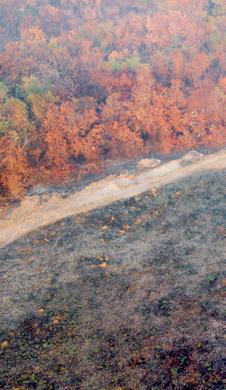
the Pantanal in 2020, all of the blazes investigated were caused by human activity; the fire that destroyed 40,000 ha in the SESC Pantanal Private Natural Heritage Reserve in Barão de Melgaço was determined to have been caused by intentional burning of deforested vegetation to create a pasture area for cattle.151 In Mato Grosso do Sul, in midSeptember federal police executed 10 search and seizure warrants in the municipalities of Corumbá and Campo Grande as part of an investigation seeking to determine criminal responsibility for fires in the southern Pantanal that they suspected were started deliberately,152 possibly in a coordinated manner (as happened in the Amazon’s notorious ‘Day of Fire’ in August 2019153). Five farmers are reportedly being investigated for their role in the fires, which led to the burning of 25,000 ha within the boundaries of the Pantanal Matogrossense National Park and Serra do Amolar in Corumbá; no arrests were immediately made in relation to the fires, although one of the farmers was reportedly arrested for ‘irregular possession’ of a firearm and ammunition.154
Analysis of maps and satellite data by the NGO Instituto Centro de Vida (ICV) indicates that just
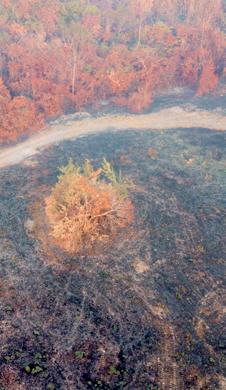
nine points of ignition led to the burning of over two-thirds of the 480,000 ha destroyed by fire between 1 July and 17 August 2020 in the portion of the Pantanal that lies within the state of Mato Grosso, with seven of the nine resulting fire fronts still being active at the end of this period. Five of these nine starting points were located within registered rural properties.155 Further research into the Mato Grosso fires by Repórter Brasil has found that all five registered properties are involved in livestock production.156 Greenpeace analysis of mapping data157 shows that more than 55% of the area that burned within the Brazilian Pantanal from 1 July to 27 October 2020 was located in forests, savannahs or wetlands, with wetlands disproportionately affected by the fires.158
Given the previously mentioned public statements that the fires were almost universally caused by human activity,159 and that many of them seem to have begun on cattle ranches, these findings support the widely reported belief that many of the fires are likely to have been set deliberately – with the intention of clearing natural vegetation for agricultural uses or to rejuvenate pasture – and then burned badly out of control.
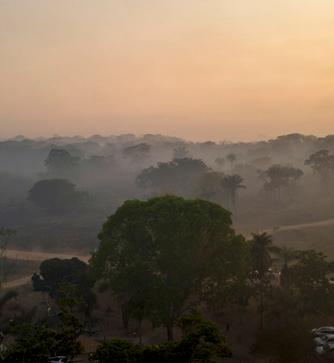
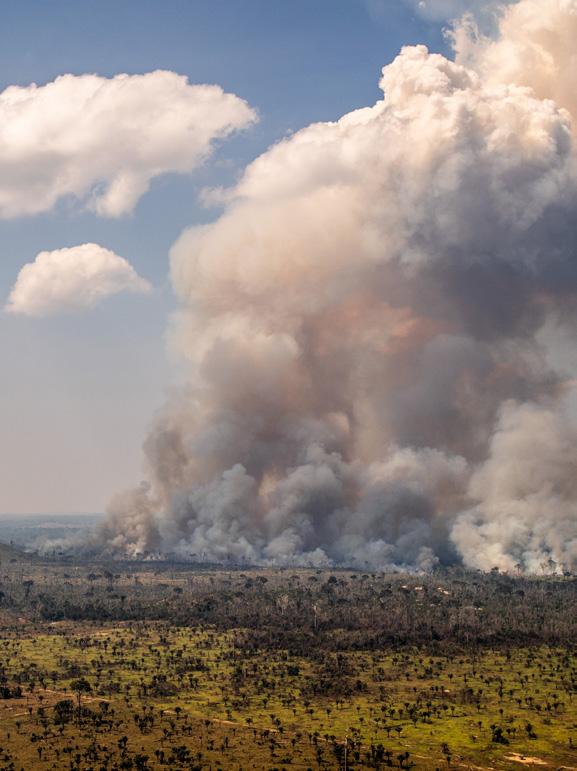

HIGH-RISK REGIMES
– HOW THE BOLSONaRO GOVERNMENT Ha S FaNNED THE FL aMES
The government of President Jair Bolsonaro has reduced the number of agents undertaking inspections in the Amazon. This reduction in oversight has been linked not only to increased deforestation rates but also to increased risk of labour crimes.160 The Bolsonaro government appears to see the current chaos of the global pandemic as an opportunity to further strip away communities’ rights and such protection as the forest has.161 Moreover, Indigenous communities – who are particularly at risk from Covid-19 due to their culture of community living and limited access to health care – are at risk of being made yet more vulnerable to the disease by exposure to smoke from the fires that ranchers set on a massive scale to clear newly felled forest.162
Satellite data reveal that between 1 January and 31 October 2020 there were more fire hotspots in the Pantanal than during the previous four years combined over the same period.163 Nevertheless, Brazil’s Institute of the Environment and Renewable Natural Resources (Instituto Brasileiro do Meio Ambiente e dos Recursos Naturais Renováveis, IBAMA) reportedly imposed barely half as many fines for illegal deforestation and fire-setting across the states of Mato Grosso and Mato Grosso do Sul between 1 January and 14 September 2020 as it did in the equivalent period of 2019, reflecting a reduction in enforcement activity in the field that one official says has led to a sense of impunity.164 According to this and other current and former IBAMA officials (including a former president of the institute) interviewed by BBC News Brasil, while the coronavirus pandemic played a role, the reduction in enforcement efforts was largely due to other factors – including massive staff cuts,165 federal government appointments of managers with no relevant experience (sometimes replacing staff who had been achieving concrete results), needlessly cumbersome and obstructive new procedures and computer systems, and interference by the military.166
‘Pass the cattle’ is the title of a January 2021 report published by the coalition Observatório do Clima. Its cover features an image of the Minister of the Environment Ricardo Salles, who made infamous the idiomatic phrase, which refers to pushing a large volume of things through with minimal scrutiny. In an April 2020 ministerial meeting whose minutes were later made public by a decision of the Supreme Court, Salles recommended wholesale deregulation of environmental and other rules while the media were occupied by the Covid-19 pandemic. Since the beginning of the Bolsonaro administration, Salles has systematically worked to dismantle environmental protection, slashed the budget and staffing of the environmental regulatory agency IBAMA and transferred powers from the Ministry of the Environment.

This last factor is key: since Bolsonaro came to power the federal government has been gradually transferring to the military responsibilities for monitoring and combating illegal deforestation and fire use that historically belonged to civilian agencies, including IBAMA, ICMBio and FUNAI.167 The government has even recently announced that INPE is to be stripped of its three-decades-old responsibility for satellite monitoring of deforestation and fires).168 As well as
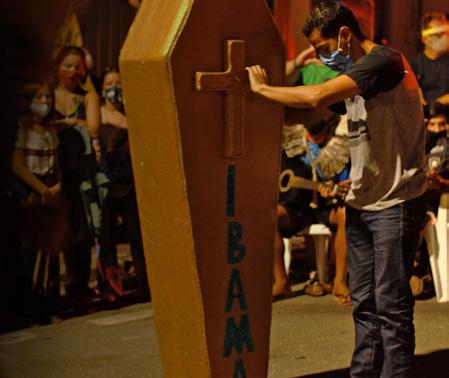
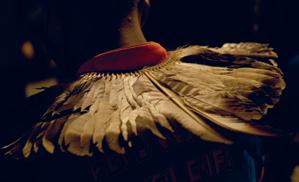
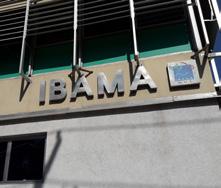
9
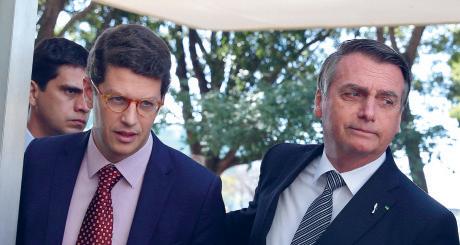
contributing to a serious weakening of enforcement efforts, this process has been interpreted as a heavyhanded attempt to end transparency, making it easier for the authorities to assist forest-destroying industries – eg by building new roads and bridges in the Amazon to open up the forest to exploitation – while claiming to defend the environment.169
The task of extinguishing fires in the Pantanal still falls mainly to IBAMA-coordinated fire brigades, a large proportion of whose members are Indigenous and seasonally hired. One Indigenous representative interviewed by the investigative news agency Pública emphasised the pressing need for firefighter numbers to be increased. However, a fire service representative explained that even though meteorological monitoring made a severe 2020 fire season predictable, a twomonth delay in the hiring process meant that early prevention efforts were hampered by a lack of workers.170 In addition to this inexplicable delay, the federal government reportedly decided to cut the 2020 budget for brigadiers by 58% compared with 2019, which reduced the number of staff that could be taken on.171
According to one environmental academic, ‘What we have is authorities that question numbers, question the extent of the fires, question the capacity of satellites to monitor and detect … this ends up directly encouraging those who commit (environmental) crimes.’172 The former IBAMA president interviewed by BBC News Brasil also blamed statements from President Bolsonaro and other government figures for undermining the work of IBAMA’s inspectors by suggesting that they act with excessive rigour.173 Bolsonaro has even attempted, without evidence, to blame the fires on Indigenous communities174 – but satellite images show that the fires that devastated at least one Indigenous reserve in the Pantanal, Baiá dos Guató, began outside its borders.175
Government figures including Environment Minister
Ricardo Salles and Agriculture Minister Tereza Cristina, as well as President Bolsonaro himself, have also claimed that the Pantanal fires could be combated by grazing land with cattle to ensure that grass is kept short, depriving fires of fuel.176 But this ‘solution’ seems to be no more than an opportunistic way of encouraging further expansion of cattle ranching, which – given that many wildfires begin as fires lit to ‘refresh’ exhausted pasture or to clear other vegetation types (such as felled forest or savannah) for pasture and then burn out of control177 – seems far more likely to exacerbate the problem.
Despite the recent increase in fires in the Amazon and the Pantanal, it is not only funding for hiring personnel that has been reduced under Bolsonaro’s government. According to Brazilian NGO Inesc, compared to 2019 – the last budget authorised by Bolsonaro’s predecessor – 2020’s budget reduced the amounts available for discretionary spending by over 30% for IBAMA and by nearly 33% both for ICMBio, and for direct administration of the Ministry of the Environment (Ministério do Meio Ambiente, MMA).178 The Brazilian Climate Observatory (Observatório do Clima), a network of 37 civil society groups, warns that further severe budget cuts would further compromise the country’s ability to combat deforestation and fires.179
Under pressure from Environment Minister Ricardo Salles to reduce spending, in August 2020 IBAMA decided to cut the number of helicopters it rents to monitor deforestation and fires in the Pantanal and the Amazon – an area covering some 500 million ha – from six to four. The decision was reportedly made over the protests of the head of IBAMA’s Air Operations Centre, who warned of the effects on operational capacity and was subsequently removed from his post. Retired Air Force commander Julio Cesar Basile, who was responsible for creating the agency’s helicopter division in 2000, described it as ‘an absurd and unjustifiable irresponsibility. … If it is not ignorance, it is sabotage.’180
11 September 2020, Brussels: Activists scale the European Commission headquarters, calling attention to the role of European consumption in driving forest destruction. © Johanna de Tessières/Greenpeace
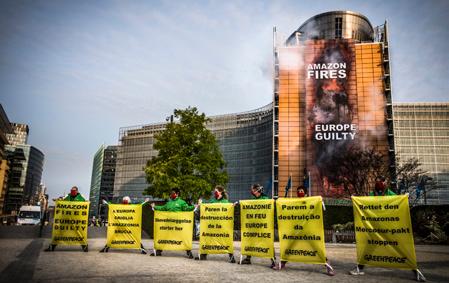
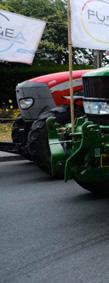
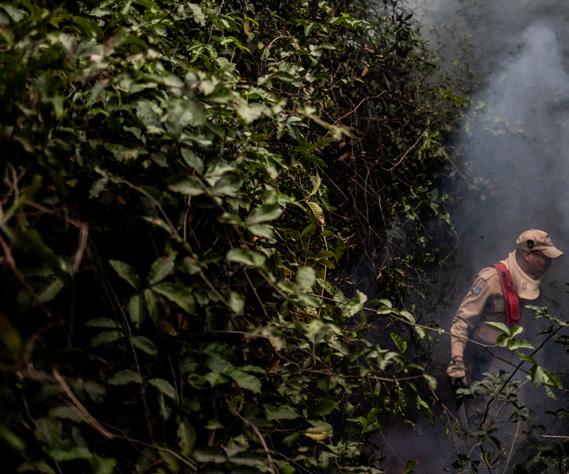
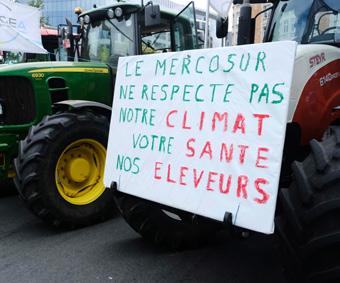
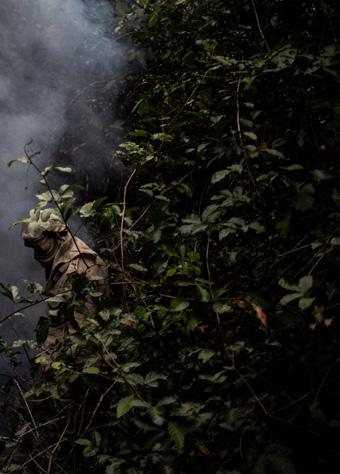
HIGH-RISK TR aDE DE aLS
The EU-Mercosur free trade agreementt (FTA) and related Association Agreement – which aims to increase trade in agricultural products like meat, soya and sugarcane, chemicals like pesticides, as well as manufactured goods such as cars and car parts – was agreed in principle in June 2019.181
Although the aims of the FTA fundamentally undermine climate action and nature protection, and conflict with the goals of the European Green Deal,182 its ratification remains under negotiation by the two blocs. A number of governments have reportedly raised concerns about the deal in light of rising deforestation rates, fires and lack of compliance with the Paris climate agreement in the Mercosur countries (particularly Brazil).183 Further, the proposed treaty does not include sanctionable clauses requiring the signatories to respect climate or environmental protection commitments.184 For example, while Article 6.2(a) of the deal mandates that each Party shall ‘effectively implement the UNFCCC and the Paris Agreement’, no mechanism is provided to meaningfully enforce this single provision.
Under the 2015 Paris Agreement on climate change, countries were expected by the end of 2020 to submit updated plans to reduce their GHG emissions and align with the goal of keeping the global temperature rise this century below 1.5ºC. According to the Climate Observatory coalition, ensuring Brazil – the world’s fifth-largest GHG emitter – is compatible with this goal would require a plan to reduce its emissions by 81% by 2030 compared to 2005 levels, with a net zero target of 2050. But Brazil’s revised submission, announced on 9 December 2020, reportedly falls well short, sticking to its previous goals of reducing net emissions by just 43% by 2030 and aiming for carbon neutrality by 2060. It also fails to reiterate its 2015 commitment to halt all illegal deforestation by 2030 and restore 12 million ha of forests – indeed, it fails to mention deforestation at all.185
It is against this background that the threat from FTAs must be judged. The aim of such agreements is to increase production, trade and consumption of exactly the commodities that the world needs to be producing and consuming less of. This cannot be fixed through the addition or alteration of articles.
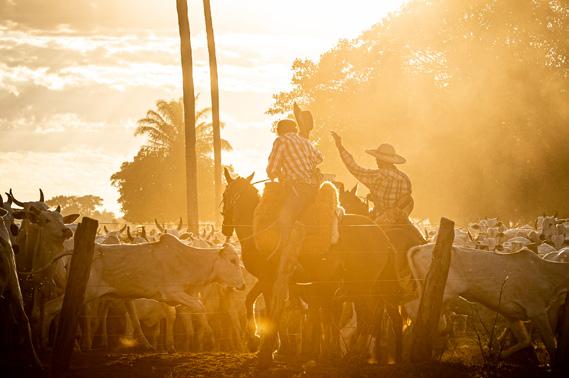
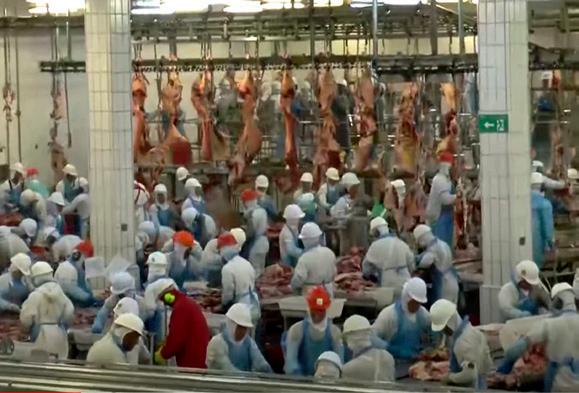


OUT OF THE FIRE aND INTO THE FRYING PaN
Previous exposés by Greenpeace186 and other NGOs have brought attention to the role of industrial beef production in the destruction of the Amazon and the need to ensure full visibility of cattle supply chains beyond direct suppliers within that biome. However, significant destruction of other frontiers – including the Cerrado and the Pantanal – continues, with little public awareness and free from the supply chain monitoring/policy commitments of the main meat processors. This lack of oversight breeds lack of accountability for the wider impacts of the sector.
The purpose of the analysis presented in this report is to shine a spotlight on the destruction of the Pantanal. The first step was to identify ranchers linked to the fires that devastated the biome in 2020, which officials in Brazil agree were almost universally of human origin.187 The next was to investigate whether cattle from the affected properties or others owned by the same ranchers have historically entered the supply chains of Brazil’s largest beef processors, which trade internationally and supply numerous well-known consumer goods and fast food companies.
WH aT IS a N EMBa RGO?
IBAMA publishes a list of farms that have breached environmental legislation such as Brazil’s Forest Code – eg by carrying out illegal deforestation – and that are prohibited (embargoed) from producing in a specified area of their landholding (which may comprise the whole farm or only part of it) until they regularise their situation, for example through payment of a fine and land restoration.
WH aT IS a PROPERTY REGISTR aTION IRREGUL a RITY?
A criterion of Brazil’s Forest Code is that rural producers must register the boundaries of their properties with the environment agency to aid it in its monitoring and enforcement of environmental regulations. Irregularities in this registration –notably its suspension or cancellation – signal problems such as overlap with protected areas, Indigenous lands or other registrations. An irregularity is indicated by a registration status of ‘pending’, ‘suspended’ or ‘cancelled’ in the federal (CAR website ‘Consultar demonstrativo do CAR’) or state (Secretário de Estado de Meio Ambiente de Mato Grosso website ‘SIMCAR portal público’) land registry.
PROFITING FROM THE PaNTaN aL’S DESTRUCTION
Greenpeace has identified 15 current or recent (2018–2019) suppliers of Brazil’s leading meat processors, JBS, Marfrig and Minerva, that are linked to the devastating 2020 fires in the Pantanal, environmental violations resulting in embargoes and/or property registration irregularities.188
Although use of fire was banned by regional governments and presidential decree from July 2020 for a number of months,189 in total more than 73,000 ha – an area larger than Singapore and about half the size of Greater London190 – burned within the boundaries of the case study properties between 1 July and 27 October 2020, and in many cases these fires appear to have contributed to extensive burning far beyond the property limits.
These cases expose the failure of the meat processors to ensure they have adequate due diligence procedures in place to guarantee that dirty cattle from rogue ranchers linked to environmental destruction or legal violations are excluded from their supply base.
Thirteen of the 15 ranchers identified by Greenpeace were tier-one suppliers: they directly supplied one or more of the meat processors from an approved ranch in 2018 or 2019 (the most recent period for which analysis was possible).191 In the majority of instances, the links between the case study properties themselves and the meat processors were indirect –cattle from those properties passed through one or more other ranches before being sent to slaughter. However, in most cases, the intermediary ranches were owned by the same individual.192
The supply chain links established by Greenpeace between the ranchers and the big three meat processors predate the 2020 fires. As confirmed by the company responses to Greenpeace regarding the cases laid out in this report,193 the meat processors deem that all of the ranches that directly supplied them met their policy requirements at the time of purchase. Further, at least 11 of the 15 ranchers apparently remain tier-one suppliers – ie have at least one property approved to directly supply at least one of the meat processors.194 In the case of JBS, three of its current tier-one approvals appear to violate its sourcing policy, as does one of its historic trading relationships – and its assessment of the suppliers’ compliance conflicts with that of Minerva in some instances.195 One of Marfrig’s historic trading relationships similarly appears to violate its sourcing policy,196 despite the company’s assertions about compliance. Marfrig has not indicated that it intends to review these trade relationships more closely.
As for JBS, presented with the summary findings of this report, the company confirmed to an industry journal that for the moment it has no intention to exclude suppliers – tier-one or third-party – that violate its policies. Instead, the emphasis is on getting Amazon suppliers onto a monitoring platform by 2025:
‘Right now, we’re not going to block them [noncompliant suppliers], we’re going to try to help them solve the issue. Sometimes it’s paperwork, sometimes they
need to put together a conservation plan, sometimes they need to reforest part of their property. We are going to help them and we’re hiring people to help these suppliers.’
‘We think excluding the property and the supplier is a negative approach. It won’t solve the problem because they’ll go to the next meat packer and try and sell it. We don’t want that because it won’t address the issue.’ 197
Such an accommodating approach sits uneasily with JBS’s claimed ‘zero tolerance’ to deforestation and certainly fails to send a clear message to the sector that violations come with consequences –they seem to come with bonuses.
Beyond the Amazon, JBS reverts to a simple checklist of official legal findings198 in a country where the government is systematically dismantling environment agencies and undermining law enforcement (see ‘High-risk regimes – how the Bolsonaro government has fanned the flames’ above).199
Disturbingly, the meat processors provided no indication of having imposed meaningful due diligence requirements on their Pantanal suppliers in light of 2020’s federal and state bans on deliberate use of fire, 200 or of any intention to do so despite the summary findings provided of supply to approved ranches from problematic ones. Further, they evidently fail to scrutinise the legal compliance or the environmental impact of their tier-one suppliers across their operations – not just the approved ranches from which they are directly supplied – as part of their screening procedures. Summary findings presented by Greenpeace of legal or policy violations in other operations owned or controlled by tier-one or thirdparty suppliers201 was dismissed or ignored by the meat processors, including details of movement of cattle between those operations and an approved ranch. 202 In one case this evidence included public reports of investigations of potential deliberate use of fire. 203
Among other issues, the consciously blinkered terms of the meat processors’ current approach to supply chain screening in the Pantanal – which focus on the direct supply ranch and not the rancher – enable both ranchers and meat processors to act with impunity when it comes to indirect cattle supplies. Such a lax approach to due diligence enables the most transparent form of cattle laundering – the potential for ranchers to supply cattle from operations that violate law or company policy by passing them through approved intermediary ranches they also own before sending them to slaughter.
While this may serve to boost the cattle trade, it comes at the expense of due diligence on environmental and legal compliance.
The profound deficiencies in the meat processors’ policies and screening procedures for their Pantanal supply base help explain the sector’s failure to end its links to environmental destruction or to close the market to dirty suppliers. These include:
• Failure to effectively and comprehensively ban and monitor for the deliberate use of fire, legal or otherwise.
• Failure to effectively and comprehensively ban and monitor for all new land clearance, not just illegal deforestation and not just within iconic regions such as the Amazon. 204
• Failure to require, as a condition of trade, that ranchers comply with the law and zero deforestation policies across their operations.
• Continued failure to proactively identify and monitor their entire supply base (including indirect supply and third-party suppliers), despite a 2009 agreement to achieve this in the Amazon by 2011. 205
• Failure to make supply chain transparency a condition of trade (ie requiring ranchers to disclose the suppliers and origins of their cattle) and a model for responsible business (ie ensuring the public availability of data on all ranchers in the company’s supply chain, including the locations of their operations, in order to enable independent scrutiny of their impact).
These failures, underpinned by lack of transparency and traceability, both expose and contribute to the industrial meat sector’s continued role as a leading global driver of land-use emissions, biodiversity loss and social injustice. Of particular concern is the potential for cattle linked to deliberate or illegal use of fire to find their way into the international market.
Given such structural failings, it is untenable for international consumer goods companies, supermarkets and fast food companies that claim to have zero deforestation policies to continue to trade with the meat processors named in this report. Further, if trade blocs such as the European Union and the United Kingdom are to end their consumption of products linked to environmental destruction206 and illegal deforestation, 207 then products from these groups should find no place in these markets.
WHO IS SUPPLYING THE ME aT PROCESSORS?
How cattle from ranchers linked to Pantanal destruction contaminate the global market
Ranchers who are either current or recent suppliers of JBS, Marfrig or Minerva, and that are linked to the devastating 2020 fires in the Pantanal, environmental violations and/or property registration irregularities. The focus of meat processors’ supply chain screening in the Pantanal is on the supply ranch rather than the rancher across all operations.
As Greenpeace’s investigation shows, such an approach enables the most transparent form of cattle laundering – the potential for ranchers to supply cattle from operations that violate law or company policy by passing them through approved intermediary ranches they also own before sending them to slaughter.
L aCK OF TR a NSPa RENCY PROVIDES IMPUNITY FOR THE C aTTLE SECTOR
In terms of civil society’s ability to hold the industrial meat sector to account, lack of transparency is particularly problematic in two areas in Brazil: land tenure and cattle movement.
If companies do not know who is producing the commodities they use or trade, or where those producers operate, they cannot know whether the producers are operating responsibly or destroying forests or other ecosystems. If civil society has no oversight, there is no public accountability. The environmental stakes are too high for such ignorance.
Brazil does not have a universal national system to track individual cattle. A large proportion of cattle in Brazil move between ranches over the course of their lives, meaning that indirect supplies (cattle not originating on the ranch from which the slaughterhouse ultimately purchases them) are a significant feature of slaughterhouses’ supply chains. 208 There are multiple stages in the standard four-year production cycle of Brazilian beef, from birth to slaughter, as a result of which cattle often spend time on two or more properties before arrival at the slaughterhouse. 209 It is estimated that as many as 95% of ranches buy from other properties210 – although they may have the same owner. This movement of cattle from ranch to ranch, coupled with a lack of transparency, provides the
opportunity to ‘launder’ animals from ranches where illegal or destructive practices have occurred through ranches not associated with such practices.
In 2020, Brazil’s largest beef processors announced several new initiatives and technological developments to support their commitments in the Amazon and beyond. These include the use of blockchain (JBS), 211 various satellite-based deforestation monitoring platforms and supply chain monitoring tools for the Brazilian cattle sector. 212
The main barriers to clean supply chains and forest protection are not technological. While these services may improve corporate intelligence, they are set to undermine public scrutiny and corporate accountability. Visipec, for instance, used by both Marfrig and Minerva, 213 specifically states that its monitoring tool is ‘not openly available’ and was ‘designed specifically for use by meatpackers (and service providers) … using Visipec will not give NGOs any new information on potential noncompliance issues’. 214
Transparency – public access to high-quality information – is vital to ensuring that commodities sectors can be held to account for their externalised environmental and social costs, and is thus a precondition for any meaningful efforts to address the social injustices and environmental challenges the world faces.
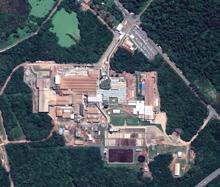
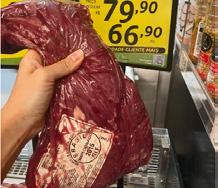
January 2019 – February 2021: Beef from JBS slaughterhouses linked to the Pantanal fires in supermarkets belonging to the French groups Carrefour and Casino as well as Israeli chain Shufersal and Kai Bo Frozen Meat Supermarket in Hong Kong.
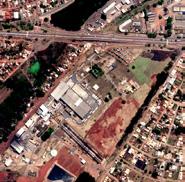
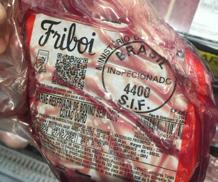


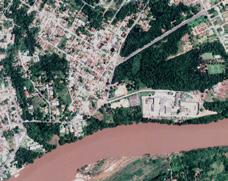

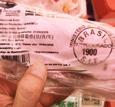

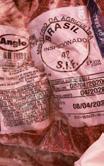
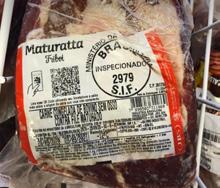
PRIME LOCaTION
– WHERE JBS aND ITS COMPETITORS MaKE MINCEMEaT OF THE PaNTaNaL
JBS a N a STaCIO: SIF 615

In the capital of Mato Grosso do Sul, Campo Grande, JBS has a leather processing facility and two slaughterhouses and meat processing facilities. One of these meat processing facilities (SIF 1662 215) has the capacity to slaughter approximately 1,900 cattle a day;216 the other facility (SIF 4400) manufactures hamburgers and has onsite capacity to slaughter 480–960 cattle a day. 217 Greenpeace Brazil and Repórter Brasil investigations documented significant movement of refrigerated trucks between the two facilities, 218 which suggests that the supply chains may converge. However, JBS refused to confirm trade between the facilities, noting that they are ‘independently registered for inspection purposes [and] they are also in completely different locations miles apart’. 219
This report links four cattle farmers whose ranches in the Pantanal burned in 2020 to one or both of these Campo Grande facilities. One of them, Ivanildo da Cunha Miranda, is reportedly under police investigation for deliberate use of fire on the ranch in question;220 IBAMA has imposed fines and embargoes on two of his other properties as a result of past illegal activities (see below). 221
JBS’s 2019 Annual and Sustainability Report mentions ongoing partnerships with McDonald’s and Burger King and cites a premium brand initiative
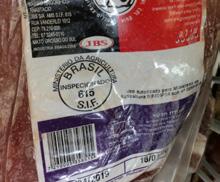
developed with Pão de Açúcar (part of the Casino Group) as ‘a high point for the brand this year’. 222 One of the Campo Grande facilities reportedly supplies meat to all of these big names223 – workers and drivers at the SIF 4400 facility confirmed to investigators in October 2020 that it supplies McDonald’s, 224 and Greenpeace Brazil has also documented beef from the SIF 4400 facility on sale in Pão de Açúcar and Carrefour supermarkets.
But JBS is not the only beef giant with its eyes on the Pantanal. Two of its main competitors and G4 Agreement co-signatories, Marfrig (one of the other processors whose links to deforestation and slavery were exposed in Slaughtering the Amazon) and Minerva, are also supplied by ranchers in the Pantanal, including several whose properties burned in 2020.
Marfrig’s Várzea Grande facility in Mato Grosso (SIF 2015) is reportedly also a supplier of hamburgers to McDonald’s in Brazil, 225 and beef from that establishment has been documented in a Pão de Açúcar supermarket in São Paulo. 226 This is one of the many processing facilities the present investigation found to be supplied directly or indirectly with cattle from ranches where satellite data show fires destroyed swathes of the Pantanal in 2020 (see below).
In addition to supplying some of the big names in Brazil, JBS’s Campo Grande operations export
significant quantities of beef and leather. According to shipping data, between 1 January 2019 and 31 October 2020 JBS exported a total of 95,701 tonnes of beef products and 39,690 tonnes of leather from Campo Grande, with beef products going to 49 countries and territories. The data show that around 34% of the beef exports went to Hong Kong, 8% to the EU-27 (including France, Germany, Greece, Italy, the Netherlands, Portugal, Spain and Sweden) and the UK, and 4% to the USA, with most of the remainder going to Arab countries. 227
Leather from the Campo Grande tannery was reportedly exported to 16 countries; the biggest purchasers were China (59%), Italy (17%), India (8%) and Mexico (6%), while the USA, Spain and Portugal accounted for about 1% each. 228 Nearly all the exports to Mexico and the USA appear to have gone to GST, 229 an international supplier of leather for automobiles that claims its customers include Audi, BMW, Cadillac, Chevrolet, Citroen, Ford, Genesis, GMC, Honda, Human Horizons, Hyundai, KIA, Lexus, Mercedes-Benz, Mini, Nissan, Peugeot, Opel, Porsche, RAM, Toyota and Volkswagen. 230
Of course, Campo Grande is not the only location from which JBS and other meat processors are exporting leather or beef from the Pantanal to the world. Greenpeace has identified a total of 14 meat processing facilities and three tanneries231 owned by JBS, Marfrig or Minerva and one liveanimal export station owned by Minerva that trade globally and have recently been directly or indirectly supplied by 15 ranchers linked to fires in the Pantanal, environmental violations and/or property registration irregularities.
According to shipping data, between the beginning of President Bolsonaro’s term on 1 January 2019 and 31 October 2020 these facilities collectively exported a total of 531,101 tonnes of
beef and beef products, worth nearly US$3 billion. The data show that around 85% of the exports were frozen beef products, with fresh beef and offal accounting for much of the remainder.
Key markets for the exports include Hong Kong (22.4%), China (21.4%) and the EU-27 and the UK (8.2%, representing 11.4% by value). Exports from JBS’s Pantanal-linked facilities alone reportedly accounted for almost US$2 billion over the period, with the EU-27 and the UK representing 9% of the export volume and over 13% of the value. 232
Exports are a primary source of revenue for the Brazilian operations of JBS, Marfrig and Minerva, accounting for 46% of JBS Brazil’s sales, 233 53% of the revenue from Marfrig’s South American operations234 and 66% of Minerva’s gross revenue in 2019. 235 Despite the chaos and economic upheaval caused by the global Covid-19 pandemic, Brazil’s beef exports set a new all-time high in 2020, with volumes reported to have reached 2 million tonnes and revenues some US$8.4 billion – up 11% over 2019. 236 The main global revenue source for JBS SA (as for Marfrig237), however, lies in its North American business units, with the United States alone accounting for around half of the company’s global revenue in the third quarter of 2020. 238
Note: In January 2019 Marfrig and Minerva agreed to a swap of facilities in Paranatinga and Várzea Grande, with Marfrig taking over Minerva’s Várzea Grande (SIF 2015) operations and Minerva taking control of Marfrig’s Paranatinga (SIF 2500) facility. 239 Marfrig Várzea Grande became fully operational on 1 April 2019. 240 Minerva Paranatinga opened on 28 February 2019. 241 The SIF numbers of the facilities remained the same when ownership was transferred.
Ca SE STUDY 1
IVaNILDO Da CUNHa MIR aNDa
BONSUCESSO
TR a DE TO SL aUGHTERHOUSES
2018–2019
JBS Campo Grande (SIF 1662)
IRREGUL a RITIES/ EMB a RGOES/ FINES
+ Involvement in bribery
+ Reported police investigation for deliberate burning
+ Two embargoes
+ R$900,000 (US$420,000) fines
C a SE STUDY Fa ZENDa Bonsucesso
SIC a R #
MS-5003207-0EFCFC9C1C8 949E4BAB3A867AF21257A
C a R STaTUS Active
Fa ZENDa a RE a 32,147 ha
BURNED a RE a 17,228 ha FIRST FIRE 1 July 2020
















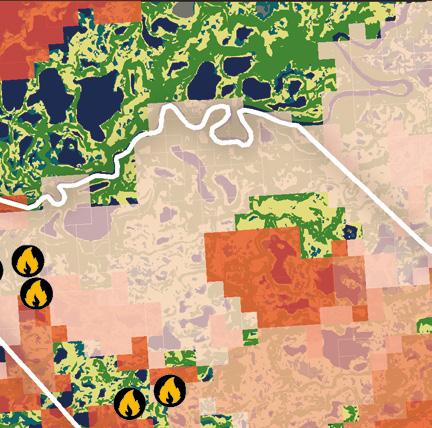







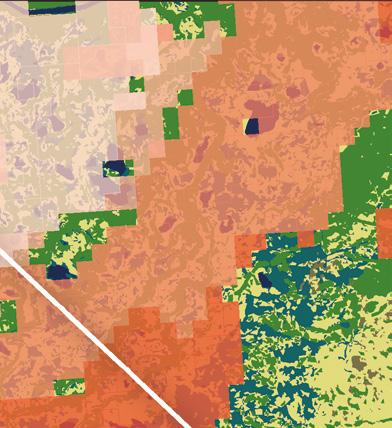






























Ivanildo da Cunha Miranda controls the 32,147 ha Fazenda Bonsucesso (also known as Bom Sucesso– see Figure 1.1), 242 which borders the Pantanal Matogrossense National Park in Corumbá, Mato Grosso do Sul. He was implicated in a bribery scandal several years ago involving JBS and a former governor of Mato Grosso do Sul, in which he acted as an intermediary. 243 IBAMA lists two outstanding embargoes for clearance of native vegetation in Legal Reserves against properties owned by Ivanildo da Cunha Miranda, and he was fined over R$900,000 (US$420,000244) by IBAMA in 2013 (see Figure 1.3). 245 Fazenda Bonsucesso is one of several farms in the area reportedly investigated by federal police in September 2020 for deliberate use of fire, with Ivanildo da Cunha Miranda named by media as its owner;246 maps shared on public news outlets correspond with the CAR boundaries for Fazenda Bonsucesso. 247 NASA satellite imagery 248 shows fire hotspots within the ranch’s boundaries in every previous month of 2020, with a dramatic escalation from July despite





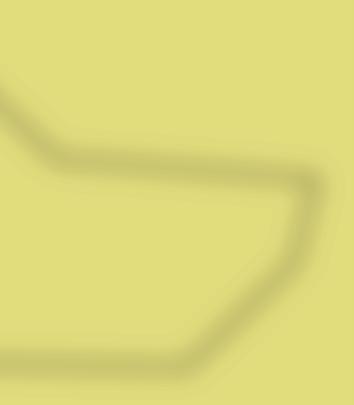



the use of fire being prohibited by a presidential decree that came into force on 16 July 2020 for a period of 120 days. 249 Between 1 July and 27 October 2020 some 17,228 ha burned within the boundaries of the ranch, 250 with the first fire hotspot on the property detected on 1 July 2020. 251
In 2018 and 2019 cattle from ranches owned or controlled by Ivanildo da Cunha Miranda were supplied to a number of other ranchers, one of whom in turn supplied JBS Campo Grande (SIF 1662). 252 Ivanildo da Cunha Miranda was thus a third-party supplier to JBS, and trade from Fazenda Bonsucesso to this facility was indirect.
JBS C a MPO GR a NDE (SIF 1662): On or soon after 23 October 2018 Ivanildo da Cunha Miranda made multiple shipments of cattle from Fazenda Bom Sucesso to Fazenda Boa Vista do Taboco – Araras e Araras I (owned by him). Potentially, up to 200 cattle were transferred. Between 26 October 2018 and
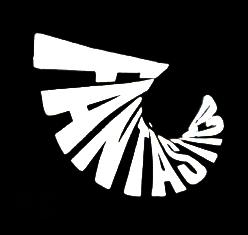

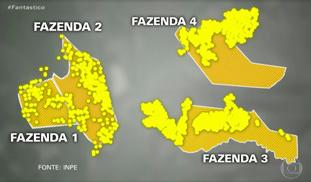

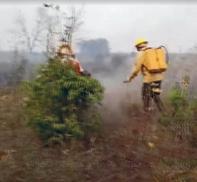
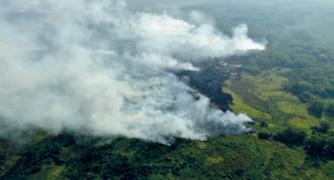
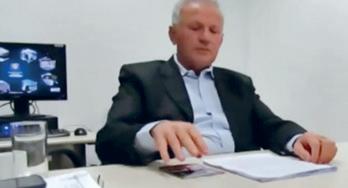
On 20 September 2020, Rede Globo, the largest commercial television station in Latin America and the second largest in the world, aired its Fantástico Sunday news programme, the most-watched Sunday programme in Brazil. The opening nine-minute news item was on Operation ‘Matáá’ (fire), a police investigation into the outbreak of fires within Pantanal ranches in Mato Grosso do Sul. Satellite images show the path the fires had taken, and the report stated that police suspected ‘criminal action by cattle ranchers in the region’. According to the presenters, ‘One of the four farms being investigated by the Federal Police is called “Bonsucesso”. Fires still burning within the property boundary were documented by the police flyover in August 2020. The owner is cattle rancher Ivanildo Miranda. [...] He has been convicted of corruption involving politicians and businessmen. His lawyer said his client did not use or mandate anyone to use fire in his property.’
Source: https://globoplay.globo.com/v/8872066/
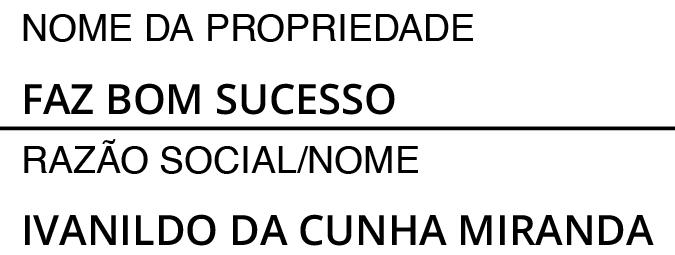
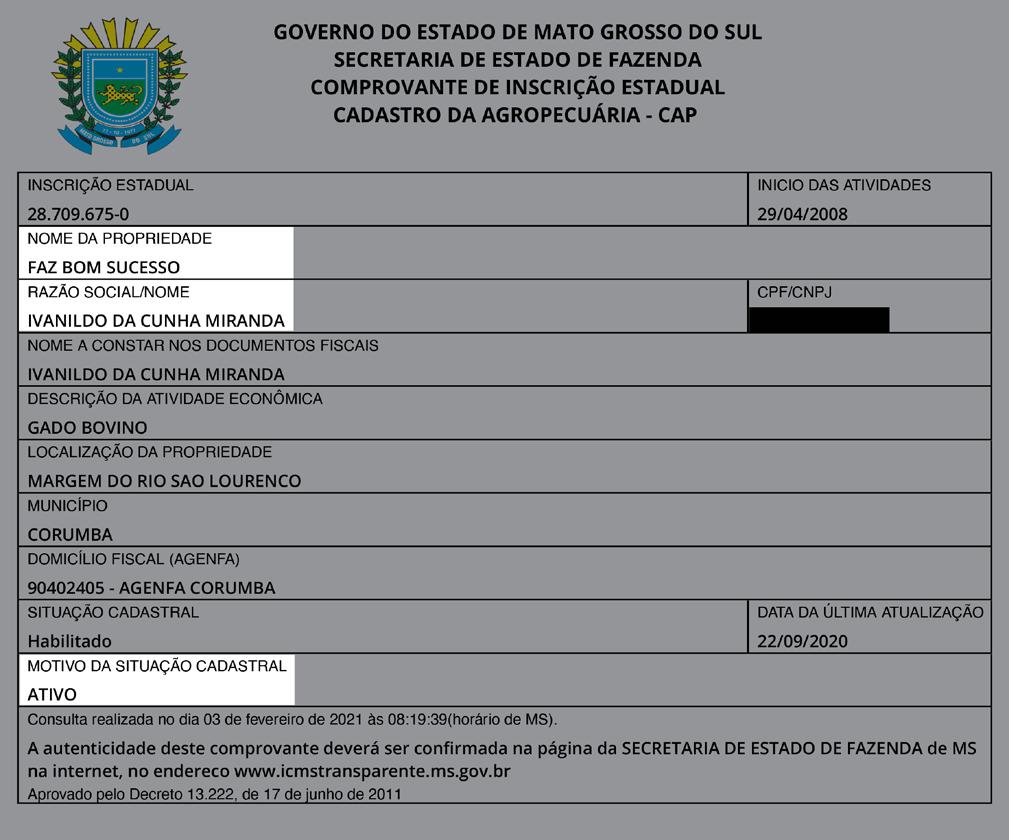


15 February 2019, or soon after, Ivanildo da Cunha Miranda made multiple shipments totalling hundreds of cattle from Fazenda Boa Vista do Taboco – Araras e Araras I to Fazenda Água Branca in Camapuã, Mato Grosso do Sul (owned by Assed Bittar Filho and others – a ranch certified for beef exports to the EU253). Between 14 December 2018 and 30 July 2019, or soon after, Assed Bittar Filho made multiple shipments of cattle from Fazenda Água Branca to JBS Campo Grande (SIF 1662). 254 During this period, Fazenda Água Branca appears to have supplied this facility exclusively. Potentially, up to 970 cattle were transferred. On 30 July 2019 JBS Campo Grande (SIF 1662) slaughtered cattle from a Fazenda Água Branca located in Camapuã, Mato Grosso do Sul (see Figure 1.2). 255
ME aT PROCESSOR RESPONSE
• JBS: ‘In regard to Água Branca Farm, the property is compliant with the Company’s Responsible Procurement Policy. In the case of the properties of Ivanildo da Cunha, [Greenpeace] accuses him, based on media articles from September of last year found on the internet, of being one of those responsible for the fires in the Pantanal. Those articles make reference to a Federal Police investigation which, according to more recent stories also found on the internet, has not yet been concluded. Bonsucesso Farm and Ivanildo’s other properties are not on the JBS active suppliers base.’256
GREENPE aCE OBSERVaTIONS
• JBS gives no meaningful indication that it has proactively reviewed its entire supply base – including in the Pantanal – for deliberate or illegal use of fire.
• JBS gives no indication that it proactively identified and monitored the legal status or environmental impact of its indirect supplies or third-party suppliers in the Pantanal.


Greenpeace revealed in the exchange that one accusation against JBS was based on a Google search which found reports of complaints against a farm in Corumbá. JBS denies any direct connection with this property. Not only do such accusations ‘defy logic as they refer to complaints sometime after the transaction was alleged to have taken place’, it said, they illustrate the challenge it faces in identifying malpractice in deep and complex supply chains where traceability data is confidential to the two parties on each transit permit and not publicly available.
JBS said this particular accusation was “based on confidential data of livestock farmers obtained by Greenpeace, to which we do not have access, this property had supplied a second farm which, in turn, had sold to a third farm, the latter being a JBS cattle supplier.”
The purchases from this property, it said, complied with the Responsible Procurement Policy, respecting at all times the protocols defined by the Federal Prosecutor’s Office.
“Even if JBS had the means of identifying the suppliers of its suppliers’ suppliers, the company could not have foreseen that, more than one year later, according to the press, this farmer, as indicated by Greenpeace, would be investigated for fires in the Pantanal.”
Ca SE STUDY 2 JOÃO FELIX PEREIR a NETO
a IN-OF-CUSTODY
João Felix Pereira Neto owns the 8,712 ha257 Fazenda Atoledal in Água Boa, Mato Grosso. IBAMA lists five embargoes against ranches owned by João Felix Pereira Neto – one of which covers the entirety of Fazenda Atoledal – as well as fines totalling more than R$1.65 million (US$640,000) for unlicensed deforestation in various of his ranches (see Figures 2.1 and 2.2). 258 Despite the embargo on Fazenda Atoledal, plans have been announced to build a private 5-million-tonne grain terminal within its boundaries on the Paraguay River. 259 Between 1 July 2020 and 27 October 2020 at least 4,864 ha burned within the boundaries of the ranch (which falls partially outside the limits of the Pantanal assessed for burn scar by LASA), with the first fire hotspots on the property detected on 1 September 2020.
In 2018 and 2019 cattle from ranches owned by João Felix Pereira Neto were supplied directly to the JBS Diamantino (SIF 3000) and Marfrig Pontes e Lacerda (SIF 1900) facilities, as well as indirectly to JBS Água Boa (SIF 4121) and JBS Barra do Garças (SIF 42). 260 João Felix Pereira Neto was thus both a tierone and a third-party supplier to JBS and a tier-one supplier to Marfrig; trade from Fazenda Atoledal was indirect to three of the named facilities.
JBS ÁGUa BOa (SIF 4121): Between 20 December 2018 and 20 March 2019, or soon after, João Felix Pereira Neto made multiple shipments of cattle from Fazenda Atoledal to Fazenda Sete de Setembro in Água Boa, Mato Grosso (owned by Darce Ramalho dos Santos, though trade is apparently managed by Samoel Alexandroni Santos; while it is currently listed as active in the federal CAR registry with the date of the last revision given as 5 August 2018, 261 the Mato Grosso state registry lists this ranch’s property registration as suspended as of 29 June 2020262 – see Figures 2.4 and 2.5). Potentially, up to 1,120 cattle were transferred. Between 3 January 2019 and 25 November 2019, or soon after, Samoel Alexandroni Santos made multiple shipments of cattle from
TR a DE TO SL aUGHTERHOUSES 2018–2019
JBS Diamantino (SIF 3000)
Marfrig Pontes e Lacerda (SIF 1900)
JBS Água Boa (SIF 4121)
JBS Barra do Garças (SIF 42)
R a NCHER IRREGUL a RITIES/ EMB a RGOES/ FINES
+ Five embargoes
+ More than R$1.65 million (US$640,000) fines
+ Trade with ranches with property registration irregularities
C a SE STUDY Fa ZENDa Atoledal
SIC a R #
MT-5102504-622E591250F B4100812827853D7351B7
C a R STaTUS Active Fa ZENDa a RE a 8,712 ha BURNED a RE a 4,864 ha FIRST FIRE 1 September 2020
Fazenda Sete de Setembro to JBS Água Boa. Potentially, up to 1,170 cattle were transferred. On 25 November 2019 JBS Água Boa slaughtered cattle from a Fazenda Sete de Setembro, located in Água Boa, Mato Grosso. 263
JBS BaRRa DO GaRÇaS (SIF 42): Between 20 December 2018 and 20 March 2019, or soon after, João Felix Pereira Neto made multiple shipments of cattle from Fazenda Atoledal to Fazenda Sete de Setembro (see bullet above). Potentially, up to 1,120 cattle were transferred. Between 17 October 2019 and 30 October 2019, or soon after, Samoel Alexandroni Santos made multiple shipments of cattle from Fazenda Sete de Setembro to JBS Barra do Garças. On 18 October 2018 and 19 October 2018, JBS Barra do Garças slaughtered cattle from a Fazenda Sete de Setembro located in Água Boa, Mato Grosso (see Figure 2.3). 264
M a RFRIG PONTES E L aCERDa (SIF 1900): Between 6 November 2018 and 7 May 2019, or soon after, João Felix Pereira Neto made multiple shipments of cattle from Fazenda Atoledal to Fazenda Pederneiras in Cáceres, Mato Grosso (Fazenda Pederneiras Novas is also owned by João Felix Pereira Neto; though currently listed as active in the Mato Grosso state registry 265 the federal CAR website lists the ranch’s property registration status as ‘cancelled’ with the date of analysis given as 17 July 2019 and the date of the last revision given as 23 October 2019266 – see Figures 2.6 and 2.7). Potentially, up to 1,425 cattle were transferred. Between 12 November 2018 and 21 May 2019, or soon after, João Felix Pereira Neto made multiple shipments of cattle from Fazenda Pederneiras to Marfrig Pontes e Lacerda. Potentially, up to 850 cattle were transferred. On 14 November 2018 and 23 and 24 May 2019, Marfrig Pontes e Lacerda slaughtered cattle from João Felix Pereira Neto’s Fazenda Pederneiras. 267
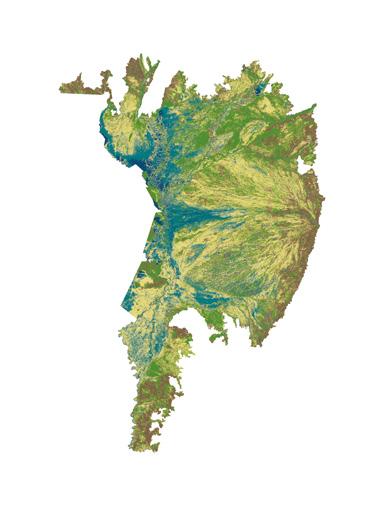



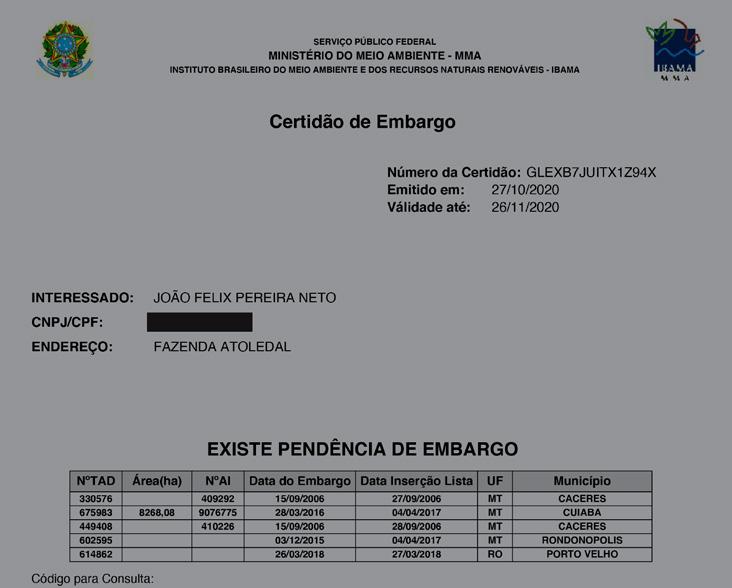
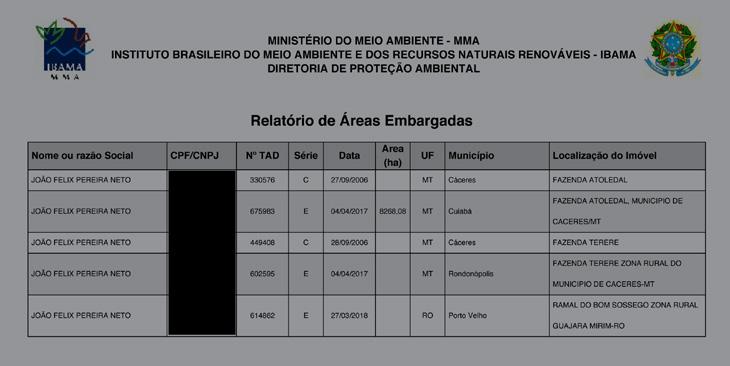
ME aT PROCESSOR RESPONSE

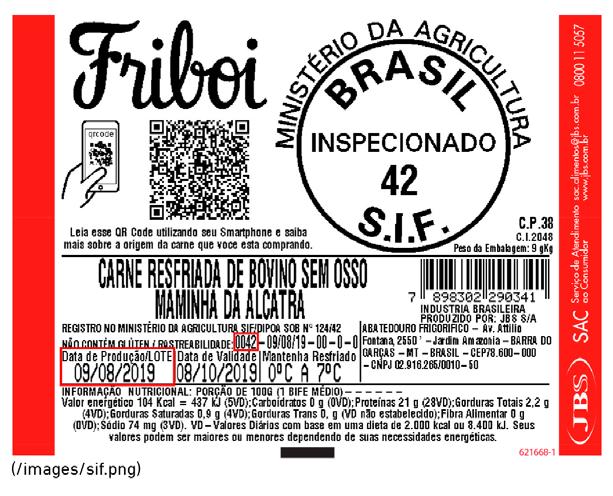

GREENPE aCE OBSERVaTIONS
• JBS’S assertion that its direct supply ranch Fazenda Sete de Setembro is compliant with its procurement policy is controversial.
• M a RFRIG’S assertion that its direct supply ranch Fazenda Pederneiras Novas was compliant with its procurement policy on the last slaughter date is controversial.
• JBS: ‘JBS is using SICAR, the federal record, to check the status of the supplier’s CAR. Sete de Setembro Farm, besides complying with the Company’s Responsible Procurement Policy, has the ACTIVE status registered on this platform and, therefore, is able to commercialize raw materials with us. Atoledal Farm is not part of our active supplier base.’268
• M a RFRIG: ‘The (State or Federal) CAR status is checked in slaughter previews; if it is not active, the slaughter is not carried out until it is active. On the slaughter date, the state CAR status of Fazenda Perderneiras [sic] Novas was “active”. … Fazenda Pederneiras Novas was not subject to an embargo by IBAMA on the slaughter date. The last slaughter from Fazenda Pederneiras Novas was on July 7, 2020. Fazenda Atoledal is not included in Marfrig’s supplier list.’269
• Both JBS and M a RFRIG appear to take as sufficient indication of a ranch’s compliance with policy the listing of an active status on either the federal or the state CAR website, even where the listings differ.
• JBS failed to confirm the current or historic status of the direct trade relationship between João Felix Pereira Neto and JBS Diamantino (SIF 3000) – identified trade to this facility was direct from Fazenda Pederneiras Novas in April 2018.
• M a RFRIG failed to confirm the current status of the operations of João Felix Pereira Neto, a 2018–2020 tier-one supplier to its facilities.
• Neither JBS nor M a RFRIG gives any meaningful indication that it has proactively reviewed its entire supply base –including in the Pantanal – for deliberate or illegal use of fire.
• Neither JBS nor M a RFRIG gives any indication that it proactively identified and monitored the legal status or environmental impact of these indirect supplies or thirdparty suppliers in the Pantanal.
Figures 2.4 and 2.5: State and federal CAR information for Sete de Setembro

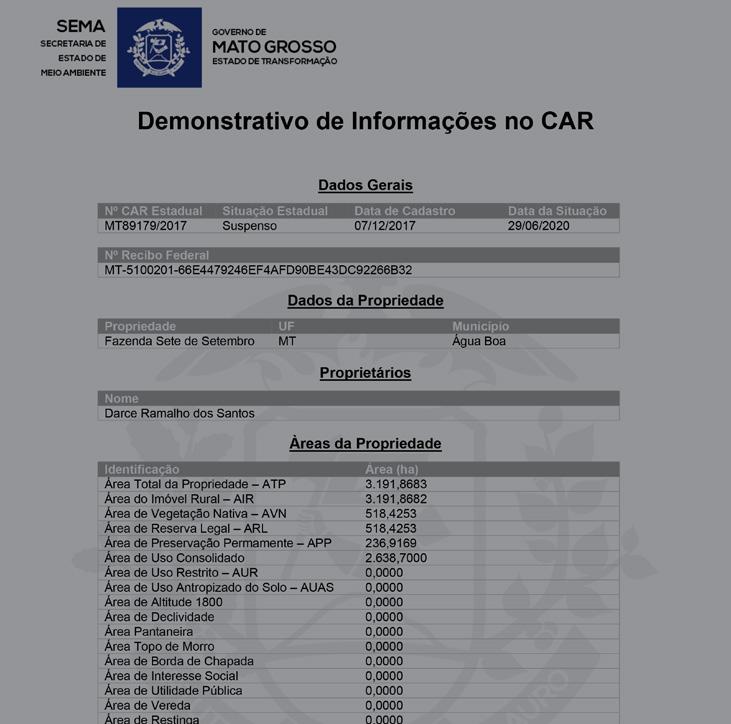

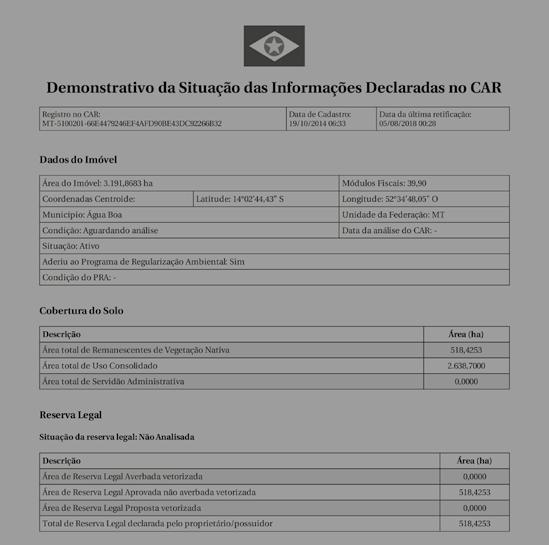

Figures 2.6 and 2.7: Federal and state CAR information for Pederneiras Novas
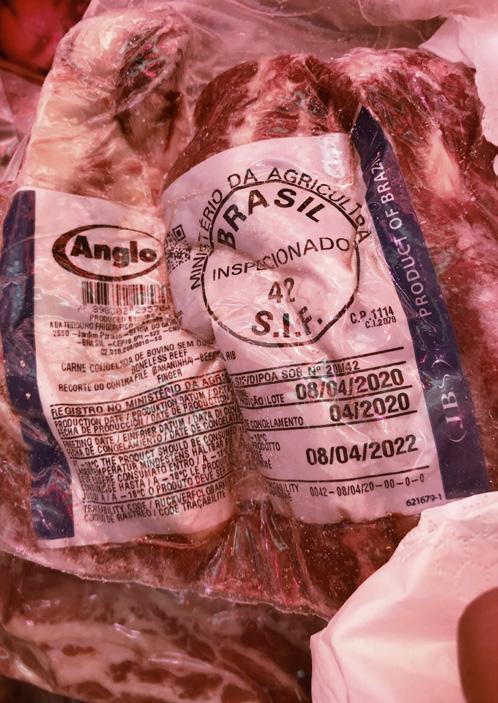




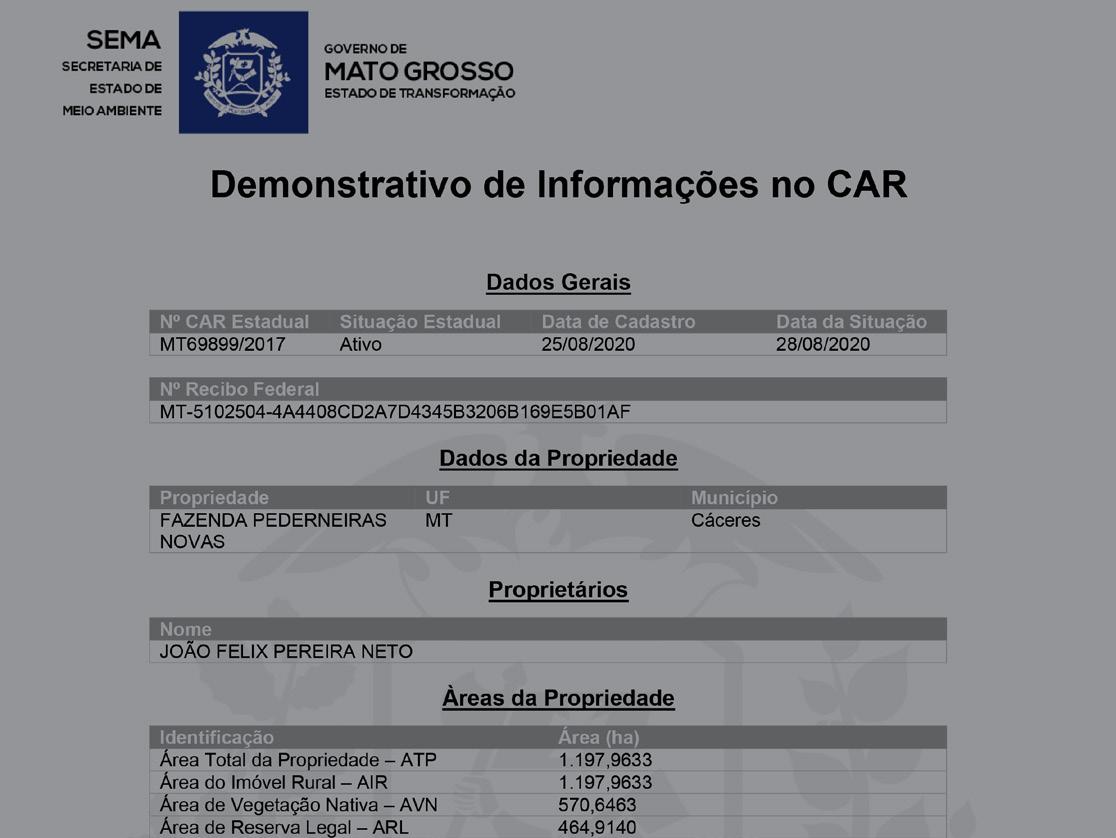
Ca SE STUDY 3 aDEVaIR DE OLIVEIR a
RECREIO
TR a DE TO SL aUGHTERHOUSES 2018–2019
JBS Araputanga (SIF 2979)
JBS Pontes e Lacerda (SIF 51)
Marfrig Pontes e Lacerda (SIF 1900)
Marfrig Várzea Grande (SIF 2015)
Minerva Mirassol d’Oeste (SIF 2911)
Minerva Várzea Grande (SIF 2015)
R a NCHER IRREGUL a RITIES/ EMB a RGOES/ FINES
+ Embargo
+ Multiple deforestation violations
+ Suspended CAR registration
C a SE STUDY Fa ZENDa
Recreio
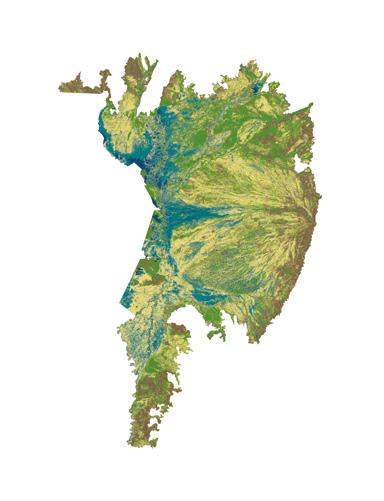
SIC a R # MT-5102504-89CAE072B3
EE459E8856CB4BB71C29E1
C a R STaTUS
Pending (federal) as of 4 August 2018
Active (Mato Grosso state) as of 9 November 2020
Fa ZENDa a RE a 14,428 ha
BURNED a RE a 2,990 ha
FIRST FIRE 26 July 2020
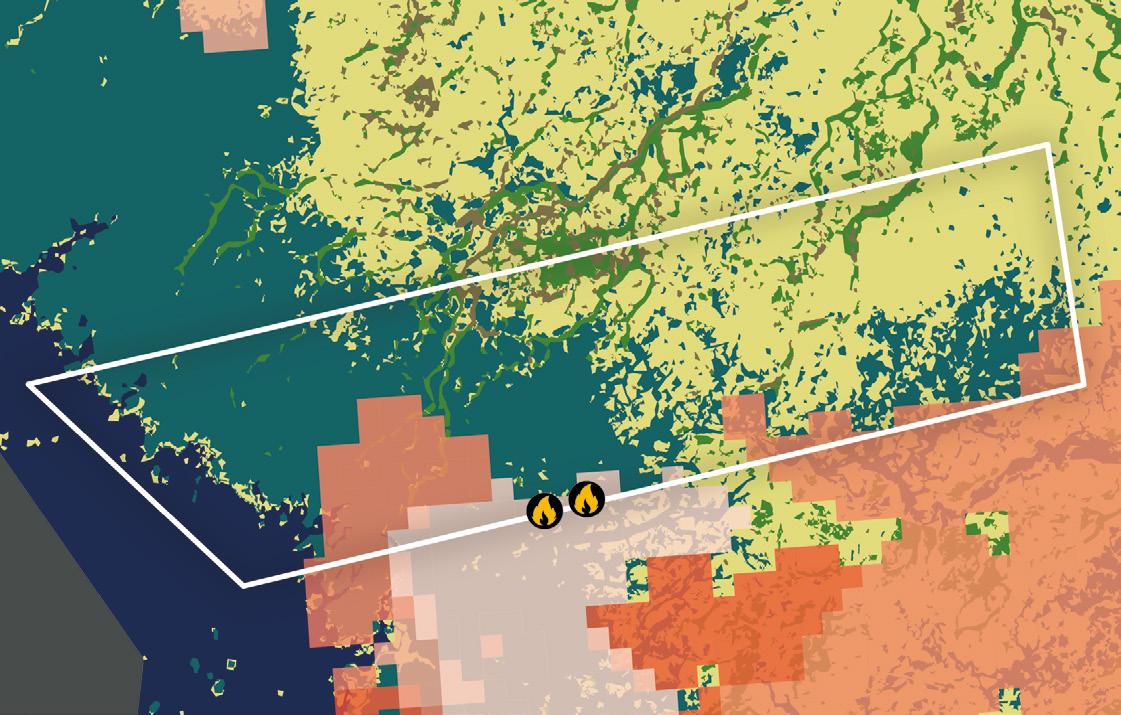
Adevair de Oliveira owns the 14,428 ha Fazenda Recreio in Cáceres, Mato Grosso. The Mato Grosso State environment agency lists seven deforestation violations between 2017 and 2020 against another ranch owned by Adevair de Oliveira, with a total embargoed area of about 428 ha. 270 The federal CAR website lists Fazenda Recreio’s property registration status as ‘pending’, with the date of analysis given as 28 January 2016 and the date of the last revision given as 4 August 2018 (see Figure 3.3);271 according to the site, this status indicates an incorrect declaration, overlap with Indigenous lands or conservation units, or other irregularities. 272 The Mato Grosso state registry lists the registration as active as of 4 February 2021, based on maps of the same date. 273 Between 1 July 2020 and 27 October 2020 some 2,990 ha burned within the boundaries of the ranch, with the first fire hotspots on the property detected on 26 July 2020.
In 2018 and 2019, cattle from ranches owned by Adevair de Oliveira were supplied to the JBS Araputanga (SIF 2979), JBS
Pontes e Lacerda (SIF 51), Marfrig Pontes e Lacerda (SIF 1900), Marfrig Várzea Grande (SIF 2015), Minerva Mirassol d’Oeste (SIF 2911) and Minerva Várzea Grande (SIF 2015) facilities. 274 No direct trade was authorised from Fazenda Recreio to these facilities, but Greenpeace identified extensive movement between Fazenda Recreio and other ranches owned by Adevair de Oliveira, including Fazenda Boa Sorte (Cáceres, Mato Grosso), Fazenda Vitória (Cáceres, Mato Grosso) and Fazenda São Benedito das Lajes (Cáceres, Mato Grosso). These in turn have all supplied Fazenda Jaraguá (Porto Esperidião, Mato Grosso), which appears to be the main ranch from which Adevair de Oliveira trades cattle to all the big slaughterhouses, and which is certified for beef exports to the EU. 275 Thus, cattle from Fazenda Recreio may ultimately have made their way to all the facilities supplied by this operation. The identified trade links show that Adevair de Oliveira was a tier-one supplier to all three meat processors, and trade from Fazenda Recreio was indirect to all the named facilities.


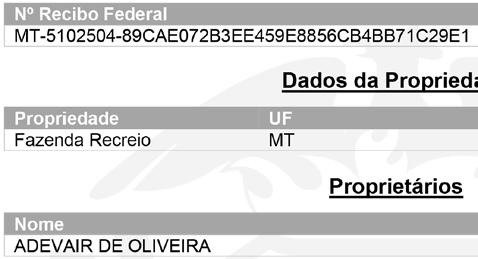
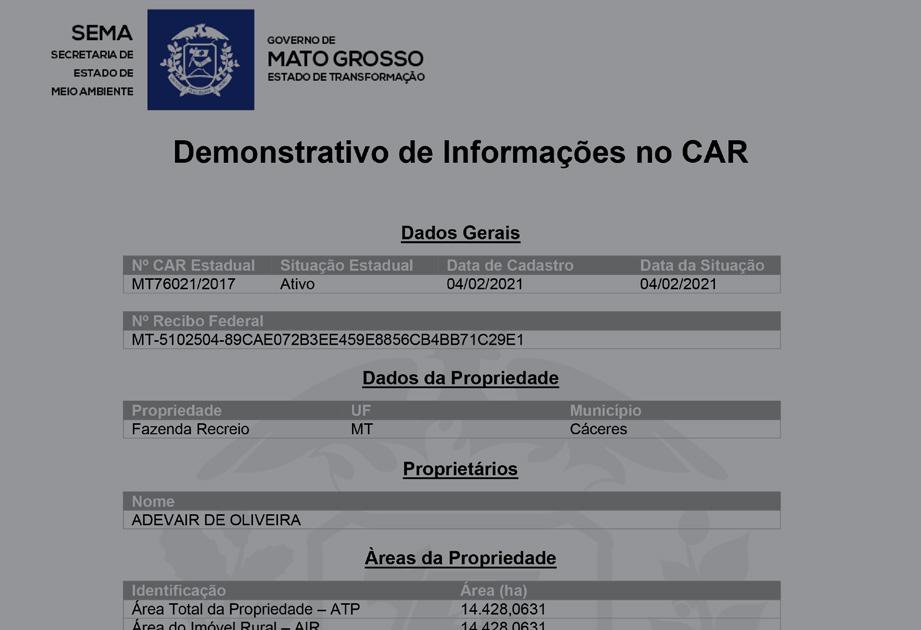
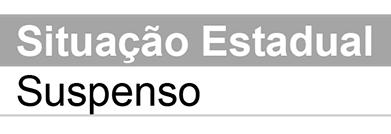


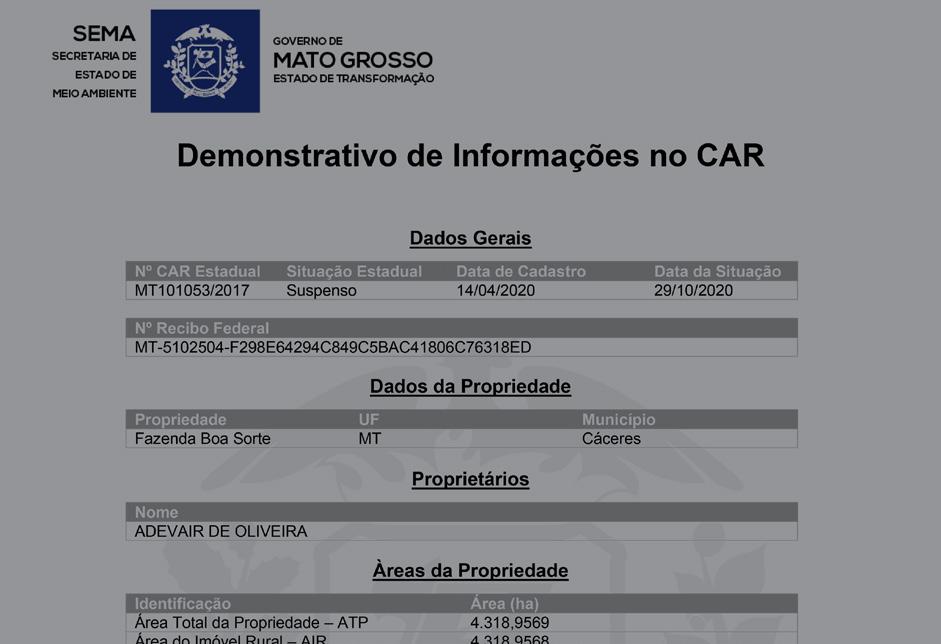

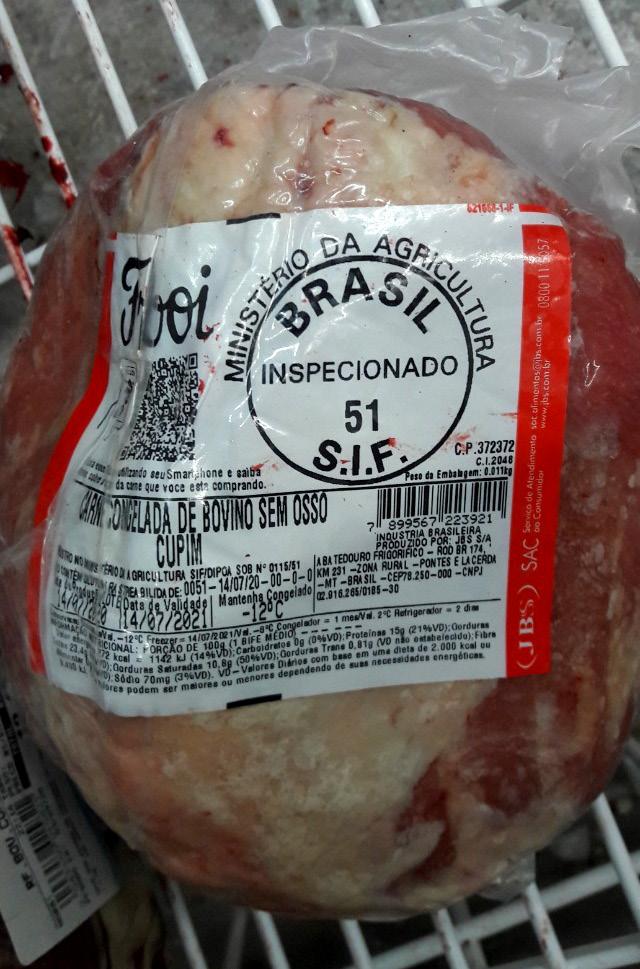

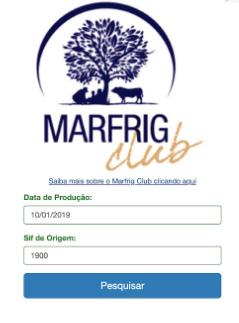

JBS PONTES E LaCERDa (SIF 51): On or soon after 15 January 2018
Adevair de Oliveira made multiple shipments of cattle from Fazenda Recreio to Fazenda Vitória (also owned by him). On or soon after 19 January 2018 Adevair de Oliveira made multiple shipments of cattle from Fazenda Vitória to JBS Pontes e Lacerda. On 22 January 2018 JBS Pontes e Lacerda slaughtered cattle from a Fazenda Vitória located in Cáceres, Mato Grosso. 276
MaRFRIG PONTES E LaCERDa (SIF 1900): Between 15 January 2018 and 3 September 2018, or soon after, Adevair de Oliveira made multiple shipments of cattle from Fazenda Recreio to Fazenda Boa Sorte (also owned by him; the Mato Grosso state environment agency lists the property registration as suspended as of 4 February 2021 based on maps of the same date277 and the federal CAR website lists the ranch’s status as ‘cancelled’ with the date of analysis given as 29 October 2020 and the date of the last revision given as 30 June 2020278). Potentially, up to 1,450 cattle were transferred. On or soon after 8 January 2019 Adevair de Oliveira made multiple shipments of cattle from Fazenda Boa Sorte to Marfrig Pontes e Lacerda. Potentially, up to 100 cattle were transferred. On 10 January 2019 Marfrig Pontes e Lacerda slaughtered cattle from Adevair de Oliveira’s Fazenda Boa Sorte (Figure 3.4). 279
M a RFRIG VÁRZE a GR a NDE (SIF 2015): Between 15 January 2018 and 15 March 2019, or soon after, Adevair de Oliveira made multiple shipments of cattle from Fazenda Recreio to Fazenda Boa Sorte (also owned by him; see bullet above). Potentially, up to 2,880 cattle were transferred. Between 24 May 2019 and 27 June 2019, or soon after, Adevair de Oliveira made multiple shipments of cattle from Fazenda Boa Sorte to Marfrig Várzea Grande. Potentially, up to 240 cattle were transferred. On 27 May 2019 and 1 July 2019, Marfrig Várzea Grande slaughtered cattle from Adevair de Oliveira’s Fazenda Boa Sorte; the Marfrig ‘Conheça a origem da nossa carne’ website also states that cattle from Adevair de Oliveira’s Fazenda Boa Sorte were slaughtered on 29 July 2019. 280 Between 15 January 2018 and 28 June 2019, or soon after, Adevair de Oliveira made multiple shipments of cattle from Fazenda Recreio to Fazenda Vitória (also owned by him). Potentially, up to 2,890 cattle were transferred. Between 9 May 2019 and 26 July 2019, or soon after, Adevair de Oliveira made multiple small shipments of cattle from Fazenda Vitória to Marfrig Várzea Grande. On 13 May 2019 and 29 July 2019, Marfrig Várzea Grande slaughtered cattle from Adevair de Oliveira’s Fazenda Vitória. 281
MINERVa VÁRZE a GR a NDE (SIF 2015): Between 15 January 2018 and 29 November 2018, or soon after, Adevair de Oliveira made multiple shipments of cattle from Fazenda Recreio to Fazenda Vitória (also owned by him). Potentially, up to 1,650 cattle were
transferred. Between 8 June 2018 and 30 November 2018, or soon after, Adevair de Oliveira made multiple shipments of cattle for slaughter from Fazenda Vitória to Minerva Várzea Grande. Potentially, up to 730 cattle were transferred.
MINERVa MIRaSSOL D’OESTE (SIF 2911): Between 15 January 2018 and 3 August 2018, or soon after, Adevair de Oliveira made multiple shipments of cattle from Fazenda Recreio to Fazenda Vitória (also owned by him). Potentially, up to 1,510 cattle were transferred. Between 7 February 2018 and 3 August 2018, or soon after, Adevair de Oliveira made multiple shipments of cattle for slaughter from Fazenda Vitoria to Minerva Mirassol d’Oeste. Potentially, up to 300 cattle were transferred.
ME aT PROCESSOR RESPONSE
• JBS: ‘[Greenpeace] alleges that Adevair de Oliveira has violations for deforestation on another property. However, this was not the case of the Vitória Farm at the time of the purchase by JBS, and it continues to comply with the Company’s Responsible Procurement Policy. In regard to Recreio Farm, it is not part of our active supplier base. … Boa Sorte Farm, besides complying with the Company’s Responsible Procurement Policy, has the ACTIVE status registered on the State SICAR and, therefore, is able to commercialize raw materials with us.’282
• M a RFRIG: ‘On the slaughter date, the state CAR status of Fazenda Boa Sorte was “active”. The Individual Taxpayer’s ID (CPF) of the supplier is also checked in the list of Embargoed Areas of the Secretariat of Environment of Mato Grosso (SEMA-MT). If there is a restriction and the farm is the reason for the embargo, the slaughter is not carried out. On this date, Fazenda Boa Sorte was cleared at the Secretariat of Environment of Mato Grosso (SEMA-MT). The last slaughter from Fazenda Boa Sorte [at SIF 1900] was on January 10, 2019. Fazenda Recreio is not included in Marfrig’s supplier list. … The last slaughter from Fazenda Boa Sorte [at SIF 2015] was on February 27, 2020. … On the slaughter date, Fazenda Vitória was in compliance with all the criteria of the company’s public commitments. The last slaughter [at SIF 2015] was on July 7, 2020.’283
• MINERVa: ‘[Fazenda Vitória] is listed in Minerva’s database and is eligible for commercialization. In addition, the Company would like to underline that a CAR in pending status is not a criterion for restriction. This status is a result of some administrative delay between the supplier and the Secretary of the Environment. The analysis that has already been carried out contemplates the verification of environmental restrictions such as deforestation, overlapping protected areas, and state and federal embargoes. Regarding the designation of another property embargoed by
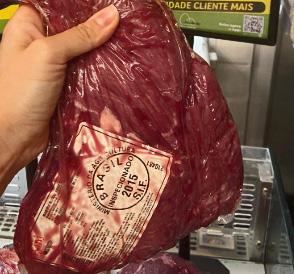
the producer, we are unaware of such information as we do not have the ranch registered in our database. … [Fazenda Recreio] is not registered in Minerva’s database.’284
GREENPE aCE OBSERVaTIONS
• JBS’S assertion that Fazenda Boa Sorte is compliant with its procurement policy is controversial. Its assertion that the ranch has an active listing on the Mato Grosso state registry is not supported by documentation held by Greenpeace.
• MINERVa’S claim that a ‘pending’ CAR status is not a criterion for restriction is controversial.
• JBS’S response confirms that Adevair de Oliveira remains a current tier-one supplier.
• M a RFRIG failed to confirm the current status of the operations of Adevair de Oliveira, a 2019–2020 tier-one supplier to its facilities.
• MINERVa’S response confirms that Adevair de Oliveira remains a current tier-one supplier.
• NONE OF THE ME aT PROCESSORS gives any meaningful indication that it has proactively reviewed its entire supply base – including in the Pantanal – for deliberate or illegal use of fire.
• NONE OF THE ME aT PROCESSORS gives any indication that it proactively identified and monitored the legal status or environmental impact of these indirect supplies or third-party suppliers in the Pantanal.
Ca SE STUDY 4 R aUL aMaR aL CaMPOS
ESPER aNÇa aND ESPER aNÇa RETIRO II
TR a DE TO SL aUGHTERHOUSES 2018–2019
JBS Pedra Preta (SIF 2019)
Marfrig Paranatinga (SIF 2500)
Marfrig Várzea Grande (SIF 2015)
Minerva Várzea Grande (SIF 2015)
R a NCHER IRREGUL a RITIES/ EMB a RGOES/ FINES
+ 14 embargoes
+ R$11 million (US$6.6 million) fine
C a SE STUDY Fa ZENDa S Esperança Retiro II Esperança
SIC a R #
MT-5101605-58DD3A8922D54E288AEB44B2818E7C80 and MT-5107800-AB91ED61AA704077986A8B8DA89BDBB7
C a R STaTUS
Active
Fa ZENDa a RE a S Esperança Retiro II: 2,500 ha Esperança: 9,330 ha
BURNED a RE a S Esperança Retiro II: 1,337 ha and Esperança: 1,352 ha
FIRST FIRES
7 September 2020 and 11 September 2020
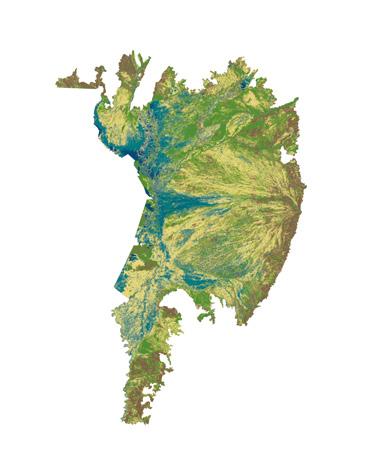
Burnscar
Burnscar
Burnscar
Burnscar
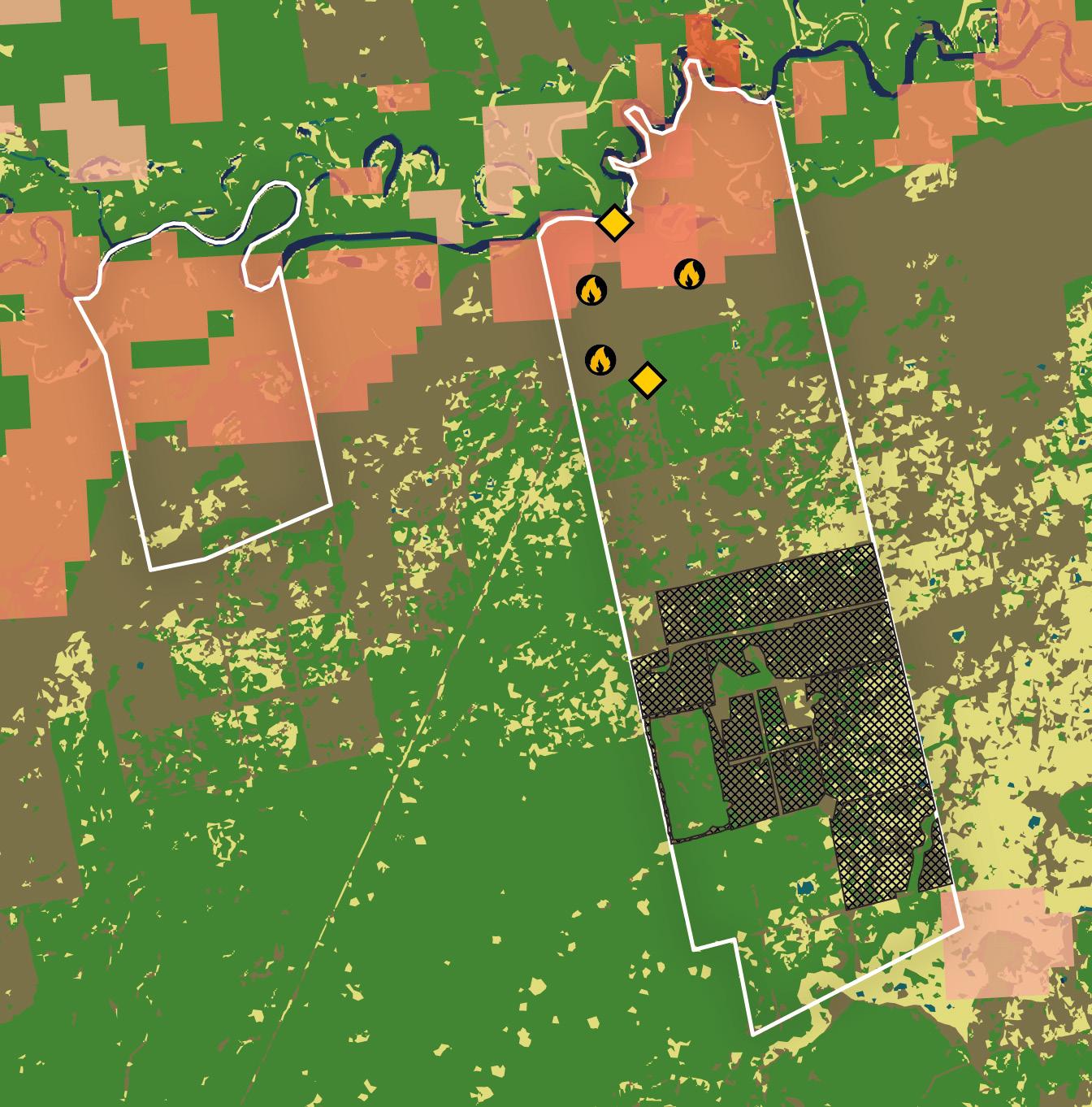
Raul Amaral Campos is the owner of the 2,500 ha Fazenda Esperança Retiro II and the 9,330 ha Fazenda Esperança (held jointly with Dora Nougues Amaral Campos via Agropecuária Itapajé LTDA and in close proximity to the other ranch) in Santo Antônio do Leverger, Mato Grosso. In 2011, IBAMA issued him with a R$11 million (US$6.6 million) fine (see Figure 4.2)285 for the unlicensed destruction of 2,206 ha of vegetation in an area covered by special Pantanal protection on Fazenda Esperança, 286 and the ranch has 14 embargo listings between 2013 and 2016 covering about 2,478 ha. 287 Between 1 July 2020 and 27 October 2020 some 1,337 ha burned within the boundaries of Fazenda Esperança Retiro II, with fire hotspots detected on the property from 7 September 2020; 1,352 ha also burned within the boundaries of Fazenda Esperança, with fire hotspots detected on the property from 11 September 2020. In 2018 and 2019 cattle from ranches owned or part-owned by Raul Amaral Campos were supplied to the JBS Pedra Preta (SIF 2019), Marfrig Paranatinga (SIF 2500), Marfrig Várzea Grande (SIF 2015) and Minerva Várzea Grande (SIF 2015) facilities. 288 No authorised trade from Fazenda Esperança Retiro II has been identified, but Fazenda Esperança supplied JBS Pedra Preta (SIF 2019) directly and all four facilities indirectly, via another ranch owned by a company whose partners include Raul Amaral Campos (Haras Fazenda Itapajé VII, located in Rondonópolis, Mato Grosso). 289 Raul Amaral Campos, who manages the trade of cattle from Fazenda Esperança and Haras Fazenda Itapajé VII, is also named as a (or the) rancher associated with four ranches certified for beef exports to the EU, including Haras Fazenda Itapajé VII. 290 Raul Amaral Campos was thus a tier-one supplier to all three meat processors; trade from Fazenda Esperança was both direct and indirect to JBS and was indirect to Marfrig and Minerva.
JBS PEDRa PRETa (SIF 2019): Between 22 January 2018 and 5 February 2019, or soon after, Raul Amaral Campos made multiple direct shipments of cattle for slaughter from Fazenda Esperança to JBS Pedra Preta (see Figure 4.1). Potentially, up to 600 cattle were transferred. JBS Pedra Preta slaughtered cattle from a Fazenda Esperança located in Santo Antônio do Leverger, Mato Grosso on 24 January 2018 and 7 February 2019. 291 Between 4
January 2018 and 22 July 2019, or soon after, Raul Amaral Campos made multiple shipments of cattle from Fazenda Esperança to Haras Fazenda Itapajé VII. Potentially, up to 480 cattle were transferred. Between 26 January 2018 and 26 November 2019, or soon after, Raul Amaral Campos made multiple shipments of cattle from Haras Fazenda Itapajé VII to JBS Pedra Preta. Potentially, up to 2,100 cattle were transferred. JBS Pedra Preta slaughtered cattle from a Haras Fazenda Itapajé VII located in Rondonópolis, Mato Grosso, on 30 January 2018 and 28 November 2019. 292
M a RFRIG Pa R a N aTING a (SIF 2500): On or soon after 4 January 2018 Raul Amaral Campos made a small shipment of cattle from Fazenda Esperança to Haras Fazenda Itapajé VII. On or soon after 8 May 2018 Raul Amaral Campos made multiple shipments of cattle from Haras Fazenda Itapajé VII to Marfrig Paranatinga. Potentially, up to 170 cattle were transferred. Marfrig Paranatinga slaughtered cattle from Haras Fazenda Itapajé VII on 10 May 2018. 293
M a RFRIG VÁRZE a GR a NDE (SIF 2015): Between 4 January 2018 and 22 July 2019, or soon after, Raul Amaral Campos made multiple shipments of cattle from Fazenda Esperança to Haras Fazenda Itapajé VII. Potentially, up to 480 cattle were transferred. Between 24 June 2019 and 14 August 2019, or soon after, Raul Amaral Campos made multiple shipments of cattle from Haras Fazenda Itapajé VII to Marfrig Várzea Grande. Potentially, up to 680 cattle were transferred. Marfrig Varzea Grande slaughtered cattle from Haras Fazenda Itapajé VII on 16 August 2019. 294
MINERVa VÁRZE a GR a NDE (SIF 2015): On or soon after 4 January 2018 Raul Amaral Campos made a small shipment of cattle from Fazenda Esperança to Haras Fazenda Itapajé VII. On or soon after 15 June 2018 Raul Amaral Campos made multiple shipments of cattle for slaughter from Haras Fazenda Itapajé VII to Minerva Várzea Grande. Potentially, up to 150 cattle were transferred.
ME aT PROCESSOR RESPONSE
• JBS: ‘At the time of purchase, Esperança Farm was compliant with the Company’s Responsible Procurement Policy. The embargo to which [Greenpeace] refers is associated with another property. … At the time of purchase, Fazenda Haras Itapaje VII [sic] was compliant with the Company’s Responsible Procurement Policy.’295
• M a RFRIG: ‘The last slaughter [of cattle from Haras Fazenda Itapajé VII at SIF 2500] was on May 10, 2018. … The last slaughter [of cattle from Haras Fazenda Itapajé VII at SIF 2015] was on September 9, 2020. Fazenda Esperança is not included in Marfrig’s supplier list.’296
• MINERVa : ‘[Haras Fazenda Itapajé VII] is listed in Minerva’s database and is eligible for commercialization. Fazenda Esperança, identified in the report, is located 103.75 km away from the property under analysis, thereby not constituting the same production unit. It is worth mentioning that it has an overlap with SEMA MT’s environmental liabilities, registered on behalf of AGROPECUARIA ITAPAJE LTDA, under the CNPJ: 25,309,068/0001-88, with embargo term No. 0017GT and infraction notice No. 0017GT, which does not correspond to the information of the supplier RAUL AMARAL CAMPOS. … [Fazenda Esperança] is not registered in Minerva’s database.’297
GREENPE aCE OBSERVaTIONS
• JBS’S assertion that Fazenda Esperança was compliant with its procurement policy at the time of purchase is controversial. Its claims that the embargoes (several were imposed between 2013 and 2016) relate to another ranch are not supported by documentation held by Greenpeace, or indeed the conclusions reached by Minerva.
• MINERVa, unlike JBS, has correctly identified Fazenda Esperança and the embargoes on the ranch. However, given that Fazenda Esperança has supplied Haras Fazenda Itapajé VII, confirmed by Minerva as a current direct supply ranch, it is clear that the company’s due diligence does not extend beyond the first point of contact. It is unclear what conclusion Minerva intends to be drawn from its comment about ownership, given that both Fazenda Esperança and Minerva’s direct supply ranch Haras Fazenda Itapajé VII are owned by Agropecuária Itapajé LTDA (a holding company whose partners include Raul Amaral Campos) and that Raul Amaral Campos is named on fines from IBAMA linked to Fazenda Esperança as well as on Haras Fazenda Itapajé VII’s certificate for EU beef exports. 298
• JBS’S response failed to confirm the current status of Raul Amaral Campos as a tier-one supplier, through either Fazenda Esperança or Haras Fazenda Itapajé VII.
• M a RFRIG failed to confirm the current status of the operations of Raul Amaral Campos, a 2018–2020 tier-one supplier to its facilities.
• MINERVa’S response confirms that Raul Amaral Campos remains a current tier-one supplier.
• NONE OF THE ME aT PROCESSORS gives any meaningful indication that it has proactively reviewed its entire supply base – including in the Pantanal – for deliberate or illegal use of fire.
• NONE OF THE ME aT PROCESSORS gives any indication that it proactively identified and monitored the legal status or environmental impact of these indirect supplies or thirdparty suppliers in the Pantanal.
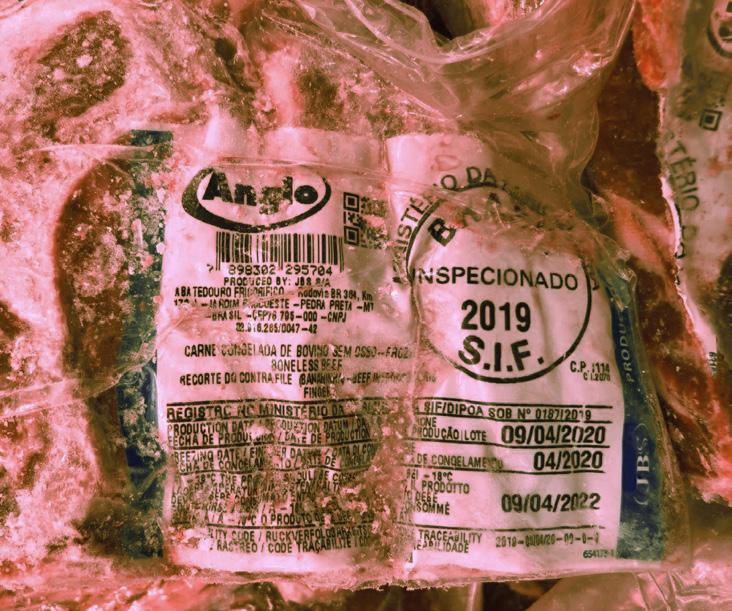
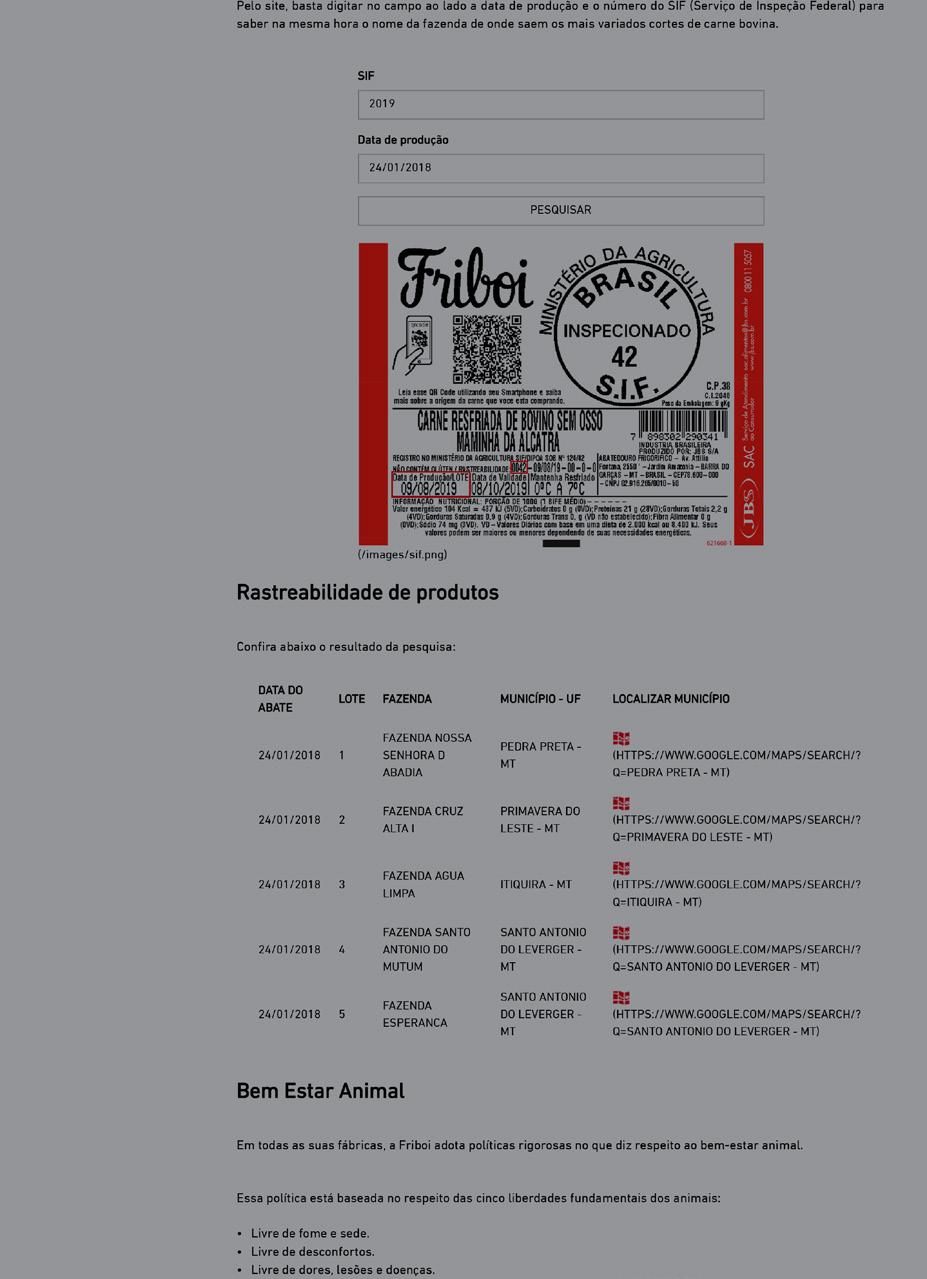



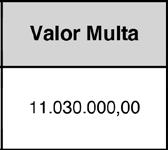
Ca SE STUDY 5 JOSE
DaLBEM
SaNTa CaTaRINa
TR a DE TO SL aUGHTERHOUSES 2018–2019
JBS Araputanga (SIF 2979)
JBS Pontes e Lacerda (SIF 51)
Marfrig Pontes e Lacerda (SIF 1900)
Marfrig Várzea Grande (SIF 2015)
Minerva Mirassol d’Oeste (SIF 2911)
Minerva Abaetetuba (live exports)
R a NCHER IRREGUL a RITIES/ EMB a RGOES/ FINES
+ Seven embargoes
+ R$30,000 (US$10,000) fine
C a SE STUDY Fa ZENDa Santa Catarina
SIC a R #
MT-5102504-F9E45B7D3C7 14407847AFED14F910181
C a R STaTUS Active Fa ZENDa a RE a 9,135 ha
BURNED a RE a 2,888 ha FIRST FIRE 4 September 2020

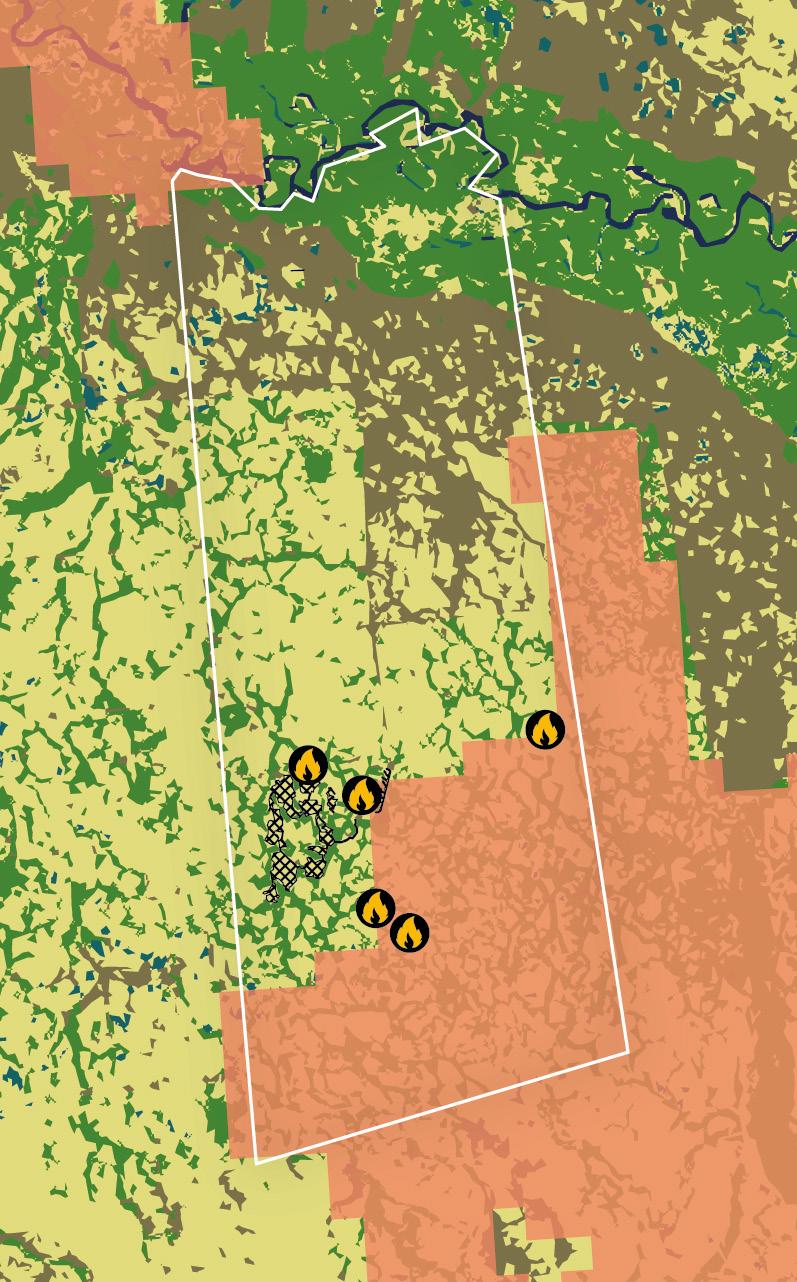
Jose Dalbem owns the 9,135 ha Fazenda Santa Catarina in Cáceres, Mato Grosso. He was fined R$30,000 (US$10,000) by IBAMA in 2003 299 for clearance of 300 ha of ‘primary cerrado’.300 Fazenda Santa Catarina has seven embargo listings between 2019 and 2020 covering about 90 ha.301 Between 1 July 2020 and 27 October 2020 some 2,888 ha burned within the boundaries of this ranch, with fire hotspots detected on the property from 4 September 2020. In 2018 and 2019 cattle from ranches owned by Jose Dalbem were supplied to the JBS Araputanga (SIF 2979), JBS Pontes e Lacerda (SIF 51), Marfrig Pontes e Lacerda (SIF 1900), Marfrig Várzea Grande (SIF 2015), Minerva Abaetetuba (a ‘pre-shipment station and office for export of live cattle’302) and Minerva Mirassol d’Oeste (SIF 2911) facilities.303 Jose Dalbem was thus a tier-one supplier to all three meat processors, and trade from Fazenda Santa Catarina to the named facilities was both direct and indirect.
JBS a R a PUTa NG a (SIF 2979): Between 3 April 2018 and 29 August 2018, or soon after, Jose Dalbem made multiple shipments of cattle from Fazenda Santa Catarina to Fazenda Santo Antônio (also located in Cáceres and owned by Jose Dalbem, and certified for beef exports to the EU304). Potentially, up to 1,730 cattle were transferred. On or soon after 31 August 2018 Jose Dalbem made one shipment of a total of some 50 cattle from Fazenda Santo Antônio to JBS Araputanga. On 3 September 2018 JBS Araputanga slaughtered cattle from a Fazenda Antônio, located in Cáceres, Mato Grosso.305
JBS PONTES E L aCERDa (SIF 51): Between 6 March 2018 and 12 April 2018, or soon after, Jose Dalbem made multiple small direct shipments of cattle from Fazenda Santa Catarina to JBS Pontes e Lacerda. On 9 March 2018 and 18 April 2018 JBS Pontes e Lacerda slaughtered cattle from a Fazenda Santa Catarina located in Cáceres, Mato Grosso.306
M a RFRIG PONTES E L aCERDa (SIF 1900): On or soon after 25 March 2019 Jose Dalbem made two direct shipments of a total of some 40 cattle from Fazenda Santa Catarina to Marfrig Pontes e Lacerda. On 26 March Marfrig Pontes e Lacerda slaughtered cattle from Jose Dalbem’s Fazenda Santa Catarina.307 Between 3 April 2018 and 21 February 2019, or soon after, Jose Dalbem made multiple shipments of cattle from Fazenda Santa Catarina to Fazenda Santo Antônio (also owned by him). Potentially, up to 2,440 cattle were transferred. On or soon after 15 March 2019 Jose Dalbem made multiple small shipments of cattle from Fazenda Santo Antônio to Marfrig Pontes e Lacerda. Marfrig Pontes e Lacerda slaughtered cattle from Jose Dalbem’s Fazenda Santo Antônio on 19 March 2019.308
M a RFRIG VÁRZE a GR a NDE (SIF 2015): On or soon after 17 June 2019 Jose Dalbem made one direct shipment of more than 30 cattle from Fazenda Santa Catarina to Marfrig Várzea Grande. Marfrig Várzea Grande slaughtered cattle from Jose Dalbem’s Fazenda Santa Catarina on 19 June 2019.309 Between 3 April 2018 and 9 July 2019, or soon after, Jose Dalbem made multiple shipments of cattle from Fazenda Santa Catarina to Fazenda Santo Antônio (also owned by him). Potentially, up to 2,700 cattle were transferred. Between 9 April 2019 and 25 November 2019, or soon after, Jose Dalbem made multiple shipments of cattle from Fazenda Santo Antônio to Marfrig Várzea Grande. Potentially, up to 450 cattle were transferred. Marfrig Várzea Grande slaughtered cattle from Jose Dalbem’s Fazenda Santo Antonio on 11 April 2019 and 26 November 2019.310
MINERVa MIR a SSOL D’OESTE (SIF 2911): Between 3 April 2018 and 22 October 2018, or soon after, Jose Dalbem made multiple shipments of cattle from Fazenda Santa Catarina to Fazenda Santo Antônio (also owned by him).
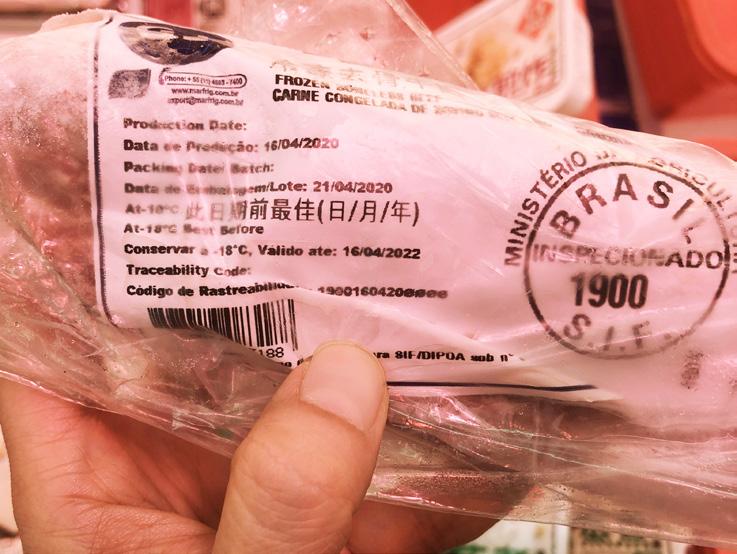
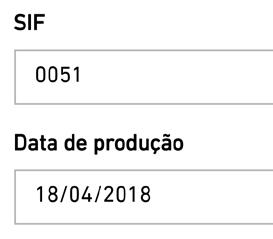
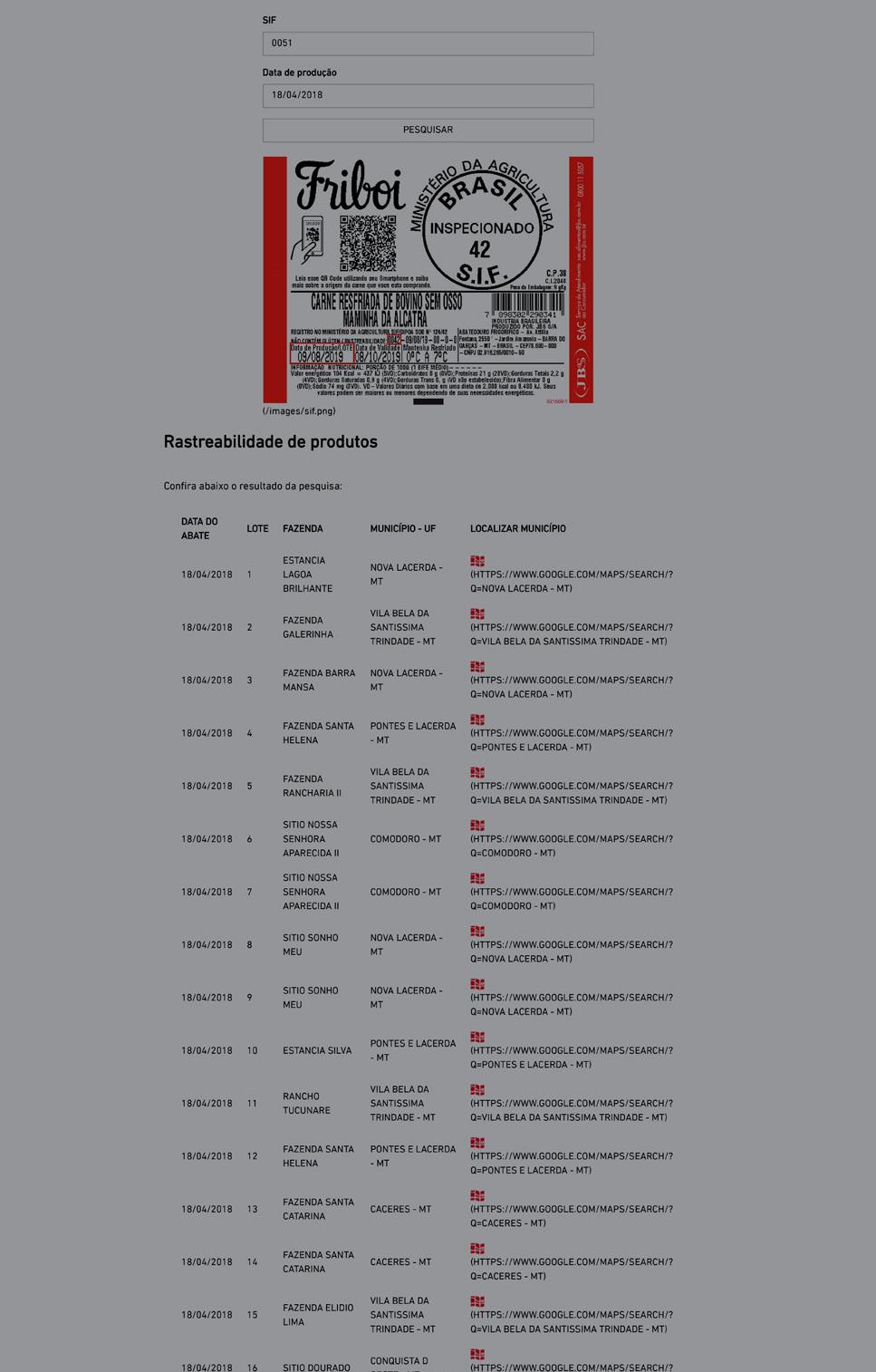
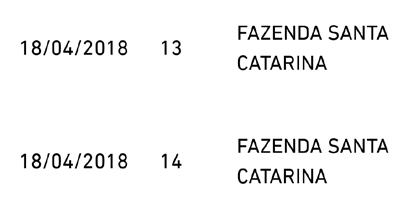

Potentially, up to 2,220 cattle were transferred. Between 24 April 2018 and 25 January 2019, or soon after, Jose Dalbem made multiple shipments of cattle for slaughter from Fazenda Santo Antônio to Minerva Mirassol d’Oeste. Potentially, up to 670 cattle were transferred.
ME aT PROCESSOR RESPONSE
• JBS: ‘Santo Antonio Farm is compliant with the Company’s Responsible Procurement Policy. In regard to Santa Catarina Farm, JBS reiterates … that its policy blocks properties embargoed by IBAMA for environmental irregularities at the time of purchase, not based on fines of almost two decades ago that have already been sorted out with the environmental body, a criterion established by Greenpeace itself.’311
• M a RFRIG: ‘Farms that are not included in our supplier list and have not had any business relationship with Marfrig: … Santa Catarina’.312 ‘On the slaughter date, Fazenda Santa Catarina was in compliance with all the criteria of the company’s public commitments. … Fazenda Santa Catarina was not subject to an embargo by IBAMA on the slaughter date. The last slaughter [of cattle from Fazenda Santa Catarina at SIF 1900] was on March 26, 2019. … The last slaughter [of cattle from Fazenda Santa Catarina at SIF 2015] was on June 19, 2019. … Fazenda Santo Antônio was not subject to an embargo by IBAMA on the slaughter date. The last slaughter [of cattle from Fazenda Santo Antônio at SIF 1900] was on March 19, 2019. … The last slaughter [of cattle from Fazenda Santo Antônio at SIF 2015] was on November 26, 2019.’313
• MINERVa : ‘[Fazenda Santo Antônio] is listed in Minerva’s database and is eligible for commercialization. The property has an initial analysis carried out in 2016 and has no overlapping with the embargo polygon of IBAMA and no social restriction linked to the CPF of the supplier. The [Santa Catarina] ranch cited as an indirect [supplier] is listed in Minerva’s database and was blocked for commercialization on July 26, 2020, when the area was included within SEMAMT’s embargo base. The perimeter of the property overlaps the polygon of the areas embargoed Semas MT, as JOSE DALBEM. … The last purchase occurred on July 25, 2020 and there has not been any commercialization with the property after the date of the embargo.’314
GREENPE aCE OBSERVaTIONS
• JBS failed to make clear the compliance status of its direct supply ranch Fazenda Santa Catarina, but the tone suggests that JBS may be unaware of the embargoes imposed by the Mato Grosso Environment Agency.
• M a RFRIG’S statement that it has not had any business relationship with Fazenda Santa Catarina is confusing given that it acknowledges slaughtering cattle from the ranch at both identified facilities.
• MINERVa , unlike the other two processors, has confirmed that it has checked the legal status of Fazenda Santa Catarina and has blocked it as a direct supplier as a result. However, it is clear that the company’s due diligence does not extend beyond the first point of contact. Given the evidence that Fazenda Santa Catarina has previously supplied Fazenda Santo Antônio, confirmed by Minerva as a current direct supply ranch, the company has not indicated that it intends to investigate whether the trade continues, or whether it will block trade from Jose Dalbem’s operations as a precautionary measure.
• JBS’S response confirms that Jose Dalbem remains a current tier-one supplier.
• M a RFRIG failed to confirm the current status of the operations of Jose Dalbem, a 2019 tier-one supplier to its facilities.
• MINERVa’S response confirms that Jose Dalbem remains a current tier-one supplier.
• NONE OF THE ME aT PROCESSORS gives any meaningful indication that it has proactively reviewed its entire supply base – including in the Pantanal – for deliberate or illegal use of fire.
• NONE OF THE ME aT PROCESSORS gives any indication that it proactively identified and monitored the legal status or environmental impact of these indirect supplies or thirdparty suppliers in the Pantanal.
Ca SE STUDY 6 ÁRIO BaRNaBE NETO
RIO VERMELHO
TR a DE TO SL aUGHTERHOUSES 2018–2019
JBS Pedra Preta (SIF 2019)
R a NCHER IRREGUL a RITIES/ EMB a RGOES/ FINES
+ Two embargoes + R$1.44 million (US$470,000) fines
C a SE STUDY Fa ZENDa Rio Vermelho SIC a R # MT-5107602-7A0476ACF27 0424CA3F41E12D9920277
C a R STaTUS Active Fa ZENDa a RE a 8,741 ha BURNED a RE a 2,870 ha FIRST FIRE 5 September 2020
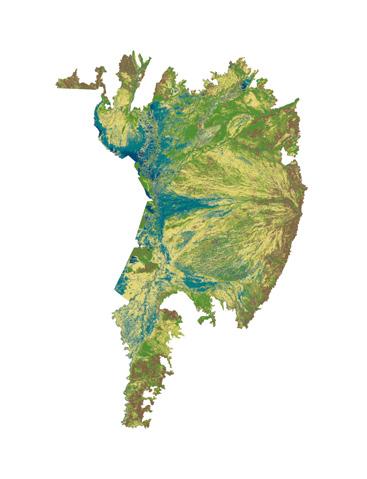

Ário Barnabe Neto and Maria Regina Scallet Barnabe own the 8,741 ha Fazenda Rio Vermelho in Rondonópolis, Mato Grosso. IBAMA lists two embargoes against the ranch for clearance of native vegetation in 2014 and 2018315 and fines for Ário Barnabe Neto totalling R$1.44 million (US$470,000) - see Figures 6.1 and 6.2).316 Between 1 July 2020 and 27 October 2020 at least 2,870 ha burned within the boundaries of Fazenda Rio Vermelho (which falls partially outside the limits of the Pantanal assessed for burn scar by LASA), with the first fire hotspots on the property detected on 5 September 2020.
In 2018 and 2019, cattle from Fazenda Rio Vermelho were supplied to two other ranches owned by Ário Barnabe Neto –Fazenda Aldeia de Itaúna and Fazenda Mata Alta, both in Pedra Preta, Mato Grosso.317 In 2018, these ranches supplied JBS Pedra Preta (SIF 2019).318 Ário Barnabe Neto was thus a tier-one supplier to JBS.
JBS PEDR a PRETa (SIF 2019): Between 9 March 2018 and 10 July 2018, or soon after, Ário Barnabe Neto made multiple shipments of a cattle from Fazenda Aldeia de Itaúna to JBS

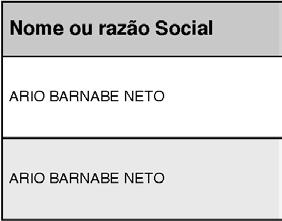
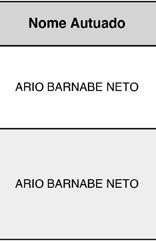
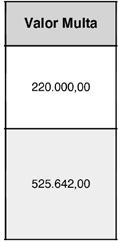
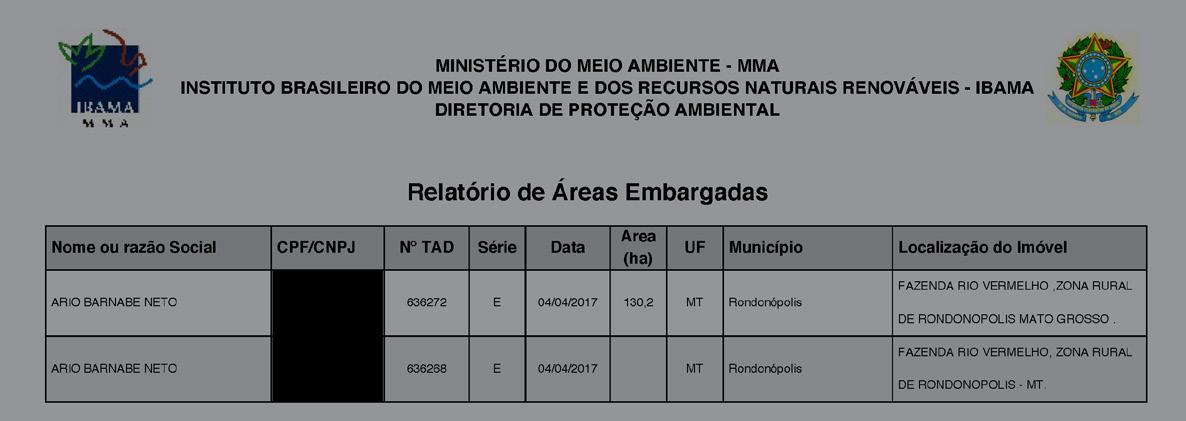
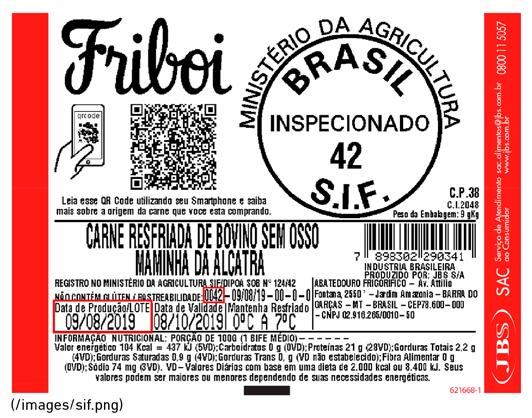

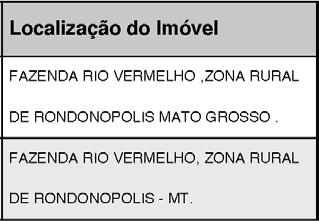

Pedra Petra. On 14 March 2018 and 11 July 2018 JBS Pedra Preta slaughtered cattle from a Fazenda Aldeia de Itaúna located in Pedra Preta, Mato Grosso (see Figure 6.3).319
Between 29 March 2018 and 14 August 2018, or soon after, Ário Barnabe Neto made multiple shipments of cattle from Fazenda Mata Alta to JBS Pedra Petra. The JBS ‘Garantia de Origem’ website does not list Fazenda Mata Alta as the origin of any of the cattle that were slaughtered on or soon after 29 March 2018 or 14 August 2018 at JBS Pedra Preta; however, it does list a Fazenda Aldeia de Itaúna, located in Pedra Preta, Mato Grosso, as the origin of cattle slaughtered on 4 April 2018 as well as 14 and 16 August 2018.320
ME aT PROCESSOR RESPONSE
• JBS: ‘Aldeia de Ituana Farm [sic] is compliant with the Company’s Responsible Procurement Policy, since the

IBAMA embargo is associated with another property. In regard to Rio Vermelho Farm, it is not part of our active supplier base.’321
GREENPE aCE OBSERVaTIONS
• JBS’S response confirms that Ário Barnabe Neto remains a current tier-one supplier. In this case, it appears JBS has used some ranch names associated with this owner interchangeably on its ‘Garantia de origem’ website.
• JBS gives no meaningful indication that it has proactively reviewed its entire supply base for deliberate or illegal use of fire.
• JBS gives no indication that it proactively identified and monitored the legal status or environmental impact of these indirect supplies or third-party suppliers in the Pantanal.
Ca SE STUDY 7 LUIZ CaRLOS ZILIaNI
SaNTa TEREZ a
TR a DE TO SL aUGHTERHOUSES
2018–2019
JBS Pontes e Lacerda (SIF 51) Marfrig Pontes e Lacerda (SIF 1900)
Marfrig Várzea Grande (SIF 2015) Minerva Mirassol d’Oeste (SIF 2911)
R a NCHER IRREGUL a RITIES/ EMB a RGOES/ FINES + Suspended CAR registrations
C a SE STUDY Fa ZENDa Santa Tereza SIC a R # MT-5106828-C488DC83E5 1B4436B221ACFBB0586505
C a R STaTUS Pending (federal) Suspended (Mato Grosso state) Fa ZENDa a RE a 996 ha
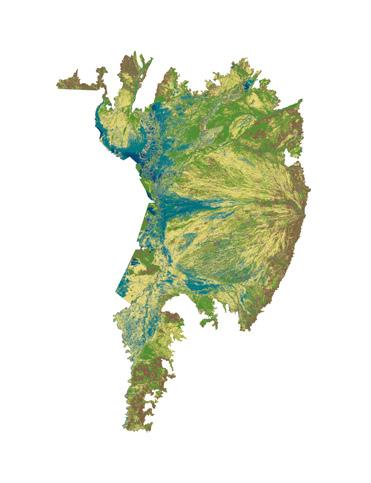

Luiz Carlos Ziliani is the owner of the 996 ha Fazenda Santa Tereza in Porto Esperidião, Mato Grosso. The federal CAR website lists the ranch’s property registration status as ‘cancelled’ (with the date of analysis given as 18 September 2020 and the date of the last revision given as 12 November 2019) – see Figures 7.1 and 7.2; 322 the registration status of its sister ranch Fazenda Santa Tereza II is also listed as ‘cancelled’ with the date of analysis given as 4 November 2020 and the date of the last revision given as 4 December
2018.323 The Mato Grosso state registry previously listed the registration of Fazenda Santa Tereza as suspended as of 18 September 2020 but now lists it as active as of 28 January 2021 (see Figures 7.3 and 7.4); it lists Fazenda Santa Tereza II’s registration as suspended as of 4 November 2020.324 Fazenda Santa Tereza lies within the Pantanal on official large-scale government maps of Brazil’s biomes, but it falls outside the area assessed for burn scar by LASA. As such, the analysis on which this report is based does not

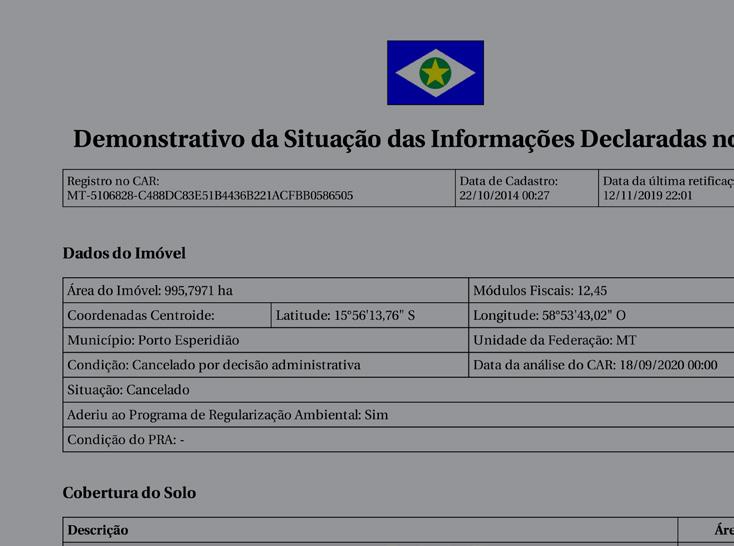
Figures 7.1 and 7.2: Federal CAR information for Santa



Above, translated ‘Generated on 07/02/2021 15:05’



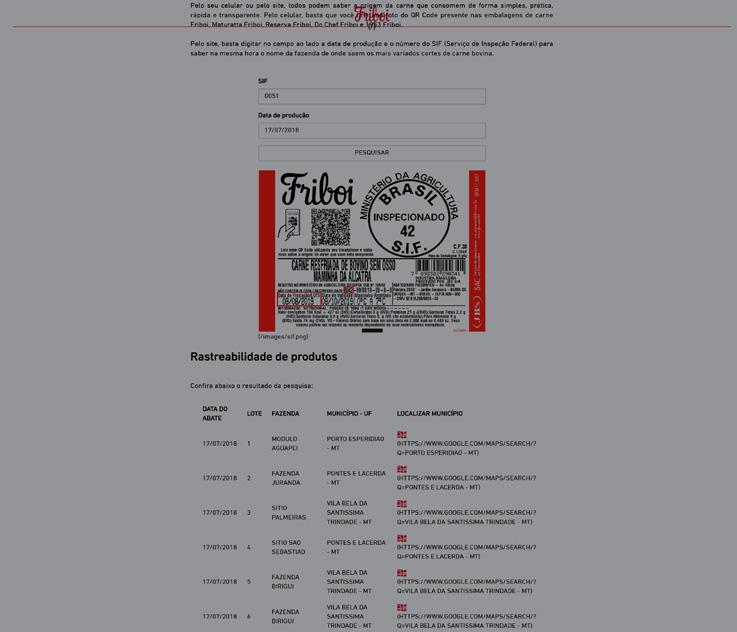




assess the area that may have burned within the ranch; a fire hotspot was detected in May 2020, which precedes the announcement of state or federal bans.
In 2018 and 2019 cattle from Fazenda Santa Tereza were supplied directly to the JBS Pontes e Lacerda (SIF 51), Marfrig Pontes e Lacerda (SIF 1900), Marfrig Várzea Grande (SIF 2015) and Minerva Mirassol d’Oeste (SIF 2911) facilities.325 Luiz Carlos Ziliani was thus a tier-one supplier to all three meat processors; trade from Fazenda Santa Tereza to JBS, Marfrig and Minerva was direct.
JBS PONTES E L aCERDa (SIF 51): Between 23 April 2018 and 12 July 2018, or soon after, Luiz Carlos Ziliani made multiple direct shipments of cattle from Fazenda Santa Tereza to JBS Pontes e Lacerda. Potentially, up to 500 cattle were transferred. On 26 April 2018 and 17 July 2018, JBS Pontes e Lacerda slaughtered cattle from a Fazenda Santa Tereza located in Porto Esperidião, Mato Grosso (see Figure 7.5).326
M a RFRIG PONTES E L aCERDa (SIF 1900): On or soon after 16 August 2019 Luiz Carlos Ziliani made three direct shipments of a total of 51 cattle from Fazenda Santa Tereza to Marfrig Pontes e Lacerda On 21 August 2019 Marfrig Pontes e Lacerda slaughtered cattle from Luiz Carlos Ziliani’s Fazenda Santa Tereza.327
M a RFRIG VÁRZE a GR a NDE (SIF 2015): On or soon after 6 June 2019 Luiz Carlos Ziliani made three direct shipments of a total of 101 cattle from Fazenda Santa Tereza to Marfrig Várzea Grande. On 10 March 2019 Marfrig Várzea Grande slaughtered cattle from Luiz Carlos Ziliani’s Fazenda Santa Tereza.328
MINERVa MIR a SSOL D’OESTE (SIF 2911): Between 26 January 2018 and 23 November 2018, or soon after, Luiz Carlos Ziliani made multiple direct shipments of cattle for slaughter from Fazenda Santa Tereza to Minerva Mirassol d’Oeste. Potentially, up to 550 cattle were transferred.
ME aT PROCESSOR RESPONSE
• JBS: ‘[Greenpeace] references irregularities in the CAR of the property. However, the owner has a State SICAR with ACTIVE status, which qualifies him for commercial transactions with JBS. In addition, the property is compliant with the Company’s Responsible Procurement Policy.’329
• M a RFRIG: ‘On the slaughter date, the state or federal CAR status of Fazenda Santa Tereza was “active”. The
last slaughter [at SIF 2015] was on July 2, 2019. … The last slaughter [at SIF 1900] was on July 2, 2019.’330
• MINERVa : ‘[Fazenda Santa Tereza] is listed in Minerva’s database and has been blocked for commercialization due to the suspension of its CAR in September/2020. We would like to point out that during the period in which commercialization took place with the Company, the CAR was active and the property was eligible, as per the certificate below.’331
GREENPE aCE OBSERVaTIONS
• JBS’S assertion that Fazenda Santa Tereza is compliant with its procurement policy is controversial. Given that the company’s reply is dated 14 January 2021, its claims that the Mato Grosso SICAR website listed the ranch’s registration as active at the time of its check are puzzling – documentation held by Greenpeace shows the ranch’s registration status as active as of 28 January 2021 based on submission of a map on 25 January 2021. Checks made by Greenpeace on 27 November 2020 found the status listed as suspended, as of 18 September 2020. Furthermore, checks by Greenpeace on 25 November 2020 and 5 February 2021 showed the ranch’s status on the federal CAR website listed as ‘pending’ and ‘cancelled’, respectively.
• JBS and M a RFRIG appear to take as sufficient indication of a ranch’s compliance with policy the listing of an active status on either the federal or the state CAR website, even where the listings differ.
• MINERVa , unlike the other two processors, has confirmed that it has checked the legal status of Fazenda Santa Tereza and has blocked direct supply from this ranch.
• JBS’S response confirms that Luiz Carlos Ziliani remains a current tier-one supplier. JBS does not confirm whether supply from his operations has ever been blocked.
• M a RFRIG failed to confirm the current status of the operations of Luiz Carlos Ziliani, a 2019 tier-one supplier to its facilities.
• NONE OF THE ME aT PROCESSORS gives any meaningful indication that it has proactively reviewed its entire supply base – including in the Pantanal – for deliberate or illegal use of fire.

Ca SE STUDY 8 DaNIEL MaRTINS FILHO
SaNTa CECÍLIa II
TR a DE TO SL aUGHTERHOUSES
2018–2019
JBS Campo Grande (SIF 4400) Marfrig Bataguassu (SIF 4238)
R a NCHER IRREGUL a RITIES/ EMB a RGOES/ FINES + R$2 million fine
C a SE STUDY Fa ZENDa Santa Cecília II
SIC a R # MS-5003207-AA00DDD1A06C 4911A431E369925ED110
C a R STaTUS Active Fa ZENDa a RE a 37,700 ha BURNED a RE a 9,100 ha FIRST FIRE 14 July 2020
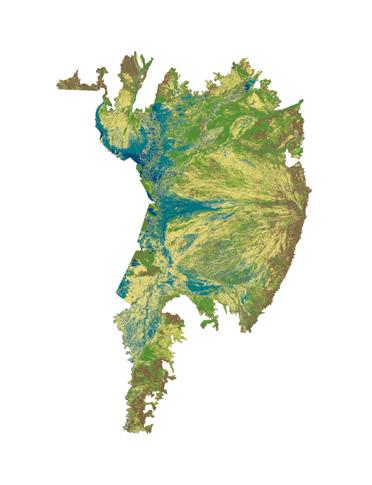
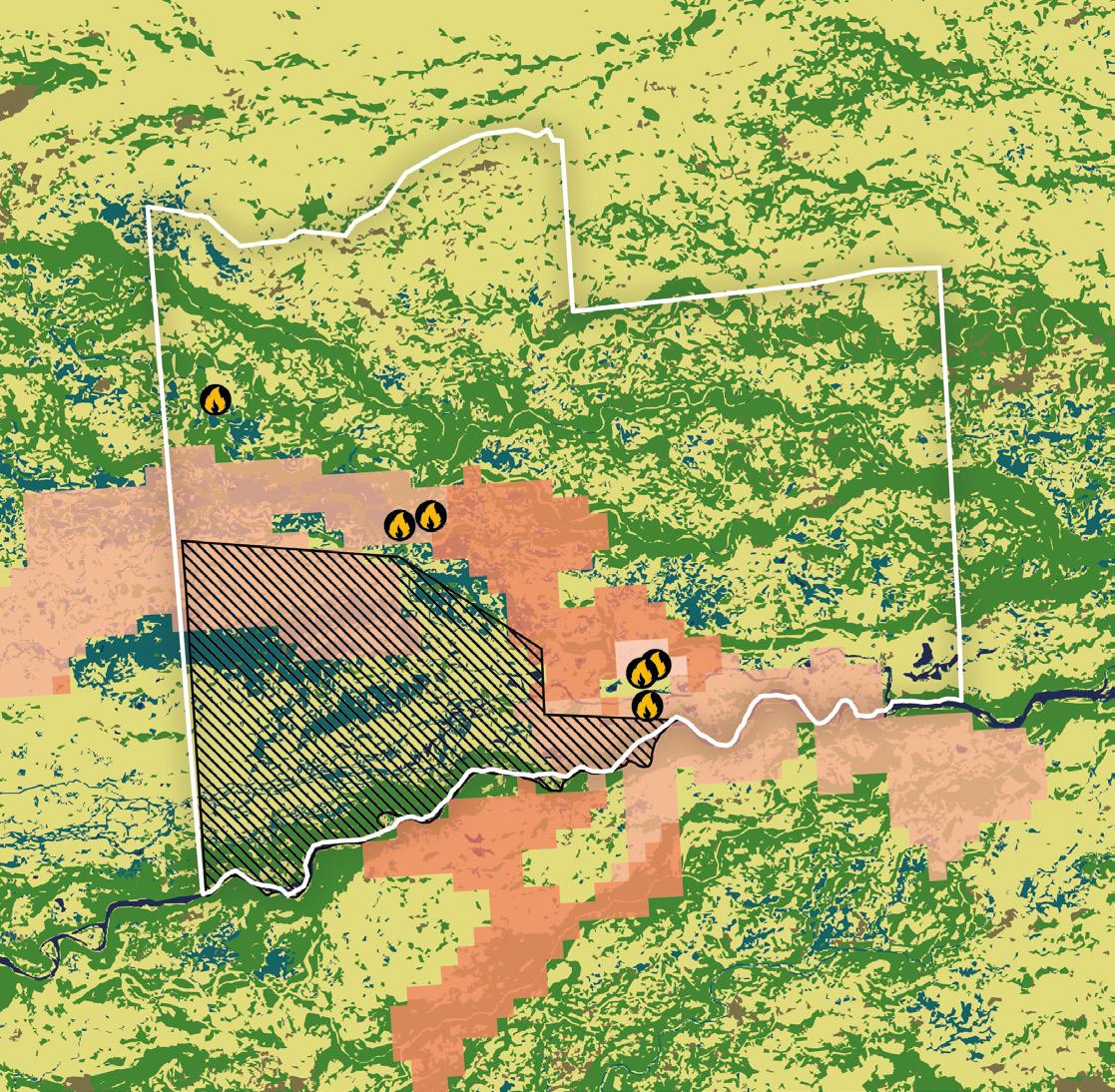
Daniel Martins Filho owns the 37,700 ha Fazenda Santa Cecília II in Corumbá, Mato Grosso do Sul. In 2013, he was fined R$2 million (US$930,000) by IBAMA 332 for illegally constructing levees along the river beside the ranch without a permit (see Figure 8.1).333
Between 1 July 2020 and 27 October 2020 some 9,100 ha burned within the limits of Fazenda Santa Cecília II, with the first fire hotspots detected on the property on 14 July 2020.
In 2018 and 2019 cattle from ranches owned by Daniel Martins Filho were supplied to the JBS Campo Grande
(SIF 4400) and Marfrig Bataguassu (SIF 4238) facilities.334
Daniel Martins Filho was thus a tier-one supplier to JBS and Marfrig, but trade from Fazenda Santa Cecília II to these facilities was indirect.
JBS C a MPO GR a NDE (SIF 4400): On or soon after 4 June
2018 Daniel Martins Filho made one shipment of 740 cattle from Fazenda Santa Cecília II to Fazenda São Bento in Rio Verde de Mato Grosso, Mato Grosso do Sul (also owned

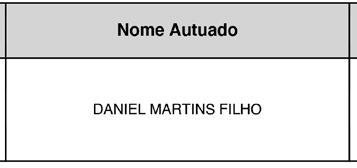
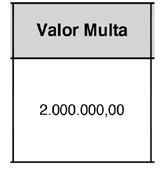
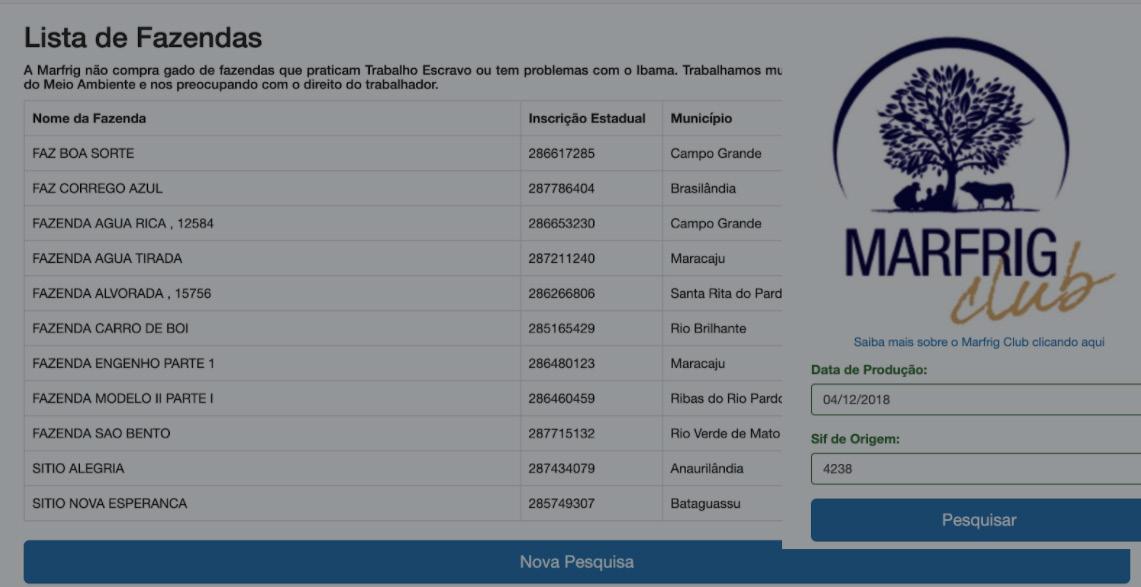
by him). Between 18 January 2019 and 12 February 2019, or soon after, Daniel Martins Filho made multiple shipments of cattle from Fazenda São Bento to JBS Campo Grande (SIF 4400). Potentially, up to 120 cattle were transferred. On 12 February 2019 and 15 February 2019, JBS Campo Grande (SIF 4400) slaughtered cattle from a Fazenda São Bento located in Rio Verde de Mato Grosso, Mato Grosso do Sul.335
M a RFRIG BaTaGUa SSU (SIF 4238): Between 4 June 2018 and 9 April 2019, or soon after, Daniel Martins Filho made two shipments of a total of 751 cattle from Fazenda Santa Cecília II to Fazenda São Bento (also owned by him). Between 30 November 2018 and 18 April 2019, or soon after, Daniel Martins Filho made multiple shipments of cattle from Fazenda São Bento to Marfrig Bataguassu. Potentially, up to 60 cattle were transferred. Marfrig Bataguassu slaughtered cattle from Daniel Martins Filho’s Fazenda São Bento on 4 December 2018 (see Figure 8.2) and on 23 April 2019.336
ME aT PROCESSOR RESPONSE
• JBS: ‘São Bento Farm is compliant with the JBS Responsible Procurement Policy. In the case of Santa Cecília II Farm, it is not on the Company’s active supplier base. [Greenpeace] informs that Daniel Martins Filho, owner of both farms, had been fined by IBAMA, however, there are not embargos of the environmental body associated with the
February 2021,

properties. JBS reiterates that its policy blocks farms that are embargoed by IBAMA for environmental irregularities at the time of purchase, not based on situations under discussion with the environmental body.’337
• M a RFRIG: ‘On the slaughter date, Fazenda São Bento was in compliance with all the company’s criteria for this biome. The last slaughter was on April 25, 2019. Fazenda Santa Cecília II is included in Marfrig’s supplier list, but there is no history of slaughtering.’338
GREENPE aCE OBSERVaTIONS
• JBS’S response confirms that Daniel Martins Filho remains a current tier-one supplier.
• M a RFRIG failed to confirm the current status of the operations of Daniel Martins Filho, a 2018–2019 tier-one supplier to its facilities.
• Neither JBS nor M a RFRIG gives any meaningful indication that it has proactively reviewed its entire supply base – including in the Pantanal – for deliberate or illegal use of fire.
• Neither JBS nor M a RFRIG gives any indication that it proactively identified and monitored the legal status or environmental impact of these indirect supplies or thirdparty suppliers in the Pantanal.
Ca SE STUDY 9
R aYMUNDO VICTOR Da COSTa R aMOS
SHaRP
SÃO CaRLOS E SaNTa MONICa
TR a DE TO SL aUGHTERHOUSES 2018–2019
JBS Araputanga (SIF 2979) Minerva Mirassol d’Oeste (SIF 2911)
R a NCHER IRREGUL a RITIES/ EMB a RGOES/ FINES
+ Suspended CAR registration + R$36,000 (US$12,000) fines
C a SE STUDY Fa ZENDa São Carlos e Santa Monica SIC a R # MT-5102504-6295DE76EB 4D439C94DB3662F0A8CB6E
C a R STaTUS Active (federal) Suspended (Mato Grosso state) Fa ZENDa a RE a 22,931 ha BURNED a RE a 16,012 ha FIRST FIRE 15 August 2020

EU APPROVED
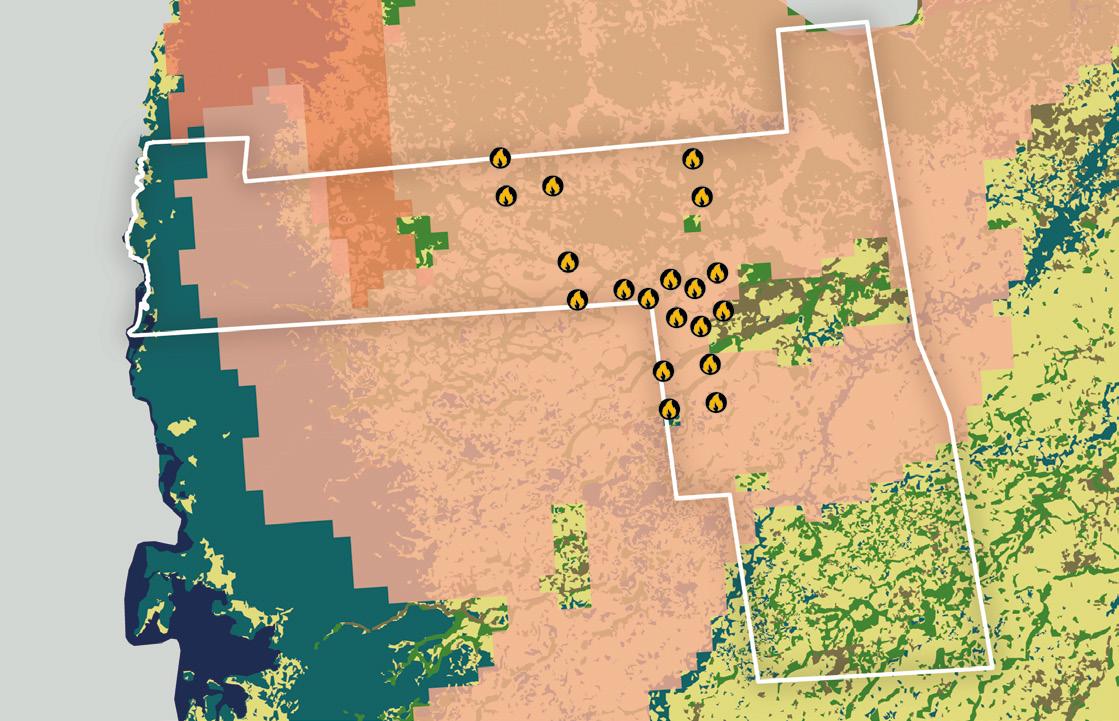
Raymundo Victor da Costa Ramos Sharp is the owner of the 22,931 ha Fazenda São Carlos e Santa Monica339 in Cáceres, Mato Grosso. The Mato Grosso state environment agency lists the ranch’s property registration as suspended as of 23 September 2019,340 though the federal CAR registry lists it as active as of the same date (see Figures 9.1 and 9.2).341 In 2003, Raymundo Victor da Costa Ramos Sharp was fined a total of R$36,000 (US$12,000) by IBAMA.342 Between 1 July 2020 and 27 October 2020 some 16,012 ha burned within the boundaries of Fazenda São Carlos e Santa Monica, with the first fire hotspots on the property detected on 15 August 2020.
In 2018 and 2019 Raymundo Victor da Costa Ramos Sharp supplied cattle from this ranch to another rancher, who in turn supplied the JBS Araputanga (SIF 2979) and Minerva Mirassol d’Oeste (SIF 2911) facilities.343 Raymundo Victor da Costa Ramos Sharp was thus a third-party supplier to JBS and Minerva, and trade from Fazenda São Carlos e Santa Monica to these facilities was indirect.
JBS a R a PUTa NG a (SIF 2979): On or soon after 23 January 2019
Raymundo Victor da Costa Ramos Sharp made four shipments of a total of 80 cattle from Fazenda São Carlos to Fazenda Estrela da Fronteira in Cáceres, Mato Grosso (owned by Sebastião Sabino Filho and Maria Antonieta de Carvalho Sabino – a ranch certified for beef exports to the EU344). Between 23 January 2019 and 26 November 2019, or soon after, Sebastião Sabino Filho made multiple shipments of cattle from Fazenda Estrela da Fronteira to JBS Araputanga. Potentially, up to 200 cattle were transferred. On 25 January 2019 and 2 December 2019, JBS Araputanga slaughtered cattle from a Fazenda Estrela da Fronteira, located in Cáceres, Mato Grosso.345
MINERVa MIR a SSOL D’OESTE (SIF 2911): Between 23 January 2019 and 19 June 2019, or soon after, Raymundo Victor da Costa Ramos Sharp made multiple shipments of cattle from Fazenda São Carlos to Fazenda Estrela da Fronteira (owned by Sebastião Sabino Filho and Maria Antonieta


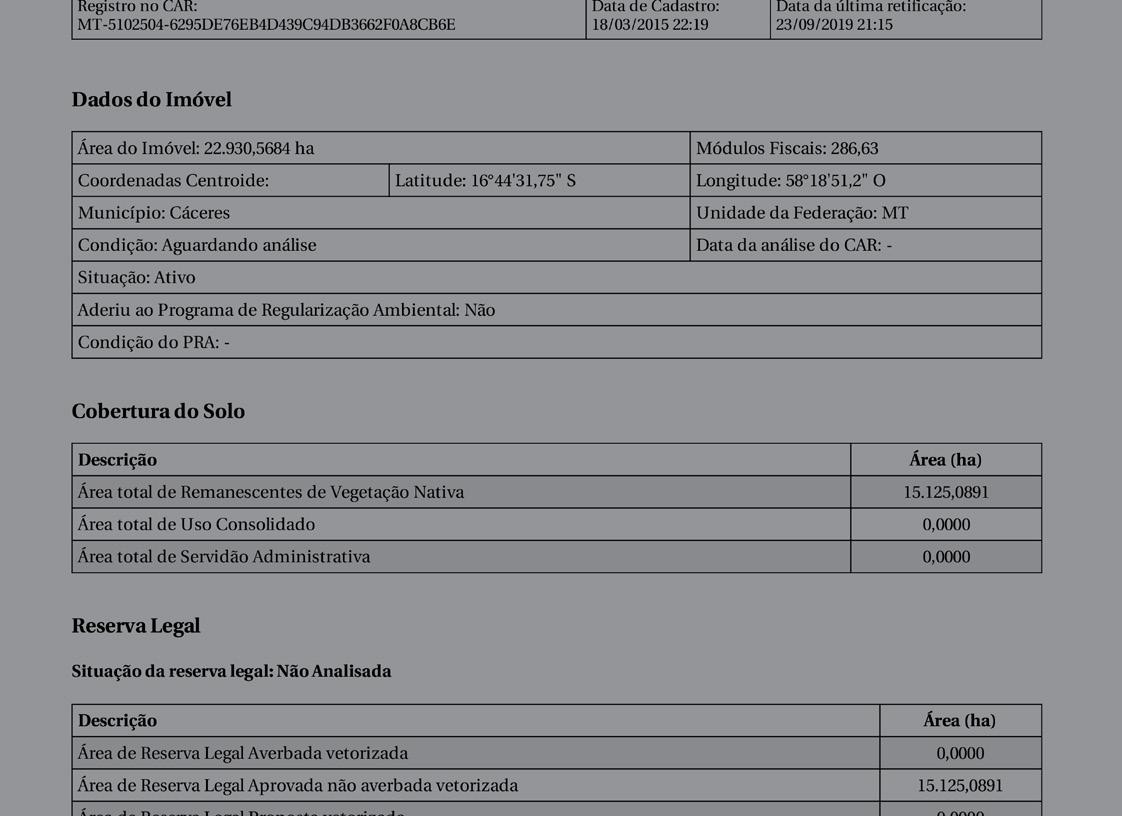


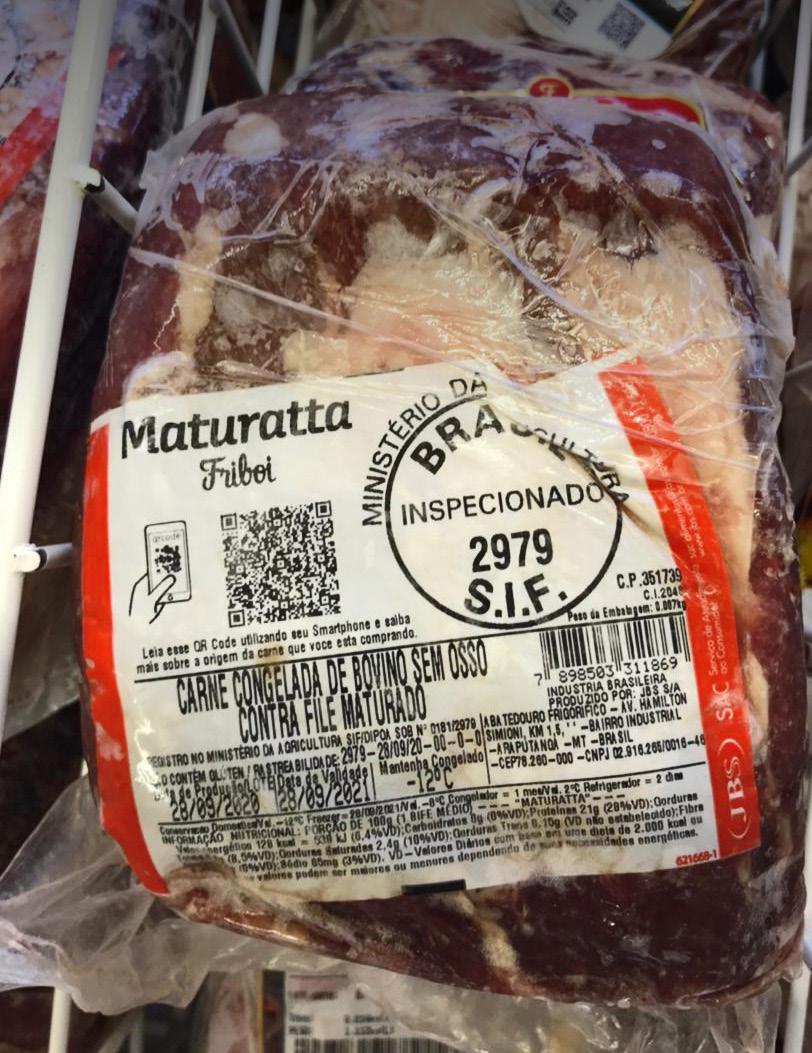
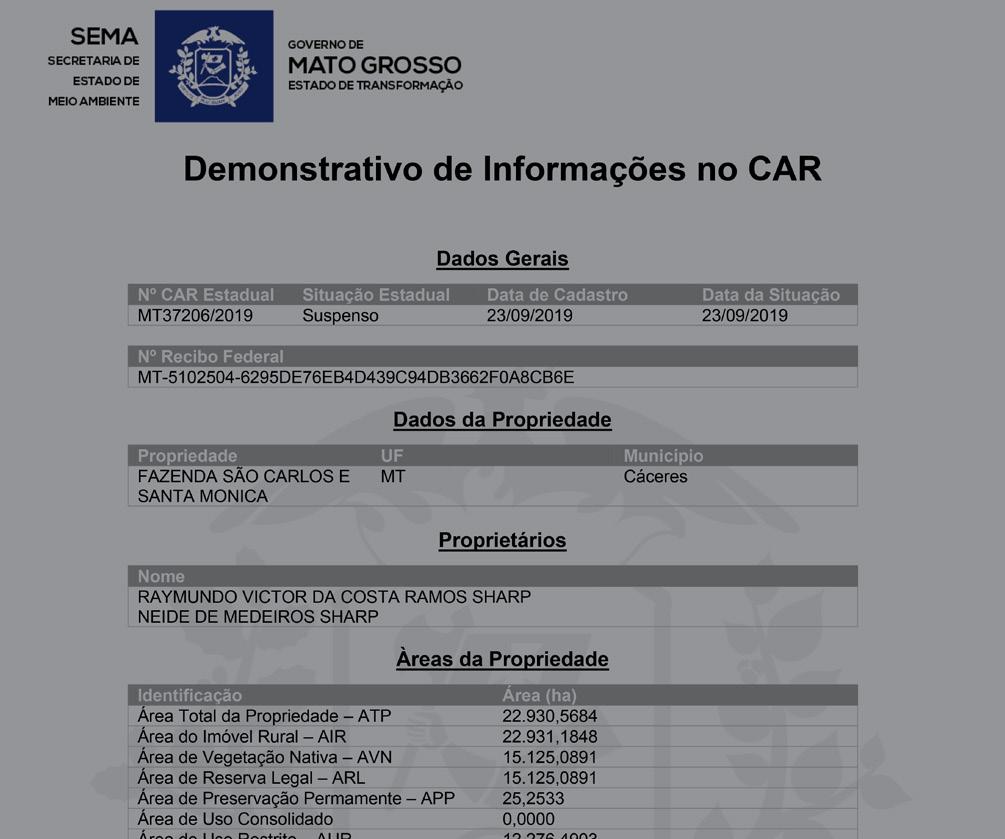

de Carvalho Sabino). Potentially, up to 225 cattle were transferred. Between 8 February 2019 and 16 August 2019, or soon after, Sebastião Sabino Filho made multiple shipments of cattle for slaughter from Fazenda Estrela da Fronteira to Minerva Mirassol d’Oeste. Potentially, up to 750 cattle were transferred.
ME aT PROCESSOR RESPONSE
• JBS: ‘Estrela da Fronteira Farm is compliant with the Company’s Responsible Procurement Policy. In regard to the properties São Carlos and Santa Monica, they are not part of our active supplier base. Even so, a search in a public base reveals that both of them have a CAR with ACTIVE status on the Federal SICAR.’346
• MINERVa : ‘[Fazenda Estrela da Fronteira] is listed in Minerva’s database and is eligible for commercialization.’347
GREENPE aCE OBSERVaTIONS
• JBS appears to take as sufficient indication of a ranch’s compliance with policy the listing of an active status on either the federal or the state CAR website, even where the listings differ.
• Neither JBS nor MINERVa gives any meaningful indication that it has proactively reviewed its entire supply base –including in the Pantanal – for deliberate or illegal use of fire.
• Neither JBS nor MINERVa gives any indication that it proactively identified and monitored the legal status or environmental impact of these indirect supplies or thirdparty suppliers in the Pantanal.
Ca SE STUDY 10 FR aNCISCa EVaNGELISTa TEODORO Da SILVa
SÃO BENTO
TR a DE TO SL aUGHTERHOUSES
2018–2019
JBS Pontes e Lacerda (SIF 51)
Marfrig Pontes e Lacerda (SIF 1900)
Minerva Mirassol d’Oeste (SIF 2911)
Minerva Várzea Grande (SIF 2015)
C a SE STUDY Fa ZENDa
São Bento
SIC a R #
MT-5102504-0117E45CD7
744A3A9F2C8FBA6CED21B
C a R STaTUS Active
Fa ZENDa a RE a 12,581 ha BURNED a RE a 5,230 ha FIRST FIRE 25 August 2020
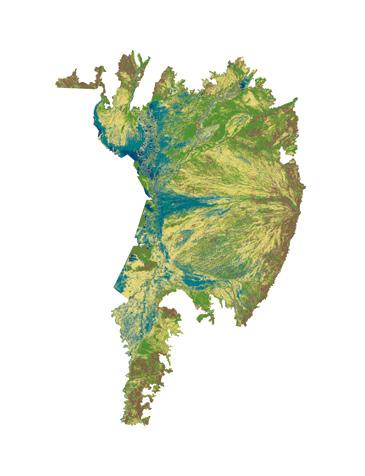
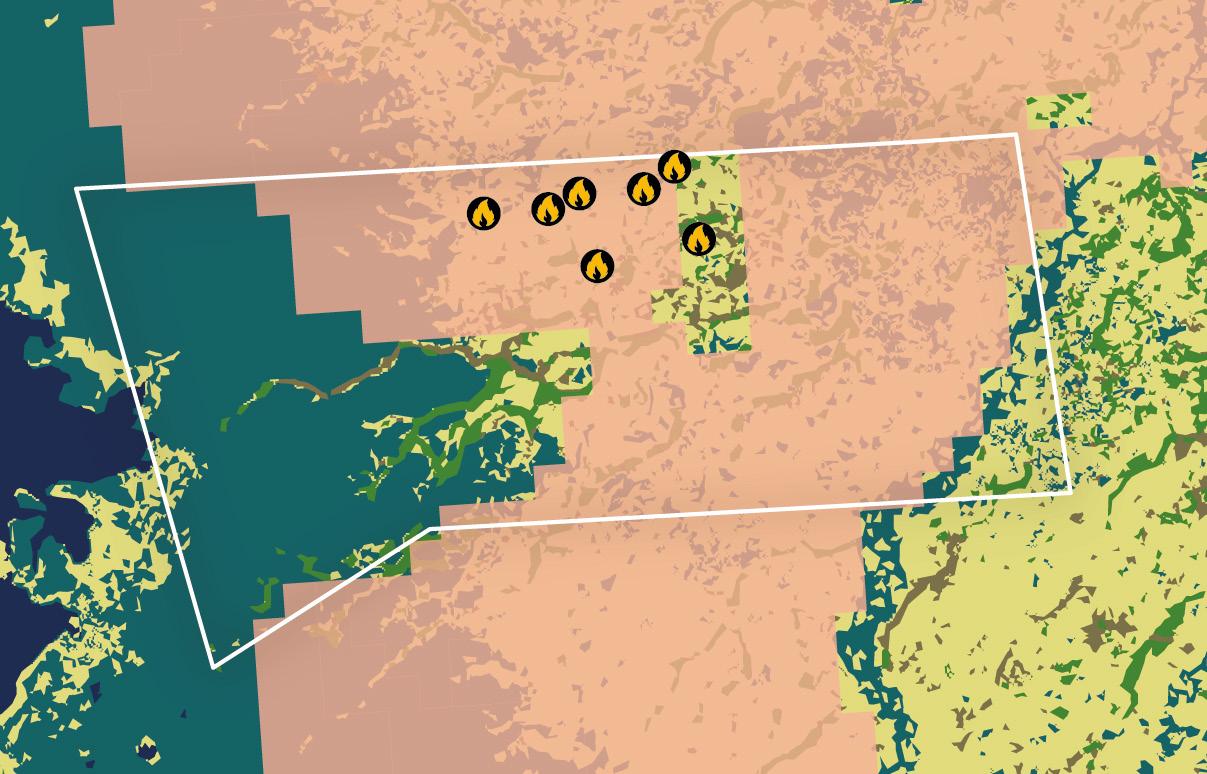
Francisca Evangelista Teodoro da Silva owns the 12,581 ha Fazenda São Bento in Cáceres, Mato Grosso. Between 1 July 2020 and 27 October 2020 some 5,230 ha burned within the ranch’s boundaries, with the first fire hotspot on the property detected on 25 August 2020.
In 2018 and 2019 cattle from ranches owned by Francisca Evangelista Teodoro da Silva were supplied to the JBS Pontes e Lacerda (SIF 51), Marfrig Pontes e Lacerda (SIF 1900), Minerva Mirassol d’Oeste (SIF 2911) and Minerva Várzea Grande (SIF 2015) facilities.348 Francisca Evangelista Teodoro da Silva was thus a tierone supplier to JBS, Marfrig and Minerva; trade from Fazenda São Bento was indirect to Marfrig Pontes e Lacerda (SIF 1900) and both direct and indirect to Minerva Várzea Grande (SIF 2015).
M a RFRIG PONTES E L aCERDa (SIF 1900): Between 6 February 2019 and 18 February 2019, or soon after, Francisca Evangelista Teodoro da Silva made multiple shipments of cattle from Fazenda São Bento to Fazenda Vargas in Pontes
e Lacerda, Mato Grosso (part of the estate of Henrique Coelho da Paula, with Francisca Evangelista Teodoro da Silva acting as estate executor 349). Potentially, up to 330 cattle were transferred. On or soon after 8 April 2019 Francisca Evangelista Teodoro da Silva made two shipments of a total of 40 cattle from Fazenda Vargas to Marfrig Pontes e Lacerda. Marfrig Pontes e Lacerda slaughtered cattle from Francisca Evangelista Teodoro da Silva’s Fazenda Vargas on 10 April 2019 (see Figure 10.1).350
MINERVa VÁRZE a GR a NDE (SIF 2015): On or soon after 13 February 2019 Francisca Evangelista Teodoro da Silva made one direct shipment of 20 cattle for slaughter from Fazenda São Bento to Minerva Várzea Grande. Between 6 February 2019 and 18 February 2019, or soon after, Francisca Evangelista Teodoro da Silva made multiple shipments of cattle from Fazenda São Bento to Fazenda Vargas (see bullet above). Potentially, up to 330 cattle were transferred. Between 8


February 2019 and 7 March 2019, or soon after, Francisca Evangelista Teodoro da Silva made multiple shipments of cattle for slaughter from Fazenda Vargas to Minerva Várzea Grande. Potentially, up to 80 cattle were transferred.
ME aT PROCESSOR RESPONSE
• M a RFRIG: ‘Fazenda São Bento is not included in Marfrig’s supplier list. In the period reported, Fazenda Vargas was in compliance with all the criteria for analyzing our public commitments. The last slaughter from Fazenda Vargas in the Pontes e Lacerda plant was on December 29, 2020.’351
• MINERVa : ‘[Fazenda Vargas] is listed in the database and is eligible for commercialization. … [Fazenda São Bento] is not registered in Minerva’s database.’352
GREENPE aCE OBSERVaTIONS
• JBS failed to confirm the current or historic status of the direct trade relationship between Francisca Evangelista
Teodoro da Silva and JBS Pontes e Lacerda (SIF 51) –Greenpeace has identified direct trade to this facility from Fazenda São José do Amparo (also apparently controlled by Francisca Evangelista Teodoro da Silva) in April 2019.
• M a RFRIG failed to confirm the current status of the operations of Francisca Evangelista Teodoro da Silva, a 2019–2020 tier-one supplier to its facilities.
• MINERVa’S response confirms that Francisca Evangelista Teodoro da Silva remains a current tier-one supplier.
• NONE OF THE ME aT PROCESSORS gives any meaningful indication that it has proactively reviewed its entire supply base – including in the Pantanal – for deliberate or illegal use of fire.
• NONE OF THE ME aT PROCESSORS gives any indication that it proactively identified and monitored the legal status or environmental impact of these indirect supplies or thirdparty suppliers in the Pantanal.
Ca SE STUDY 11 EDUaRDO MaRIaNI BITTENCOURT
VÁRZE a FUNDa
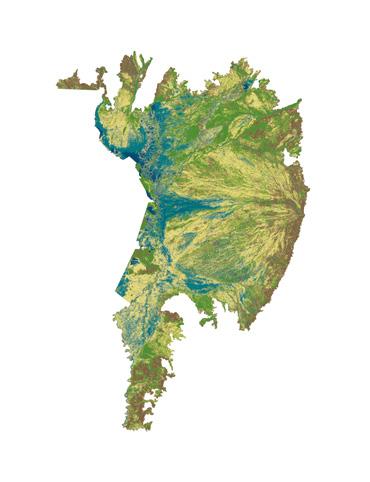

TR a DE TO SL aUGHTERHOUSES 2018–2019
JBS Araputanga (SIF 2979)
JBS Diamantino (SIF 3000)
Marfrig Pontes e Lacerda (SIF 1900)
Marfrig Várzea Grande (SIF 2015)
Minerva Mirassol d’Oeste (SIF 2911)
C a SE STUDY Fa ZENDa Várzea Funda
SIC a R # MT-5102504-9D66BF7AE21 04440A7DFE4C9B517FF19
C a R STaTUS
Active Fa ZENDa a RE a 8,750 ha BURNED a RE a 4,431 ha FIRST FIRE 7 September 2020
Sharing a border in Cáceres, Mato Grosso, with Fazenda Atoledal is the 8,750 ha Fazenda Várzea Funda, owned by Pin Agropecuária LTDA, whose shareholders include Eduardo Mariani Bittencourt.353 Between 1 July 2020 and 27 October 2020 at least 4,431 ha burned within the boundaries of Fazenda Várzea Funda (which falls partially outside the limits of the Pantanal assessed for burn scar by LASA), with the first fire hotspots on the property detected on 7 September 2020.
In 2018 and 2019 cattle from this ranch were supplied to the JBS Araputanga (SIF 2979), JBS Diamantino (SIF 3000), Marfrig Pontes e Lacerda (SIF 1900), Marfrig Várzea Grande (SIF 2015) and Minerva Mirassol D’Oeste (SIF 2911) facilities.354 Eduardo Mariani Bittencourt was thus a tier-one supplier to all three meat processors, and trade from Fazenda Várzea Funda was direct to all named facilities.
JBS aRaPUTaNGa (SIF 2979): Between 25 January 2018 and 9 February 2018, or soon after, Eduardo Mariani Bittencourt made multiple direct shipments of cattle from Fazenda Várzea Funda to JBS Araputanga. Potentially, up to 230 cattle were transferred. On 14 February 2018 JBS Araputanga slaughtered cattle from a Fazenda Várzea Funda located in Cáceres, Mato Grosso.355
JBS DI a M a NTINO (SIF 3000): Between 10 April 2018 and 26 April 2018, or soon after, Eduardo Mariani Bittencourt made multiple direct shipments of cattle from Fazenda Várzea Funda to JBS Diamantino. Potentially, up to 100 cattle were transferred. On 30 April 2018 JBS Diamantino slaughtered cattle from a Fazenda Várzea Funda located in Cáceres, Mato Grosso (see Figure 11.1).356
MaRFRIG PONTES E LaCERDa (SIF 1900): Between 28 January 2019 and 25 February 2019, or soon after, Eduardo Mariani Bittencourt made multiple direct shipments of cattle from Fazenda Várzea Funda to Marfrig Pontes e Lacerda. Potentially, up to 130 cattle were transferred. On 27 February 2019 Marfrig Pontes e Lacerda slaughtered cattle from Eduardo Mariani Bittencourt’s Fazenda Várzea Funda.357
M a RFRIG VÁRZE a GR a NDE (SIF 2015): Between 1 April 2019 and 26 April 2019, or soon after, Eduardo Mariani Bittencourt made multiple direct shipments of cattle from Fazenda Várzea Funda to Marfrig Várzea Grande. Potentially, up to 100 cattle were transferred. On 11 April 2019 and 29 April 2019 Marfrig Pontes e Lacerda slaughtered cattle from Eduardo Mariani Bittencourt’s Fazenda Várzea Funda.358
MINERVa MIR a SSOL D’OESTE (SIF 2911): Between 11 July 2018 and 6 August 2018, or soon after, Eduardo Mariani Bittencourt made multiple direct shipments of cattle for slaughter from Fazenda Várzea Funda to Minerva Mirassol D’Oeste. Potentially, up to 300 cattle were transferred.
ME aT PROCESSOR RESPONSE
• JBS: ‘[Greenpeace] did not inform what the suspected irregularity of this producer and/or his property was. At any rate, JBS informs that Várzea Funda Farm is not on the Company’s active supplier base.’359
• MaRFRIG: ‘On the slaughter date, Fazenda Várzea Funda was in compliance with all the criteria of the company’s public commitments. The last slaughter [at SIF 1900] was on February 27, 2019. … The last slaughter [at SIF 2015] was on November 13, 2019.’360
• MINERVa : ‘[Fazenda Vargea (sic) Funda] is listed in Minerva’s database and is eligible for commercialization.’361
GREENPE aCE OBSERVaTIONS
• JBS failed to confirm the historic direct trade relationship of Eduardo Mariani Bittencourt with JBS Araputanga (SIF 2979) or JBS Diamantino (SIF 3000).
• M a RFRIG failed to confirm the current status of the operations of Eduardo Mariani Bittencourt, a 2019 tier-one supplier to its facilities.
• MINERVa’S response confirms that Eduardo Mariani Bittencourt remains a current tier-one supplier.
• NONE OF THE ME aT PROCESSORS gives any meaningful indication that it has proactively reviewed its entire supply base – including in the Pantanal – for deliberate or illegal use of fire.
• NONE OF THE ME aT PROCESSORS gives any indication that it proactively identified and monitored the legal status or environmental impact of these indirect supplies or third-party suppliers in the Pantanal.


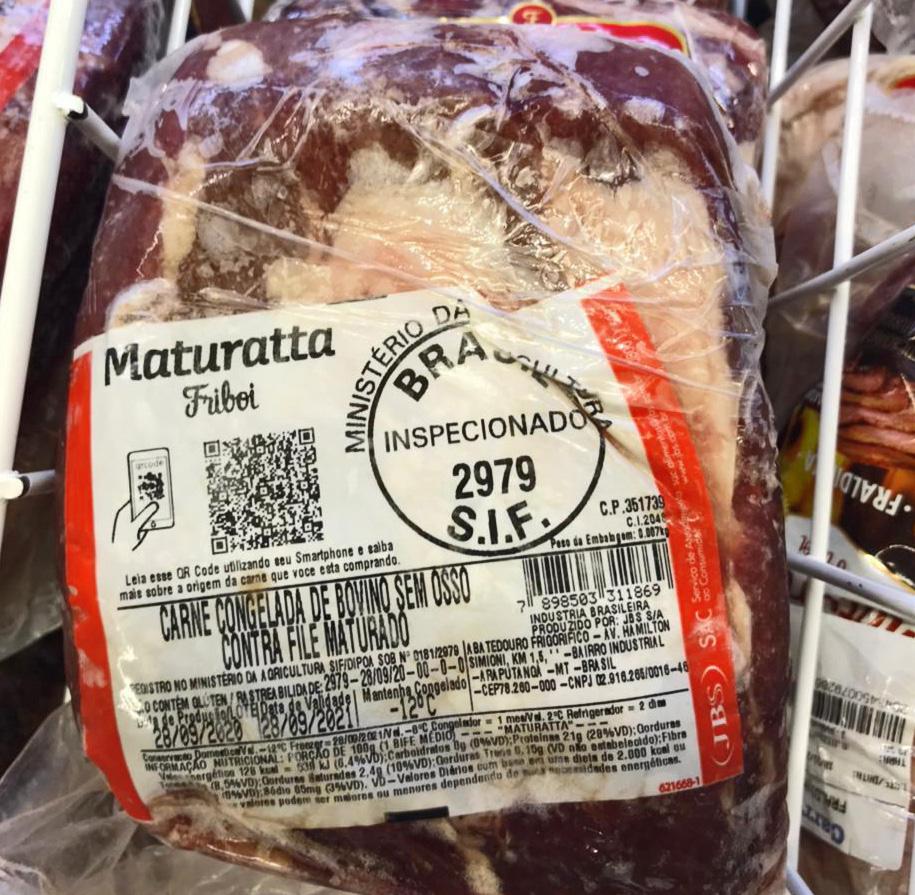
TR a DE TO SL aUGHTERHOUSES
2018–2019
JBS Anastácio (SIF 615)
JBS Campo Grande (SIF 1662)
JBS Campo Grande (SIF 4400)
C a SE STUDY Fa ZENDa Olhos d’Água
OLHOS D ’ÁGUa
SIC a R # MS-5001102-83F96B944DA946709
A71D4213D6B0381
C a R STaTUS Active Fa ZENDa a RE a 10,328 ha BURNED a RE a 1,770 ha FIRST FIRE 29 August 2020

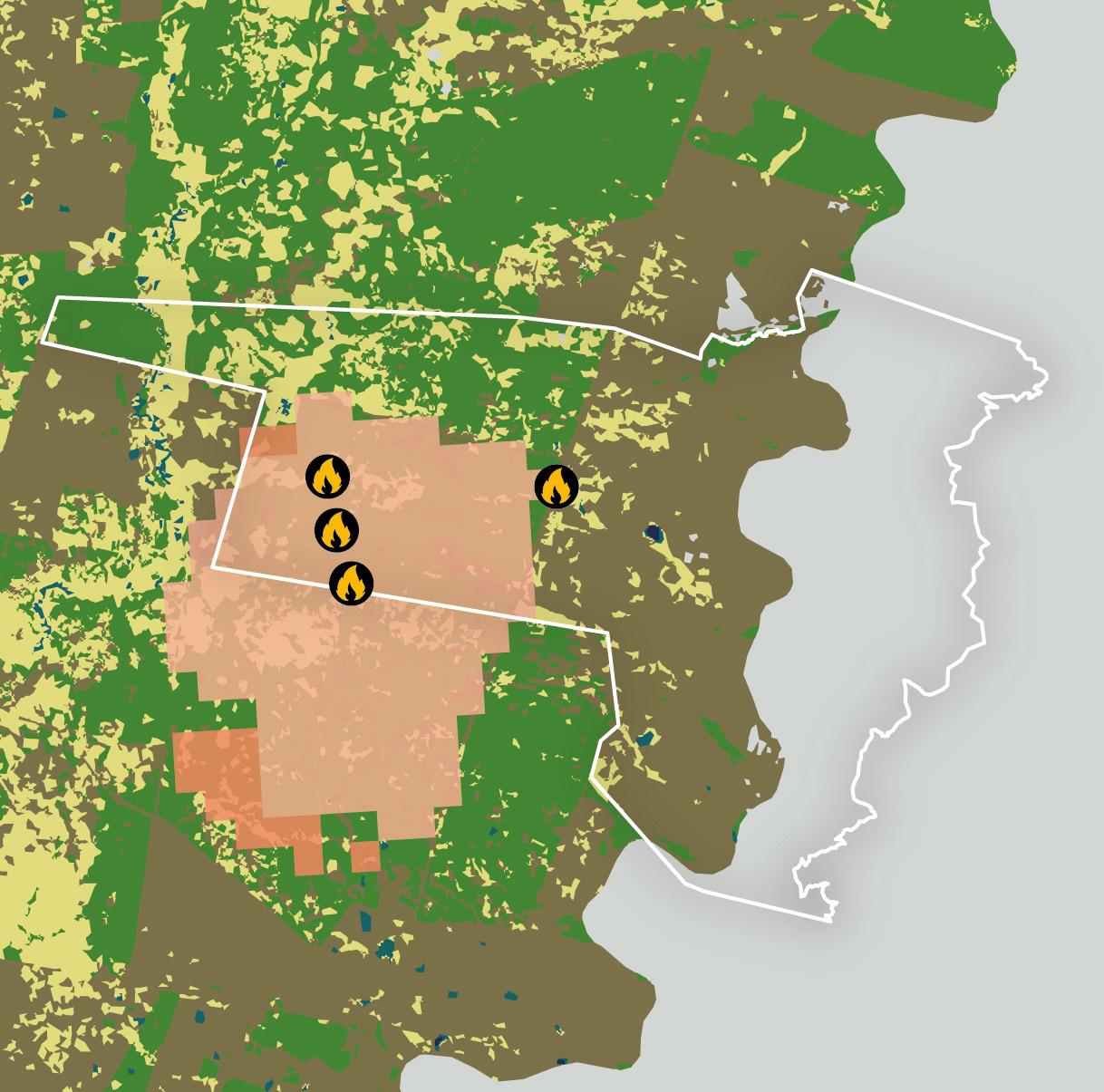
Eliana Maria Lemos Monteiro Conceição is the primary owner of the 10,328 ha Fazenda Olhos d’Água in Aquidauana, Mato Grosso do Sul, which is certified for beef exports to the EU.362 Between 1 July 2020 and 27 October 2020 at least 1,770 ha burned within the boundaries of this ranch (which falls partially outside the limits of the Pantanal assessed for burn scar by LASA), with fire hotspots detected on the property from 29 August 2020.
Cattle from Fazenda Olhos d’Água were supplied directly to JBS Anastácio (SIF 615) in 2018 and to two JBS Campo Grande facilities (SIF 1662 and SIF 4400) in 2018 and 2019.363 Eliana Maria Lemos Monteiro Conceição was thus a tier-one supplier to JBS, and trade from Fazenda Olhos d’Água was direct.
JBS aNaSTÁCIO (SIF 615): On or soon after 26 March 2018 Eliana Maria Lemos Monteiro Conceição made multiple direct shipments of a total of 88 cattle from Fazenda Olhos d’Água to JBS Anastácio. On 27 March 2018 JBS Anastácio slaughtered cattle from a Fazenda Olhos d’Água located in Aquidauana, Mato Grosso.364
JBS C a MPO GR a NDE (SIF 1662): Between 27 February 2018 and 7 June 2019, or soon after, Eliana Maria Lemos Monteiro Conceição made multiple direct shipments of cattle from Fazenda Olhos d’Água to JBS Campo Grande (SIF 1662). Potentially, up to 720 cattle were transferred. On 1 March 2018 and 11 June 2019, JBS Campo Grande (SIF 1662) slaughtered cattle from a Fazenda Olhos d’Água located in Aquidauana, Mato Grosso (see Figure 12.1).365
JBS C a MPO GR a NDE (SIF 4400): Between 26 February 2018 and 26 July 2019, or soon after, Eliana Maria Lemos Monteiro Conceição made multiple direct shipments of cattle from Fazenda Olhos d’Água to JBS Campo Grande (SIF 4400). Potentially, up to 620 cattle were transferred. On 28 February 2018 and 30 July 2019 JBS Campo Grande (SIF 4400) slaughtered cattle from a Fazenda Olhos d’Água located in Aquidauana, Mato Grosso.366
ME aT PROCESSOR RESPONSE
• JBS: ‘[Greenpeace] did not inform the suspected irregularity of this producer and/or of her property, which is registered in compliance with the Company’s Responsible Procurement Policy.’367
GREENPE aCE OBSERVaTIONS
• JBS’S response confirms that Eliana Maria Lemos Monteiro Conceição remains a current tier-one supplier.
• JBS gives no meaningful indication that it has proactively reviewed its entire supply base for deliberate or illegal use of fire.


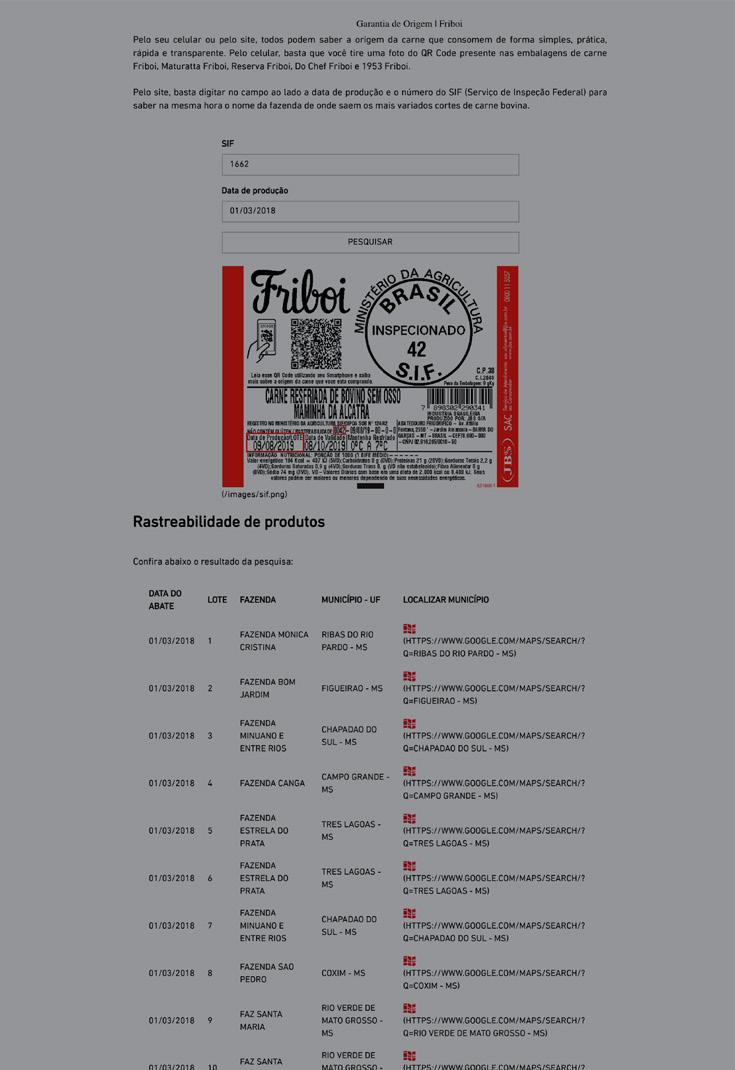

Ca SE STUDY 13 CELSO MIUR a
MESTIÇa
EU APPROVED
TR a DE TO SL aUGHTERHOUSES
2018–2019
JBS Araputanga (SIF 2979)
Marfrig Várzea Grande (SIF 2015)
Minerva Mirassol d’Oeste (SIF 2911)
Minerva Várzea Grande (SIF 2015)
C a SE STUDY Fa ZENDa Mestiça
SIC a R # MT-5102504-392561AEA3 5346C9AE7804A415C8C5A6
C a R STaTUS Active Fa ZENDa a RE a 7,891 ha BURNED a RE a 1,338 ha FIRST FIRE 14 September 2020
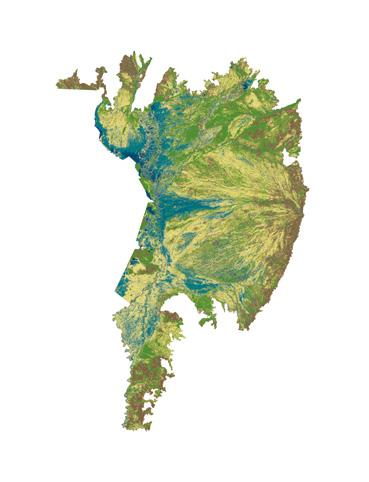
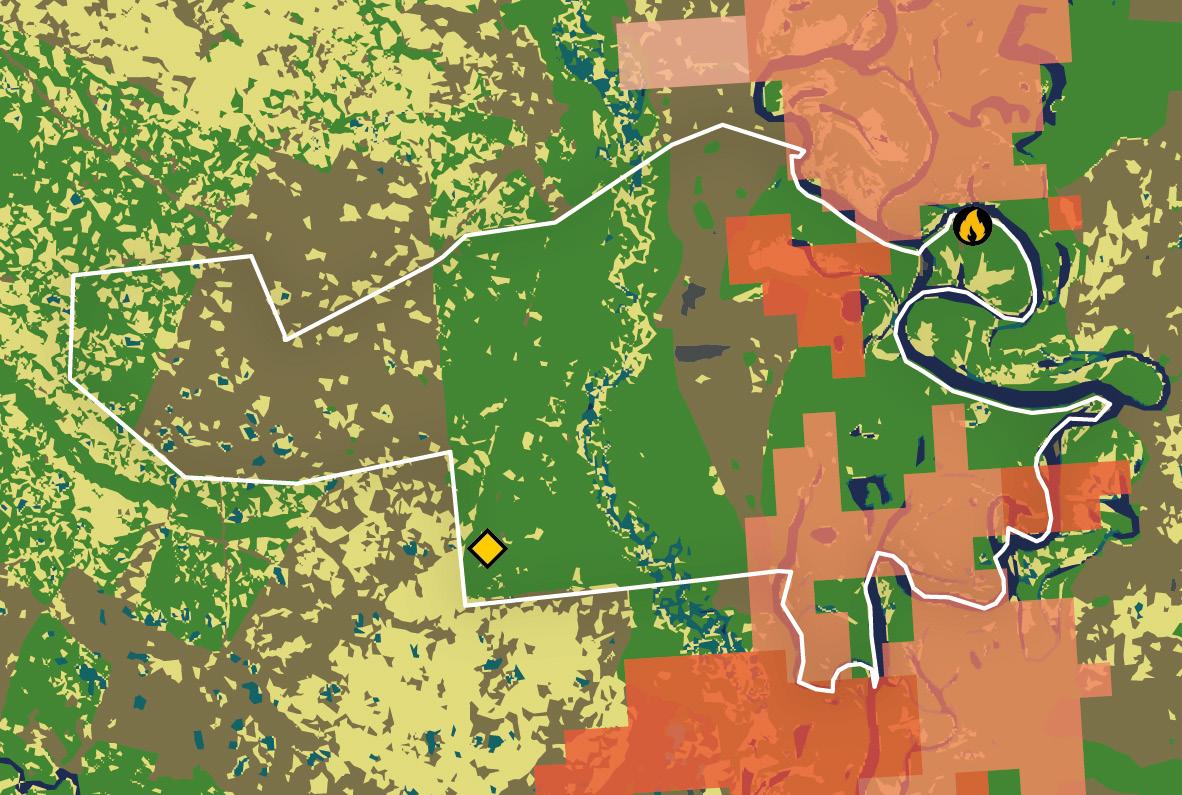
Celso Miura is the owner of the 7,891 ha Fazenda Mestiça in Cáceres, Mato Grosso. Between 1 July 2020 and 27 October 2020 some 1,338 ha burned within the boundaries of this ranch, with the first fire hotspots on the property detected on 14 September 2020.
In 2018, cattle from Fazenda Mestiça were supplied directly to JBS Araputanga (SIF 2979); there is also evidence of indirect trade from this ranch to Marfrig Várzea Grande (SIF 2015), Minerva Mirassol d’Oeste (SIF 2911) and Minerva Várzea Grande (SIF 2015) in 2018 and 2019.368 Celso Miura was thus a tier-one supplier to JBS and a third-party supplier to all three meat processors, with trade both direct and indirect from Fazenda Mestiça to JBS and indirect to Marfrig and Minerva.
JBS a R a PUTa NG a (SIF 2979): On or soon after 21 June 2018
Celso Miura made two direct shipments of a total of some 40 cattle for slaughter from Fazenda Mestiça to JBS Araputanga. On 26 June 2019 JBS Araputanga slaughtered cattle from
a Fazenda Mestiça located in Cáceres, Mato Grosso (see Figure 13.1).369 Between 8 May 2018 and 3 June 2019, or soon after, Celso Miura made multiple shipments of cattle from Fazenda Mestiça to Fazenda Lagoa Verde in Cáceres, Mato Grosso (owned by Paulo Cezar Pinto de Arruda, one of two of his ranches that are certified for beef exports to the EU370). Potentially, up to 690 cattle were transferred. Between 6 March 2019 and 17 September 2019, or soon after, Paulo Cezar Pinto de Arruda made multiple shipments of cattle from Fazenda Lagoa Verde to JBS Araputanga. Potentially, up to 880 cattle were transferred. On 7 March 2019 and 21 September 2019 JBS Araputanga slaughtered cattle from a Fazenda Lagoa Verde located in Cáceres, Mato Grosso.371
MaRFRIG VÁRZEa GRaNDE
(SIF 2015): Between 8 May 2018 and 9 January 2019, or soon after, Celso Miura made multiple shipments of cattle from Fazenda Mestiça to Fazenda
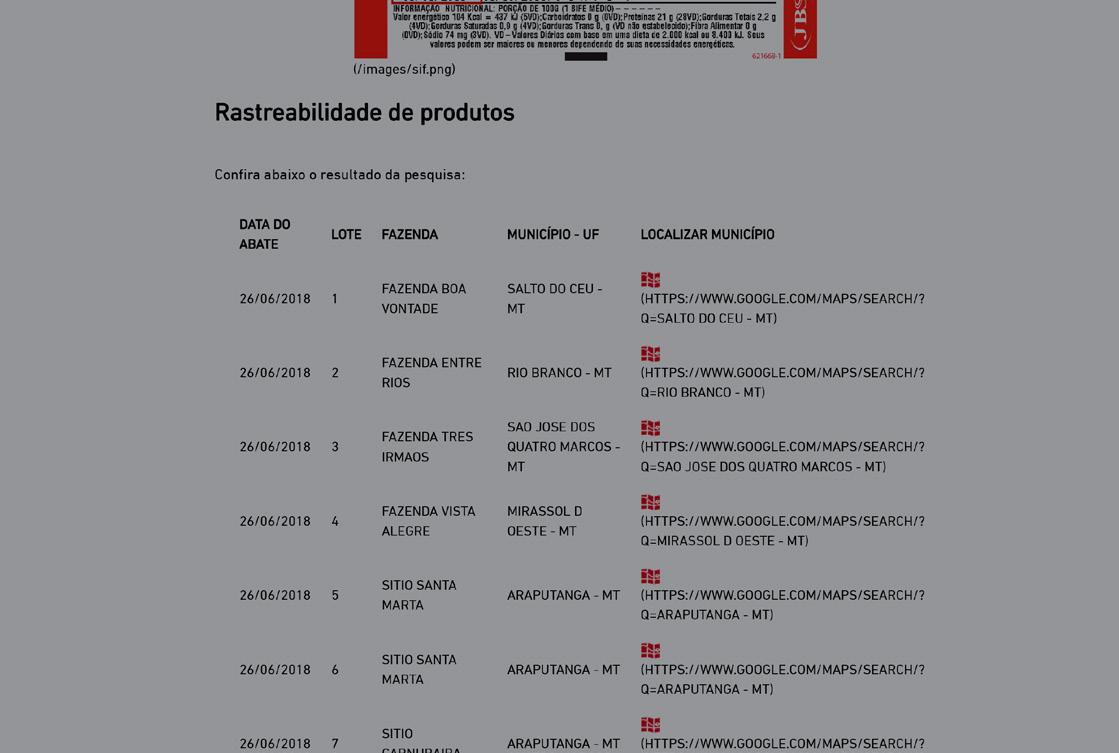
Lagoa Verde (owned by Paulo Cezar Pinto de Arruda). Potentially, up to 690 cattle were transferred. Between 8 April 2019 and 5 November 2019, or soon after, Paulo Cezar Pinto de Arruda made multiple shipments of cattle from Fazenda Lagoa Verde to Marfrig Várzea Grande. Potentially, up to 600 cattle were transferred. On 10 April 2018 and 7 November 2019, Marfrig Várzea Grande slaughtered cattle from Paulo Cezar Pinto de Arruda’s Fazenda Lagoa Verde.372
MINERVa MIR a SSOL D’OESTE (SIF 2911): Between 8 May 2018 and 3 June 2019, or soon after, Celso Miura made multiple shipments of cattle from Fazenda Mestiça to Fazenda Lagoa Verde (owned by Paulo Cezar Pinto de Arruda). Potentially, up to 690 cattle were transferred. Between 10 May 2018 and 29 October 2019, or soon after, Paulo Cezar Pinto de Arruda made multiple shipments of cattle for slaughter from Fazenda Lagoa Verde to Minerva Mirassol d’Oeste. Potentially, up to 7,400 cattle were transferred.
MINERVa VÁRZEa GRaNDE (SIF 2015): Between 8 May 2018 and 9 January, or soon after, Celso Miura made multiple shipments of cattle from Fazenda Mestiça to Fazenda Lagoa Verde (owned by Paulo Cezar Pinto de Arruda). Potentially, up to 530 cattle were transferred. Between 31 July 2018 and 21 January 2019, or soon after, Paulo Cezar Pinto de Arruda made multiple shipments of cattle for slaughter from Fazenda Lagoa Verde to Minerva Várzea Grande. Potentially, up to 730 cattle were transferred.
ME aT PROCESSOR RESPONSE
• JBS: ‘[Greenpeace] did not inform what the suspected irregularity of this producer and/or his property was. At any

rate, JBS informs that Mestiça Farm is not on its active supplier base. … Lagoa Verde Farm is compliant with the Company’s Responsible Procurement Policy.’373
• M a RFRIG: ‘On the slaughter date, Fazenda Lagoa Verde was in compliance with all the criteria of the company’s public commitments. The last slaughter was on April 23, 2020. Fazenda Mestiça is not included in Marfrig’s supplier list.’374
• MINERVa : ‘[Fazenda Lagoa Verde] is listed in Minerva’s database and is eligible for commercialization. … The [Mestiça] ranch cited as an indirect [supplier] is listed in Minerva’s database and is eligible for commercialization.’375
GREENPE aCE OBSERVaTIONS
• JBS failed to confirm the historic status of the direct trade relationship between Celso Miura and JBS Araputanga (SIF 2979).
• MINERVa’S response appears to confirm Celso Miura as a current tier-one supplier, with Fazenda Mestiça eligible for commercialisation.
• NONE OF THE ME aT PROCESSORS gives any meaningful indication that it has proactively reviewed its entire supply base – including in the Pantanal – for deliberate or illegal use of fire.
• NONE OF THE ME aT PROCESSORS gives any indication that it proactively identified and monitored the legal status or environmental impact of these indirect supplies or third-party suppliers in the Pantanal.
Ca SE STUDY 14 FaBIO DE OLIVEIR a LUCHESI
SaNTa HELENa I
TR a DE TO SL aUGHTERHOUSES 2018–2019: Minerva Mirassol d’Oeste (SIF 2911) Minerva Várzea Grande (SIF 2015) R a NCHER IRREGUL a RITIES/ EMB a RGOES/ FINES + Suspended CAR registration C a SE STUDY Fa ZENDa Santa Helena I SIC a R # MT-5102504-70F370ADCE 1F4298A8512C7106CCA57D
C a R
UNTIL 17 NOVEMBER 2020
Pending (federal) Suspended (Mato Grosso state) Fa ZENDa a RE a 10,191 ha
BURNED a RE a 1,029 ha
FIRST FIRE 4 September 2020
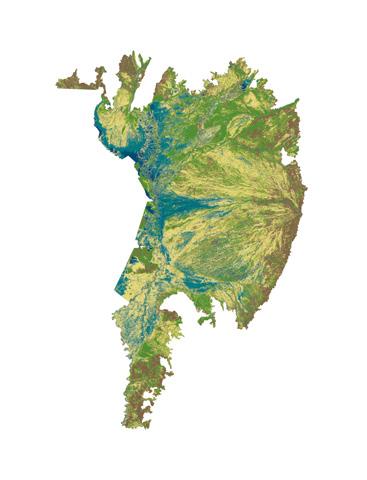
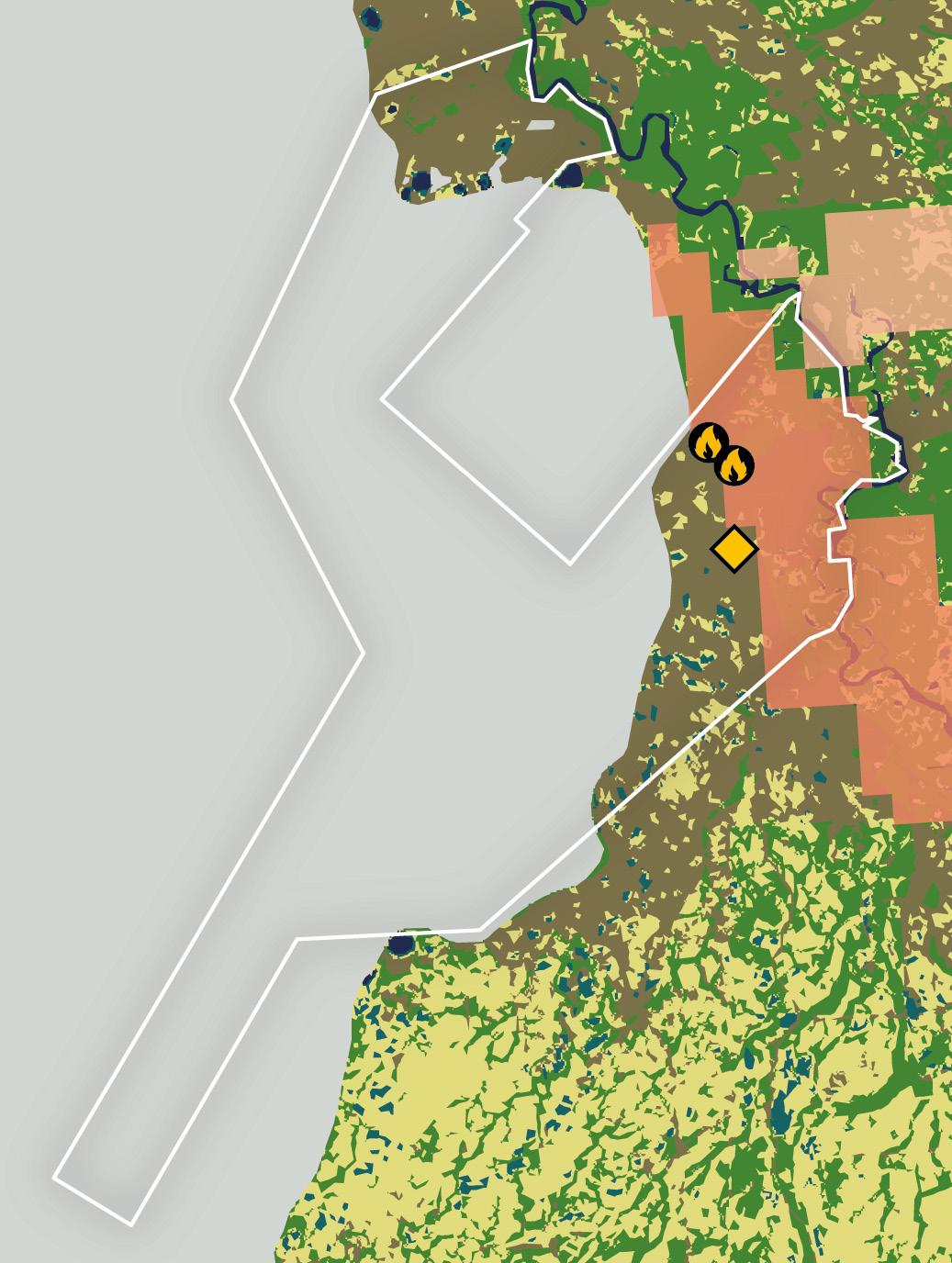
Fabio de Oliveira Luchesi is the owner of the 10,191 ha Fazenda Santa Helena I in Cáceres, Mato Grosso. Though currently listed as active, until 17 November 2020 the federal CAR website listed the ranch’s property registration status as ‘pending’, indicating an incorrect declaration, overlap with Indigenous lands or conservation units, or other irregularities,376 and the Mato Grosso state environment agency listed it as suspended (see Figures 14.1 and 14.2).377 Between 1 July 2020 and 27 October 2020 at least 1,029 ha burned within the boundaries of Fazenda Santa Helena I (which falls partially outside the limits of the Pantanal assessed for burn scar by LASA), with the first fire hotspots detected on the property on 4 September 2020. In 2018 and 2019 cattle from Fazenda Santa Helena I were supplied directly to Minerva Mirassol d’Oeste (SIF 2911) and Minerva Várzea Grande (SIF 2015).378 Fabio de Oliveira Luchesi was thus a tier-one supplier to Minerva, and trade from Fazenda Santa Helena I was direct.
MINERVa MIR a SSOL D’OESTE (SIF 2911): Between 9 July 2018 and 27 November 2019, or soon after, Fabio de Oliveira Luchesi made multiple direct shipments of cattle for slaughter from Fazenda Santa Helena I to Minerva Mirassol d’Oeste. Potentially, up to 750 cattle were transferred.
MINERVa VÁRZE a GR a NDE (SIF 2015): On or soon after 20 July 2018 Fabio de Oliveira Luchesi made multiple direct shipments of cattle for slaughter from Fazenda Santa Helena I to Minerva Várzea Grande. Potentially, up to 180 cattle were transferred.
ME aT PROCESSOR RESPONSE
• MINERVa: ‘[Fazenda Santa Helena I] is listed in Minerva’s database and is eligible for commercialization. In addition, the Company would like to emphasize that a CAR in pending status is not a criterion for restriction. This status is a result of some administrative delay between the supplier and the Secretary of the Environment. The analysis that has already been carried out contemplates the verification of environmental restrictions such as deforestation, overlapping protected areas, and state and federal embargoes. It is important to mention that the CAR was active during the period in which commercialization with the ranch took place.’379
GREENPE aCE OBSERVaTIONS
• MINERVa’S claim that a ‘pending’ CAR status is not a criterion for restriction is controversial.
• MINERVa’S response confirms that Fabio de Oliveira Luchesi remains a current tier-one supplier.
• MINERVa gives no meaningful indication that it has proactively reviewed its entire supply base for deliberate or illegal use of fire.




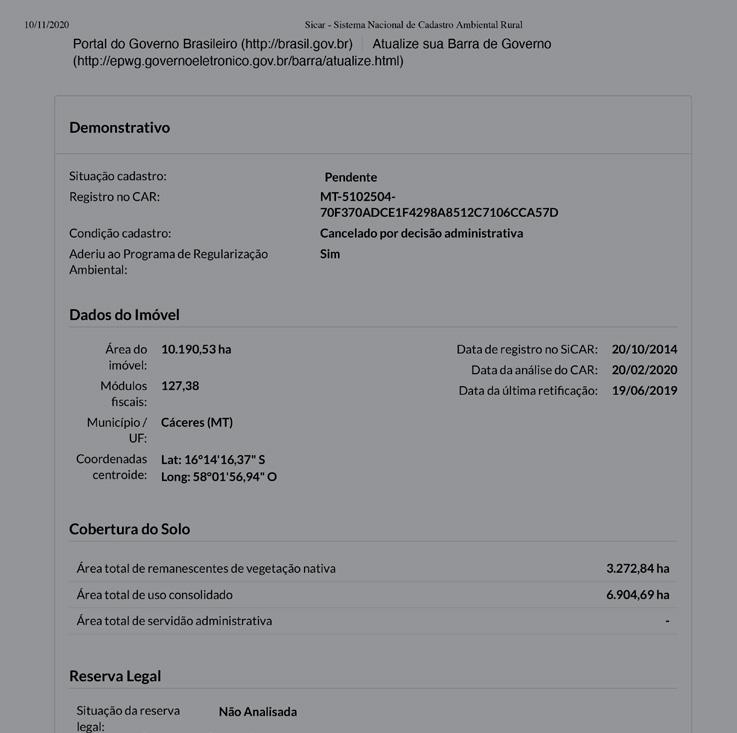

Ca SE STUDY 15 SERGIO JaCINTO COSTa
TOURO MORTO
TR a DE TO SL aUGHTERHOUSES
2018–2019
JBS Anastácio (SIF 615)
JBS Campo Grande (SIF 4400)
C a SE STUDY Fa ZENDa Touro Morto
SIC a R #
MS-5003207-B28618A7322 846BFAA0B988E6944F02A
C a R STaTUS Active
Fa ZENDa a RE a 5,002 ha BURNED a RE a 630 ha FIRST FIRE 12 September 2020


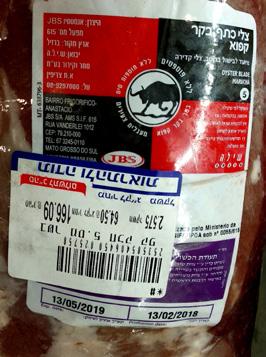
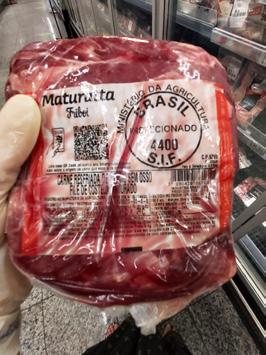
23 January 2019, Israel: Beef from JBS Anastácio (SIF 615) on sale in Shufersal supermarket. © Greenpeace
Sergio Jacinto Costa is the owner of the 5,002 ha Fazenda Touro Morto in Corumbá, Mato Grosso do Sul. Between 1 July 2020 and 27 October 2020 some 630 ha burned within the boundaries of the ranch, with fire hotspots detected from 12 September 2020.
In 2018 and 2019 cattle from Fazenda Touro Morto were supplied directly to JBS Anastácio (SIF 615) and JBS Campo Grande (SIF 4400).380 Sergio Jacinto Costa was thus a tier-one supplier to JBS, and trade from Fazenda Touro Morto was direct.
JBS a N a STÁCIO (SIF 615):
Between 1 March 2019 and 27
May 2019, or soon after, Sergio Jacinto Costa made multiple direct shipments of cattle from Fazenda Touro Morto to JBS Anastácio. Potentially, up to 850 cattle were transferred. On 5 March 2019 and 30 May 2019 JBS Anastácio slaughtered cattle from a Fazenda Touro Morto located in Corumbá, Mato Grosso.381
JBS
C a MPO GR a NDE (SIF 4400): On or soon after 23
February 2018 Sergio Jacinto Costa made multiple direct shipments of cattle from Fazenda Touro Morto to JBS Campo Grande (SIF 4400). Potentially, up to 440 cattle were transferred. On 28 February 2018 Campo Grande (SIF 4400) slaughtered cattle from a Fazenda Touro Morto located in Corumbá, Mato Grosso.382
ME aT PROCESSOR RESPONSE
• JBS: ‘[Greenpeace] did not inform the suspected irregularity of this producer and/or of his property, which is registered in compliance with the Company’s Responsible Procurement Policy.‘383
GREENPE aCE OBSERVaTIONS
• JBS’S response confirms that Sergio Jacinto Costa remains a current tier-one supplier.
• JBS gives no meaningful indication that it has proactively reviewed its entire supply base – including in the Pantanal – for deliberate or illegal use of fire.
FIRE S a LES –FURTHER TR a DE LINKS TO THE Pa NTa N a L BL a ZES
Further links between fires in the Pantanal and ranchers supplying Brazil’s largest beef processors were made in Repórter Brasil’s September 2020 investigation.384 Their analysis focused on five rural properties in the state of Mato Grosso where the Instituto Centro de Vida identified ignition points for fires in this part of the Pantanal in 2020 (see ‘Under fire’ above).385 It revealed that two of the cattle ranches on these properties have trading links to Brazil’s largest beef processing companies – JBS, Marfrig and Minerva.386 According to Repórter Brasil, Raimundo Cardoso Costa – owner of Fazenda Comitiva, where fires began (accidentally, according to Costa) that ultimately destroyed 25,188 ha – is also listed by the Mato Grosso State Secretariat of Finance as the owner of an adjacent property, Fazenda Recanto das Onças.387 The investigation identified this ranch as having sold cattle to the Bom Futuro group, which reportedly supplies all three processing companies. Repórter Brasil also investigated Fazenda Espírito Santo, which it identified as the ignition point for fires that led to the destruction of 14,292 ha. Its owner, José Sebastião Gomes da Silva, reportedly owns another ranch, Fazenda Formosa, that supplies cattle both to Amaggi
Pecuária – part of the Amaggi group, which has 10 ranches in Mato Grosso and also reportedly supplies all three leading meat processors – and to Fazenda Rio Bonito, which supplies JBS and Marfrig.388
Some of the facilities discussed above have also recently been linked to environmental destruction in other biomes. For example, an earlier Repórter Brasil investigation found that JBS’s Diamantino (SIF 3000) facility was supplied by two ranches allegedly engaged in illegal deforestation in the Cerrado, including one that the INPE monitoring system reportedly showed had cleared 835 ha without authorisation in 2015 and 2016. According to Repórter Brasil, the owner of the other ranch had been accused by the Public Ministry of the State of Mato Grosso (Ministério Público do Estado do Mato Grosso) of having illegally cleared 616 ha of native vegetation between 2011 and 2016 in this property, located in an area of high biodiversity in a transition region between the Cerrado and the Amazon and close to Indigenous lands. The investigation also determined that this ranch had supplied cattle to Marfrig Paranatinga (SIF 2500) and indirectly to two other Marfrig processing facilities in Mato Grosso.389
THE WORLD ON a EDGE
‘ The same human activities that drive climate change and biodiversity loss also drive pandemic risk through their impacts on our environment. Changes in the way we use land; the expansion and intensification of agriculture; and unsustainable trade, production and consumption disrupt nature and increase contact between wildlife, livestock, pathogens and people. This is the path to pandemics.’390
Dr Peter Daszak, Chair of the IPBES workshop on the links between degradation of nature and increasing pandemic risks, 29 October 2020

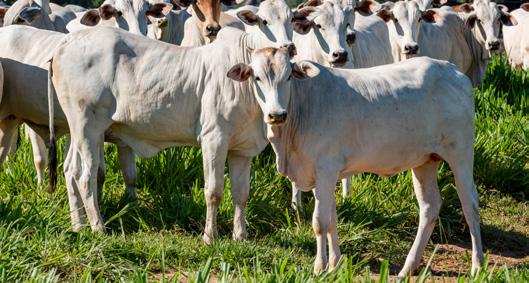

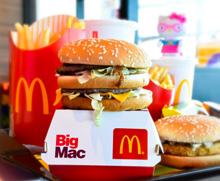
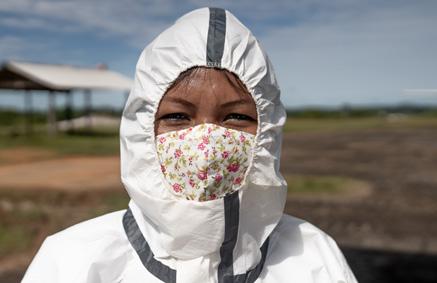
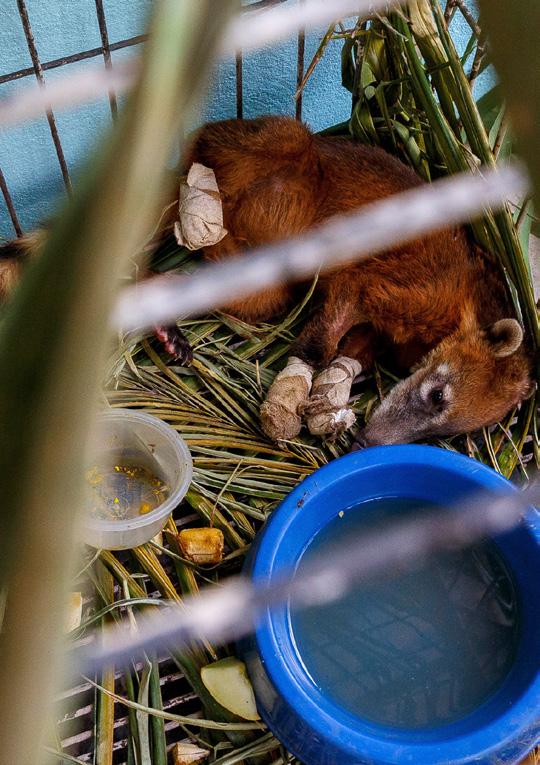
In late October 2020, the Intergovernmental SciencePolicy Platform on Biodiversity and Ecosystem Services (IPBES) issued a report warning that ‘Future pandemics will emerge more often, spread more rapidly, do more damage to the world economy and kill more people than Covid-19 unless there is … a seismic shift in approach from reaction to prevention.’391 Critically, the report’s authors found that pandemic risk is fuelled by the same global environmental changes that drive biodiversity loss and climate change – the actions of humankind, as our ever-increasing consumption encourages more and more ecosystem conversion and habitat destruction. Due to its links to deforestation and habitat degradation, industrial meat production contributes to the increased risk of zoonoses –diseases such as Covid-19 that are originally found in non-human animals but jump the species barrier and begin to infect humans.392 Dealing with the ultimate economic fallout of climate change, ecosystem collapse and pandemics will prove incalculably more expensive than acting now to mitigate these risks.
Urgent action to transform the global food system is critical to address these multiple challenges. In November 2020, Science published a report finding that even if greenhouse gas (GHG) emissions from the burning of fossil fuels were halted immediately, rising emissions from global food production alone might take the global temperature rise this century over the 1.5° and 2ºC targets set by the Paris Agreement.393 Meeting either target, the report’s authors cautioned, would require rapid, ‘extensive and unprecedented’ changes to the global food system, including adopting plant-rich diets, cutting food waste and increasing yield, for instance through agro-ecological production practices.394
The window for action is short. Earlier in 2020, scientists reported that the Amazon is approaching a climatic tipping point beyond which much of its vegetation would change, perhaps irreversibly, from rainforest to savannah.395 Such a transformation could wipe out a significant part of the world’s biodiversity,396 as well as releasing huge amounts of stored carbon and reducing rainfall
across a continent that is already suffering from severe droughts397 as a result of climate change and regional disruption of rainfall patterns due to Amazon deforestation.398
2019 saw an unprecedented number of fires in Brazil, more than half of them in the Amazon399 – but that is not the region’s only vulnerable ecosystem. 2020 was yet another disastrous year for South America’s forests and other ecosystems, as fires raged in the Amazon (Bolivia and Brazil), 400 the Cerrado (Brazil), 401 the Gran Chaco (primarily Argentina, Bolivia and Paraguay), 402 the Pantanal (Bolivia, Brazil and Paraguay)403 and the Paraná Delta (Argentina). 404 It is widely recognised that most of the blazes did not originate naturally, but were caused by the actions of humans – including intentional burning for the purposes of clearance or land management by the ever-expanding beef and soya sectors. In the case of Brazil, the flames of the fires lit by farmers have been fanned by the government’s systematic undermining of federal institutions intended to protect the environment. 405
The bitter reality is that 2020 may prove to have been the point of no return for numerous critical ecosystems. According to Swiss Re, one of the world’s largest reinsurance companies, when viewed from the standpoint of biodiversity and the provision of ecosystem services such as climate regulation, maintenance of air and water quality and soil fertility, pollination and erosion control, in one in five countries worldwide terrestrial ecosystems in at least 30% of the country are in a fragile state – posing the risk that further degradation may accelerate their decline or even lead to abrupt ecosystem collapse. 406
With the fate of the natural world as we know it now balancing on a knife-edge, this hard reality must underpin the decisions governments, corporations and financiers take in their relations with the agricultural commodity sector. This is especially the case in high-risk regions such as Brazil and other Mercosur countries, particularly in the context of trade negotiations.
TaKING THE BULL BY THE HORNS
– TIME FOR SUPPLY CH a IN aCTION
‘a ll economic partners of Brazil should share the blame for indirectly promoting deforestation and GHG emissions by not barring imports and consuming agricultural products contaminated with deforestation, illegal or not.’407
Raoni Rajão et al, Science, July 2020
‘ Food system changes that reduce GHG emissions may offer additional benefits, including progress toward targets set in the United Nations’ Sustainable Development Goals, such as decreased nutrient pollution, reduced water pollution and scarcity, decreased land-use change, improved biodiversity outcomes, and, if dietary composition and caloric consumption are improved, reduced prevalence of obesity, diabetes, heart disease, and premature mortality.
Time is of the essence in addressing GHG emissions. a ny delays will necessitate more ambitious and expeditious implementation of emissions reduction strategies if global temperature targets are to be met. We show that there are many opportunities to keep emissions from food systems and other activities within the global emissions limits for the 1.5° and 2°C targets.’ 408
MichaelA Clark et al, Science, November 2020
‘ To secure a thriving food system for the future, the food industry as a whole has an opportunity – and responsibility – to help mitigate the impacts of climate change and find more sustainable ways to feed people. at McDonald’s, our responsible sourcing strategy includes a climate action target to reduce greenhouse gas emissions intensity in our supply chain by 2030, as well as a commitment to eliminate deforestation from our global supply chains by 2030, prioritising by end of 2020 the raw materials we buy in the greatest volume: beef, chicken (including soy in feed), palm oil, coffee and the fibre used in guest packaging. … We work closely with our biggest suppliers in the product categories in which we can have the greatest impact and actively encourage these suppliers to set targets, measure and report emissions and take action to make reductions. We know we cannot drive industry-wide change alone, and we encourage all companies to work collaboratively on solutions.’409
McDonald’s spokesperson, quoted in Food Navigator, 12 November 2020
Rapid and systemic transformation of the industrial meat sector will be critical to addressing the present triple threat of climate change, biodiversity loss and vulnerability to novel diseases. 410 Governments, financial institutions and the private sector alike need to swap empty rhetoric for action and assume their responsibility for tackling these crises.
Radical action is needed from governments, the finance sector, supermarkets and fast food companies to ensure that policy, finance and trade drive – rather than undermine – the urgently needed shift to resilient food economies that permit the restoration and regeneration of natural ecosystems, ensure the preservation of biodiversity, rein in GHG emissions and uphold the rights of communities and workers.
Financial institutions must recognise that JBS does not represent a responsible investment and withhold their support from its proposed NYSE listing. More broadly, they must ensure much tougher environmental scrutiny of all companies producing or trading in so-called forest and ecosystem risk commodities (FERCs), withholding investment and financial services from those that cannot show their supply chains are free from ecosystem destruction.
Food sector companies must similarly increase environmental scrutiny of all their FERC suppliers and exclude non-compliant companies, including JBS and its subsidiaries. In the longer term they must aim to phase out sales of industrially produced meat from all sources, recognising that even those parts of the sector (such as intensive chicken production) that are not major direct drivers of deforestation are heavily dependent on the highly destructive feed industry. 411
The example of JBS also highlights the need for all governments – be they FERC-producing countries such as Brazil or importing blocs such as the EU – to have in place zero deforestation laws and regulations requiring producers and processors of FERCs as well as operators placing FERCs and derived products on consumer markets to meet strictly defined sustainability criteria and to ensure full supply chain traceability and transparency. This means that, in all markets where FERCs are produced or consumed, efforts to end links to deforestation should be underpinned by due diligence legislation to ensure that commodities and products are not linked to deforestation, ecosystem destruction and abuses of human rights. Such legislation should include measures for financial institutions that invest in or lend to companies producing or trading in FERCs.
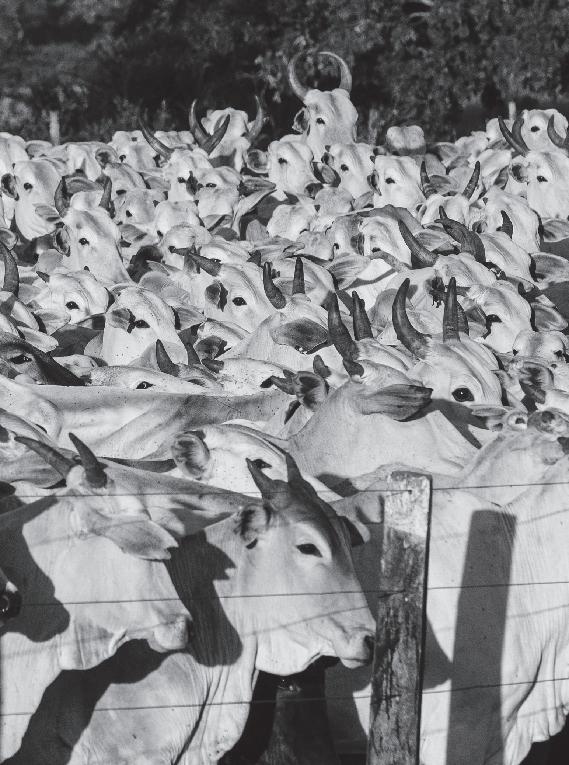

WHO NEEDS TO DO WH aT
The steps that food industry, financial institutions and governments take in the immediate future in relation to JBS, Marfrig and Minerva – some of the world’s largest meat processors – and the global meat industry as a whole will be a decisive test of their priorities. Governments and companies must align the economy with biodiversity and climate protection, along with social justice. They must ensure that private and public finance, trade policy and overseas cooperation do not drive further deforestation, but do support nature restoration and a transition to a green, just and resilient economy. This includes:
CLOSE THE M a RKET TO FOREST DESTROYERS:
DROPPING FOREST a ND ECOSYSTEM DESTROYERS:
End finance for or trade with groups such as JBS whose direct or indirect suppliers are linked to deforestation and alleged human rights violations –this includes ending trade with subsidiaries such as JBS-owned Pilgrim’s Pride, which owns Moy Park and Tulip (recently renamed Pilgrim’s Pride Ltd412).
DROPPING COMMODITIES linked to forest and ecosystem destruction: Including through the adoption of a law on forest and ecosystem risk commodities (FERCs) and derived products, to ensure that commodities and products linked to deforestation, ecosystem destruction and abuses of human rights are not placed on the market. The legislation should include measures to cover the financial sector, ensure full supply chain traceability and transparency and rules on due diligence.
ENSURING TR a DE POLICY a LIGNS WITH CLIM aTE, BIODIVERSITY a ND SOCIa L JUSTICE GOa LS: This includes refusing to ratify trade deals such as the EU–Mercosur agreement. Trade agreements of this kind are based on an extractive model that commodifies people and nature and is inherently incompatible with forest protection - governments should instead protect forests and other natural ecosystems by adopting policies to decrease meat production and consumption, and addressing their external forest and ecosystems footprint by means of product and supply chain regulations.
TR a NSFORM THE FOOD SYSTEM:
PH a SING OUT INDUSTRIa L ME aT: Immediately begin the phase-out of all finance for or trade in industrial meat, with the aim of reducing overall meat and dairy production and sales by at least 50% by 2025 and 70% by 2030 in countries with high levels of meat consumption. 413
M a KING FULL TR a NSPa RENCY a CONDITION OF TR a DE: Make full transparency of group operations and the supply chain a condition of finance or trade, requiring open and comprehensive monitoring and reporting systems to be in place.
PRIORITISING HUM a N a ND ENVIRONMENTa L
HE a LTH: Introduce targets, legislation and fiscal measures to decrease production and consumption of meat and dairy products in countries with high levels of consumption and support a fundamental shift towards ecological farming and healthy plant-rich diets in order to reduce pressure on natural ecosystems.


a NNEX 1: REPORTED EXPORTS FROM LINKED FaCILITIES, Ja NUa RY 2019–OCTOBER 2020
(SIF 1662)
4121)
MaRFRIG PONTES E L aCERDa (SIF 1900)
ZILIaNI / SaNTa TEREZ a FR aNCISC a EVaNGELISTa TEODORO Da SILVa / SÃO BENTO EDUaRDO MaRIaNI BITTENCOURT / VÁRZE a FUNDa
(SIF 2015)
REPORTED EXPORTS BY Ta NNERIES Ja NUa RY 2019–OCTOBER 2020
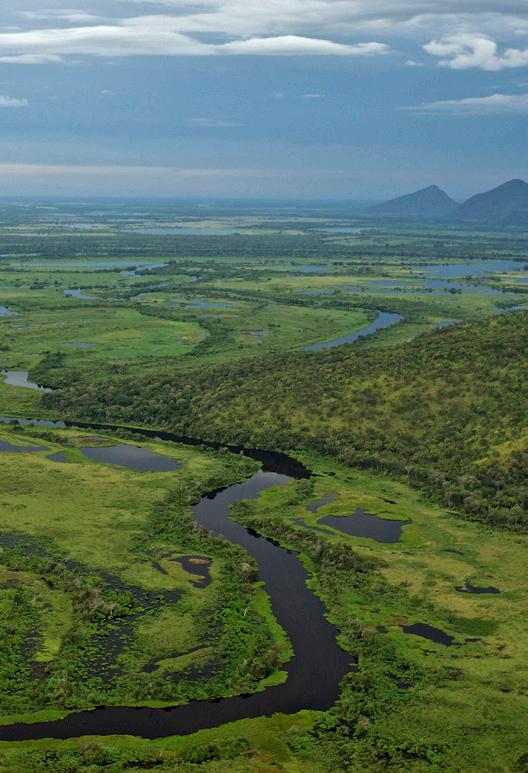
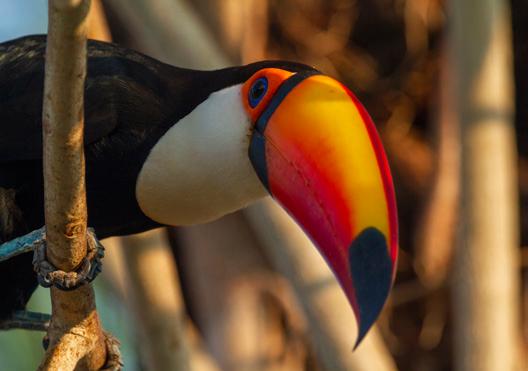
a NNEX 2: OPPORTUNITY TO COMMENT
Within the context of the 2020 Pantanal fires –many reportedly thought to have been deliberately and illegally lit by ranchers in defiance of regional and federal bans – Greenpeace provided the meat processors and, where possible, ranchers named in this report with the opportunity to comment prior to publication on the historic trade links it had established between ranchers with operations in the Pantanal and specific slaughterhouses, as well as any legal/policy irregularities (eg embargoes, irregular CAR status) it had identified in those ranchers’ operations. The aim was to help ensure the accuracy of all findings.
Greenpeace contacted the meat processors on 4 January 2021, asking them to:
1. Confirm the historic trade information linking them to the named ranchers and confirm and explain any identified legal/ policy irregularities associated with the named ranchers
2. Provide the most recent date on which they had sourced cattle from the named ranchers
3. Identify the steps they had taken to review the compliance of their current suppliers, given the extent of the fires in the Pantanal in 2020 and federal and state bans on deliberate use of fire
4. Verify whether – following review – the decision had been taken to exclude any of the named ranchers from their supply chains
The letters received in reply are reproduced below. Copies of the full responses are also available online, at https://drive.google. com/drive/folders/14lO83hGPwMlCxfX7glurOoztPNNHdHT?usp=sharing


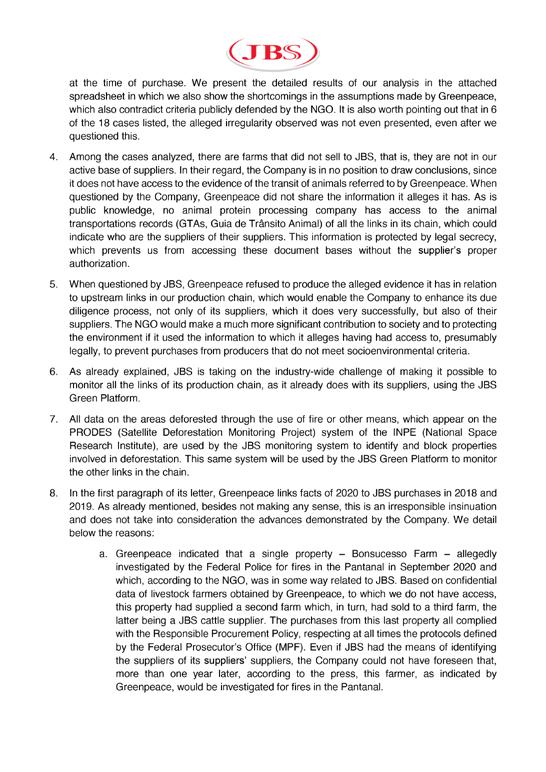
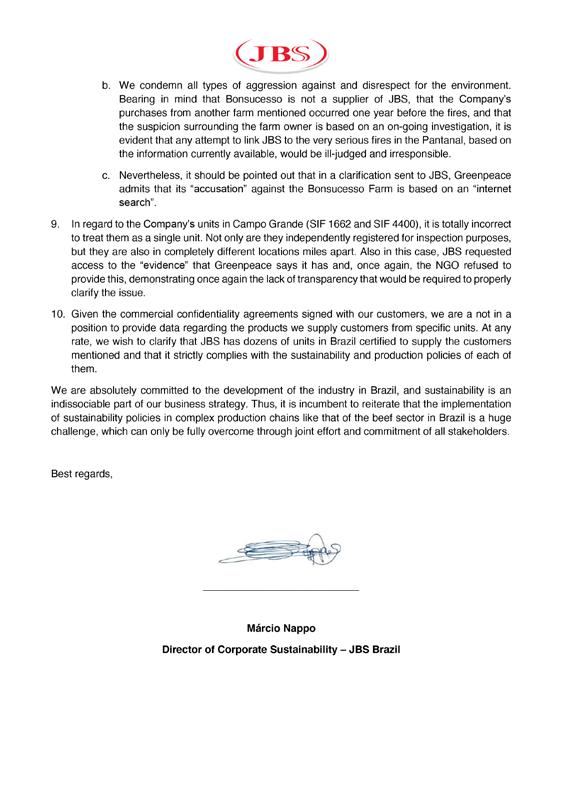

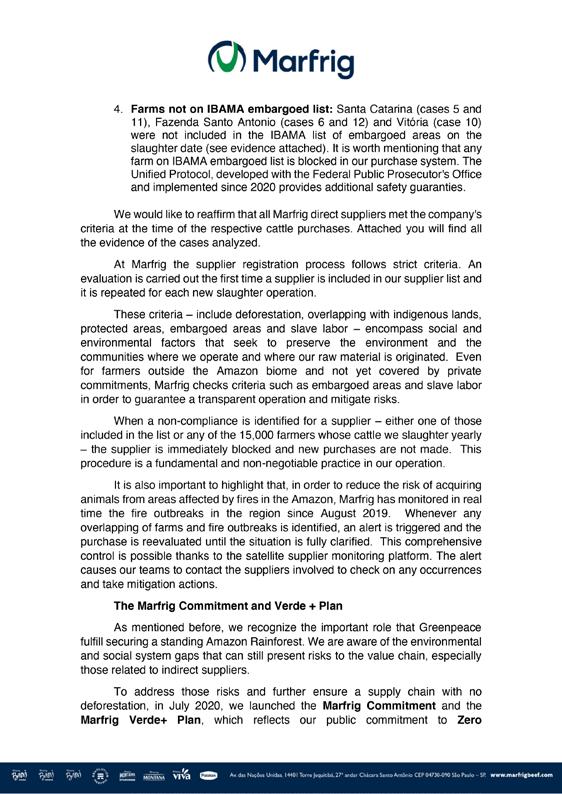
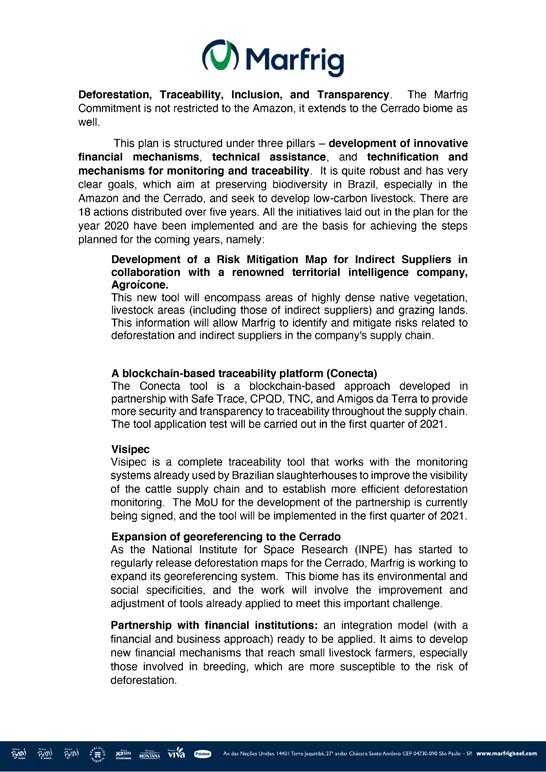
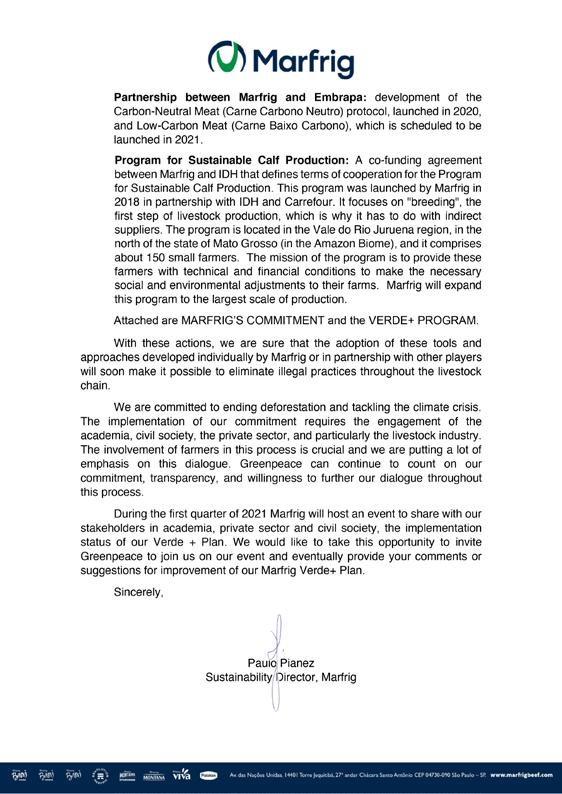
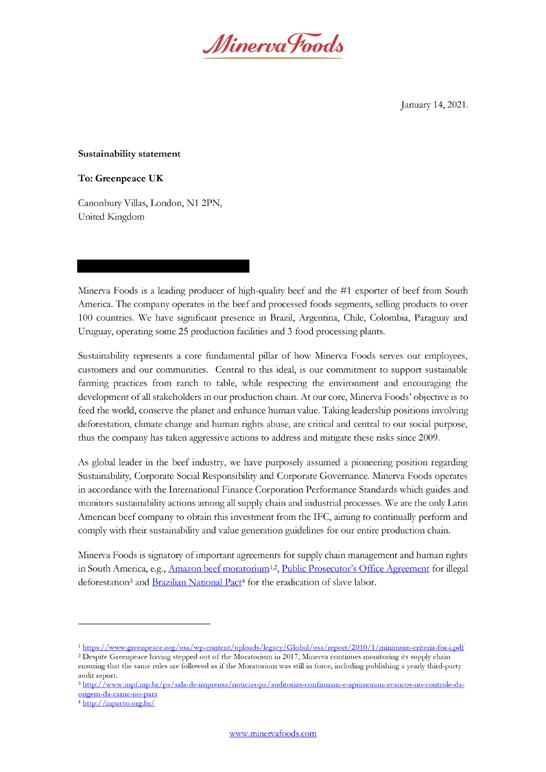
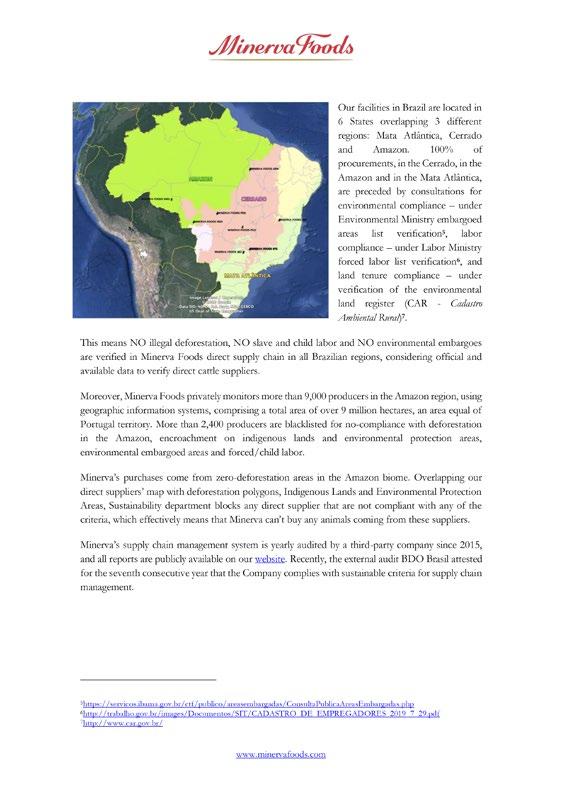
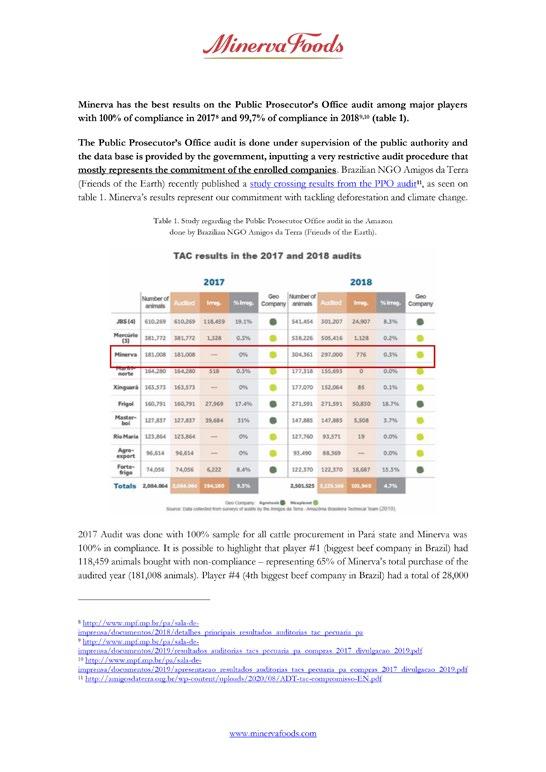

MINERVA
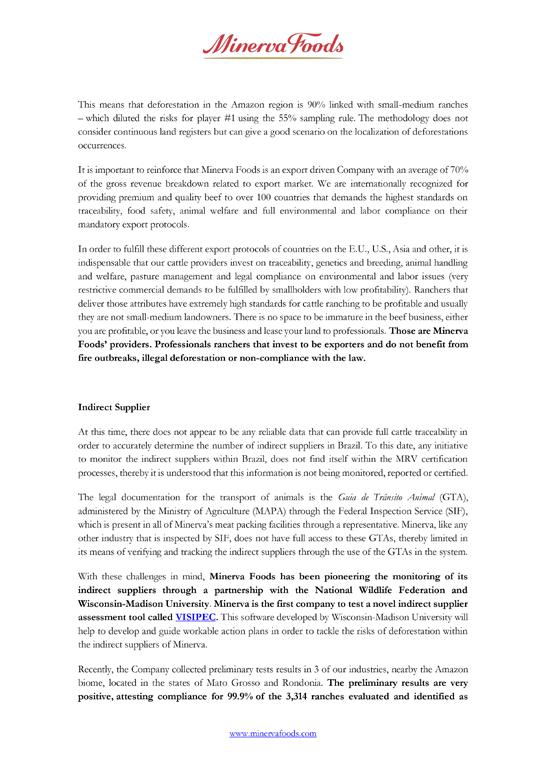


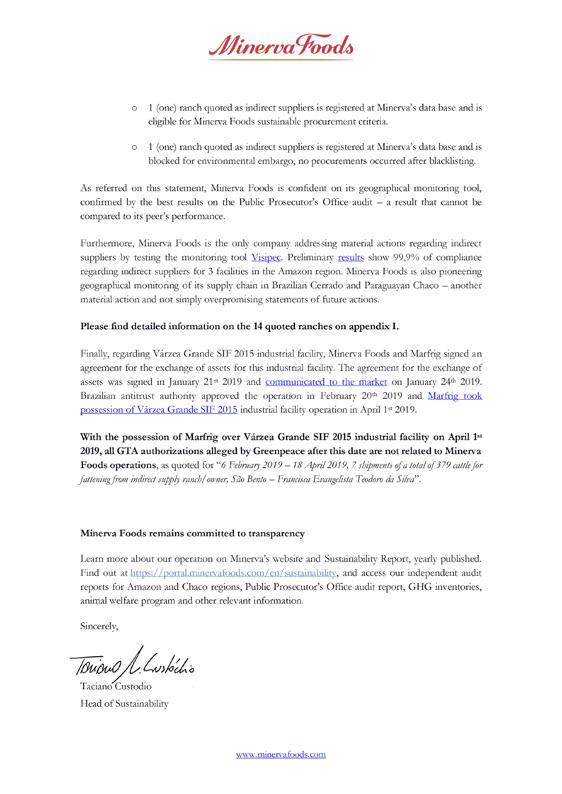
M a PPING a ND DaTa REFERENCES
L a ND COVER:
MapBiomas produces annual statistics and high-resolution maps of land use change for Brazil, including the Pantanal, 414 covering 1985 to the present. The 30-metre-resolution maps use automatic classification through machine learning based on Landsat imagery.
Source: MapBiomas Project – Collection 5 of the Annual Series of Coverage and Land Use Maps in Brazil, accessed October 2020 through the link https://plataforma.mapbiomas.org/
LIMITaTIONS
2019 is the latest year for which data are readily available. Detailed satellite analysis or a delay would be required to identify 2020 land cover prior to fires. Given the indicative nature of the analysis, this is not a profound limitation.
FIRE HOTSPOTS a ND BURNED a RE a S (BURN SC a R):
Fire hotspot data were downloaded from INPE’s Programa Queimadas415 and include data from all confidence levels for the INPE reference satellite, MODIS Aqua. 416
The burn scar dataset, covering 1 July to 27 October 2020, was provided to Greenpeace Brazil as a KML file by LASA, part of a joint initiative between the Universidade Federal do Rio de Janeiro in Brazil and the Instituto Dom Luiz at the University of Lisbon, Portugal. The model uses NASA VIIRS observations to produce near-real-time (NRT) analysis of burned areas at 500m resolution.
LIMITaTIONS
Fire hotspots are thermal anomalies (ie unusually hot areas) detected by satellites. It is important to distinguish hotspots from actual fires – they could represent fires or they could be hot tin roofs, although the occurrence of false positives is relatively low. Within forest areas, accuracy depends on the size of the fire, the density of the canopy and proximity to built-up areas.
Fires may have occurred undetected by the systems used for this analysis because of data capturing intervals, because of clouds or haze or tree cover obstructing detection, or because the fire was too cool at the surface to be detected. Combining the alert data from different satellites such as MODIS Aqua and VIIRS, which pass over at different times during the day or have different resolutions, increases the chances of capturing fires within affected areas. Conversely, it will inevitably lead to the inclusion of some false positives. There is no single perfect fire detection system available at present.
NRT burn scar mapping is recent technology, so making comparisons with previous years, for instance to assess the extent of the burned area, is not always feasible. In December 2020, MapBiomas launched an initiative to provide consolidated information on the area burned each year from 2000 to 2019. 417 Unfortunately, due to methodological differences, the data are not comparable with the LASA maps.
LASA estimates that its burned area maps have a 20% margin of error, 418 meaning the resulting analysis should be considered indicative only. They represent the best current available information.
THE LOC aTION a ND BOUNDa RIES OF THE
NTa N a L BIOME, INDIGENOUS L a NDS a ND PROTECTED a RE a S:
In 2019, IBGE published at a scale of 1:250,000 a revision to its 1:5,000,000 map of the Pantanal and other biomes.
Source: Biomas_250mil.zip, available under Downloads > vetores at https://www.ibge.gov.br/geociencias/informacoesambientais/15842-biomas.html
FUNAI publishes maps showing the locations of Indigenous lands and what stage in the demarcation procedure they have reached.
Source: http://www.funai.gov.br/arquivos/conteudo/cggeo/ pdf/terra_indigena.pdf
Conservation units (unidades de conservação, UCs) are protected areas on public land within which economic activities are forbidden or highly controlled. There are several types of conservation unit in Brazil, including fully protected units (unidades de proteção integral), such as national or state parks or biological reserves, and private reserves (Reserva Particular do Patrimônio Natural, RPPN), which allow ‘sustainable use’. The dataset used in this analysis is a compilation of several datasets from several sources.
ICMBio: The Instituto Chico Mendes de Conservação da Biodiversidade (Chico Mendes Institute for Biodiversity Conservation) is the branch of the Ministry of the Environment charged with managing Brazil’s federal conservation units and protecting its natural heritage and biodiversity. Through its Sistemas Informatizado de Monitoria de RPPN (SIMRPPN), it makes available maps of some RPPN conservation units.
Source: https://sistemas.icmbio.gov.br/simrppn/publico/
IHP: The Instituto Homem Pantaneiro is an NGO working for the preservation of the Pantanal biome and culture, which provides detailed maps of certain RPPNs.
Source: https://www.institutohomempantaneiro.org. br/relatorios –> Relatório RPCSA 2019 p17 illustrates the boundaries of RPPN Acurizal, RPPN Fazenda and RPPN Rumo ao Oeste (direct download https://drive.google.com/file/d/1EVAJx x6J02XcPY8Fw7cF28hzGamrx7Lq/view?usp=sharing)
INCRA: The Instituto Nacional de Colonização e Reforma Agrária (National Institute for Settlement and Agrarian Reform) is the federal agency responsible for the administration of land reform issues, including demarcating land for new farming settlements, registering certified properties and maintaining a georeferenced database of such properties. Brazilian law mandates that every rural property must be professionally surveyed and registered
with INCRA by 2025. INCRA makes available maps of properties with rural property certificates (Certificação de Imóveis Rurais). Information in the INCRA database allows localisation of RPPNs for which no official geographical information is available.
Source: https://certificacao.incra.gov.br/csv_shp/export_shp. py
INTERMAT: The Instituto de Terras do Mato Grosso is the land institute for the state of Mato Grosso and is responsible for implementing the state policy on the disposal of public lands. It makes available digital maps of all state conservation units in Mato Grosso.
Source: http://www.intermat.mt.gov.br/-/11303036-basescartograficas
MMA: The Ministério do Meio Ambiente (Brazilian Ministry of the Environment) makes available shapefiles of established federal conservation units (both fully protected and areas of sustainable use).
Source: http://mapas.mma.gov.br/i3geo/datadownload.htm; also available from INPE TerraBrasilis at http://terrabrasilis.dpi. inpe.br/download/dataset/pantanal-aux/vector/conservation_ units_pantanal_biome.zip
SICAR: The Sistema Nacional de Cadastro Ambiental Rural (Federal Rural Environmental Registry), which is under the Serviço Florestal Brasileiro (Brazilian Forest Service), a branch of the Ministério da Agricultura, Pecuária e Abastecimento (Ministry of Agriculture, Livestock, and Food Supply), makes available the self-reported boundaries of rural properties. Information in the SICAR database allows localisation of RPPNs for which no official geographical information is available.
Source: https://www.car.gov.br/publico/municipios/downloads
LIMITaTIONS
Although Brazil’s Constitution guarantees Indigenous land rights on ancestral lands, the government has delayed the process of land demarcation for decades. New policies pave the way for land claims made within Indigenous territories to gain official recognition. 419 Equally, conservation units, particularly at state level, are extensively overlapped by CAR registrations. In brief, the legal status and enforcement of legal standing of these areas is not guaranteed. This is less an issue of data deficiency than an issue of public policy.
THE LOC aTIONS OF C aTTLE R a NCHES:
Under Brazil’s Forest Code, rural property holders are required to provide information on their properties to the Rural Environmental Registry (Cadastro Ambiental Rural, CAR), including the property owner and georeferenced property
boundaries. Official data on these georeferenced property boundaries are publicly available from federal and state-level sources.
Sources:
Federal CAR data: https://www.car.gov.br/#/consultar
Mato Grosso CAR data: https://monitoramento.sema.mt.gov.br/ simcar/tecnico.app/publico/car
Mato Grosso do Sul CAR data: https://www.imasul. ms.gov.br/cadastro-ambiental-rural-car-ms/ and https:// www.pinms.ms.gov.br/portal/home/webmap/viewer. html?webmap=3b0c2ba8c1a34c46ba6167d35d2c14ce
LIMITaTIONS
Registration with the CAR is mandatory in Brazil under the Forest Code, and CAR registrations are frequently used to stake and secure land claims through evidence of agricultural use, even though they do not constitute legally binding land title. 420 The original deadline for registration of rural properties was May 2016, but this has been extended several times as not all property owners have complied. Additionally, much of the self-reported information has not yet been verified, meaning that land claims may overlap with public, protected or Indigenous lands. Further, the self-declared property boundaries may be revised to avoid liability for violations of the Forest Code, which specifies the minimum proportion of natural vegetation that must be maintained within a property. 421 Other challenges with the dataset include growing gaps in the embedded attributes, making the linking of a rancher with a specific CAR registration and thence other data difficult. Different ranches may have the same name, certain surnames are extremely common and the official owner of a ranch may not be the named individual managing trade. Despite its limitations, the CAR database is the main reference used by companies, civil society and federal inspectors to monitor properties for policy or legal violations.
THE LOC aTION OF C aTTLE SECTOR INFR a STRUCTURE:
The image processing laboratory at the Universidade Federal de Goiás (Laboratório de Processamento de Imagens e Geoprocessamento, Lapig) makes available a number of data layers including point locations for grain silos, soya crushing facilities and slaughterhouses.
Source: https://www.lapig.iesa.ufg.br/lapig/index.php/ produtos/dados-geograficos
The Ministry of Agriculture, Livestock, and Food Supply provides public information on SIF-registered beef processing facilities. Sources: SIF consultation portal: http://bi.agricultura.gov.br/reports/
rwservlet?sigsif_cons&estabelecimentos.rdf&p_id_area=1 List of establishments: http://extranet.agricultura.gov.br/sigsif_ cons/!ap_estabelec_nacional_cons
ENVIRONMENTa L OR HUM a N RIGHTS S a NCTIONS LINKED TO R a NCHES a ND THEIR OWNERS:
Brazil’s Ministry of Labour and Employment (Ministério do Trabalho e Emprego, MTE) publishes a ‘Dirty List’ of farms identified as using or having used slave labour or labour analogous to slavery.
Source: https://sit.trabalho.gov.br/portal/images/CADASTRO_ DE_EMPREGADORES/CADASTRO_DE_EMPREGADORES.pdf
INFORM aTION ON ENVIRONMENTa L VIOL aTIONS a ND M a PS OF EMB a RGOED a RE a S:
IBAMA publishes information on embargoed areas as well as other infractions and fines, with details on the location, the offence and the offender. Additional information on infractions is embedded in the CAR shapefiles. The Mato Grosso state environment agency also provides maps of embargoed areas and an online consultation website for details of specific cases. ICMBio makes available some information as KMZ files.
Sources:
IBAMA consultation website: https://servicos.ibama.gov.br/ctf/ publico/areasembargadas/ConsultaPublicaAreasEmbargadas. php and https://siscom.ibama.gov.br, Dados Geoespaciais > Camadas > Autos de Infração (shapefiles downloaded 11 November 2020)
Mato Grosso embargo map (SEMA - Navegador Geográfico Unificado): https://monitoramento.sema.mt.gov.br/simcar/ tecnico.app/publico/mapa (downloaded 13 November 2020) Mato Grosso consultation website: http://www.protocolo.sad.mt.gov.br/consulta/cp.php ICMBio: https://www.icmbio.gov.br/portal/ geoprocessamentos/51-menu-servicos/4004-downloadsmapa-tematico-e-dados-geoestatisticos-das-uc-s
LIMITaTIONS
Information on environmental violations is not easy to consult – CAR registration numbers or CPJ numbers, for instance, are needed. The information provided also is often piecemeal; fines are not always linked to the relevant CAR number, and a search by CPF/CNPJ number may not reveal all the properties linked to the individual that have been logged for violations. Further, maps of embargo areas are not always readily available, and Mato Grosso do Sul allows only registered users to access its CAR database. As such, review of these data sources provides indicative information only and leaves potential gaps, meaning
the failure to find violations cannot be considered a guarantee of full legal compliance.
ME aT PROCESSOR TR aCE a BILITY WEBSITES:
One of the key pledges the major beef processors made under the 2009 G4 Agreement was to deliver a tracking system enabling monitoring, verification and reporting of the origins of cattle across the entire supply chain. 422 As part of the agreement, they undertook to provide proof of their compliance. To this end, JBS set up a ‘Guarantee of origin’ website423 that enabled consumers and civil society organisations to check the farm names, coordinates, ownership and other details of direct suppliers from which individual consignments of beef originated. 424 Marfrig and Minerva have or had similar websites. The three companies have progressively decreased the comprehensiveness and usefulness of the information presented on their websites – indeed, Minerva’s website no longer provides any information. 425
Sources:
Friboi (JBS): https://www.friboi.com.br/sustentabilidade/garantia-de-origem
Marfrig: https://rastreabilidade.marfrig.com.br/GadoLegal/ Minerva: http://ri.minerva.ind.br/minerva2012/web/conteudo_pt.asp?conta=28&id=152483&tipo=41008&idioma=0
TR a DE FROM PROCESSING FaCILITIES TO THE GLOBa L M a RKET a ND/OR CONSUMER GOODS a ND Fa ST FOOD COMPa NIES:
General international trade data are provided by, for example, the Trase supply chain transparency initiative, 426 which currently shows trade in beef for the period 2015–2017 from municipalities or biomes, through exporter groups (dominated by JBS, Marfrig and Minerva), to importers and countries. Trade data on exports from individual facilities covering the period 1 January 2019 to 31 October 2020 were obtained from Panjiva (based on customs and shipping data). Panjiva provides subscription-based access to import and export data on commercial shipments from selected countries, including Brazil. Other trade links between the beef processors and consumer companies were established through review of annual reports 427 and media sources, and through field investigations.
Sources:
Trase:
https://trase.earth/flows?toolLayout=1&countries=27&commodities=46&selectedContextId=6&selectedColumnsIds=0_14-1_22-2_9-3_16
Panjiva: https://panjiva.com/data/brazil-trade-data
LIMITaTIONS
Trase trade data are readily accessible, but not up to date. Given the highly dynamic nature of current trade, data from 2017 cannot be assumed to be a perfect indication of trade in 2020. Also, the data is not as granular as it could be – although its analysis is based on GTAs, Trase has chosen to show supply originating from different municipalities and exporters but does not detail production facilities or their individual suppliers.
Shipping/customs data are not necessarily comprehensive, with an increasing number of exporters rumoured to be seeking means to ensure their information is not collected or made available. Panjiva mentions that companies domiciled in the USA can keep their names hidden. 428
GLOSSaRY – TERMS aND aCRONYMS
CAR (Cadastro Ambiental Rural/Rural Environmental Registry) – Under Article 29 of Brazil’s Forest Code (see entry below), self-reported registration of rural properties (including identification of property boundaries) with the CAR is mandatory. The aim of this requirement is to establish a georeferenced database of all properties to be used for monitoring and enforcement of compliance with environmental regulations, as well as environmental and economic planning. Registration is one of the prerequisites for rural producers to have access to credit, following the rules of the Forest Code.
Deforestation and land clearance – For the purposes of large-scale or rapid monitoring, land use change classified as loss of native vegetation by satellite-based deforestation alert systems such as DETER and PRODES, along with initiatives like the MapBiomas Project (see entry below) and other sources of high-resolution satellite imagery.
Embargo – IBAMA (see entry below) publishes a list of farms that have breached environmental legislation such as the Forest Code (see entry below) – eg by carrying out illegal deforestation – and that are prohibited (embargoed) from producing in a specified area of their landholding (which may comprise the whole farm or only part of it) until they regularise their situation, for example through payment of a fine and land restoration.
Forest Code – Brazil’s Forest Code is the main legislation regulating conservation on private lands, mandating how and where native vegetation may be cleared. The law establishes two types of conservation area on private land: Legal Reserves and Areas of Permanent Protection (APPs). Legal Reserves are portions of landholdings where the native vegetation must be preserved, with their extent depending on the property’s size and location (within the Legal Amazon 80% of the property if forested, 35% if in the Cerrado and 20% if on grassland must be set aside as Legal Reserves; outside the Legal Amazon only 20% of the property is required to be set aside). APPs are areas such as the borders of waterways or steep slopes that have been identified as critical to essential ecosystem functions, such as preserving hydrological resources or biodiversity, ensuring geological stability, facilitating the movement of fauna and flora and protecting the soil. In areas classified as pantanal
wetlands (pantanais) or flood plains (planicies pantaneiras) –which covers about 16% of the Brazilian Pantanal – permits for clearance may only be issued for activities deemed ‘sustainable and ecological’, which includes traditional cattle raising.
FUNAI (Fundação Nacional do Índio/ National Indian Foundation) – The federal agency (under the Brazilian Ministry of Justice) responsible for establishing and implementing policies relating to Indigenous Peoples. FUNAI is charged with mapping out and protecting lands traditionally inhabited and used by Indigenous communities and preventing invasions of their lands.
IBGE (Instituto Brasileiro de Geografia e Estatística/ Brazilian Institute of Geography and Statistics) – The public agency responsible for official collection of data including cartographic and environmental information. Part of the Ministry of the Economy.
IBAMA (Instituto Brasileiro do Meio Ambiente e dos Recursos Naturais Renováveis/Brazilian Institute of the Environment and Renewable Natural Resources) – The Ministry of the Environment’s administrative arm, responsible for monitoring and enforcement activity concerning the use and protection of natural resources. IBAMA analyses applications and issues licences for any project that may harm or degrade the environment, and applies sanctions for breaches of the standards of environmental preservation. It also publishes a list of farms that have breached environmental legislation such as the Forest Code.
ICMBio (Instituto Chico Mendes de Conservação da Biodiversidade/Chico Mendes Institute for Biodiversity Conservation) – The branch of the Ministry of the Environment charged with managing Brazil’s federal conservation units and protecting its natural heritage and biodiversity.
Illegal deforestation or land clearance – According to Article 43 of federal decree 6.514/2008 it is an administrative infraction to ‘destroy or damage forests or other forms of natural vegetation or use them in violation of the protection rules in an area considered to be of permanent preservation, without authorisation from
the competent authority’. Thus, any land clearance that occurs in such an area without authorisation from IBAMA or the relevant state environmental agency is illegal. For monitoring purposes, notable indicators of potential illegal deforestation or land clearance events would be any clearance that occurs inside a Legal Reserve or APP. The use of fire for land management and clearance –however environmentally destructive it may be – is only illegal during times of state or federal ban. In 2020, the use of fire in Brazil was prohibited by a presidential decree that came into force on 16 July for a period of 120 days; regional prohibitions on dry-season burning were also in place in Mato Grosso, from 1 July to 30 September 2020, and Mato Grosso do Sul, extending for 180 days from late July 2020.
INCRA (Instituto Nacional de Colonização e Reforma
Agrária/National Institute for Settlement and Agrarian Reform) – The federal agency responsible for the administration of land reform issues, including demarcating land for new farming settlements, registering certified properties and maintaining a georeferenced database of such properties. Brazilian law mandates that every rural property must be professionally surveyed and registered with INCRA by 2025.
INPE (Instituto Nacional de Pesquisas Espaciais/National Institute for Space Research) – A research unit of the Brazilian Ministry of Science and Technology, responsible among other things for satellite monitoring of deforestation and fires in Brazil. President Bolsonaro’s administration has signalled its intent to transfer this role, fulfilled by INPE for the past three decades, to Brazil’s military – a move critics fear will decrease transparency and weaken enforcement efforts.
LASA (Laboratório de Aplicações de Satélites
Ambientais/Laboratory for Environmental Satellite Applications) – Part of the Department of Meteorology at the Federal University of Rio de Janeiro, LASA has developed a satellite-based warning system that tracks the daily evolution of burned area in the Pantanal and Cerrado (a joint initiative with the Instituto Dom Luiz from the University of Lisbon, Portugal). Data from LASA were used in the present analysis to determine the extent of burned areas.
MAPA (Ministério da Agricultura, Pecuária e Abastecimento/Ministry of Agriculture, Livestock, and Food Supply) – Responsible for formulating and implementing policies for agribusiness development. Provides public information on SIF-registered beef processing facilities (see below).
MapBiomas – The MapBiomas Project is an initiative involving universities, NGOs and technology companies (including Google), working together to understand Brazilian territory transformations based on the annual mapping of land cover and land use from 1985 to the present. Data from MapBiomas were used in the present analysis to determine the impact of burned areas on other land types.
MMA (Ministério do Meio Ambiente/Ministry of the Environment) – Responsible for formulating and implementing national environmental policies. Dismantling the MMA was one of Bolsonaro’s campaign promises, and while he has stopped short of this goal his administration has transferred many of the ministry’s responsibilities to other government agencies. IBAMA and ICMBio (see above) both fall under the MMA and have been significantly weakened since he took office.
MPF (Ministério Público Federal/Federal Public Ministry) – Public agency led by the Attorney General of the Republic. The function of the MPF is to defend the social and individual rights of citizens before the Supreme Federal Court, Superior Court of Justice, federal regional courts and federal judges. The MPF also acts preventively, out of court, through recommendations and public hearings and the negotiation of Terms of Adjustment of Conduct (Termos de Ajuste de Conduta, TACs).
SIF (Serviço de Inspeção Federal/Federal Inspection Service) – Organised by MAPA and overseen by the Department of Inspection of Animal Origin Products (Departamento de Inspeção de Produtos de Origem Animal, DIPOA), the SIF is responsible for ‘ensuring the quality of edible and inedible animal products intended for the domestic and foreign markets and the suitability of imported products’. The system operates in approximately 5,000 establishments across the country, each identified by a SIF number. The seal on a facility’s products is meant to indicate that they are of safe animal origin and meet the criteria required by legislation; it also enables traceability of those products back to the facility where they originated. SIF-registered facilities are able to trade throughout the country (unlike those registered with the state or municipal inspection services, which can trade only locally) and, if they meet additional criteria, export abroad.
UC (unidade de conservação/conservation unit) – A protected area on public land, within which economic activities are forbidden or highly controlled.
ENDNOTES
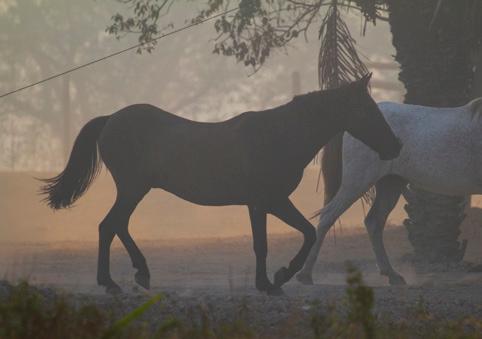
1 Morrison O (2021)
2 Clark MA et al (2020)
3 Fundación Amigos de la Naturaleza (2020) p7, Hermanson M (2019), Mega ER (2020)
4 Banks V (1991)
5 As of 27 October 2020 (the period covered by the analysis in this report), 28% of the biome had been consumed by fire; by 22 November 2020, 30% – 4.49 million ha – had burned. Source: LASA website ‘Burned area – Pantanal 2020’.
6 Estúdio CBN (2020), Vannoni CE (2020)
7 Estúdio CBN (2020), Fantástico (2020)
8 See Carvalho D (2020), Instituto Centro de Vida (2020) p1 and Ionova A (2020).
9 WCS Brazil website ‘Jaguar status’, citing Paula RC, Desbiez A & Cavalcanti SMC, eds (2011)
10 See eg Alho CJR, Camargo G & Fischer E (2011), IPBES (2018) pp223-225 and Tomas W et al (2011).
11 Based on data from Ministério da Agricultura, Pecuária e Abastecimento, Serviço Florestal Brasileiro (2020) p44. See below in text.
12 Greenpeace Brazil mapping analysis of CAR data shows rural properties cover 124,401 ha of the approximately 443,050 ha within recognised Indigenous lands in the Brazilian Pantanal – two territories are entirely covered.
13 Rural properties cover 256,398 ha of the 446,081 ha in public conservation units – principally one national and three state parks – within the Brazilian Pantanal, with two of the three state parks 80% covered and one almost entirely covered (source: Greenpeace Brazil mapping analysis of CAR
data). This figure excludes private reserves, which generally fall entirely within registered rural properties.
14 Seidl AF, de Silva JSV & Moraes AS (2001)
15 In this report, mentions of ‘Greenpeace’ should be read as references to Greenpeace International unless otherwise indicated.
16 2018–2019 supply chain links between ranchers and meat processing facilities and other analyses were established through Greenpeace investigations, based on the integration of a number of sources of public data and information including:
Land cover and land cover change
The locations of fire hotspots and burned areas (burn scar)
The location and boundaries of the Pantanal biome, Indigenous lands, conservation units and other public lands
The locations, boundaries, ownership and CAR registration status of cattle ranches
Environmental sanctions linked to ranches and their owners
Meat processor traceability website
Trade from processing facilities to the global market and/or consumer goods and fast food companies
Documentation is held by Greenpeace. The sources used for each of these types of data and information are listed in the references section at the end of the report.
Greenpeace provided the meat processors named in this report with the opportunity to comment prior to publication on the historic trade links it had established between ranchers with operations in the Pantanal and specific slaughterhouses, as well as any legal/policy irregularities (eg embargoes, irregular CAR status) it had identified in those ranchers’ operations. The comments have been reflected
at all relevant points. The full text of the replies received from each of the meat processors in response to Greenpeace’s opportunity to comment letters can be found in Annex 2.
17 The total area of Singapore is 71,900 ha (CIA World Factbook website ‘Country comparisons – area’). The Greater London area covers approximately 159,500 ha (LG Inform website ‘Size of the geographical area – Extent of the realm measurements in hectares in England’).
18 Sources include Greenpeace Brazil field investigations conducted in October 2020 and February 2021, Nestlé (2019) p5 and Panjiva Brazil trade data https://panjiva.com/data/brazil-tradedata; see also Fregatto E (2018) and JBS (2020a) p129.
19 Panjiva Brazil trade data https://panjiva. com/data/brazil-trade-data
20 JBS (2020b) p14, Marfrig (2020) p8 and Minerva (2020) p1. See also Chain Reaction Research (2020a) pp2-4.
21 Reuters (2021); the reported results were in line with end-of-year projections from the Brazilian Beef Exporters Association (ABIEC (2020)).
22 Net revenue from Marfrig’s North American operations totalled R$35.1 billion in 2019; revenue from the company’s South American operations totalled R$14.8 billion. See Marfrig (2020) pp6,8.
23 JBS (2020e) p2
24 JBS (2020a) pp16,20-21
25 JBS’s Friboi brand supplies big names including Bob’s, Burger King, McDonald’s, and Pão de Açúcar (JBS (2020a) p129). Its Seara subsidiary has global accounts with Burger King, KFC, McDonald’s and Subway, among others, and holds certifications for customers including Costco, Mars, M&S, Nestlé, Walmart and YUM (JBS (2020a) pp196-198). JBS reportedly also supplies corned beef products to UK and European supermarkets including Asda, Carrefour, Lidl, and Sainsbury’s (see Earthsight (2019) and Holmes H (2020)). British subsidiary Moy Park (which JBS sold to another of its subsidiaries, Pilgrim’s Pride, in 2017; see Casey S & Freitas T (2017)) supplies Nando’s and several supermarkets, including Tesco Ireland and Lidl; see Nando’s website ‘FAQs: Our food’, Moy Park website ‘Moy Park chicken’ and Moy Park website ‘Awards’. Moy Park reportedly also supplies several other fast food chains, including KFC and Pizza Hut, and supermarkets such as Marks & Spencer and Sainsbury’s; see eg Belfast Telegraph (2018) and Mulligan J (2017).
26 Greenpeace (2009)
27 The G4 Agreement’s signatories pledged to exclude from their supply chains any ‘rural property which directly supplies cattle for slaughtering (fattening farms) and is engaged in deforestation in the Amazon biome’ within six months of signing the commitment. This condition was to be extended to all supplies, including third-party suppliers and supplies from rearing and nursery farms, within two years. See JBS-Friboi, Bertin, Minerva & Marfrig (2009) p1.
28 These ranchers and the companies they supplied were: Adevair de Oliveira – JBS / Marfrig / Minerva
Ário Barnabé Neto – JBS
Celso Miura – JBS
Daniel Martins Filho – JBS / Marfrig
Eduardo Mariani Bittencourt – JBS / Marfrig / Minerva
Eliana Maria Lemos Monteiro Conceição – JBS
Fabio de Oliveira Luchesi – Minerva
Francisca Evangelista Teodoro da Silva – JBS / Marfrig / Minerva
João Felix Pereira Neto – JBS / Marfrig
Jose Dalbem – JBS / Marfrig / Minerva
Luiz Carlos Ziliani – JBS / Marfrig / Minerva
Raul Amaral Campos – JBS / Marfrig / Minerva
Sergio Jacinto Costa – JBS
29 Greenpeace identified 37 supply chain links between the case study properties and the big three meat processors, plus a further three rancher-level links not involving the case study properties. Of these 37 links, 23 were indirect. Of those 23, 17 of the links were through ranches owned by the same individual.
30 Based on responses to Greenpeace’s opportunity to comment letters; see Annex 2.
Marfrig did not indicate current compliance. Also, JBS failed to comment on the current status of ranches linked to Celso Miura, Francisca Evangelista Teodoro da Silva or João Felix Pereira Neto, who were identified by Greenpeace as tier-one suppliers during the period studied.
The following ranchers all had at least one property that was described as either ‘compliant with [JBS’s] Responsible Procurement Policy’, ‘able to commercialize raw materials with [JBS]’ or ‘listed in Minerva’s database and … eligible for commercialization’: Adevair de Oliveira – JBS / Minerva
Ário Barnabé Neto – JBS
Daniel Martins Filho – JBS
Eduardo Mariani Bittencourt – Minerva
Eliana Maria Lemos Monteiro Conceição – JBS
Fabio de Oliveira Luchesi – Minerva
Francisca Evangelista Teodoro da Silva – Minerva
Jose Dalbem – JBS / Minerva
Luiz Carlos Ziliani – JBS
Raul Amaral Campos – Minerva
Sergio Jacinto Costa – JBS
31 Based on responses to Greenpeace’s opportunity to comment letters; see Annex 2. The current approved suppliers that appear to violate JBS’s policy are:
Adevair de Oliveira / Fazenda Boa Sorte
Luiz Carlos Ziliani / Fazenda Santa Tereza
Samoel Alexandroni Santos / Fazenda Sete de Setembro (Santos is an intermediary rancher identified in one of the case studies; this ranch’s property registration is currently suspended)
The historic trading relationship that appears to have been in violation of JBS’s policy at the time was with Raul Amaral Campos / Fazenda Esperança. JBS failed to confirm the current status of this ranch as a supplier.
Minerva drew different conclusions on the compliance of two of these suppliers (Luiz Carlos Ziliani / Fazenda Santa Tereza and Raul Amaral Campos / Fazenda Esperança).
32 The historic trading relationship that appears to have been in violation of Marfrig’s policy was with João Felix Pereira Neto / Fazenda Pederneiras Novas.
33 Morrison O (2021)
34 JBS (2019)
35 See ‘High-risk regimes – how the Bolsonaro government has fanned the flames’. See also eg Observatório do Clima (2021).
36 Marfrig’s latest zero deforestation commitment extends to the Cerrado, but not the Pantanal.
See Marfrig website ‘Marfrig Verde+’.
37 Ranchers (including intermediary ranchers) with identified environmental violations and/or property registration irregularities on one or more of their ranches during the 2018–2019 trade period assessed for this investigation include: Adevair de Oliveira (note, the CAR status of Fazenda Recreio is just one of the multiple issues associated with this rancher’s operations; it was recategorised as active as of 9 November 2020 but prior to that had been listed as pending since 4 August 2018)
Ário Barnabe Neto
Daniel Martins Filho (note, Filho received a US$930,000 fine from IBAMA for the illegal construction of levees along the river boundary of Fazenda Santa Cecília II) Fabio de Oliveira Luchesi (the CAR status of Fazenda Santa Helena I was recategorised as active only as of 17 November 2020; prior to that it was listed as pending)
Ivanildo da Cunha Miranda
João Felix Pereira Neto
Jose Dalbem
Luiz Carlos Ziliani
Raul Amaral Campos
38 See JBS-Friboi, Bertin, Minerva & Marfrig (2009).
39 As promised by the European Commission. See European Commission (2020) and European Parliament (2020).
40 As proposed by the UK Government. See Department for Environment, Food & Rural Affairs (2020).
41 Compared with 2012 levels. Source: Godfray HCJ et al (2018), reporting on Alexandratos N & Bruinsma J (2012).
42 See eg Business Insider India (2020), Feng E (2017), Khaitan R (2017) and Straits Times (2019).
43 Greenpeace (2020a)
44 JBS (2020a) p38
45 JBS (2020a) p16
46 JBS (2020c) p3
47 Between 2002 and 2013, BNDES released a total of R$12.8 billion (US$5.9 billion) for companies controlled by J&F Investimentos, according to the NGO Contas Abertas. Source: Tognolli C (2019). See also Wasley et al (2019).
48 JBS website ‘Ownership and corporate’
49 ExxonMobil, Shell and BP were responsible for 577, 508 and 448 MtCO2e Scope 1+3 GHG emissions in 2015, respectively (source: Carbon Majors Database (2017) p15).
In 2016, JBS’s Scope 1+3 GHG emissions from processing and production of beef, pork and chicken totalled 280 MtCO2e, with the vast majority being accounted for by beef production. Scope 1 emissions are direct emissions from company-owned facilities, processing plants and machinery. Scope 2 emissions are indirect emissions related to energy consumption. Scope 3 emissions include all other indirect emissions resulting from the production of a commodity, both upstream and downstream (farm emissions from livestock, food production for livestock, land-use change etc). For fossil fuel producers this includes all emissions related to the burning of the products they sell. Source: GRAIN & ITAP (2018).
50 Soya is the second most significant driver of global deforestation after beef, and about 90% of it is used for animal feed. See European Commission (2013) pp21-22, Henders S, Persson UM & Kastner T (2015) p6 and Sharma S, IATP & Schlesinger S (2017) p25.
51 Greenpeace (2009)
52 See JBS-Friboi, Bertin, Minerva & Marfrig (2009).
53 See reporting in Greenpeace (2009) and Greenpeace (2020a).
54 Bautzer T, Alves A & Mandl C (2020), Mano A (2020)
55 See eg Harris B (2020), Samora R (2020) and Wasley A & Heal A (2020).
56 JBS (2020c) pp3-4 and JBS (2020d)
57 Ministry of the Environment (2017) p65
58 Trase platform ‘Brazil – Beef’
59 Critical Ecosystem Partnership Fund (2017) pp147-148, Guerra A et al (2020)
60 IPCC (2019), Chapter 4
61 According to data from the Brazilian National Institute of Space Research (Instituto Nacional de Pesquisas Espaciais, INPE). See Spring J (2020b).
62 A federal moratorium was imposed on the use of burning for agricultural purposes in the Amazon and Pantanal in midJuly, extending for 120 days (see Carvalho D (2020) and Ionova A (2020)). Regional prohibitions on dry-season burning were also put in place in Mato Grosso, from 1 July to 30 September, and Mato Grosso do Sul, extending for 180 days from late July; see Instituto Centro de Vida (2020) p1 and Ionova A (2020).
63 The G4 Agreement promised ‘zero deforestation in the supply chain’. Its signatories pledged to exclude from their supply chains any ‘rural property which directly supplies cattle for slaughtering (fattening farms) and is engaged in deforestation in the Amazon biome’ within six months of signing the commitment. This condition was to be extended to all supplies, including third-party suppliers and supplies from rearing and nursery farms, within two years. See JBS-Friboi, Bertin, Minerva & Marfrig (2009) p1.
64 JBS (2020c) pp3-4 and JBS (2020d)
65 JBS (2020c) p3
66 With the exception of Areas of Permanent Protection (Áreas de Preservação Permanente, APPs) and restrictions on the exploitation of wetlands. APPs are areas that have been identified as critical to essential ecosystem functions, such as preserving hydrological resources or biodiversity, ensuring geological stability, facilitating the movement of fauna and flora and protecting the soil. The remaining 20% is classed as Legal Reserve. In areas classified as pantanal wetlands (pantanais) or flood plains (planicies pantaneiras) – which covers about 16% of the Brazilian Pantanal – permits for clearance may only be issued for activities deemed ‘sustainable and ecological’, which includes traditional cattle raising. Per Articles 3, 10 and 12 – the full text of the law is available at http://www.planalto.gov.br/ccivil_03/_ato20112014/2012/lei/l12651.htm. See also WWF-Brazil (2016) p18.
67 The area of the UK is 24.4 million ha. Source: CIA World Factbook website ‘Country comparisons – area’.
68 Soares-Filho B et al (2014)
69 Casey S & Freitas T (2017), Mello G & Mano A (2019), Pilgrim’s Pride Ltd website ‘Our story’
70 For details on Greenpeace’s vision ‘for a healthier life and planet’, see Greenpeace (2018).
71 Libonati R et al (2020)
72 Estimates of the size of the Pantanal vary widely, depending on the source cited. It is variously described as covering between 14 million ha (Keddy PA et al (2009) p43) and 22 million ha (Fundación Amigos de la Naturaleza (2020) p4).
73 Estimates of the percentages of the Pantanal located in each of these countries similarly vary; the largest portion (70–80% of the biome) is in Brazil and the smallest (5–10%) in Paraguay, with the remainder located in Bolivia. See eg Ecosystem Alliance (2014) p7 and New World Encyclopedia ‘Pantanal’.
74 Banks V (1991)
75 Couto EG & de Oliveira VA (2010) pp72-73
76 Bao F et al (2017)
77 IPBES (2018) p225
78 Scherer-Neto P, Guedes NMR & Toledo MCB (2019)
79 Alho CJR, Camargo G & Fischer E (2011)
80 WCS Brazil website ‘Jaguar status’, citing Paula RC, Desbiez A & Cavalcanti SMC, eds (2011)
81 Tomas W et al (2011)
82 The Parque Nacional del Pantanal Matogrossense (https://rsis. ramsar.org/ris/602), the SESC Pantanal Private Reserve of Natural Heritage (https://rsis.ramsar.org/fr/ris/1270) and the Taiamã Ecological Station (https://rsis.ramsar.org/ris/2363).
83 https://rsis.ramsar.org/ris/1089
84 UNESCO website ‘Pantanal Conservation Area’
85 Biomas_250mil.zip available under Downloads > vetores at IBGE website ‘Biomas’.
86 See Ministério do Meio Ambiente website ‘Pantanal’ and Ministério do Meio Ambiente (2019).
87 Greenpeace Brazil analysis based on maps of Indigenous land from FUNAI (http://www.funai.gov.br/arquivos/ conteudo/cggeo/pdf/terra_indigena.pdf) and Brazilian Pantanal biome maps from IBGE (https://www.ibge.gov.br/ geociencias/informacoes-ambientais/15842-biomas.html).
88 Banks V (1991)
89 BBC (2013)
90 Ecosystem Alliance (2014), Guerra A et al (2020)
91 Ionova A (2020)
92 Ecosystem Alliance (2014), Embrapa website ‘Impactos ambientais e socioeconômicos no Pantanal’, Ivory SJ et al (2019), Tomas W et al (2019) pp9-11
93 Ecosystem Alliance (2014) pp5,13-15,37-39
94 Bergier I et al (2018), Marengo JA, Alves LM & Torres RR (2015), Thielen D et al (2020)
95 Ministério da Agricultura, Pecuária e Abastecimento, Serviço Florestal Brasileiro (2020) p44. Article 29 of Brazil’s Forest Code (full text available at http://www. planalto.gov.br/ccivil_03/_ato2011-2014/2012/lei/l12651.htm) requires self-reported registration of all rural properties (including identification of property boundaries), with the aim of georeferencing all the properties and establishing a database to be used for for monitoring and enforcement of compliance with environmental regulations, environmental and economic planning, and to combat illegal deforestation. The original deadline for registration was May 2016, but this has been extended several times as not all property owners have complied. Additionally, the self-reported information is not legally verified, meaning that land claims may overlap with public, protected or Indigenous lands.
96 Klingler M & Mack P (2020)
97 Based on data from Ministério da Agricultura, Pecuária e Abastecimento, Serviço Florestal Brasileiro (2020) p44. See below in text.
98 Seidl AF, de Silva JSV & Moraes AS (2001)
99 Chain Reaction Research (2020b)
100 IBGE SIDRA website ‘Pesquisa da pecuária municipal: Tabela 3939 – Efetivo dos rebanhos, por tipo de rebanho’
101 The total area of the individual CAR registrations is about 13.9 million ha, but this includes 1.2 million ha of overlap.
102 Rural properties cover 256,398 ha of the 446,081 ha in public conservation units – principally one national and three state parks – within the Brazilian Pantanal, with two of the three state parks 80% covered and one almost entirely covered (source: Greenpeace Brazil mapping analysis of CAR data). This figure excludes private reserves, which generally fall entirely within registered rural properties.
103 Greenpeace Brazil mapping analysis of CAR data shows rural properties cover 124,401 ha of the approximately 443,050 ha within recognised Indigenous lands in the Brazilian Pantanal – two territories are entirely covered.
104 Laboratório de Processamento de Imagens e Geoprocessamento (Lapig) website ‘Lapig Maps’
105 JBS describes itself as ‘the worldwide leader in poultry and beef processing and the second largest in pork and lamb’. See JBS website ‘Our business’.
106 Defined by Article 3 of the code, the function of these areas is preserving hydrological resources or biodiversity, ensuring geological stability, facilitating the movement of fauna and flora or protecting the soil.
107 Some 2.34 million ha of the total land area of 15.1 million ha were cleared for pasture, out of 2.37 million ha cleared for all purposes. Source: MapBiomas Project ‘Collection 5.0 of the annual coverage and land use maps series of Brazil’.
108 MapBiomas ‘Pantanal: Land use and land cover annual evolution (1985-2019)’
109 MapBiomas Project ‘Collection 5.0 of the annual coverage and land use maps series of Brazil’
110 Embrapa website ‘Pecuária do Pantanal’
111 Einhorn C et al (2020)
112 WCS Brazil website ‘Jaguar status’
113 de Campos MM et al (2020)
114 Ecosystem Alliance (2014) p15
115 Ivory SJ et al (2019)
116 Instituto SOS Pantanal, WWF-Brasil & Embrapa Pantanal (2013) p7
117 Ministry of the Environment (2017) p65
118 Critical Ecosystem Partnership Fund (2017) pp5152, Gibbs HK et al (2015a), Spring J (2018)
119 Embrapa website ‘Impactos ambientais e socioeconômicos no Pantanal’, Ivory SJ et al (2019)
120 Embrapa website ‘Impactos ambientais e socioeconômicos no Pantanal’
121 Of the total land area of 21.76 million ha, 13.16 million ha (60.5%) were cleared, with 9.73 million ha of this (71%) for pasture and a further 2.48 million ha (19%) for agriculture. The natural vegetation of some 783,000 ha – a further 4% of the total land area – had been altered but not entirely converted by human activity. Source: Instituto SOS Pantanal & WWF-Brasil (2015) p54.
122 Ecosystem Alliance (2014) p5, European Commission (2016) p9
123 Statista website ‘Area planted with soybean in Brazil from crop year 2010/11 to 2019/20’
124 Ecosystem Alliance (2014) pp11-12
125 Schandert S (2020)
126 Ecosystem Alliance (2014) pp5,13-15,37-39
127 Embrapa website ‘Impactos ambientais e socioeconômicos no Pantanal’
128 Bergier I et al (2018)
129 Nobre AD (2014) pp12-19, Webb J (nd)
130 Batista F & Gilbert J (2020). See also Rocha J (2014).
131 Against the 1961–1990 baseline. See Marengo JA, Alves LM & Torres RR (2015).
132 Thielen D et al (2020)
133 Guerra A et al (2020) p7
134 See eg Fantástico (2020), Ionova A (2020) and Mega ER (2020).
135 Mega ER (2020), Kohagura TC (2020)
136 Mega ER (2020), Miettinen J et al (2015)
137 Fundación Amigos de la Naturaleza (2020) p7, Hermanson M (2019)
138 Mega ER (2020)
139 A widespread practice in the region – see eg Fantástico (2020).
140 Ionova A (2020)
141 Einhorn C et al (2020)
142 The federal ban covered the Amazon and the Pantanal; see Carvalho D (2020) and Ionova A (2020).
143 Instituto Centro de Vida (2020) p1
144 Ionova A (2020)
145 LASA website ‘Burned area – Pantanal 2020’; see also technical note dated 11/17/2020.
146 By 4 August, when just 768,000 ha had burned across the entire Pantanal, the area burned in Bolivia had reached 147,000 ha (19% of the total burned area) and that in Paraguay 86,000 ha (11% of the total burned area). Source: Fundación Amigos de la Naturaleza (2020) p5.
147 UOL (2020)
148 Einhorn C et al (2020)
149 Muniz B, Fonseca B & Ribeiro R (2020)
150 Estúdio CBN (2020), Vannoni CE (2020)
151 Ribeiro E (2020). Other causes identified reportedly included burning trees to acquire honey, an automobile accident, an accidental fire caused by agricultural equipment and sparks from high voltage electrical wiring.
152 Federal Police of Mato Grosso do Sul (2020)
153 Greenpeace (2020a)
154 Castro A (2020)
155 Instituto Centro de Vida (2020) pp7-9
156 Camargos D & Campos A (2020)
157 Data from LASA (available at LASA website ‘Burned area – Pantanal 2020’) and MapBiomas (MapBiomas Project ‘Collection 5.0 of
the annual coverage and land use maps series of Brazil’).
158 According to MapBiomas, as of 2019 roughly 36.7% of the Brazilian Pantanal was covered by grassland, 19.6% by forest, 15.7% by wetland, 15.4% by pasture, 9.2% by savannah, 3.1% by water and 0.2% by arable agriculture (see https://mapbiomas-br-site.s3.amazonaws. com/Infograficos/Colecao5/MBI-Infografico-pantanal-5.0-EN.jpg). Some 37.4% of the burn scar was located in areas classified as grassland, 32.8% in forest and savannah and 22.6% in wetland (much of which would have been severely dried out by the drought).
159 Estúdio CBN (2020), Ribeiro E (2020), Vannoni CE (2020)
160 Escravo, Nem Pensar! (2020)
161 Spring J (2020a)
162 See eg Fischer L (2020), Pfeifer H (2020).
163 INPE website ‘Monitoramento dos focos ativos por bioma’. Fire hotspots are thermal anomalies (ie unusually hot areas) detected by satellites. It is important to distinguish hotspots from actual fires – they could represent fires or they could be hot tin roofs, although the occurrence of false positives is relatively low. Within forest areas, accuracy depends on the size of the fire, the density of the canopy and proximity to built-up areas.
164 Shalders A (2020)
165 Since 2012, when incoming President Dilma Roussef imposed a hiring freeze on the agency, staffing levels have reportedly dropped from a peak of more than 1,300 to about 600. Source: Savarese M (2020).
166 Shalders A (2020)
167 Gonzales J (2020a). See also Savarese M (2020). The Chico Mendes Institute for Biodiversity Conservation (Instituto Chico Mendes de Conservação da Biodiversidade, ICMBio) is the branch of the Ministry of the Environment charged with managing Brazil’s federal conservation units and protecting its natural heritage and biodiversity. The National Indian Foundation (Fundação Nacional do Índio, FUNAI) is the federal agency responsible for establishing and carrying out policies relating to Indigenous Peoples.
168 Gonzales J (2020a)
169 Gonzales J (2020a), Savarese M (2020)
170 Muniz B, Fonseca B & Ribeiro R (2020)
171 Basso G (2020)
172 Raoni Rajão, coordinator of laboratory for the study of environmental services management at the Federal University of Minas Gerais, quoted in Goñi U, Cowie S & Costa W (2020).
173 Shalders A (2020)
174 Boadle A (2020), Soares I (2020)
175 Einhorn C et al (2020)
176 Fernandes A (2020), Machado R (2020)
177 See eg Fantástico (2020), Ionova A (2020) and Vannoni CE (2020).
178 Inesc (2020)
179 Observatório do Clima (2021)
180 Piloto Policial (2020)
181 European Commission website ‘EU-Mercosur trade agreement’
182 Kehoe L et al (2020)
183 Gonzales J (2020b), Greenpeace European Unit (2020)
184 According to a leaked copy of the negotiation text, published by Greenpeace Germany (see Greenpeace European Unit (2020)).
185 Angelo M (2020), Gerretsen I (2020)
186 See eg Greenpeace International (2009, 2020a).
187 Estúdio CBN (2020), Ribeiro E (2020), Vannoni CE (2020)
188 2018–2019 supply chain links between ranchers and meat processing facilities and other analyses were established through Greenpeace investigations, based on the integration of a number of sources of public data and information including:
Land cover and land cover change
The locations of fire hotspots and burned areas (burn scar)
The location and boundaries of the Pantanal biome, Indigenous lands, conservation units and other public lands
The locations, boundaries, ownership and CAR registration status of cattle ranches
Environmental sanctions linked to ranches and their owners
Meat processor traceability websites
Trade from processing facilities to the global market and/or consumer goods and fast food companies
Documentation is held by Greenpeace. The sources used for each of these types of data and information are listed in the references section at the end of the report.
Greenpeace provided the meat processors named in this report with the opportunity to comment prior to publication on the historic trade links it had established between
ranchers with operations in the Pantanal and specific slaughterhouses, as well as any legal/policy irregularities (eg embargoes, irregular CAR status) it had identified in those ranchers’ operations. The comments have been reflected at all relevant points. The full text of the replies received from each of the meat processors in response to Greenpeace’s opportunity to comment letters can be found in Annex 2.
189 See Carvalho D (2020), Instituto Centro de Vida (2020) p1 and Ionova A (2020).
190 The total area of Singapore is 71,900 ha (CIA World Factbook website ‘Country comparisons – area’). The Greater London area covers approximately 159,500 ha (LG Inform website ‘Size of the geographical area – Extent of the realm measurements in hectares in England’).
191 These ranchers and the companies they supplied were:
Adevair de Oliveira – JBS / Marfrig / Minerva
Ário Barnabé Neto – JBS
Celso Miura – JBS
Daniel Martins Filho – JBS / Marfrig
Eduardo Mariani Bittencourt – JBS / Marfrig / Minerva
Eliana Maria Lemos Monteiro Conceição – JBS
Fabio de Oliveira Luchesi – Minerva
Francisca Evangelista Teodoro da Silva – JBS / Marfrig / Minerva
João Felix Pereira Neto – JBS / Marfrig
Jose Dalbem – JBS / Marfrig / Minerva
Luiz Carlos Ziliani – JBS / Marfrig / Minerva
Raul Amaral Campos – JBS / Marfrig / Minerva
Sergio Jacinto Costa – JBS
192 Greenpeace identified 37 supply chain links between the case study properties and the big three meat processors, plus a further three rancher-level links not involving the case study properties. Of these 37 links, 23 were indirect. Of those 23, 17 of the links were through ranches owned by the same individual.
193 The full text of the replies received from each of the meat processors in response to Greenpeace’s opportunity to comment letters can be found in Annex 2.
194 Based on responses to Greenpeace’s opportunity to comment letters; see Annex 2. Marfrig did not indicate current compliance. Also, JBS failed to comment on the current status of ranches linked to Celso Miura, Francisca Evangelista Teodoro da Silva or João Felix Pereira Neto, identified by Greenpeace as tier-one suppliers during the period studied. The following ranchers all had at least one property that was described as either ‘compliant with [JBS’s] Responsible Procurement Policy’, ‘able to commercialize raw materials with [JBS]’ or ‘listed in Minerva’s database and … eligible for commercialization’:
Adevair de Oliveira – JBS / Minerva
Ário Barnabé Neto – JBS
Daniel Martins Filho – JBS
Eduardo Mariani Bittencourt – Minerva
Eliana Maria Lemos Monteiro Conceição – JBS
Fabio de Oliveira Luchesi – Minerva
Francisca Evangelista Teodoro da Silva – Minerva
Jose Dalbem – JBS / Minerva
Luiz Carlos Ziliani – JBS
Raul Amaral Campos - Minerva
Sergio Jacinto Costa – JBS
195 Based on responses to Greenpeace’s opportunity to comment letters; see Annex 2. The current approved suppliers that appear to violate JBS’s policy are:
Adevair de Oliveira / Fazenda Boa Sorte
Luiz Carlos Ziliani / Fazenda Santa Tereza
Samoel Alexandroni Santos / Fazenda Sete de Setembro (Santos is an intermediary rancher identified in one of the case studies; this ranch’s property registration is currently suspended)
The historic trading relationship that appears to have been in violation of JBS’s policy at the time was with Raul Amaral Campos / Fazenda Esperança. JBS failed to confirm the current status of this ranch as a supplier.
Minerva drew different conclusions on the status of two of these suppliers (Luiz Carlos Ziliani / Fazenda Santa Tereza and Raul Amaral Campos / Fazenda Esperança).
196 The historic trading relationship that appears to have been in violation of Marfrig’s policy was with João Felix Pereira Neto / Fazenda Pederneiras Novas.
197 Morrison O (2021)
198 JBS (2019)
199 See also eg Observatório do Clima (2021).
200 See Carvalho D (2020), Instituto Centro de Vida (2020) p1 and Ionova A (2020).
201 Ranchers (including intermediary ranchers) with identified environmental violations and/or property registration irregularities on one or more of their ranches during the trade period assessed for this investigation include:
Adevair de Oliveira (note, the CAR status of Fazenda Recreio is just one of the multiple issues associated with this rancher’s operations; it was recategorised as active as of 9 November 2020 but prior to that had been listed as pending since 4 August 2018)
Ário Barnabe Neto
Daniel Martins Filho (note, Filho received a US$930,000 fine from IBAMA for the illegal construction of levees along the river boundary of Fazenda Santa Cecília II) Fabio de Oliveira Luchesi (the CAR status of Fazenda Santa Helena I was recategorised as active only as of 17 November 2020; prior to that it was listed as pending)
Ivanildo da Cunha Miranda
João Felix Pereira Neto
Jose Dalbem Luiz Carlos Ziliani
Raul Amaral Campos
202 The full text of the replies received from each of the meat processors in response to Greenpeace’s opportunity to comment letters can be found in Annex 2.
203 See the case study below on Ivanildo da Cunha Miranda.
204 Marfrig’s latest zero deforestation commitment extends to the Cerrado, but not the Pantanal.
See Marfrig website ‘Marfrig Verde+’.
205 See JBS-Friboi, Bertin, Minerva & Marfrig (2009).
206 As promised by the European Commission.
See European Parliament (2020).
207 As proposed by the UK Government. See Department for Environment, Food & Rural Affairs (2020).
208 Gibbs HK et al (2015b) p39
209 Gibbs HK et al (2015b)
210 Email from Dr. Holly Gibbs, Associate Professor at University of Wisconsin–Madison, to Amnesty International, 29 June 2020. Copy on file with Amnesty International. Cited by Amnesty International (2020) p13.
211 JBS website ‘JBS Green Platform’
212 See eg Visipec website ‘Home’.
213 See Marfrig (2021b) and Minerva (2021)
214 Visipec (nd) p2
215 The Brazilian Federal Inspection Service (Serviço de Inspeção Federal, SIF), organised by the Ministry of Agriculture, Livestock and Food Supply and overseen by the Department of Inspection of Animal Origin Products (Departamento de Inspeção de Produtos de Origem Animal, DIPOA), is responsible for ‘ensuring the quality of edible and inedible animal products intended for the domestic and foreign markets and the suitability of imported products’ (Federal Government of Brazil (2017)). The system operates in approximately 5,000 establishments across the country, each identified by a SIF number. The seal on a facility’s products is meant to indicate that they are of safe animal origin and meet the criteria required by legislation; it also enables traceability of those products back to the facility where they originated. SIF-registered facilities are able to trade throughout the country (unlike those registered with the state or municipal inspection services, which can trade only locally) and, if they meet additional criteria, export abroad. See eg Alves G (2020).
216 Ministério da Agricultura, Pecuária e Abastecimento website ‘Consulta de estabelecimento nacional: Dados do estabelecimento nacional’; details can be found by searching for the SIF number.
217 Ministério da Agricultura, Pecuária e Abastecimento website ‘Consulta de estabelecimento nacional: Dados do estabelecimento nacional’; details can be found by searching for the SIF number.
218 Greenpeace Brazil and Repórter Brasil field investigations, October 2020
219 JBS (2021b)
220 Fantástico (2020), Miranda E (2020)
221 IBAMA lists two outstanding embargoes for clearance of native vegetation in Legal Reserves against properties owned by Ivanildo da Cunho Miranda, and he was fined over R$900,000 (US$420,000) by IBAMA in 2013. Source: IBAMA website ‘Consulta de autuações ambientais e embargos’;
details can be found by searching for his name.
222 JBS (2020a) p129
223 See eg Fregatto E (2018).
224 Greenpeace Brazil and Repórter Brasil field investigations, October 2020
225 Mendes L (2020)
226 Greenpeace Brazil and Repórter Brazil field investigations, October 2020.
227 Panjiva Brazil trade data https://panjiva. com/data/brazil-trade-data
228 Panjiva Brazil trade data https://panjiva. com/data/brazil-trade-data
229 Panjiva Brazil trade data show that GST accounted for 2,323 tonnes of the 2,359 tonnes of leather exported to Mexico from JBS’s Campo Grande facilities during this period, and all 408 tonnes exported to the USA.
230 GST AutoLeather website ‘OEM customers’
231 JBS Campo Grande (see main text), Marfrig Bataguassu and Minerva Mirassol d’Oeste. Between 1 January 2019 and 31 October 2020 the Marfrig facility exported 168 tonnes of leather, all of it to Italy; the Minerva facility exported a total of 2,822 tonnes to China (82%), Italy (15%), Russia (2%) and India (1%).
232 Panjiva Brazil trade data https://panjiva. com/data/brazil-trade-data
233 JBS (2020b) p14
234 Marfrig (2020) p8
235 Minerva (2020) p1
236 Reuters (2021); the reported results were in line with end-of-year projections from the Brazilian Beef Exporters Association (ABIEC (2020)).
237 Net revenue from Marfrig’s North American operations totalled R$35.1 billion in 2019; revenue from the company’s South American operations totalled R$14.8 billion. See Marfrig (2020) pp6,8.
238 JBS (2020c) p2
239 Minerva (2019). The deal included Marfrig paying R$100 million (US$27 million) to BRF, which has an investor agreement with Minerva covering several operations and which previously controlled the facility in Várzea Grande; see BRF S.A. (2020) p44.
240 Mato Grosso Econômico (2019)
241 Receita Federal website ‘Emissão de comprovante de inscrição e de situação cadastral’; details can be found by searching for the CNPJ 67620377008018.
242 Ownership and sizes of properties were established based on data from official sources (CAR website ‘Consultar demonstrativo do CAR’, IBAMA website ‘Consulta de autuações ambientais e embargos’, Secretário de Estado de Meio Ambiente de Mato Grosso website ‘SIMCAR portal público’ and Secretaria Estadual de Meio Ambiente, Desenvolvimento Econômico, Produção e Agricultura Familiar (SEMAGRO) Portal de Informações e Geoposicionamento de Mato Grosso do Sul (PIN MS) website ‘Mapa consulta SICAR’).
Fazenda Bonsucesso is listed on the Mato Grosso do Sul SICAR website as belonging to the estate of Florêncio da Costa Lima, with Mauri da Costa Lima acting as appointed legal representative – results found using the CAR number MS-5003207-0EFCFC9C1C8949E4 BAB3A867AF21257A as the property code (‘código do imóvel’). Mato Grosso do Sul state tax registration (Inscrição Estadual, IE) documents show Fazenda Bom Sucesso, a cattle breeding business with an active CAR registration, as registered to Ivanildo da Cunha Miranda (source: Secretaria de Estado de Fazenda de Mato Grosso do Sul website ‘Consulta Pública do Cadastro Fiscal e Emissão do Comprovante de Inscrição Estadual’, IE number 287096750); the business is described as being located on the edge of the São Lourenço river in Corumbá, which matches the location of Fazenda Bonsucesso. News reports (eg Fantástico (2020), Ribeiro Jr A (2020)) refer to ‘Fazenda Bonsucesso’ as one of the sites being investigated by police for possible improper use of fire to clear pasture, with Ivanildo da Cunha Miranda named as the cattle rancher who owns the property. It is assumed the two names refer to the same ranch and that Ivanildo da Cunha Miranda owns, leases or otherwise controls management of that ranch.
243 See Ministério Público Federal, Procuradoria da República no Estado de Mato Grosso do Sul (2018), Miranda E (2020) and UOL (2020).
244 USD equivalents given in this report are approximate amounts, based on the average exchange rates in the years during which the fines were imposed.
245 IBAMA website ‘Consulta de autuações ambientais e embargos’; details can be found by searching for his name.
246 Fantástico (2020), Ribeiro Jr A (2020)
247 Fantástico (2020)
248 Data from USGS EarthExplorer (https://earthexplorer.usgs.
gov/), Sentinel Hub EO Browser (https://apps.sentinel-hub. com/eo-browser/) and Planet (https://www.planet.com/).
249 Carvalho D (2020). Regional prohibitions on dry-season burning were also in place in Mato Grosso, from 1 July to 30 September 2020, and Mato Grosso do Sul, extending for 180 days from late July. See Instituto Centro de Vida (2020) p1 and Ionova A (2020).
250 Burn scar analysis by Greenpeace based on data from LASA (27 October 2020) and MapBiomas (MapBiomas Project ‘Collection 5.0 of the annual coverage and land use maps series of Brazil’).
251 Fire hotspot data is from INPE (data from MODIS AQUA_M-T, downloaded from INPE website ‘Banco de dados de queimadas’).
252 Documentation held by Greenpeace.
253 IE 287109038. Source: Ministério da Agricultura, Pecuária e Abastecimento, SDA, CSR (nd) p51, accessed 10 February 2021.
254 Friboi website ‘Garantia de origem’
255 Friboi website ‘Garantia de origem’
256 JBS (2021a)
257 The Mato Grosso state registry lists the size of the property as 10,330 ha (see Secretário de Estado de Meio Ambiente de Mato Grosso website ‘SIMCAR portal público’, CAR number MT70390/2018). For consistency, all figures reported in the text are from the federal registry (CAR website ‘Consultar demonstrativo do CAR’).
258 IBAMA website ‘Consulta de autuações ambientais e embargos’; details can be found by searching for his name.
259 Companhia de Investimentos do Centro Oeste (2020)
260 Documentation held by Greenpeace
261 CAR website ‘Consultar demonstrativo do CAR’, accessed 5 February 2021; details can be found by searching for the CAR number MT-5100201-66E4479246EF4AFD90BE43DC92266B32.
262 Secretário de Estado de Meio Ambiente de Mato Grosso website ‘SIMCAR portal público’, accessed 5 February 2021; details can be found by searching for the CAR number MT89179/2017.
263 Friboi website ‘Garantia de origem’
264 Friboi website ‘Garantia de origem’
265 Secretário de Estado de Meio Ambiente de Mato Grosso website ‘SIMCAR portal público’, accessed 5 February 2021; details can be found by searching for the CAR number MT69899/2017.
266 CAR website ‘Consultar demonstrativo do CAR’, accessed 5 February 2021; details can be found by searching for the CAR number MT-5102504-4A4408CD2A7D4345B3206B169E5B01AF.
267 Link to João Felix Pereira Neto confirmed by IE number 132970899. Source: Marfrig website ‘Conheça a origem da nossa carne’.
268 JBS (2021a)
269 Marfrig (2021a)
270 Fazenda Olhos d’Água. See Secretário de Estado de Meio Ambiente de Mato Grosso (2020).
271 CAR website ‘Consultar demonstrativo do CAR’, accessed 5 February 2021; details can be found by searching for the CAR number MT-5102504-89CAE072B3EE459E8856CB4BB71C29E1.
272 CAR website ‘Consultar demonstrativo do CAR’
273 Secretário de Estado de Meio Ambiente de Mato Grosso website ‘SIMCAR portal público’, accessed 5 February 2021; details can be found by searching for the CAR number MT76021/2017. A previous check on 25 November 2020 showed the registration as active as of 9 November 2020 based on submission of maps in April 2020.
274 Documentation held by Greenpeace.
275 IE 132310538. Source: Ministério da Agricultura, Pecuária e Abastecimento, SDA, CSR (nd) p85, accessed 10 February 2021.
276 Friboi website ‘Garantia de origem’
277 Secretário de Estado de Meio Ambiente de Mato Grosso website ‘SIMCAR portal público’, accessed 5 February 2021; details can be found by searching for the CAR number MT101053/2017. A previous check on 25 November 2020 had shown the status as suspended as of 29 October 2020 (see Figure 3.2).
278 CAR website ‘Consultar demonstrativo do CAR’, accessed 5 February 2021; details can be found by searching for the CAR number MT-5102504-F298E64294C849C5BAC41806C76318ED.
279 Link to Adevair de Oliveira confirmed by IE number 132712962. Source: Marfrig website ‘Conheça a origem da nossa carne’.
280 Link to Adevair de Oliveira confirmed by IE number 132712962. Source: Marfrig website ‘Conheça a origem da nossa carne’.
281 Link to Adevair de Oliveira confirmed by IE number 132712962. Source: Marfrig website ‘Conheça a origem da nossa carne’.
282 JBS (2021a)
283 Marfrig (2021a)
284 Minerva (2021)
285 IBAMA website ‘Consulta de autuações ambientais e
embargos’; details can be found by searching for ‘Autuações Ambientais’ in his name during this year.
286 IBAMA data embedded in shapefiles from https://siscom.ibama. gov.br, Dados Geoespaciais > Camadas > Autos de Infração.
287 The embargoes are against Agropecuária Itapajé, process number 404633/2018. Source: Secretário de Estado de Meio Ambiente de Mato Grosso (2020).
288 Documentation held by Greenpeace.
289 The company’s partners are Raul Amaral Campos Filho, Dora Nougues Amaral Campos, Paula Nougas Amaral Campos Pacheco, Raul Amaral Campos, Helena Nougues Amaral Campos Perozzo and Roberta Amaral Campos. Source: Receita Federal website ‘Emissão de comprovante de inscrição e de situação cadastral’ (details can be found by searching for the CNPJ 25309068000188).
290 IE 132212579. Other listed ranches linked to Raul Amaral Campos are Fazenda Furninha (IE 132212560), Fazenda Gaivota (IE 132217490) and Fazenda Santa Terezinha (IE 132212560). Source: Ministério da Agricultura, Pecuária e Abastecimento, SDA, CSR (nd) pp75,80,82,85, accessed 10 February 2021.
291 Friboi website ‘Garantia de origem’
292 Friboi website ‘Garantia de origem’
293 Link to Raul Amaral Campos confirmed by IE number 132212579. Sources: Marfrig website ‘Conheça a origem da nossa carne’ and Ministério da Agricultura, Pecuária e Abastecimento, SDA, CSR (nd) p88 accessed 10 February 2021.
294 Link to Raul Amaral Campos confirmed by IE number 132212579. Sources: Marfrig website ‘Conheça a origem da nossa carne’ and Ministério da Agricultura, Pecuária e Abastecimento, SDA, CSR (nd) accessed 10 February 2021.
295 JBS (2021a)
296 Marfrig (2021a)
297 Minerva (2021)
298 See Ministério da Agricultura, Pecuária e Abastecimento, SDA, CSR (nd) p88, accessed 10 February 2021.
299 IBAMA website ‘Consulta de autuações ambientais e embargos’; details can be found by searching for ‘Autuações Ambientais’ in his name during this year.
300 IBAMA data embedded in shapefiles from https://siscom.ibama. gov.br, Dados Geoespaciais > Camadas > Autos de Infração.
301 Process number 275702/2020. Source: Secretário de Estado de Meio Ambiente de Mato Grosso (2020).
302 BDO RCS Auditores Independentes (2020) p3
303 Documentation held by Greenpeace.
304 IE 132896613. Source: Ministério da Agricultura, Pecuária e Abastecimento, SDA, CSR (nd) p69, accessed 10 February 2021.
305 Friboi website ‘Garantia de origem’
306 Friboi website ‘Garantia de origem’
307 Link to Jose Dalbem confirmed by IE number 132896613. Source: Marfrig website ‘Conheça a origem da nossa carne’.
308 Link to Jose Dalbem confirmed by IE number 132896613. Source: Marfrig website ‘Conheça a origem da nossa carne’.
309 Link to Jose Dalbem confirmed by IE number 132896613. Source: Marfrig website ‘Conheça a origem da nossa carne’.
310 Link to Jose Dalbem confirmed by IE number 132896613. Source: Marfrig website ‘Conheça a origem da nossa carne’.
311 JBS (2021a)
312 Marfrig (2021b)
313 Marfrig (2021a)
314 Minerva (2021)
315 IBAMA website ‘Consulta de autuações ambientais e embargos’; details can be found by searching for his name.
316 IBAMA website ‘Consulta de autuações ambientais e embargos’; details can be found by searching for ‘Autuações Ambientais’ in his name during the years 2014 and 2018.
317 Between 12 September 2018 and 23 July 2019, or soon after, Ário Barnabe Neto made multiple shipments of cattle from Fazenda Rio Vermelho to Fazenda Aldeia de Itaúna (also owned by him). On 23 October 2018, Ário Barnabe Neto made two shipments of a total of 242 cattle from Fazenda Rio Vermelho to Fazenda Mata Alta. Subsequent trade to JBS slaughterhouses has not been identified.
318 Documentation held by Greenpeace.
319 Friboi website ‘Garantia de origem’
320 Friboi website ‘Garantia de origem’
321 JBS (2021a)
322 CAR website ‘Consultar demonstrativo do CAR’, accessed 5 February 2021; details can be found by searching for the CAR number MT-5106828-C488DC83E51B4436B221ACFBB0586505. A previous
check on 25 November 2020 showed a status of ‘pending’.
323 CAR website ‘Consultar demonstrativo do CAR’, accessed 5 February 2021; details can be found by searching for the CAR number MT-5106828-1399E75AAB194358864B9DE2039B6582. A previous check on 25 November 2020 showed a status of ‘pending’.
324 Secretário de Estado de Meio Ambiente de Mato Grosso website ‘SIMCAR portal público’, accessed 25 November 2020 and 5 February 2021; details can be found by searching for the CAR numbers MT26773/2017 and MT53750/2018.
325 Documentation held by Greenpeace.
326 Friboi website ‘Garantia de origem’
327 Link to Luiz Carlos Ziliani confirmed by IE number 132600692. Source: Marfrig website ‘Conheça a origem da nossa carne’.
328 Link to Luiz Carlos Ziliani confirmed by IE number 132600692. Source: Marfrig website ‘Conheça a origem da nossa carne’.
329 JBS (2021a)
330 Marfrig (2021a)
331 Minerva (2021)
332 IBAMA website ‘Consulta de autuações ambientais e embargos’; details can be found by searching for ‘Autuações Ambientais’ in his name within this date range.
333 IBAMA data embedded in shapefiles from https://siscom.ibama. gov.br, Dados Geoespaciais > Camadas > Autos de Infração.
334 Documentation held by Greenpeace.
335 Friboi website ‘Garantia de origem’
336 Link to Daniel Martins Filho confirmed by IE number 287715132 Source: Marfrig website ‘Conheça a origem da nossa carne’.
337 JBS (2021a)
338 Marfrig (2021a)
339 Listed as Fazenda São Carlos e Santa Monica on the Secretário de Estado de Meio Ambiente de Mato Grosso website ‘SIMCAR portal público’; other official documents held by Greenpeace refer to São Carlos only, but the associated property boundaries are the same.
340 Secretário de Estado de Meio Ambiente de Mato Grosso website ‘SIMCAR portal público’, accessed 5 February 2021; details can be found by searching for the CAR number MT37206/2019.
341 CAR website ‘Consultar demonstrativo do CAR’, accessed 5 February 2021; details can be found by searching for the CAR number MT-5102504-6295DE76EB4D439C94DB3662F0A8CB6E.
342 IBAMA website ‘Consulta de autuações ambientais e embargos’; details can be found by searching for ‘Autuações Ambientais’ in the name of Raymundo Victor Costa Ramos Sharp within this date range.
343 Documentation held by Greenpeace.
344 IE 132548666. Source: Ministério da Agricultura, Pecuária e Abastecimento, SDA, CSR (nd) p51, accessed 10 February 2021.
345 Friboi website ‘Garantia de origem’
346 JBS (2021a)
347 Minerva (2021)
348 Documentation held by Greenpeace.
349 See Jusbrasil website ‘Processo nº 0000352-19.2012.8.11.0013’.
350 Link to Francisca Evangelista Teodoro da Silva confirmed by IE number 134544412. Source: Marfrig website ‘Conheça a origem da nossa carne’.
351 Marfrig (2021a)
352 Minerva (2021)
353 Receita Federal website ‘Emissão de comprovante de inscrição e de situação cadastral’; details can be found by searching for the CNPJ 16.489.312/0001-40.
354 Documentation held by Greenpeace.
355 Friboi website ‘Garantia de origem’
356 Friboi website ‘Garantia de origem’
357 Link to Eduardo Mariani Bittencourt confirmed by IE number 133298264. Source: Marfrig website ‘Conheça a origem da nossa carne’.
358 Link to Eduardo Mariani Bittencourt confirmed by IE number 133298264. Source: Marfrig website ‘Conheça a origem da nossa carne’.
359 JBS (2021a)
360 Marfrig (2021a)
361 Minerva (2021)
362 IE 287458490. Source: Ministério da Agricultura, Pecuária e Abastecimento, SDA, CSR (nd) p48, accessed 10 February 2021.
363 Documentation held by Greenpeace.
364 Friboi website ‘Garantia de origem’
365 Friboi website ‘Garantia de origem’
366 Friboi website ‘Garantia de origem’
367 JBS (2021a)
368 Documentation held by Greenpeace
369 Friboi website ‘Garantia de origem’
370 IE 132877287. The other ranch is Fazenda Totora (IE 132877287). Source: Ministério da Agricultura, Pecuária e Abastecimento, SDA, CSR (nd) p69, accessed 10 February 2021.
371 Friboi website ‘Garantia de origem’
372 There are two listings for Fazenda Lagoa Verde on this date. Link to Paulo Cezar Pinto de Arruda and business partners confirmed by IE numbers 132877287 and 134072030. Sources: Marfrig website ‘Conheça a origem da nossa carne’ and Ministério da Agricultura, Pecuária e Abastecimento, SDA, CSR (nd) p69 accessed 10 February 2021.
373 JBS (2021a)
374 Marfrig (2021a)
375 Minerva (2021)
376 CAR website ‘Consultar demonstrativo do CAR’; details can be found by searching for the CAR number MT5102504-70F370ADCE1F4298A8512C7106CCA57D.
377 Secretário de Estado de Meio Ambiente de Mato Grosso website ‘SIMCAR portal público’; details can be found by searching for the CAR number MT102985/2019.
378 Documentation held by Greenpeace.
379 Minerva (2021)
380 Documentation held by Greenpeace.
381 Friboi website ‘Garantia de origem’
382 Friboi website ‘Garantia de origem’
383 JBS (2021a)
384 Camargos D & Campos A (2020)
385 Instituto Centro de Vida (2020) pp7-9
386 Camargos D & Campos A (2020)
387 Camargos D & Campos A (2020). The burned areas associated with each ignition point were determined by ICV based on analysis of hotspot data from INPE, satellite imagery from the Sentinel-2 and Planet satellites and mapping by NASA; see Instituto Centro de Vida (2020) pp2,7.
388 Camargos D & Campos A (2020)
389 Campos A & Barros CJ (2020)
390 IPBES (2020)
391 IPBES (2020)
392 For more information, see EcoHealth Alliance (2019), IPBES (2020), United Nations Environment Programme & International Livestock Research Institute (2020) and World Health Organization website ‘Zoonoses’.
393 Clark MA et al (2020). See also United Nations Climate Change website ‘The Paris Agreement’.
394 Clark MA et al (2020)
395 Amigo I (2020)
396 Nobre CA et al (2016)
397 Gilbert J (2018), Phillips D (2020), Sax S & Angelo M (2020), UNDP Green Commodities Programme (2020)
398 Lovejoy TE & Nobre C (2019), Webb J (nd)
399 Calma J (2019)
400 Kimbrough L (2020), Reuters (2020)
401 Chain Reaction Research (2020c)
402 Goñi U, Cowie S & Costa W (2020)
403 Shalders A (2020), Voiland A (2020), World Land Trust (2020)
404 Hiba J (2020)
405 Gonzalez J (2020a), Savarese M (2020), Shalders A (2020)
406 Swiss Re (2020) pp3,7,24-27
407 Rajão R et al (2020)
408 Clark MA et al (2020)
409 Askew K (2020)
410 Due to its links to deforestation and habitat degradation, industrial meat production contributes to the increased risk of zoonoses – diseases such as Covid-19 that are originally found in non-human animals but jump the species barrier and begin to infect humans. For more information, see EcoHealth Alliance (2019), IPBES (2020), United Nations Environment Programme & International Livestock Research Institute (2020) and World Health Organization website ‘Zoonoses’.
411 Soya is the second most significant driver of global deforestation after beef, and about 90% of it is used for animal feed. See European Commission (2013) pp21-22, Henders S, Persson UM & Kastner T (2015) p6 and Sharma S, IATP & Schlesinger
S (2017) p25. For more on this topic, see eg Greenpeace (2020b).
412 Casey S & Freitas T (2017), Mello G & Mano A (2019), Pilgrim’s Pride Ltd website ‘Our story’
413 For details on Greenpeace’s vision ‘for a healthier life and planet’, see Greenpeace (2018).
414 For details on classification in the Pantanal biome see MapBiomas (2020).
415 INPE website ‘Banco de dados de queimadas’
416 See ‘Getting started > What is the detection confidence?’ at Earthdata website ‘FIRMS FAQ’ for a discussion of confidence values. For MODIS these range from 0% to 100%. For different applications – or indeed different regions – different ranges (so-called ‘fire classes’) may be more appropriate. The higher the setting the fewer the specific false alarms, but the more true fires are missed.
417 IPAM Amazônia (2020)
418 See the FAQ available via LASA website ‘Burned area –Pantanal 2020’.
419 See eg Jordan L & Athayde AT (2020) and Ministério da Justiça e Segurança Pública/Fundação Nacional do Índio (2020).
420 Klingler M & Mack P (2020)
421 Soares-Filho B et al (2014)
422 See JBS-Friboi, Bertin, Minerva & Marfrig (2009).
423 Friboi website ‘Garantia de origem’
424 Evidence held by Greenpeace Brazil.
425 Several attempts to access traceability information on the Minerva website over the course of this investigation were unsuccessful. A calendar page meant to identify the ranch origins for cattle supplied on a given day (Minerva website ‘Originação Pará’) was available until early January, but contained no information for any month consulted; it currently returns a ‘no results found’ error page. Attempts to access the company’s traceability tool consistently result in a server error (see Minerva website ‘Rastreabilidade’, last accessed 2 March 2021).
426 See Trase website ‘Home’.
427 Eg JBS (2020a).
428 Panjiva website ‘Manifest confidentiality – Opt-out’
REFERENCES
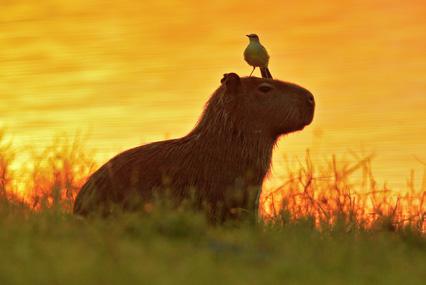
ABIEC (2020) ‘Beef exports should conclude 2020 with new records in volume and turnover’ 22 December 2020 http:// abiec.com.br/en/beef-exports-should-conclude-2020with-new-records-in-volume-and-turnover/
Alexandratos N & Bruinsma J (2012)) ‘World agriculture towards 2030/2050: The 2012 revision’ ESA Working Paper No 12-03, Food and Agriculture Organization of the United Nations http://www.fao.org/3/a-ap106e.pdf
Alho CJR, Camargo G & Fischer E (2011) ‘Terrestrial and aquatic mammals of the Pantanal’ Brazilian Journal of Biology 71(1): 297–310 https://doi.org/10.1590/S1519-69842011000200009
Alves G (2020) ‘Selos de inspeção no Brasil’ 24 June 2020 S2G https://s2gestao.com.br/selos-de-inspecao-no-brasil/ Amigo I (2020) ‘When will the Amazon hit a tipping point?’ 25 February 2020 Nature https://www.nature.com/articles/d41586-020-00508-4 Amnesty International (2020) ‘From forest to farmland: Cattle illegally grazed in Brazil’s Amazon found in JBS’s supply chain’ https://www.amnesty.org/en/documents/AMR19/2657/2020/en/ Angelo M (2020) ‘Brazil’s updated climate plan seen lacking credibility as forests shrink’ 10 December 2020 Reuters https://www.reuters.com/article/brazil-climate-change/brazils-updated-climate-plan-seen-lacking-credibility-as-forests-shrink-idUSL8N2IQ33M
ASCEMA Nacional (2020) ‘Chronology of an announced disaster: Actions of the Bolsonaro Government to dismantle environmental policies in Brazil’ http://www.ascemanacional.org. br/wp-content/uploads/2020/09/Dossie_Meio-Ambiente_Governo-Bolsonaro_Ingle%CC%82s_04-set-2020-1.pdf
Askew K (2020) ‘Is Nestlé and McDonald’s climate ambition “undermined” by “plodding” meat and dairy suppliers?’ 12 November 2020 Food Navigator https://www.foodnavigator.com/ Article/2020/11/12/Is-Nestle-and-McDonald-s-climate-ambition-undermined-by-plodding-meat-and-dairy-suppliers
Banks V (1991) The Pantanal: Brazil’s forgotten wilderness (San Francisco: Sierra Club Books)
Bao F et al (2017) ‘Plant species diversity in a Neotropical wetland: patterns of similarity, effects of distance, and altitude’ Anais da Academia Brasileira de Ciências 90(1):
85-97 https://doi.org/10.1590/0001-3765201720150370
Basso G (2020) ‘Em um ano, governo Bolsonaro corta verba para brigadistas em 58%’ 12 September 2020 Deutsch Welle https://www.dw.com/pt-br/em-um-ano-governo-bolsonaro-corta-verba-para-brigadistas-em-58/a-54895957
Batista F & Gilbert J (2020) ‘Not just the Amazon rain forest, other one-of-a-kind ecosystems are burning down too’ 29 August 2020
ThePrint https://theprint.in/world/not-just-the-amazon-rain-forest-other-one-of-a-kind-ecosystems-are-burning-down-too/491571/
Bautzer T, Alves A & Mandl C (2020) ‘Brazil meatpacker JBS plans U.S. listing as BNDES sells stake - sources’ 5 March 2020 Reuters https://fr.reuters.com/article/us-jbs-newissues-bndes-idUKKBN20S2A8
BBC (2013) ‘Pantanal: Liquid heart of South America’ https://www. bbc.com/future/article/20130312-liquid-heart-of-south-america
BDO RCS Auditores Independentes (2020) ‘MINERVA S.A.: Third-party audit report to meet “undertaking to adopt minimum criteria for industrial-scale operations with cattle and beef products in the Amazon Biome”’ https://minervafoods.com/ files/relatorio_publico_greenpeace_minerva_vf_ingles.pdf
Belfast Telegraph (2018) ‘Poultry giant reaches milestone of producing six million birds a week’ 1 June 2018 https://www. belfasttelegraph.co.uk/business/agri/poultry-giant-reachesmilestone-of-producing-six-million-birds-a-week-36966310.html
Bergier I et al (2018) ‘Amazon rainforest modulation of water security in the Pantanal wetland’ Science of The Total Environment 619–620: 1116–1125 https://doi.org/10.1016/j.scitotenv.2017.11.163
Boadle A (2020) ‘Brazil’s Bolsonaro blames indigenous people for Amazon fires in U.N. speech’ 23 September 2020 Reuters https://in.reuters.com/article/un-assembly-brazil/brazils-bolsonaro-blames-indigenous-people-for-amazon-fires-in-u-n-speech-idINKCN26E0AM
Brant D & Machado R (2020) ‘Apesar de incêndios, governo corta orçamento do Ibama e ICMBio em 2021’ 13 September 2020 Folha de S.Paulo https://www1.folha.uol.com.br/ambiente/2020/09/apesar-de-incendios-governo-corta-orcamento-do-ibama-e-icmbio-em-2021.shtml BRF S.A. (2020) ‘Form F-20 - 2019’ https://www.sec.gov/Archives/ edgar/data/1122491/000129281420001419/brfform20f_2019.htm © Shutterstock
Business Companion (2020) ‘Requirements for cattle identification’ https://www.businesscompanion.info/en/quick-guides/animals-and-agriculture/requirements-for-cattle-identification Business Insider India (2020) ‘McDonald’s eyes to capture KFC’s market with the launch of fried chicken in India’ 27 August 2020 https://www.businessinsider.in/advertising/brands/ news/mcdonalds-eyes-to-capture-kfcs-market-with-the-launchof-fried-chicken-in-india/articleshow/77780671.cms
Calma J (2019) ‘Everything you need to know about the fires in the Amazon’ 28 August 2019 The Verge https://www. theverge.com/2019/8/28/20836891/amazon-fires-brazil-bolsonaro-rainforest-deforestation-analysis-effects
Camargo S (2020) ‘Prosecutors target Brazil’s environment minister over dismantling of protections’ 8 July 2020 Mongabay https://news.mongabay.com/2020/07/prosecutors-target-brazils-environment-minister-over-dismantling-of-protections/ Camargos D & Campos A (2020) ‘Fogo no Pantanal mato-grossense começou em fazendas de pecuaristas que fornecem para gigantes do agronegócio’ 22 September 2020 Repórter Brasil https://reporterbrasil. org.br/2020/09/fogo-no-pantanal-mato-grossense-comecou-em-fazendas-de-pecuaristas-que-fornecem-para-gigantes-do-agronegocio/ Campos A & Barros CJ (2020) ‘Desmatamento no Cerrado: Controle feito por frigoríficos é pior do que na Amazônia’ 10 June 2020 Repórter Brasil https://reporterbrasil.org.br/2020/06/desmatamento-no-cerrado-controle-feito-por-frigorificos-e-pior-do-que-na-amazonia/ CAR website ‘Consultar demonstrativo do CAR’ https://www.car.gov.br/#/consultar
Carbon Majors Database (2017) ‘CDP carbon majors report 2017’ https://www.cdp.net/en/reports/downloads/2327
Carvalho D (2020) ‘Brazilian government bans fires in the Amazon and Pantanal for 120 days’ 17 July 2020 Folha de S.Paulo https://www1.folha.uol.com.br/internacional/en/ scienceandhealth/2020/07/brazilian-government-bansfires-in-the-amazon-and-pantanal-for-120-days.shtml
Casey S & Freitas T (2017) ‘JBS sells U.K. food unit to its Pilgrim’s Pride subsidiary’ 11 September 2017 Bloomberg https:// www.bloomberg.com/news/articles/2017-09-11/pilgrim-spride-is-said-to-near-deal-for-u-k-producer-moy-park
Castro A (2020) ‘Fazendeiros são investigados pela PF por destruição de 25 mil hectares do Pantanal de MS’ 17 September 2020 Gazeta https://www.gazetanews.com/fazendeiros-sao-investigados-pela-pfpor-destruicao-de-25-mil-hectares-do-pantanal-de-ms/index.html
Chain Reaction Research (2020a) ‘JBS, Marfrig, and Minerva: Material financial risk from deforestation in beef supply chains’ https://chainreactionresearch.com/wp-content/ uploads/2020/12/JBS-Marfrig-and-Minerva-Material-financial-risk-from-deforestation-in-beef-supply-chains-2.pdf
Chain Reaction Research (2020b) ‘The chain: Brazilian agribusiness faces mounting risks as fires in the Amazon and Pantanal biomes surge past 2019 levels’ 7 October 2020 https://chainreactionresearch.com/the-chain-brazilian-agribusiness-faces-mounting-risksas-fires-in-the-amazon-and-pantanal-biomes-surge-past-2019-levels/
Chain Reaction Research (2020c) ‘The chain: Soy traders in the Brazilian Cerrado under pressure as fires continue to burn in the vicinity of silos’ 15 October 2020 https://chainreactionresearch. com/the-chain-soy-traders-in-the-brazilian-cerrado-underpressure-as-fires-continue-to-burn-in-the-vicinity-of-silos/
CIA World Factbook website ‘Country comparisons – area’ https:// www.cia.gov/the-world-factbook/field/area/country-comparison
Clark MA et al (2020) ‘Global food system emissions could preclude achieving the 1.5° and 2°C climate change targets’ Science 370(6517): 705–708 https:// science.sciencemag.org/content/370/6517/705
Companhia de Investimentos do Centro Oeste (2020) ‘Requerimento para a construção, exploração e amplição de instala portuária’ 28 July 2020 http://portal.antaq.gov.br/wp-content/uploads/2020/08/ Anexo_A_Requerimento_TUP_Terminal_Portuario_Paratudal.pdf
Couto EG & de Oliveira VA (2010) ‘The soil diversity of the Pantanal’ in Junk W et al (eds) The Pantanal: Ecology, biodiversity and sustainable management of a large neotropical seasonal wetland, 71–102 (Sofia, Bulgaria: Pensoft) https://www.researchgate.net/ publication/236596350_The_Soil_Diversity_of_the_Pantanal
Critical Ecosystem Partnership Fund (2017) ‘Ecosystem profile: Cerrado biodiversity hotspot’ revised February 2017 https://www.cepf.net/sites/default/files/ cerrado-ecosystem-profile-en-revised-2017.pdf da Silva JSV & Abdon MM (1998) ‘Delimitação do Pantanal Brasileiro e suas sub-regiões’ Pesquisa Agropecuária Brasileira 33: 1703–1711 https://www.researchgate.net/publication/47445898_Delimitacao_do_Pantanal_Brasileiro_e_suas_sub-regioes de Campos MM et al (2020) ‘Predicted impacts of proposed hydroelectric facilities on fish migration routes upstream from the Pantanal wetland (Brazil)’ River Research and
Applications 36(3): 452–464 https://doi.org/10.1002/rra.3588
Department for Environment, Food & Rural Affairs (2020) ‘Due diligence on forest risk commodities’ https://consult.defra.gov.uk/eu/due-diligence-on-forest-risk-commodities/ DNV GL (2019) ‘Evaluation of the fulfillment to the “Public Livestock Commitment”: JBS SA’ https://jbs.com. br/wp-content/uploads/2019/11/JBS_Relat%C3%B3rioAuditoriaCompromissoPublico_DNVGL-2019_EN.pdf
Earthdata website ‘FIRMS FAQ’ https://earthdata.nasa.gov/faq/firms-faq
Earthsight (2019) ‘Bad beef: UK retailers feed illegal deforestation fears as corned beef imports from corruption-hit Brazilian firm persist’ 5 May 2019 https://www.earthsight.org.uk/news/idm/ brazil-corned-beef-jbs-uk-supermarkets-deforestation-amazon EcoHealth Alliance (2019) ‘Infectious disease emergence and economics of altered landscapes – IDEEAL’ https://www.ecohealthalliance.org/wp-content/uploads/2019/09/IDEEAL_report_final.pdf
Ecosystem Alliance (2014) ‘The whole Pantanal, not just the half: Soy, waterway and other threats to the integrity of the Pantanal’ https://www.bothends.org/uploaded_files/document/4The_whole_Pantanal_not_just_the_half_Ecosystem_Alli.pdf Einhorn C et al (2020) ‘The world’s largest tropical wetland has become an inferno’ 13 October 2020 The New York Times https://www.nytimes.com/interactive/2020/10/13/climate/pantanal-brazil-fires.html
Embrapa website ‘Impactos ambientais e socioeconômicos no Pantanal’ https://www.embrapa.br/pantanal/impactos-ambientais-e-socioeconomicos-no-pantanal
Embrapa website ‘Pecuária do Pantanal’ https://www.embrapa.br/pantanal/pecuaria-do-pantanal Escravo, Nem Pensar! (2020) ‘Trabalho escravo e extrativismo: Entenda como a covid-19 pode impactar trabalhadores do setor’ 8 April 2020 http://escravonempensar.org.br/ trabalho-escravo-e-extrativismo-entenda-como-a-covid-19-pode-impactar-trabalhadores-do-setor/ Esteves B (2019) ‘The environment of an obstacle: The declared war and the veiled war between the Bolsonaro government and the forces resisting deforestation’ Folha de S.Paulo https://piaui. folha.uol.com.br/materia/the-environment-as-an-obstacle/ Estúdio CBN (2020) ‘De 95% a 98% dos incêndios florestais são causados por origem humana’ 16 September 2020 https:// cbn.globoradio.globo.com/media/audio/315729/de-95-98dos-incendios-florestais-sao-causados-por.htm
European Commission (2013) ‘The impact of EU consumption on deforestation: Comprehensive analysis of the impact of EU consumption on deforestation’ https://ec.europa.eu/environment/ forests/pdf/1.%20Report%20analysis%20of%20impact.pdf
European Commission (2016) ‘Action document: Conservation, sustainable use and good governance of biodiversity in four vulnerable biomes in the centre of South America’ https://ec.europa.eu/transparency/regdoc/rep/3/2016/EN/C-2016-8242-F1-EN-ANNEX-1-PART-1.PDF European Commission (2020) ‘Communication from the commission to the european parliament, the council, the european economic and social committee and the committee of the regions - EU biodiversity strategy for 2030’ 5 October 2020 https://eur-lex.europa.eu/ legal-content/EN/TXT/?qid=1590574123338&uri=CELEX:52020DC0380 European Commission website ‘EU-Mercosur trade agreement’ https://ec.europa.eu/trade/policy/in-focus/eu-mercosur-association-agreement/ European Parliament (2020) ‘European Parliament resolution of 22 October 2020 with recommendations to the Commission on an EU legal framework to halt and reverse EU-driven global deforestation’ 22 October 2020 https://www. europarl.europa.eu/doceo/document/TA-9-2020-0285_EN.html Fantástico (2020) ‘No Pantanal, imagens mostram caminho do fogo e PF suspeita de ação criminosa em fazendas’ 20 September 2020 https://g1.globo.com/fantastico/noticia/2020/09/20/no-pantanal-imagens-mostram-caminho-do-fogo-e-pf-suspeita-de-acao-criminosa-em-fazendas.ghtml Federal Government of Brazil (2017) ‘Rigorous inspection system ensures quality of Brazilian meat’ 21 March 2017 http:// www.brazil.gov.br/about-brazil/news/2017/03/rigorous-inspection-system-ensures-quality-of-brazilian-meat
Federal Police of Mato Grosso do Sul (2020) ‘PF deflagra Operação Matáá contra crimes ambientais decorrentes das queimadas no Pantanal de Mato Grosso do Sul’ 14 September 2020 https://www. gov.br/pf/pt-br/assuntos/noticias/2020/09-Noticias-de-setembro-de-2020/pf-deflagra-operacao-mataa-contra-crimes-ambientais-decorrentes-das-queimadas-no-pantanal-de-mato-grosso-do-sul
Feng E (2017) ‘McDonald’s to double number of China restaurants’ 8 August 2017 Financial Times https://www.ft.com/ content/ae5b2e96-7c1c-11e7-9108-edda0bcbc928
Fernandes A (2020) ‘Bolsonaro defende ministra por dizer que “boi é o bombeiro do Pantanal”’ 10 Ocober 2020 Correio Braziliense https://www.correiobraziliense.com. br/politica/2020/10/4881360-bolsonaro-defende-ministra-por-dizer-que-boi-e-o-bombeiro-do-pantanal.html
Fischer L (2020) ‘COVID-19 and Amazon Fires Choke the Lungs of Brazilians—and the Planet’ 17 June 2020 Scientific American https://www.scientificamerican.com/article/covid-19-and-amazon-fires-choke-the-lungs-of-brazilians-and-the-planet/
Fregatto E (2018) ‘Hambúrgueres de redes fast food são produzidos em frigorífico do Estado’ 10 April 2018 Correio do Estado https://correiodoestado.com.br//economia/hamburgueres-de-redes-fast-food-sao-produzidos-em-frigorifico-do/325507
Friboi website ‘Garantia de origem’ https://www.friboi.com.br/sustentabilidade/garantia-de-origem FUNAI website ‘Terras Indígenas’ http://www.funai.gov.br/ arquivos/conteudo/cggeo/pdf/terra_indigena.pdf
Fundación Amigos de la Naturaleza (2020) ‘Incendios transfronterizos y dinámica del fuego en el Pantanal’ https://ecoa.org.br/wp-content/uploads/2020/08/Reporte_Incendios_Pantanal_07_Ago_2020.pdf
Gerretsen I (2020) ‘Brazil sets “indicative” goal of carbon neutrality by 2060’ 9 December 2020 Climate Home News https://www.climatechangenews.com/2020/12/09/brazil-sets-indicative-goal-carbon-neutrality-2060/ Gibbs HK et al (2015a) ‘Brazil’s soy moratorium’ Science 347: 377–378 https://www.researchgate.net/publication/271213939_Brazil’s_Soy_Moratorium
Gibbs HK et al (2015b) ‘Did ranchers and slaughterhouses respond to zero deforestation agreements in the Brazilian Amazon?’ Conservation Letters 9(1): 32–42 https://conbio.onlinelibrary.wiley.com/doi/full/10.1111/conl.12175
Gilbert J (2018) ‘Argentine drought is worst in 30 years’ 1 March 2018 https://www.farmprogress.com/ weather/argentine-drought-worst-30-years
Global Witness (2020) ‘Beef, banks and the Brazilian Amazon: How Brazilian beef companies and their international fincanciers greenwash their links to Amazon deforestation’ https://www.globalwitness. org/en/campaigns/forests/beef-banks-and-brazilian-amazon/ GLUE website ‘GLUE data policy’ http://www. gibbs-lab.com/glue-data-policy/ Godfray HCJ et al (2018) ‘Meat consumption, health and the environment’ Science 361: eaam5324 https://science.sciencemag.org/content/361/6399/eaam5324
Goñi U, Cowie S & Costa W (2020) ‘“Total destruction”: Why fires are tearing across South America’ https://www.theguardian.com/environment/2020/oct/09/a-continentablaze-why-fires-are-tearing-across-south-america
Gonzalez J (2020a) ‘Brazil moves toward transfer of deforestation and fire monitoring to military’ 29 September 2020 Mongabay https://news.mongabay.com/2020/09/brazil-moves-toward-transfer-of-deforestation-fire-monitoring-to-military/ Gonzalez J (2020b) ‘World’s biggest trade deal in trouble over EU anger at Brazil deforestation’ 6 July 2020 Mongabay https://news.mongabay.com/2020/07/worlds-biggest-tradedeal-in-trouble-over-eu-anger-at-brazil-deforestation/ Goodman G & Giles C (2020) ‘Amazon fires: Are they worse this year than before?’ 28 August 2020 BBC https:// www.bbc.com/news/world-latin-america-53893161
Google Cloud website ‘MapBiomas: Mapping and monitoring the world’s most biodiverse country’ https:// cloud.google.com/customers/mapbiomas
GRAIN & ITAP (2018) ‘Emissions impossible: How big meat and dairy are heating up the planet’ https://www.iatp.org/emissions-impossible, datasheet at https://docs.google.com/spreadsheets/d/1WuCuani0riWGnRIi_0zWPXCG4r7AyABoar5MrJjFQQ/edit#gid=2079315438 Greenpeace (2009) ‘Slaughtering the Amazon’ https://www. greenpeace.org/usa/research/slaughtering-the-amazon/ Greenpeace (2019) ‘Under fire: How demand for meat and dairy is driving violence against communities in Brazil’ https://www.greenpeace.org/international/publication/27456/report-under-fire/ Greenpeace (2020a) ‘How JBS is still slaughtering the Amazon’ https://www.greenpeace.org/international/publication/44522/how-jbs-is-still-slaughtering-amazon/ Greenpeace (2020b) ‘Winging it: How the UK’s chicken habit is fuelling the climate and nature emergency’ https://www.greenpeace. org.uk/resources/winging-it-chicken-soya-climate-change/ Greenpeace European Unit (2020) ‘EU-Mercosur: Leaked treaty has no climate protection, undermines democracy’ 9 October 2020 https://www.greenpeace.org/eu-unit/issues/democracy-europe/45133/eu-mercosur-leaked-treaty-has-no-climate-protection-undermines-democracy/ GST AutoLeather website ‘OEM customers’ http://www.gstautoleather.
com/company_overview.html accessed 3 December 2020
Guerra A et al (2020) ‘Drivers and projections of vegetation loss in the Pantanal and surrounding ecosystems’ Land Use Policy 91: 104388 https://www.researchgate.net/publication/337858246_Drivers_and_projections_of_vegetation_loss_in_the_Pantanal_and_surrounding_ecosystems
Harris B (2020) ‘JBS bets on Amazon initiative to clean up environmental credentials’ 4 October 2020 Financial Times https:// www.ft.com/content/030c3444-fe1f-4a57-9bb3-ab07f41fda58
Henders S, Persson UM & Kastner T (2015) ‘Trading forests: Land use change and carbon emissions embodied in production and exports of forest-risk commodities’ Environmental Research Letters 10(12): 125012 https://iopscience. iop.org/article/10.1088/1748-9326/10/12/125012/pdf
Hermanson M (2019) ‘Brazilian state declares emergency for wildfires in the Pantanal biome’ 13 September 2019 Brasil de Fato https://www.brasildefato.com.br/2019/09/13/brazilian-state-declares-emergency-for-wildfires-in-the-pantanal-biome
Hiba J (2020) ‘Fires ravage Argentina’s Paraná River Delta’ 24 August 2020 Diálogo Chino https://dialogochino.net/en/agriculture/36975-fires-ravage-argentinas-parana-river-delta/ Holmes H (2020) ‘Supermarkets under pressure to drop JBS following Amazon deforestation allegations’ 27 July 2020
The Grocer https://www.thegrocer.co.uk/sourcing/supermarkets-under-pressure-to-drop-jbs-following-amazon-deforestation-allegations/646810.article
IBAMA website ‘Consulta de autuações ambientais e embargos’ https://servicos.ibama.gov.br/ctf/publico/areasembargadas/ ConsultaPublicaAreasEmbargadas.php accessed 5 November 2020
IBGE SIDRA website ‘Pesquisa da pecuária municipal: Tabela 3939 – Efetivo dos rebanhos, por tipo de rebanho’ https:// sidra.ibge.gov.br/tabela/3939 accessed 11 November 2020
IBGE website ‘Biomas’ https://www.ibge.gov.br/geociencias/informacoes-ambientais/15842-biomas.html
Inesc (2020) ‘Nota técnica: Meio ambiente e o PLOA 2021: Mais uma peça do desmonte da Política Ambiental Brasileira’ https://www.inesc.org.br/wp-content/uploads/2020/10/NT_PLOA2021MeioAmbiente_V03.pdf?x44389
INPE (2018) ‘Lançamento da “Base2” de focos de queima de vegetação’ http://queimadas.dgi.inpe.br/queimadas/portal/informacoes/novidades/LanamentodaBase2defocosdequeimadevegetao.pdf
INPE Observação da Terra website ‘DETER’ http://www.obt. inpe.br/OBT/assuntos/programas/amazonia/deter/deter INPE Observação da Terra website ‘PRODES - Amazônia’ http:// www.obt.inpe.br/OBT/assuntos/programas/amazonia/prodes/ INPE website ‘Banco de dados de queimadas’ http://queimadas.dgi.inpe.br/queimadas/bdqueimadas/ INPE website ‘Banco de dados de queimadas, mapa da área queimada’ http://queimadas.dgi.inpe.br/queimadas/aq1km/ INPE website ‘Monitoramento dos focos ativos por bioma’ http://queimadas.dgi.inpe.br/queimadas/portal-static/estatisticas_estados/ Inspeção do Trabalho (2020) ‘Cadastro de Empregadores que tenham submetido trabalhadores a condições análogas à de escravo: Atualização periódica de 5/10/2020. Cadastro atualizado em 16/10/2020’ https://sit.trabalho.gov.br/portal/images/ CADASTRO_DE_EMPREGADORES/CADASTRO_DE_EMPREGADORES.pdf
Instituto Centro de Vida (2020) ‘Characterization of areas impacted by fires in Mato Grosso’ 28 August 2020 https:// www.icv.org.br/website/wp-content/uploads/2020/09/characterization-of-areas-impacted-by-fires-in-mato-grosso.pdf
Instituto do Meio Ambiente de Mato Grosso do Sul website ‘Cadastro Ambiental Rural CAR-MS’ https://www. imasul.ms.gov.br/cadastro-ambiental-rural-car-ms/
Instituto SOS Pantanal, WWF-Brasil & Embrapa Pantanal (2013) ‘Monitoramento das alterações da cobertura vegetal e uso do Solo na Bacia do Alto Paraguai – Porção Brasileira – Período de Análise: 2010 a 2012’ http://d3nehc6yl9qzo4.cloudfront.net/downloads/monitoramento_bap_2010_2012.pdf
Instituto SOS Pantanal & WWF-Brasil (2015) ‘Monitoramento das alterações da cobertura vegetal e uso do Solo na Bacia do Alto Paraguai – Porção Brasileira – Período de Análise: 2012 a 2014’ https://wwfbr.awsassets.panda.org/ downloads/publicacao_bap_relatorio_2012_2014_web.pdf
Ionova A (2020) ‘Fires in the Pantanal: “We are facing a scenario now that is catastrophic”’ 6 August 2020 Mongabay https://news.mongabay.com/2020/08/fires-in-the-pantanal-we-are-facing-a-scenario-now-that-is-catastrophic/ IPAM Amazônia (2020) ‘About 17.5% of Brazil has burned at least once in the last 20 years’ 4 December 2020 https://ipam.org.br/175-of-brazil-has-burned-at-least-once-in-the-last-20-years/ IPBES (2018) ‘The IPBES regional assessment report on biodiversity and ecosystem services for the Americas’ https://ipbes.net/sites/
default/files/2018_americas_full_report_book_v5_pages_0.pdf
IPBES (2020) ‘Media release: IPBES #PandemicReport: Escaping the “era of pandemics”’ 29 October 2020 https://ipbes.net/pandemics IPCC (2019) ‘IPCC special report on climate change and land’ https://www.ipcc.ch/srccl/ Ivory SJ et al (2019) ‘Vegetation, rainfall, and pulsing hydrology in the Pantanal, the world’s largest tropical wetland’ Environmental Research Letters 14(12): 124017 https:// iopscience.iop.org/article/10.1088/1748-9326/ab4ffe
JBS (2019) ‘JBS Responsible Procurement Policy’ https:// jbs.com.br/wp-content/uploads/2019/11/04-09-2019-JBS-Responsible-Procurement-Policy-EN.pdf
JBS (2020a) ‘Annual and sustainability report 2019’ https://jbs. com.br/wp-content/uploads/2020/05/ras-jbs-2019-eng-final.pdf
JBS (2020b) ‘JBS 2019 results’ 4Q19 earnings release https:// ri.jbs.com.br/en/financial-information/results-center/ JBS (2020c) ‘Notice to the market: JBS announces “Together for the Amazon” program’ 23 September 2020 http://www2. bmfbovespa.com.br/empresas/consbov/ArquivoComCabecalho. asp?motivo=&protocolo=794831&funcao=visualizar&site=B JBS (2020d) ‘Press release: JBS announces “Together for the Amazon” program’ 22 September 2020 https://jbs.com.br/juntospelaamazonia/wp-content/uploads/2020/09/Release_JBS-announces-Together-for-the-Amazon_23-09.docx.pdf
JBS (2021a) JBS response spreadsheet 14-01-2021 - GPI cases_ENG. PDF covering individual cases, full text available in Annex 2 JBS (2021b) Letter from Márcio Nappo, Director of Corporate Sustainability – JBS Brazil, 14 January 2021, full text available in Annex 2 JBS website ‘JBS Green Platform’ https://jbs.com.br/juntospelaamazonia/en/initiatives/jbs-green-platform/ JBS website ‘Our business’ https://jbs.com.br/en/ about/our-business/ accessed 25 November 2020 JBS website ‘Ownership and corporate’ https://ri.jbs.com.br/en/ esginvestors/corporate-governance/ownership-and-corporate/ JBS-Friboi, Bertin, Minerva & Marfrig (2009) ‘Minimum criteria for industrial scale cattle operations in the Brazilian Amazon biome’ https://www.greenpeace.org/usa/wp-content/uploads/ legacy/Global/usa/report/2010/1/minimum-criteria-for-i.pdf
Jordan L & Athayde AT (2020) ‘As deforestation surges, Brazil moves to weaken indigenous and environmental safeguards’ 29 April 2020 Greenpeace Unearthed https://unearthed.greenpeace. org/2020/04/29/coronavirus-amazon-deforestation-bolsonaro-brazil-weakens-indigenous-environmental-safeguards/ Jusbrasil website ‘Processo nº 0000352-19.2012.8.11.0013’ https://www.jusbrasil.com.br/processos/86975201/ processo-n-352-1920128110013-do-tjmt
Keddy PA et al (2009) ‘Wet and wonderful: The world’s largest wetlands are conservation priorities’ BioScience 59(1): 39–51 https://academic.oup.com/bioscience/article/59/1/39/306994
Kimbrough L (2020) ‘In Bolivia, more than 25% of major fires this year burned in protected areas’ 12 October 2020 Mongabay https://news.mongabay.com/2020/10/in-bolivia-more-than25-of-major-fires-this-year-burned-in-protected-areas/ Kehoe L et al (2020) ‘Inclusion, transparency, and enforcement: How the EU-Mercosur trade agreement fails the sustainability test’ 9 September 2020 One Earth 3(3) https://doi.org/10.1016/j.oneear.2020.08.013
Khaitan R (2017) ‘These 5 US fast food chains are showing big appetites for emerging markets’ 6 August 2017 Frontera https://frontera.net/news/global-macro/these-5-us-fast-foodchains-are-showing-big-appetites-for-emerging-markets/ Klingler M & Mack P (2020) ‘Post-frontier governance up in smoke? Free-for-all frontier imaginations encourage illegal deforestation and appropriation of public lands in the Brazilian Amazon’ Journal of Land Use Science 15(2–3): 424–438 https:// www.tandfonline.com/doi/full/10.1080/1747423X.2020.1739765
Kohagura TC (2020) ‘Flood and fire affect the soil seed bank of riparian forest in the Pantanal wetland’ Rodriguésia 71 https://doi.org/10.1590/2175-7860202071013
Laboratório de Processamento de Imagens e Geoprocessamento (Lapig) website ‘Lapig Maps’ https://www.lapig.iesa. ufg.br/lapig/index.php/produtos/dados-geograficos LASA website ‘Burned area – Pantanal 2020’ https:// lasa.ufrj.br/news/burned-area-pantanal-2020/ Libonati R et al (2020) ‘Rescue Brazil’s burning Pantanal wetlands’ 8 December 2020 Nature https://www. nature.com/articles/d41586-020-03464-1
LG Inform website ‘Size of the geographical area – Extent of the realm measurements in hectares in England’ https://lginform.local. gov.uk/reports/lgastandard?mod-metric=232&mod-area=E92000001&mod-group=AllRegions_England&mod-type=namedComparisonGroup
Lovejoy TE & Nobre C (2019) ‘Amazon tipping point: Last chance for action’ 20 December 2019 Science Advances https:// advances.sciencemag.org/content/5/12/eaba2949
Machado R (2020) ‘Salles defends hybrid action against Pantanal fires’ 14 October 2020 Folha de S.Paulo https://www1.folha.uol.com.br/internacional/en/scienceandhealth/2020/10/ salles-defends-hybrid-action-against-pantanal-fires.shtml
Mano A (2020) ‘UPDATE 1-Brazil’s JBS resumes U.S. share listing plan after COVID-19 fallout, CEO says’ 14 August 2020 Reuters https://uk.reuters.com/article/jbs-outlook/update-1-brazils-jbs-resumes-u-s-share-listing-plan-after-covid-19-fallout-ceo-says-idUKL1N2FG0L2
MapBiomas (2020) ‘Pantanal - Appendix’ ATBD Collection 5, Version 1 https://mapbiomas-br-site.s3.amazonaws.com/Pantanal_Appendix_-_ATBD_Col5_v1.pdf
MapBiomas (nd) ‘Pantanal: Land use and land cover annual evolution (1985-2019)’ https://mapbiomas-br-site.s3.amazonaws.com/ Infograficos/Colecao5/MBI-Infografico-pantanal-5.0-EN.jpg
MapBiomas Project ‘Collection 5.0 of the annual coverage and land use maps series of Brazil’ https://plataforma.mapbiomas.org/ accessed November 2020
Marengo JA, Alves LM & Torres RR (2015) ‘Regional climate change scenarios in the Brazilian Pantanal watershed’ Climate Research 68(2-3): 201–213 https://www.researchgate.net/publication/292707527_Climate_Change_Scenarios_in_the_Pantanal Marfrig (2020) ‘Financial statements – Management report 4Q19’ available at https://ri.marfrig.com.br/informacoes-financeiras/central-de-resultados/?lang=en
Marfrig (2021a) Annex to letter from Paulo Pianez, Sustainability Director – Marfrig, 14 January 2021, full text available in Annex 2 Marfrig (2021b) Letter from Paulo Pianez, Sustainability Director – Marfrig, 14 January 2021, full text available in Annex 2
Marfrig website ‘Conheça a origem da nossa carne’ https:// rastreabilidade.marfrig.com.br/GadoLegal/ Marfrig website ‘Marfrig Verde+’ https://sustentabilidade.marfrig.com.br/#Compromisso
Mato Grosso Econômico (2019) ‘Marfrig inaugura unidade em Várzea Grande’ 2 April 2019 https://www.matogrossoeconomico.com.br/ comercio/marfrig-inaugura-unidade-em-varzea-grande/21355
Mega ER (2020) ‘“Apocalyptic” fires are ravaging the world’s largest tropical wetland’ 25 September 2020 Nature https://www.nature.com/articles/d41586-020-02716-4
Mello G & Mano A (2019) ‘Pilgrim’s Pride closes Tulip acquisition, strengthens position in UK pork market’ 15 October 2019 Reuters https://www.reuters.com/article/us-jbs-ppc-tulip/pilgrims-pride-closes-tulip-acquisition-strengthens-position-in-uk-pork-market-idUSKBN1WU2AS
Mendes L (2020) ‘Marfrig amplia presença no mercado brasileiro de hambúrguer’ 2 June 2020 Valor Econômico https://valor.globo.com/agronegocios/noticia/2020/06/02/marfrig-amplia-presena-no-mercado-brasileiro-de-hambrguer.ghtml
Miettinen J et al (2015) ‘On the extent of fire-induced forest degradation in Mato Grosso, Brazilian Amazon, in 2000, 2005 and 2010’ International Journal of Wildland Fire 25(2): 129–136 https://www.publish.csiro.au/wf/Fulltext/wf15036#R32
Minerva (2019) ‘Notice to the market - Swap contract - Marfrig’ 24 January 2019 http://ri.minervafoods.com/minerva2012/web/mobile/ conteudo_mobile.asp?idioma=1&tipo=40419&conta=0&id=256421
Minerva (2020) ‘Earnings release: 4Q19 and 2019 highlights’ http://ri.minervafoods.com/minerva2012/web/conteudo_en.asp?tipo=40436&id=0&idioma=1&conta=44&submenu=0&img=0&ano=2019
Minerva (2021) Sustainability statement (including an appendix review of Greenpeace evidence) from Taciano Custodio, Head of Sustainability – Minerva, 14 January 2014, full text available in Annex 2
Minerva website ‘Originação Pará’ https://minervafoods.com/originacao-para/2021/1
Minerva website ‘Rastreabilidade’ http://ri.minerva.ind.br/minerva2012/web/conteudo_pt.asp?conta=28&id=152483&tipo=41008&idioma=0 Ministério da Agricultura, Pecuária e Abastecimento, SDA, CSR (nd) ‘Lista de propriedades aptas à exportação para UE’ http:// bi.agricultura.gov.br/reports/rwservlet?sisbov_cons&propriedades_aptas.rdf&p_nm_arquivo=propriedades_aptas.rdf&p_cs_ apta=S&foco_campo=&p_usuario=16614&p_flag=1&p_invoker=sisbov. ap_propriedades_aptas_rep&p_serial=44429639¶mform=no Ministério da Agricultura, Pecuária e Abastecimento, Serviço de Inspeção Federal (nd) ‘Relação de estabelecimentos’ http://bi.agricultura.gov.br/reports/rwservlet?sigsif_cons&estabelecimentos.rdf&p_id_area=1 Ministério da Agricultura, Pecuária e Abastecimento, Serviço Florestal Brasileiro (2020) ‘Boletim informativo – Edição especial biomas Brasileiros’ http://www.
florestal.gov.br/documentos/car/boletim-do-car/4418-revisao-boletim-car-encaminhar-07abril2020-1/file
Ministério da Agricultura, Pecuária e Abastecimento website ‘Consulta de estabelecimento nacional: Dados do estabelecimento nacional’ http://extranet.agricultura.gov. br/sigsif_cons/!ap_estabelec_nacional_cons
Ministério da Justiça e Segurança Pública/Fundação Nacional do Índio (2020) ‘Diário Oficial da União: Instrução Normativa no. 9, de 16 abril de 2020’ https://www.in.gov.br/en/web/dou/-/instrucao-normativa-n-9-de-16-de-abril-de-2020-253343033
Ministério do Meio Ambiente (2019) ‘Painel Unidades de Conservação Brasileiras’ https://app.powerbi.com/view?r=eyJrIjoiMjUxMTU0NWMtODkyNC00NzNiLWJiNTQtNGI3NTI2NjliZDkzIiwidCI6IjM5NTdhMzY3LTZkMzgtNGMxZi1hNGJhLTMzZThmM2M1NTBlNyJ9 Ministério do Meio Ambiente website ‘Pantanal’ https:// www.mma.gov.br/biomas/pantanal.html
Ministério Público Federal (2020) ‘Monitoring Protocol for Cattle Suppliers in the Amazon_V1’ https://www. beefontrack.org/public/media/arquivos/1599054238-monitoring_protocol_cattle_suppliers_amazon.pdf
Ministério Público Federal, Procuradoria da República no Estado de Mato Grosso do Sul (2018) ‘Autos n. 000004679.2018.403.6000’ http://www.mpf.mp.br/ms/sala-de-imprensa/docs/2018/denuncias-lama-asfaltica/7a-denuncia
Ministry of the Environment (2017) ‘Brazil’s forest reference emission level for reducing emissions from deforestation in the Cerrado biome for results-based payments for REDD+ under the United Nations Framework Convention on Climate Change’ https:// redd.unfccc.int/files/brazil_frel-cerrado-en-20160106-final.pdf
Miranda E (2020) ‘Delator da Lama Asfáltica é investigado por incêndio criminoso no Pantanal’ 18 September 2020 Correio do Estado https://correiodoestado.com.br/cidades/delator-da-lama-asfaltica-e-suspeito-de-incendio-no-pantanal/377231
Morrison O (2021) ‘JBS doubles down on deforestation as Greenpeace denounces “five more years of inaction”’12 February 2021 Food Navigator https://www.foodnavigator.com/ Article/2021/02/12/JBS-doubles-down-on-deforestationas-Greenpeace-denounces-five-more-years-of-inaction
Moy Park website ‘Awards’ https://moypark.com/about/awards Moy Park website ‘Moy Park chicken’ https:// moypark.com/brands/moy-park-chicken
Mulligan J (2017) ‘Moy Park sold to Pilgrim’s for €1bn by Brazilian owner’ 12 September 2017 Independent.ie https:// www.independent.ie/business/irish/moy-park-sold-to-pilgrims-for-1bn-by-brazilian-owner-36122881.html
Muniz B, Fonseca B & Ribeiro R (2020) ‘Incêndios já tomam quase metade das terras indígenas no Pantanal’ 17 September 2020 Agência Pública https://apublica.org/2020/09/incendios-ja-tomam-quase-metade-das-terras-indigenas-no-pantanal/ Nando’s website ‘FAQs: Our food’ https://www.nandos.co.uk/ help/section?id=3362#who-supplies-you-chicken
National Provisioner (2019) ‘The 2019 top 100 meat & poultry processors’ https://www.provisioneronline. com/2019-top-100-meat-and-poultry-processors
Nestlé (2019) ‘Supply chain disclosure for meat (upstream supply chain) - Snapshot: December 2018 - Published: February 2019’ https://www.nestle.com/sites/default/files/ asset-library/documents/library/documents/suppliers/ nestle-supply-chain-disclosure-meat-upstream.pdf
New World Encyclopedia ‘Pantanal’ https://www.newworldencyclopedia.org/entry/Pantanal
Nobre AD (2014) ‘The future climate of Amazonia: Scientific assessment report’ sponsored by CCST-INPE, INPA and ARA http://www.ccst.inpe.br/wp-content/uploads/2014/11/ The_Future_Climate_of_Amazonia_Report.pdf
Nobre CA et al (2016) ‘Land-use and climate change risks in the Amazon and the need of a novel sustainable development paradigm’ PNAS 113 (39) 10759–10768 https://www.pnas.org/content/113/39/10759 Observatório do Clima (2021) ‘“Passando a boiada”: O segundo ano de desmonte ambiental sob Jair Bolsonaro’ https://www. oc.eco.br/wp-content/uploads/2021/01/Passando-a-boiada-1.pdf
Panjiva Brazil trade data https://panjiva.com/data/brazil-trade-data Panjiva website ‘Manifest confidentiality – Opt-out’ https://panjiva.com/support/show/manifest-confidentiality---opt-out2
Paula RC, Desbiez A & Cavalcanti SMC, eds (2011) ‘Plano de Ação para a Conservação da onça-pintada no Brasil: Análise da viabilidade populacional e adequabilidade ambiental’ Série Espécies Ameaçadas, ICMBio, Brasília
Pereira J (2020) ‘Greenpeace aponta que 65% das áreas queimadas no Pantanal ficam em MT e diz que fogo pode ter sido provocado para criar novos pastos’ 22 September 2020 https://g1.globo.com/mt/mato-grosso/noticia/2020/09/22/
greenpeace-aponta-que-65percent-das-areas-queimadas-no-pantanal-ficam-em-mt-e-diz-que-fogo-pode-ter-sido-provocado-para-criar-novos-pastos.ghtml
Pfeifer H (2020) ‘Scientists fear deforestation, fires and Covid-19 could create a “perfect storm” in the Amazon’ 19 June 2020 CNN https://edition.cnn.com/2020/06/19/americas/amazon-fires-deforestation-rise-covid/index.html
Phillips D (2020) ‘Brazilian wetlands fires started by humans and worsened by drought’ 18 September 2020 The Guardian https://www.theguardian.com/world/2020/sep/18/brazilian-wetlands-fires-started-by-humans-and-worsened-by-drought Pilgrim’s Pride Ltd website ‘Our story’ https:// www.pilgrimsuk.com/our-story/
Piloto Policial (2020) ‘IBAMA reduz uso de helicópteros e gera crise no Centro de Operações Aéreas (COAer)’ 10 August 2020 https://www.pilotopolicial.com.br/ibama-reduz-uso-de-helicopteros-e-gera-crise-no-centro-de-operacoes-aereas-coaer/ Planet website https://www.planet.com
Plataforma de Gestão Agropecuária website ‘Consulta pública de GTA’ http://pga.agricultura.gov.br/sispga/webclient/consultaPublica.jsp
Procuradoria da República no Pará (2018) ‘Auditorias confirmam e aprimoram avanços no controle da origem da carne no Pará’ 9 March 2018 http://www.mpf.mp.br/pa/sala-de-imprensa/noticias-pa/auditorias-confirmam-e-aprimoram-avancos-no-controle-da-origem-da-carne-no-para
Rajão R et al (2020) ‘The rotten apples of Brazil’s agribusiness’ Science 369(6501): 246–248 https://science.sciencemag.org/content/369/6501/246
Ramsar Sites Information Service website ‘El Pantanal Boliviano’ https://rsis.ramsar.org/ris/1089
Ramsar Sites Information Service website ‘Parque Nacional del Pantanal Matogrosense’ https://rsis.ramsar.org/ris/602
Ramsar Sites Information Service website ‘Private Reserve of Natural Heritage Sesc Pantanal (Reserva Particular do Patrimonio Natural SESC Pantanal)’ https://rsis.ramsar.org/fr/ris/1270
Ramsar Sites Information Service website ‘Taiamã Ecological Station’ https://rsis.ramsar.org/ris/2363
Receita Federal website ‘Emissão de comprovante de inscrição e de situação cadastral’ http://servicos.receita.fazenda. gov.br/Servicos/cnpjreva/Cnpjreva_Solicitacao.asp?cnpj= Reuters (2020) ‘Brazil’s Amazon rainforest suffers worst fires in a decade’ 1 October 2020 https://www.theguardian.com/environment/2020/oct/01/brazil-amazon-rainforest-worst-fires-in-decade Reuters (2021) ‘Exportações de carne bovina do Brasil batem recorde em 2020; Abrafrigo vê alta de 5% para este ano’ 8 January 2021 Globo https://g1.globo.com/economia/agronegocios/noticia/2021/01/08/exportacoes-de-carne-bovina-do-brasil-batem-recorde-em-2020-abrafrigo-ve-alta-de-5percent-para-este-ano.ghtml
Ribeiro Jr A (2020) ‘PF já tem provas para indiciar fazendeiros de MS por queimadas no Pantanal’ 25 September 2020 UOL https://noticias. uol.com.br/colunas/amaury-ribeiro-jr/2020/09/25/pf-ja-tem-provas-para-indiciar-fazendeiros-por-queimadas-no-pantanal.htm
Ribeiro E (2020) ‘Perícia constata que incêndio em reserva no Pantanal foi provocado por ação humana’ 4 September 2020 Governo de Mato Grosso http://www.mt.gov.br/-/15327756-pericia-constata-queincendio-em-reserva-no-pantanal-foi-provocado-por-acao-humana
Right2INFO.org (2012) ‘Access to public information in Brazil: What will change with Law No. 12.527/2011?’ 16 May 2012 https://www.right2info.org/recent/access-to-public-information-in-brazil-what-will-change-with-law-no.-12.527-2011
Rocha J (2014) ‘Drought bites as Amazon’s “flying rivers” dry up’ 15 September 2014 The Guardian https://www.theguardian.com/environment/2014/sep/15/drought-bites-as-amazons-flying-rivers-dry-up
Samora R (2020) ‘Brazil’s JBS vows to monitor deforestation through whole cattle supply chain’ 23 Setpember 2020 Reuters https://www.reuters.com/article/us-jbs-amazon-idUSKCN26E20I
Savarese M (2020) ‘AP finds Brazil’s plan to protect Amazon has opposite effect’ 28 August 2020 AP News https:// apnews.com/article/ap-top-news-international-news-latin-america-caribbean-0ed3562a94f5b20b561adbbd11b20731
Sax S & Angelo M (2020) ‘Soy made the Cerrado a breadbasket; climate change may end that’ 5 May 2020 Mongabay https://news.mongabay.com/2020/05/soy-made-the-cerrado-a-breadbasket-climate-change-may-end-that/
Schandert S (2020) ‘Cáceres port on Parana Paraguay waterway will reopen in 2020’ 8 January 2020 DatamarNews https:// www.datamarnews.com/noticias/caceres-port-on-parana-paraguay-waterway-will-reopen-in-2020/ Scherer-Neto P, Guedes NMR & Toledo MCB (2019) ‘Long-term monitoring of a hyacinth macaw Anodorhynchus hyacinthinus (Psittacidae) roost in the Pantanal, Brazil’ Endangered Species Research 39: 25–34 https://www.int-res.com/articles/esr2019/39/n039p025.pdf
Secretaria de Estado de Fazenda de Mato Grosso do Sul website ‘Consulta Pública do Cadastro Fiscal e Emissão do Comprovante de Inscrição Estadual’ https://cpe.sefaz.ms.gov.br/
Secretário de Estado de Meio Ambiente de Mato Grosso website ‘SEMA - Navegador Geográfico Unificado’ https://monitoramento. sema.mt.gov.br/geocloud/app/webmap.html?key=1530888842000
Secretário de Estado de Meio Ambiente de Mato Grosso website ‘SIMCAR portal público’ https://monitoramento.sema.mt.gov.br/simcar/tecnico.app/publico/car
Secretaria Estadual de Meio Ambiente, Desenvolvimento Econômico, Produção e Agricultura Familiar (SEMAGRO) Portal de Informações e Geoposicionamento de Mato Grosso do Sul (PIN MS) website ‘Mapa consulta SICAR’ https://www.pinms.ms.gov.br/portal/home/ webmap/viewer.html?webmap=3b0c2ba8c1a34c46ba6167d35d2c14ce
Seidl AF, de Silva JSV & Moraes AS (2001) ‘Cattle ranching and deforestation in the Brazilian Pantanal’ Ecological Economics 36(3): 413–425 https://www.researchgate.net/publication/222561831_Cattle_ranching_and_deforestation_in_the_Brazilian_Pantanal Sentinel Hub EO Browser website https://apps. sentinel-hub.com/eo-browser/
Shalders A (2020) ‘Queimadas no Pantanal: multas do Ibama despencam apesar de recorde de incêndios’ 15 September 2020 BBC https://www.bbc.com/portuguese/brasil-54159499
Sharma S, IATP & Schlesinger S (2017) ‘The rise of big meat: Brazil’s extractive industry’ https://www.iatp.org/sites/ default/files/2017-11/2017_11_30_RiseBigMeat_f.pdf
Soares I (2020) ‘“Tem críticas desproporcionais à Amazônia e ao Pantanal”, diz Bolsonaro’ 16 September 2020 Correio Braziliense https://www.correiobraziliense.com.br/ politica/2020/09/4875851-tem-criticas-desproporcionais-a-amazonia-e-ao-pantanal-diz-bolsonaro.html
Soares-Filho B et al (2014) ‘Cracking Brazil’s Forest Code’ Science 344(6182): 363–364 https://www.researchgate.net/publication/261882221_Cracking_Brazil’s_Forest_Code/link/54ef69100cf2495330e23978/download
Spring J (2018) ‘Soy boom devours Brazil’s tropical savanna’ Reuters special report https://www.reuters.com/investigates/special-report/brazil-deforestation/
Spring J (2020a) ‘Brazil minister calls for environmental deregulation while public distracted by COVID’ 23 May 2020 Reuters https://uk.reuters.com/article/us-brazil-politics-environment/brazil-minister-calls-for-environmental-deregulation-while-public-distracted-by-covid-idUKKBN22Y30Y
Spring J (2020b) ‘Fires in Brazil’s Amazon the worst in a decade, data shows’ 1 October 2020 Reuters https://www.reuters. com/article/us-brazil-environment/fires-in-brazils-amazon-the-worst-in-a-decade-data-shows-idUSKBN26M6EA
Spring J & Eisenhammer S (2019) ‘Exclusive: As fires race through Amazon, Brazil’s Bolsonaro weakens environment agency’ 28 August 2019 Reuters https://www.reuters.com/article/ us-brazil-environment-ibama-exclusive-idUSKCN1VI14I
Statista website ‘Area planted with soybean in Brazil from crop year 2010/11 to 2019/20’ https://www.statista.com/ statistics/740030/area-planted-soybean-brazil/
Straits Times (2019) ‘KFC not chickening out of expansion plans in China’ 7 March 2019 https://www.straitstimes.com/business/companies-markets/kfc-not-chickening-out-of-expansion-plans-in-china
Swiss Re (2020) ‘Biodiversity and Ecosystem Services: A business case for re/insurance’ https://www.swissre.com/dam/jcr:a7fe3dca-c4d6-403b-961c-9fab1b2f0455/swiss-re-institute-expertise-publication-biodiversity-and-ecosystem-services.pdf
TerraBrasilis dashboard ‘PRODES (deforestation)’ http://terrabrasilis.dpi.inpe.br/app/dashboard/deforestation/biomes/amazon/increments
Terras Indígenas no Brasil website ‘Brasil’ https:// terrasindigenas.org.br/pt-br/brasil
Thielen D et al (2020) ‘Quo vadis Pantanal? Expected precipitation extremes and drought dynamics from changing sea surface temperature’ PLoS ONE 15(1): e0227437 https://doi.org/10.1371/journal.pone.0227437
Tognolli C (2019) ‘Learn how JBS sucked BNDES to expand its business’ JBS: A Brothers Mob https://abrothersmob.com/ learn-how-jbs-sucked-bndes-to-expand-its-business/
Tomas W et al (2011) ‘Mammals in the Pantanal wetland, Brazil’ in Junk W et al. (eds) The Pantanal: Ecology, biodiversity and sustainable management of a large neotropical seasonal wetland, 563–595 (Sofia, Bulgaria: Pensoft) https://www.researchgate.net/ publication/236840786_Mammals_in_the_Pantanal_wetland_Brazil
Tomas W et al (2019) ‘Sustainability agenda for the Pantanal wetland: Perspectives on a collaborative interface for science, policy, and decision-making’ Tropical Conservation Science 12: 1–30 https://hal.univ-angers.fr/hal-02473423/document
Trase platform ‘Brazil – Beef’ https://trase.earth/flows?toolLayout=1&countries=27&commodities=46&selectedContextId=6&selectedColumnsIds=0_2-1_10-2_19-3_15 accessed 5 November 2020
Trase website ‘Home’ https://www.trase.earth/ UNDP Green Commodities Programme (2020) ‘COVID-19 pandemic adds to drought and pricing concerns in the Paraguayan Chaco’ 17 April 2020 https://www.greencommodities. org/content/gcp/en/home/media-centre/covid-19-pandemicadds-to-drought-and-pricing-concerns-in-the-pa.html
UNESCO website ‘Pantanal Conservation Area’ https://whc.unesco.org/en/list/999/
Unilever (2020) ‘How we’re using technology to help end deforestation’ 18 August 2020 https://www.unilever.com/ news/news-and-features/Feature-article/2020/how-were-using-technology-to-help-end-deforestation.html
United Nations Climate Change website ‘The Paris Agreement’ https://unfccc.int/process-and-meetings/the-paris-agreement/the-paris-agreement
United Nations Environment Programme & International Livestock Research Institute (2020) ‘Preventing the next pandemic: Zoonotic diseases and how to break the chain of transmission’ https:// wedocs.unep.org/bitstream/handle/20.500.11822/32316/ZP.pdf
Universidade Federal de Minas Gerais (2020) ‘Revealing Brazil’s rotten agribusinesses’ 16 July 2020 EurekAlert! https:// www.eurekalert.org/pub_releases/2020-07/b-rb071520.php
UOL (2020) ‘PF investiga delator de esquema de corrupção por incêndios no Pantanal’ 20 September 2020 https://noticias.uol.com.br/ meio-ambiente/ultimas-noticias/redacao/2020/09/20/pf-investiga-delator-de-esquema-de-corrupcao-por-incendios-no-pantanal.htm
USGS website ‘EarthExplorer’ https://earthexplorer.usgs.gov
Vale P et al (2019) ‘The expansion of intensive beef farming to the Brazilian Amazon’ Global Environmental Change 57: 101922 https://www.sciencedirect.com/ science/article/pii/S0959378018312093#sec0070
Vannoni CE (2020) ‘Por qué el Pantanal sufre los peores incendios de las últimas décadas’ 24 September 2020 EFE https:// www.efeverde.com/noticias/por-que-el-pantanal-sufre-los-peores-incendios-de-las-ultimas-decadas/ Visipec (nd) ‘Frequently asked questions’ https://www.visipec.com/ wp-content/uploads/2020/02/Frequently_Asked_Questions.pdf Visipec website ‘Home’ https://www.visipec.com/
Voiland A (2020) ‘Fierce fires in Bolivia’ 10 October 2020 NASA Earth Observatory https://earthobservatory.nasa.gov/images/147408/fierce-fires-in-bolivia
Wasley A & Heal A (2020) ‘“The pressure’s on”: HSBC warns meat company JBS over Amazon deforestation’ 12 August 2020 The Bureau of Investigative Journalism https://www.thebureauinvestigates.com/stories/2020-08-12/hsbc-jbs-deforestation-risk Wasley A et al (2019) ‘JBS: The Brazilian butchers who took over the world’ 2 July 2019 The Bureau of Investigative Journalism https://www.thebureauinvestigates.com/stories/2019-07-02/jbs-brazilian-butchers-took-over-the-world WCS Brazil website ‘Jaguar status’ https://brasil.wcs.org/en-us/wildlife/jaguars/threats.aspx
Webb J (nd) ‘Bleeding the flying river dry: Deforestation, climate change and drought in the Amazon’ Health on the Frontlines blog series, Amazon Frontlines https:// www.amazonfrontlines.org/chronicles/bleeding-river/ Wenzel F (2019) ‘JBS reduz transparência sobre fazendas de pecuária’ 6 October 2019 o((eco)) https://www.oeco.org.br/reportagens/jbs-reduz-transparencia-sobre-fazendas-de-pecuaria/ World Health Organization website ‘Zoonoses’ https://www.who.int/topics/zoonoses/en/ World Land Trust (2020) ‘Fire reaches the home of jaguar, otter and macaw in Paraguay’ 6 August 2020 https:// www.worldlandtrust.org/news/2020/08/fire-reaches-thehome-of-jaguar-otter-and-macaw-in-paraguay/ WWF-Brazil (2016) ‘Brazil’s new Forest Code: A guide for decision-makers in supply chains and governments’ http://assets. wwf.org.uk/downloads/wwf_brazils_new_forest_code_guide_1.pdf
